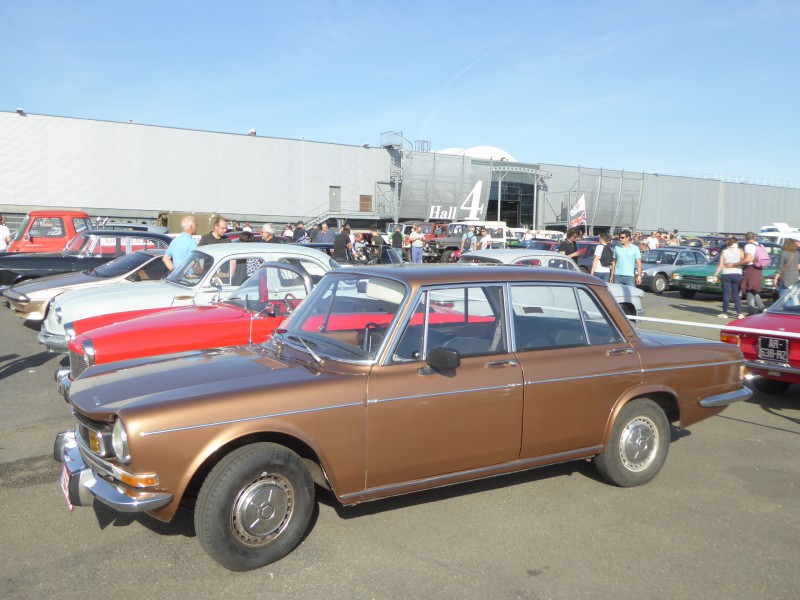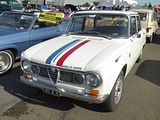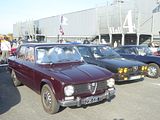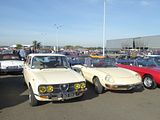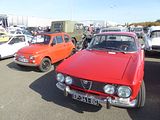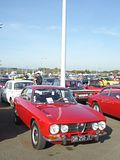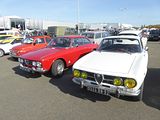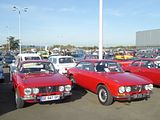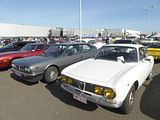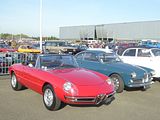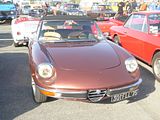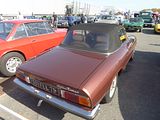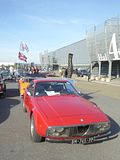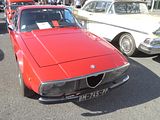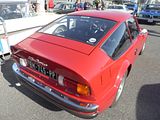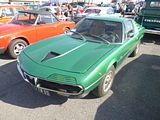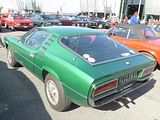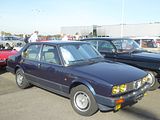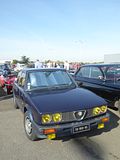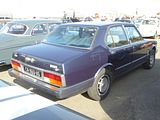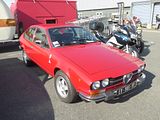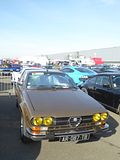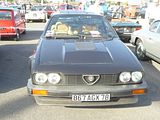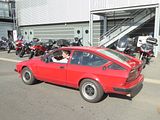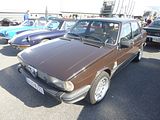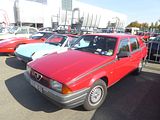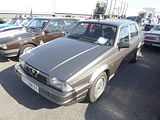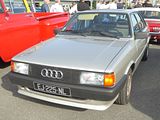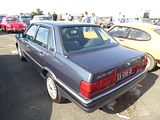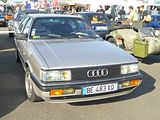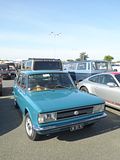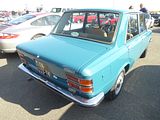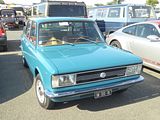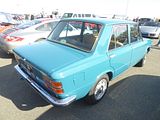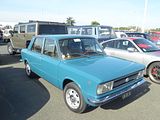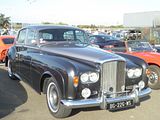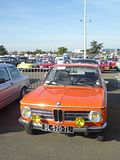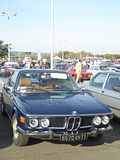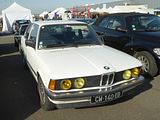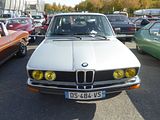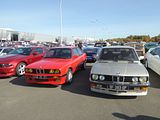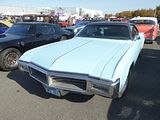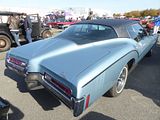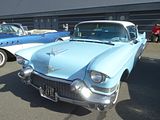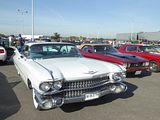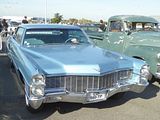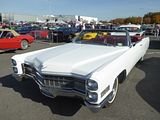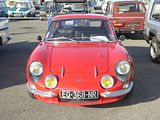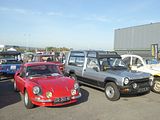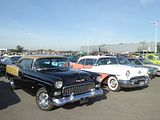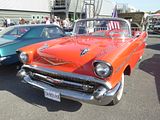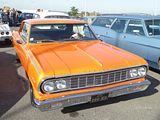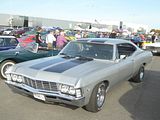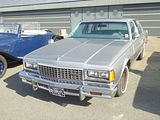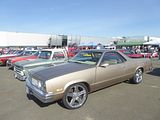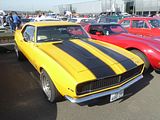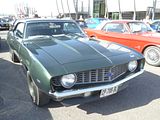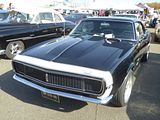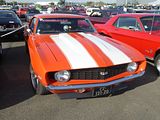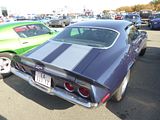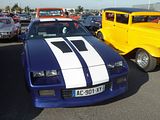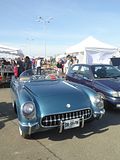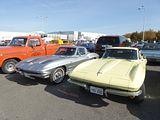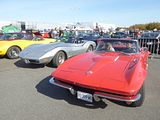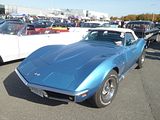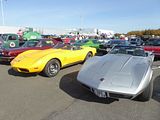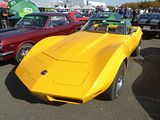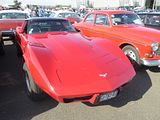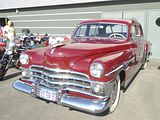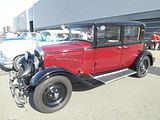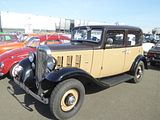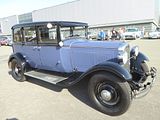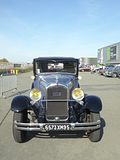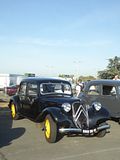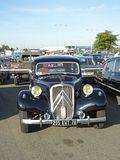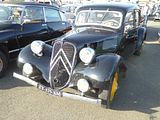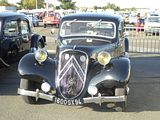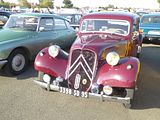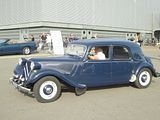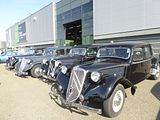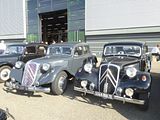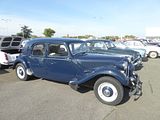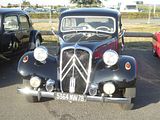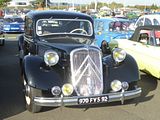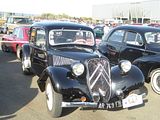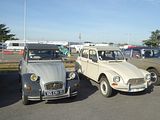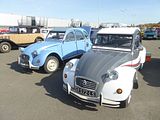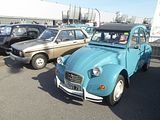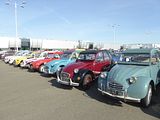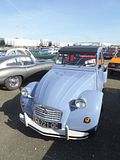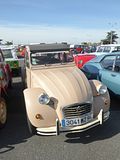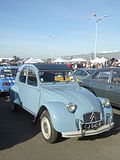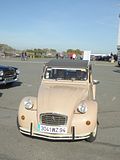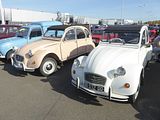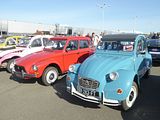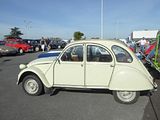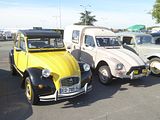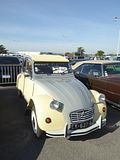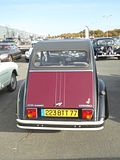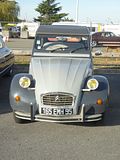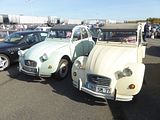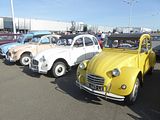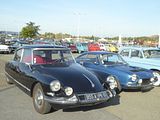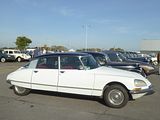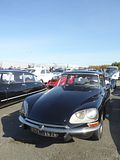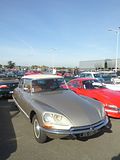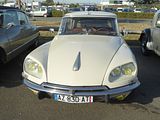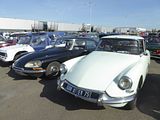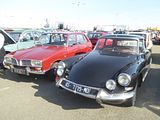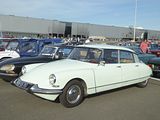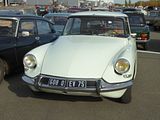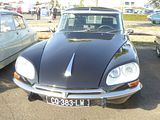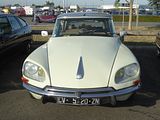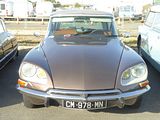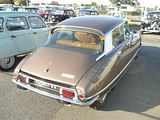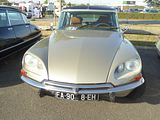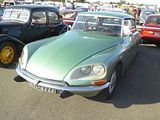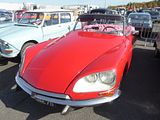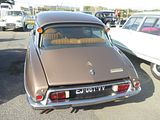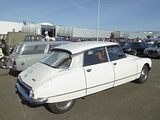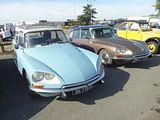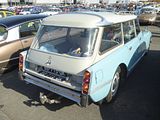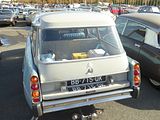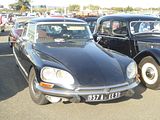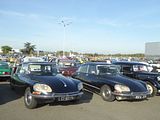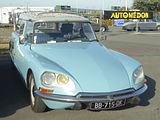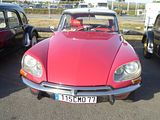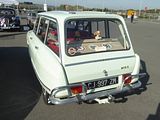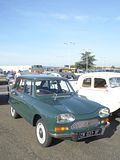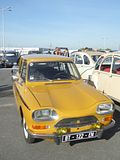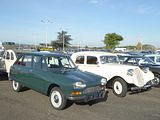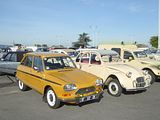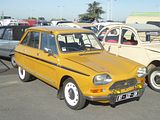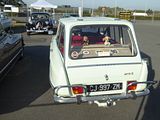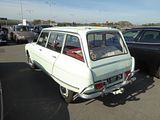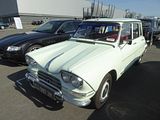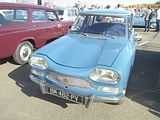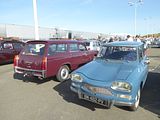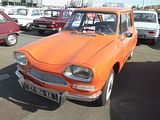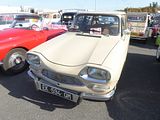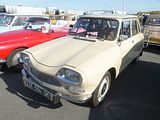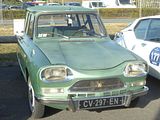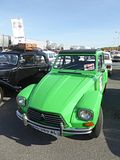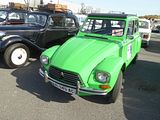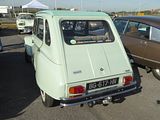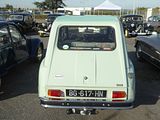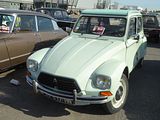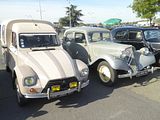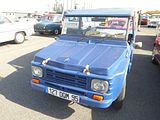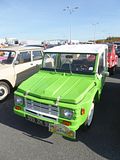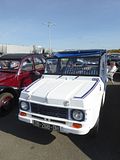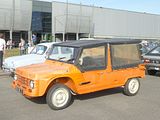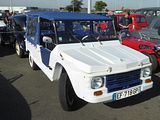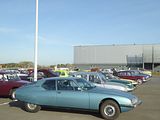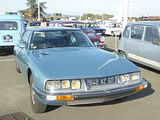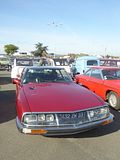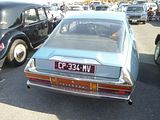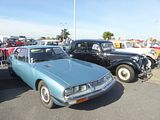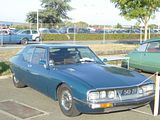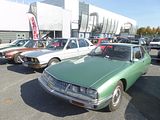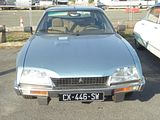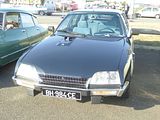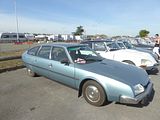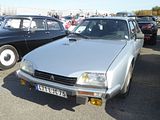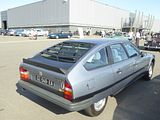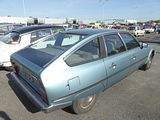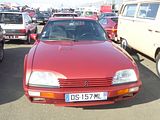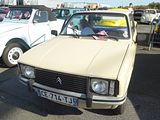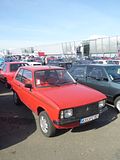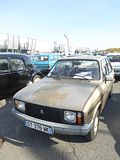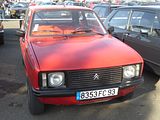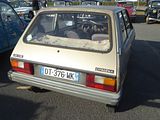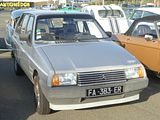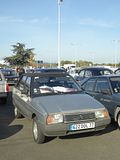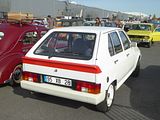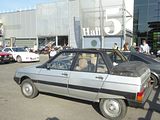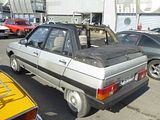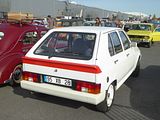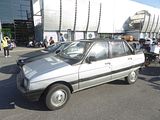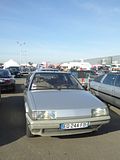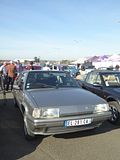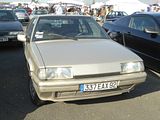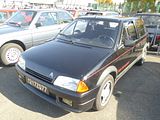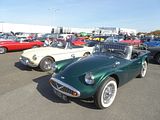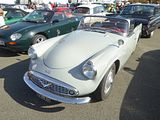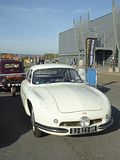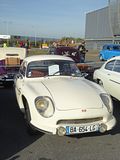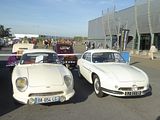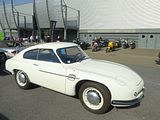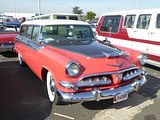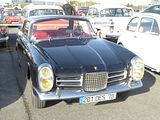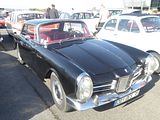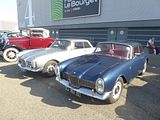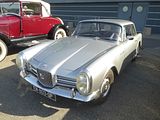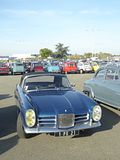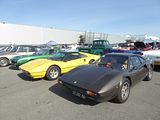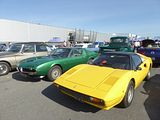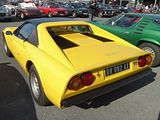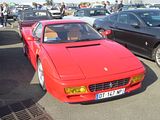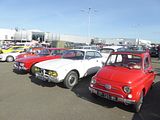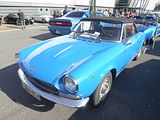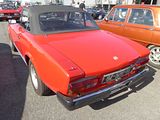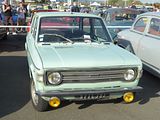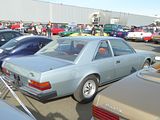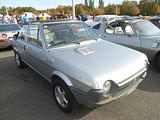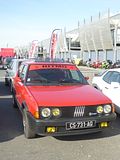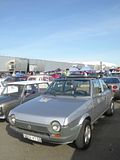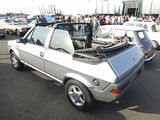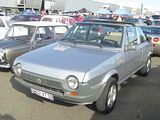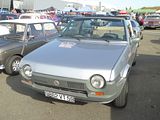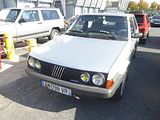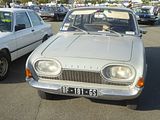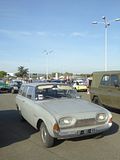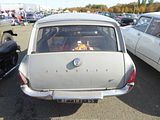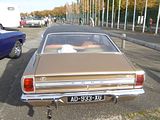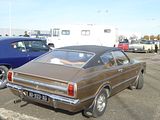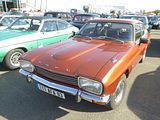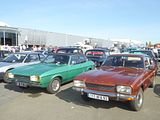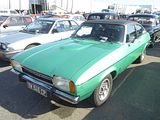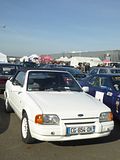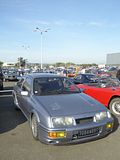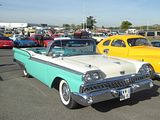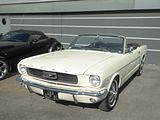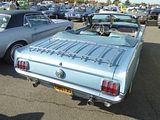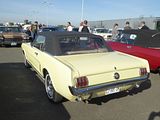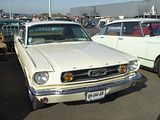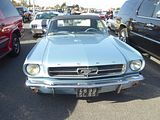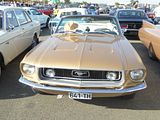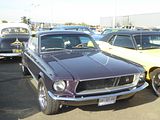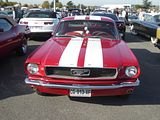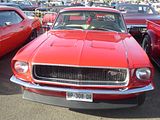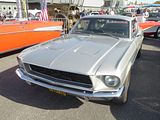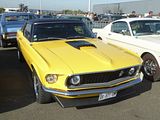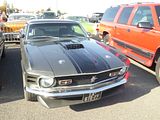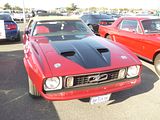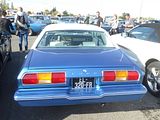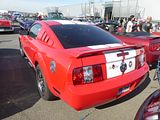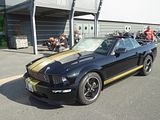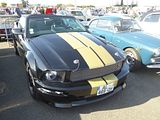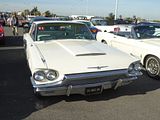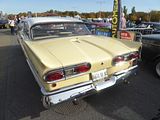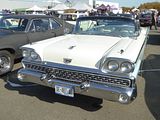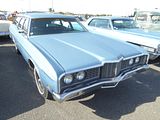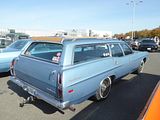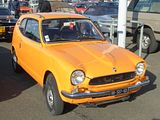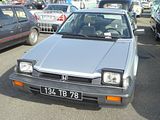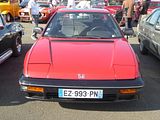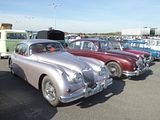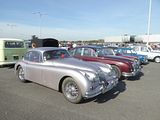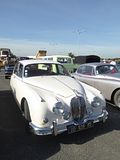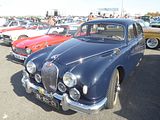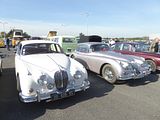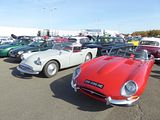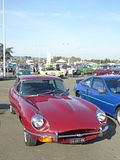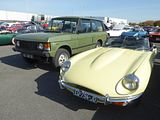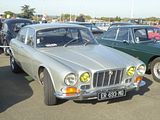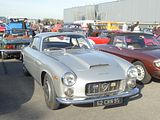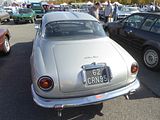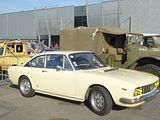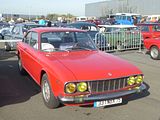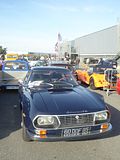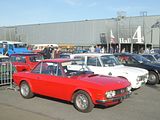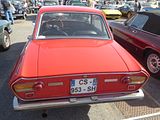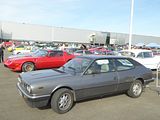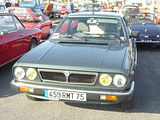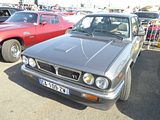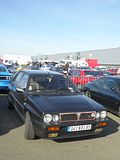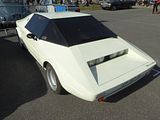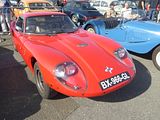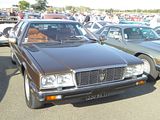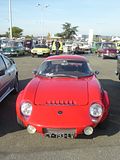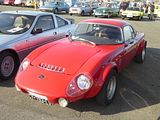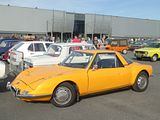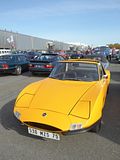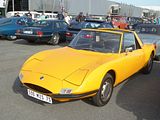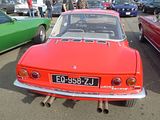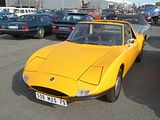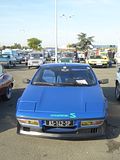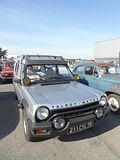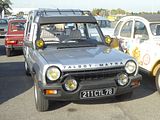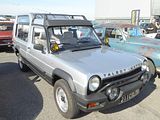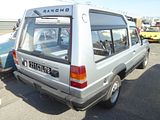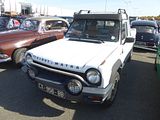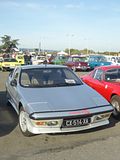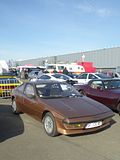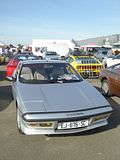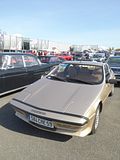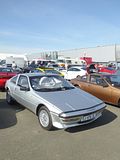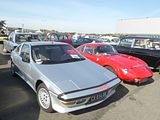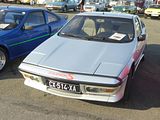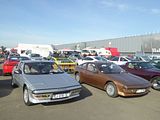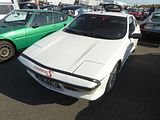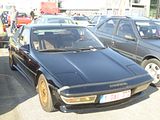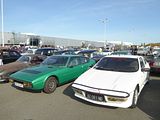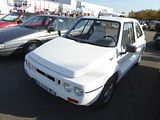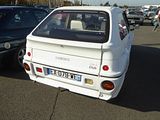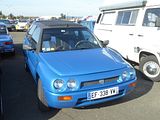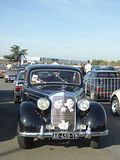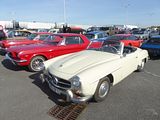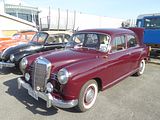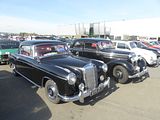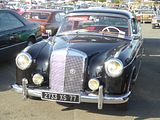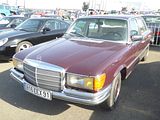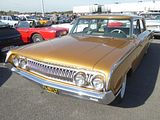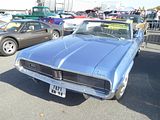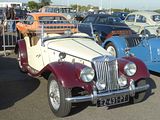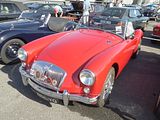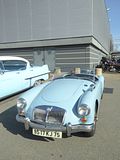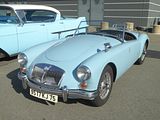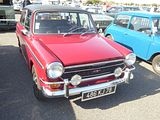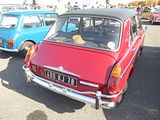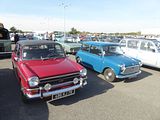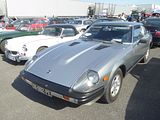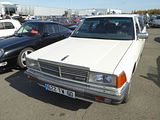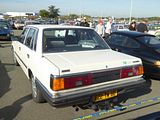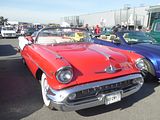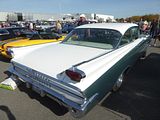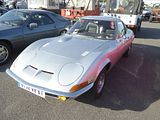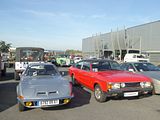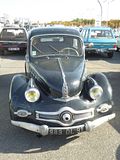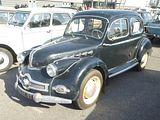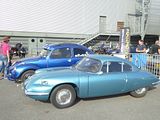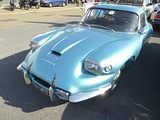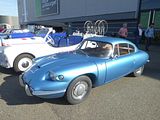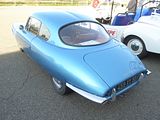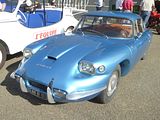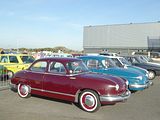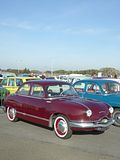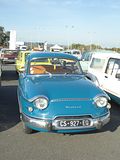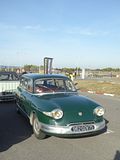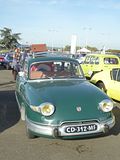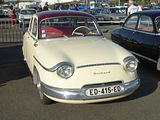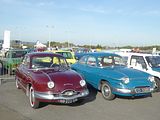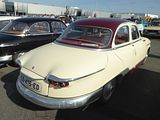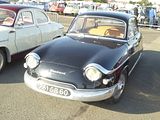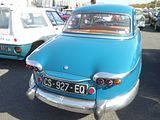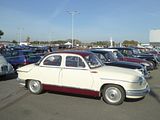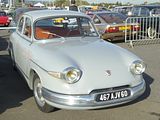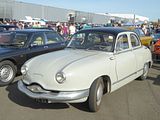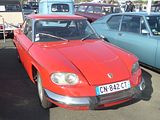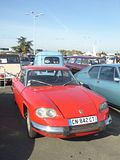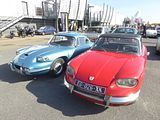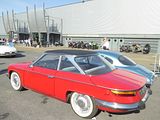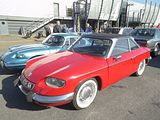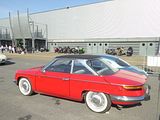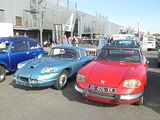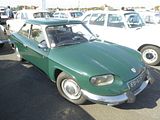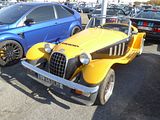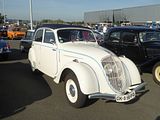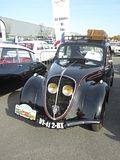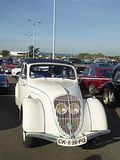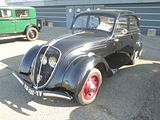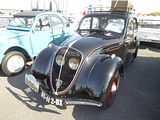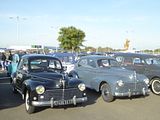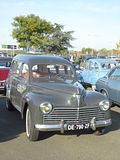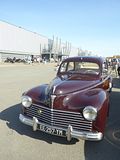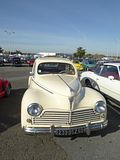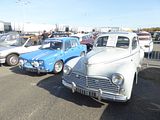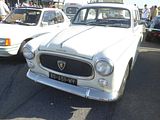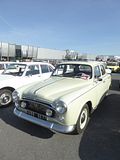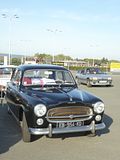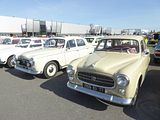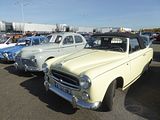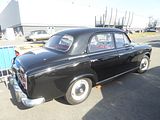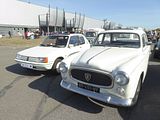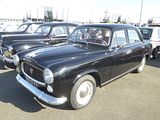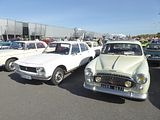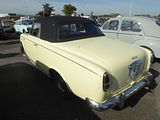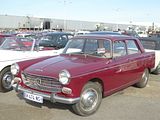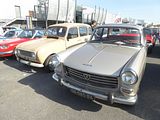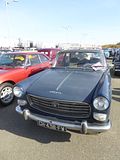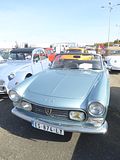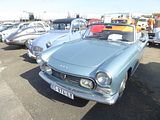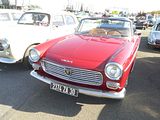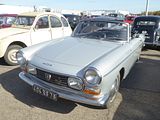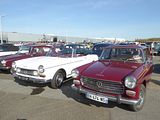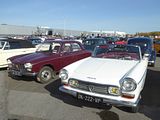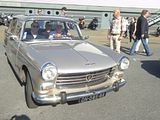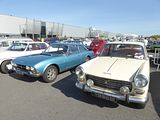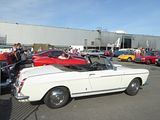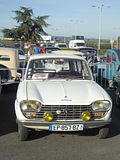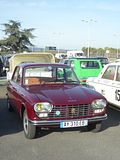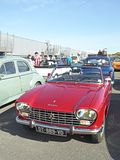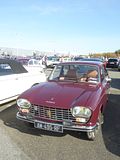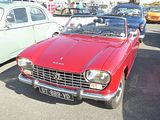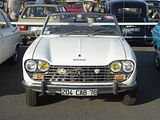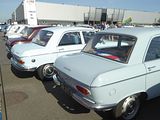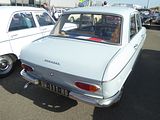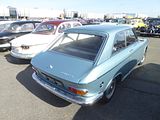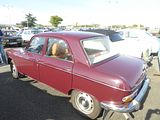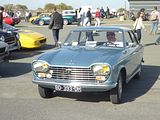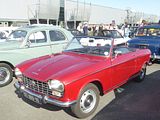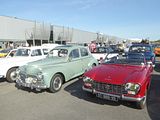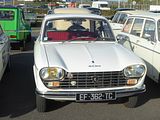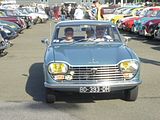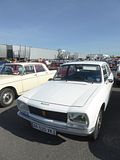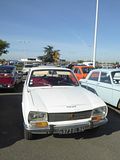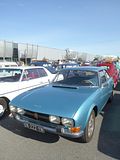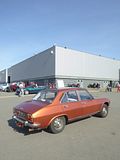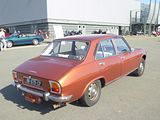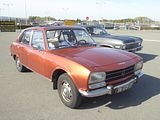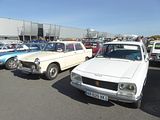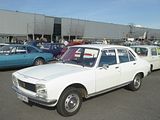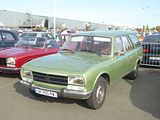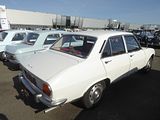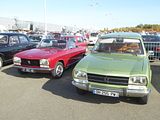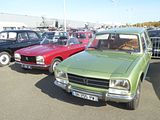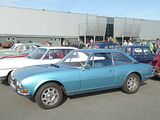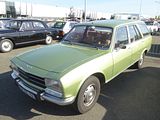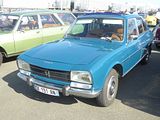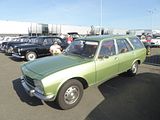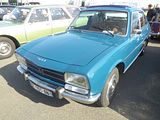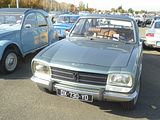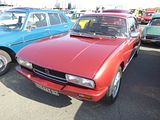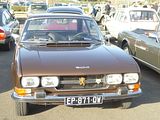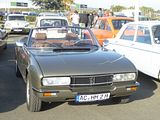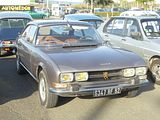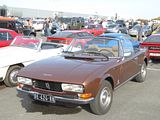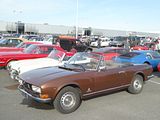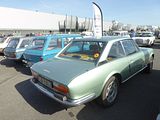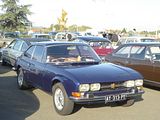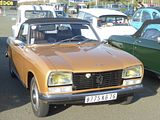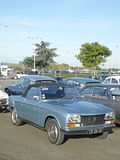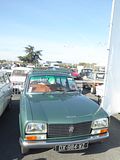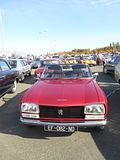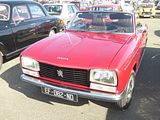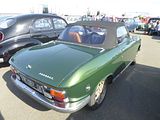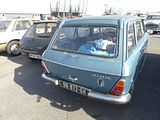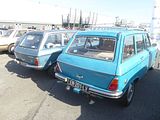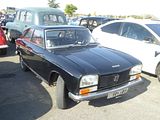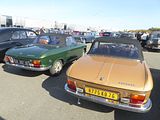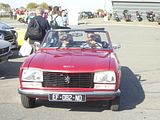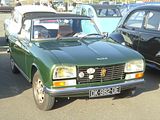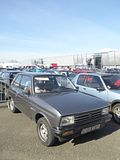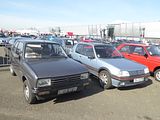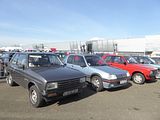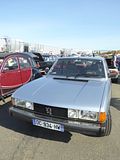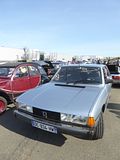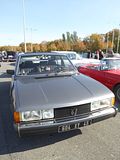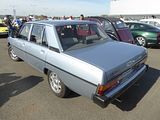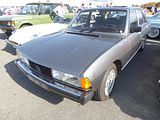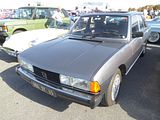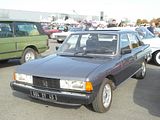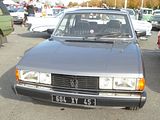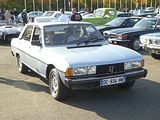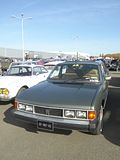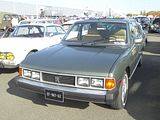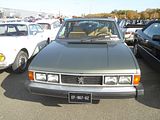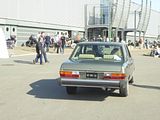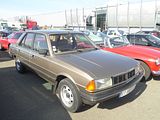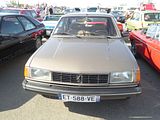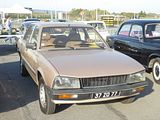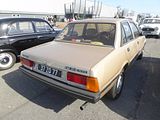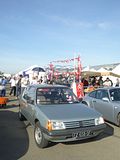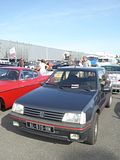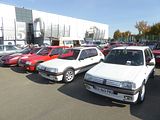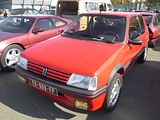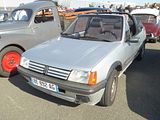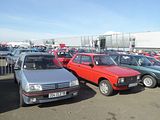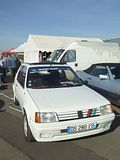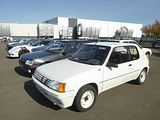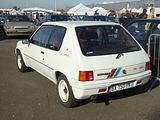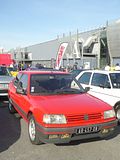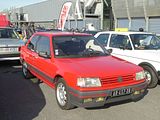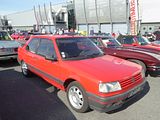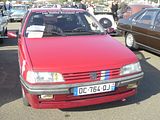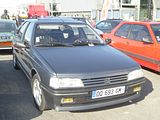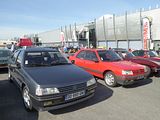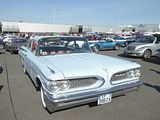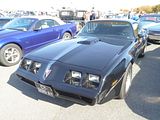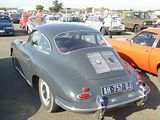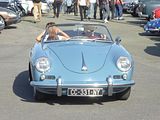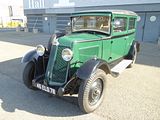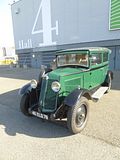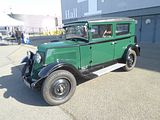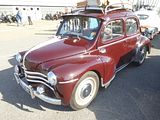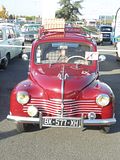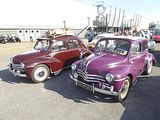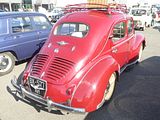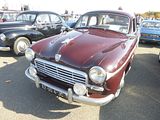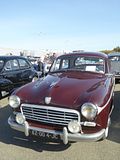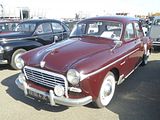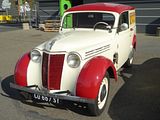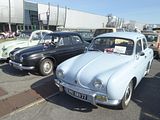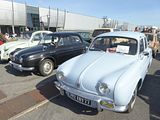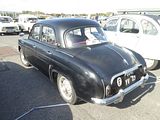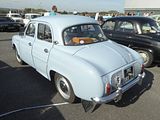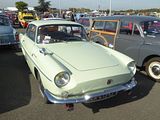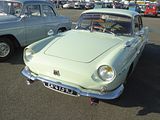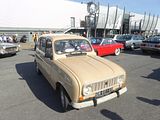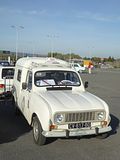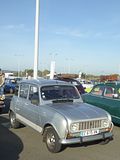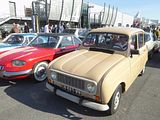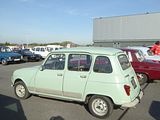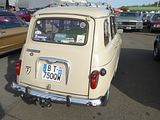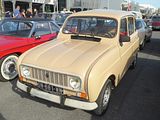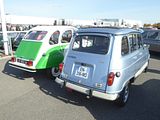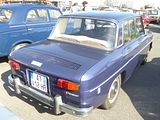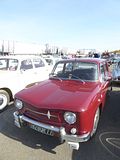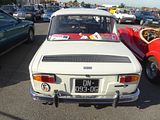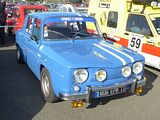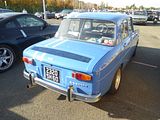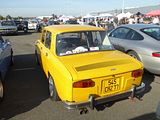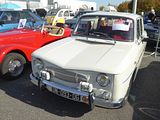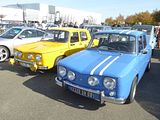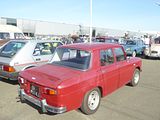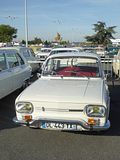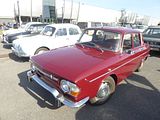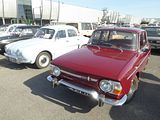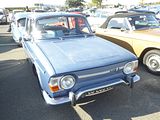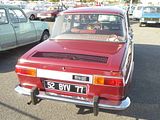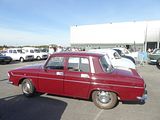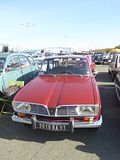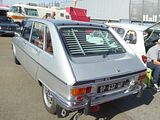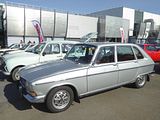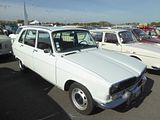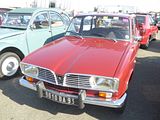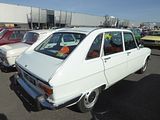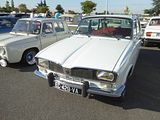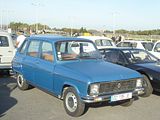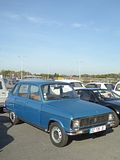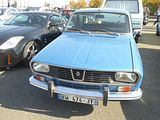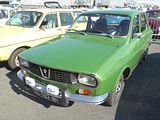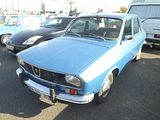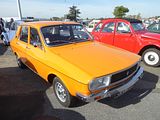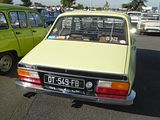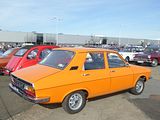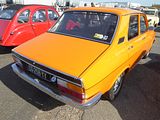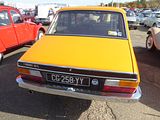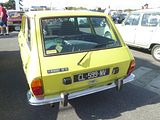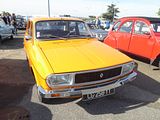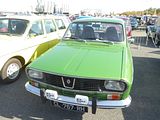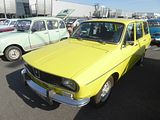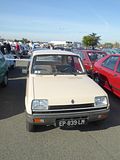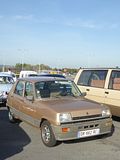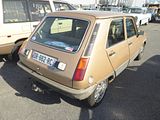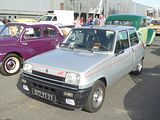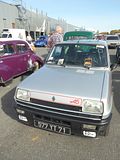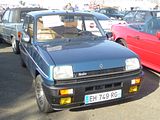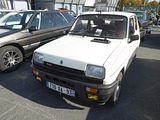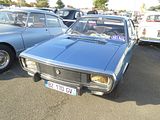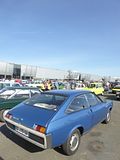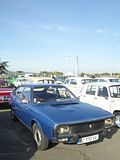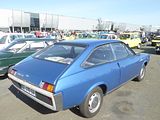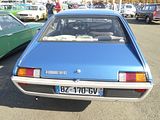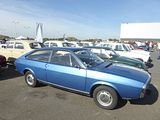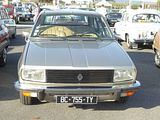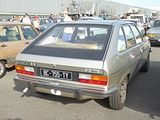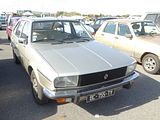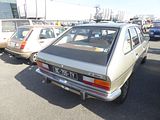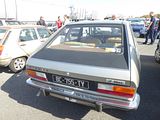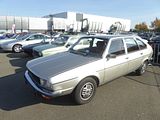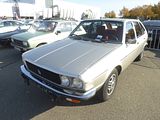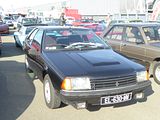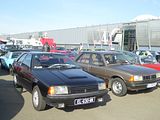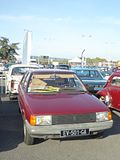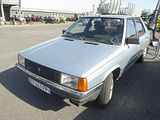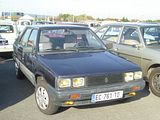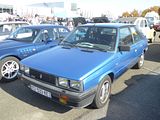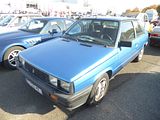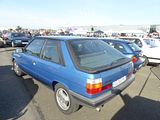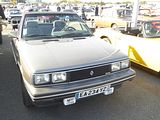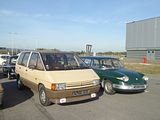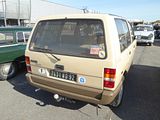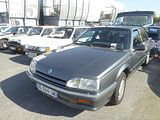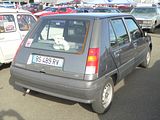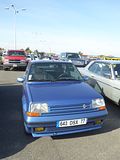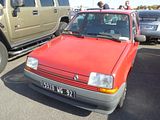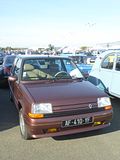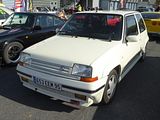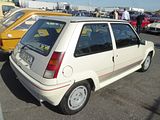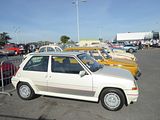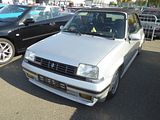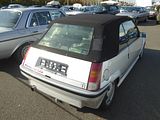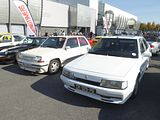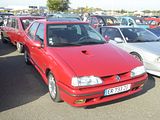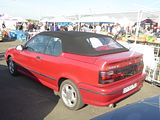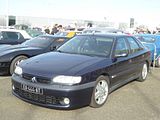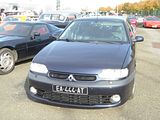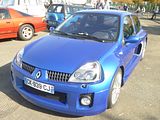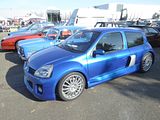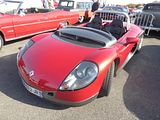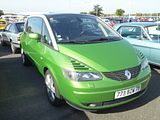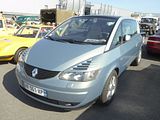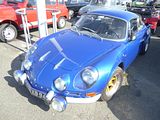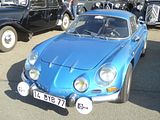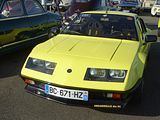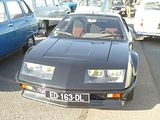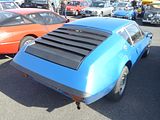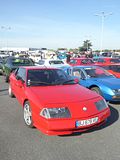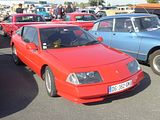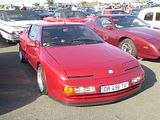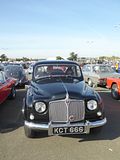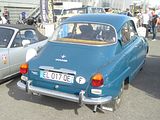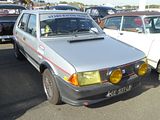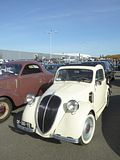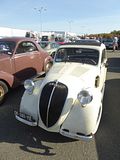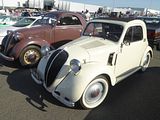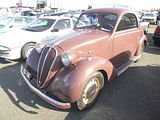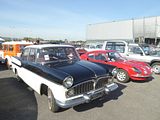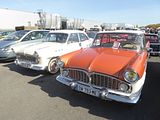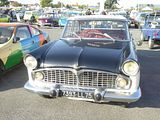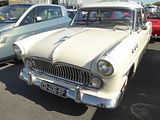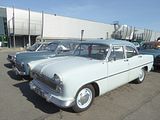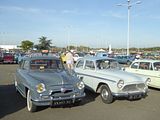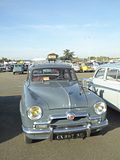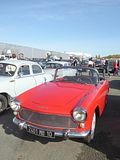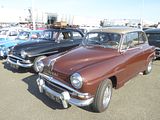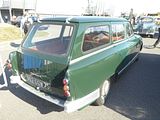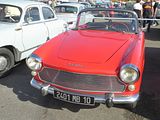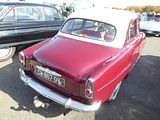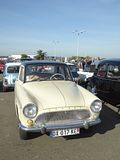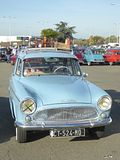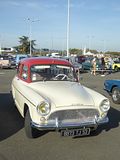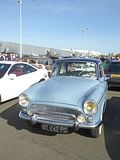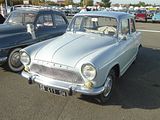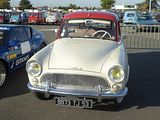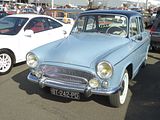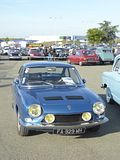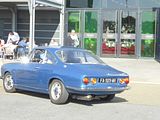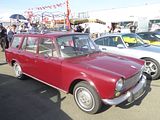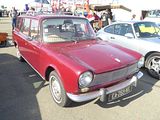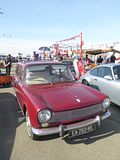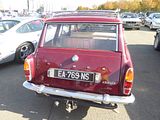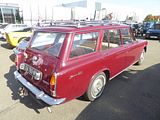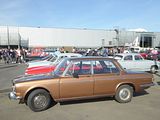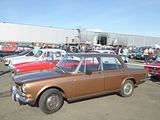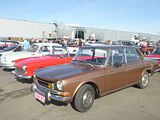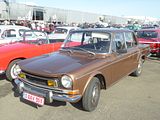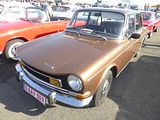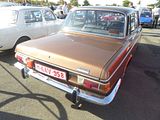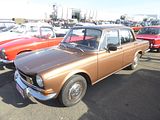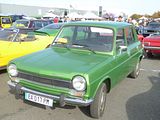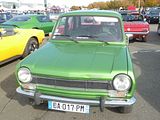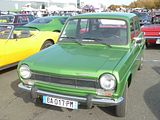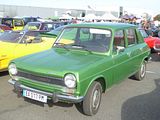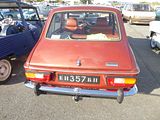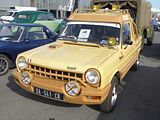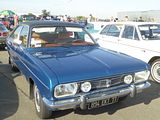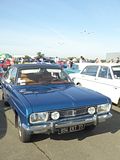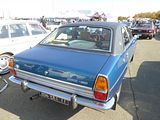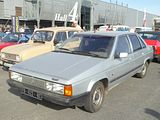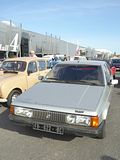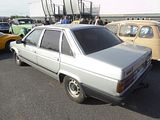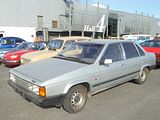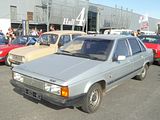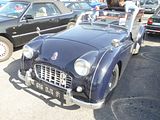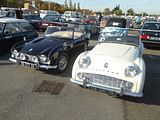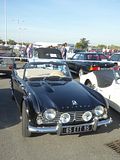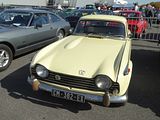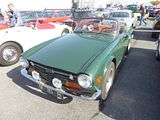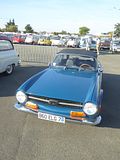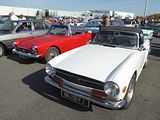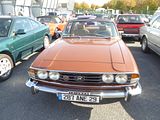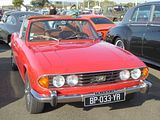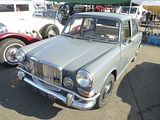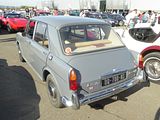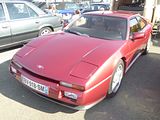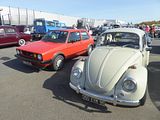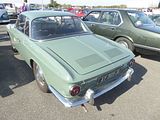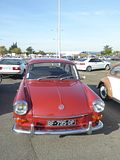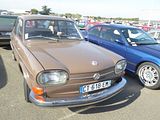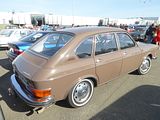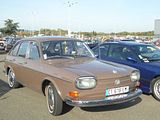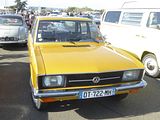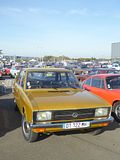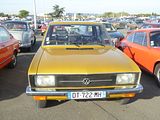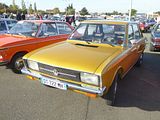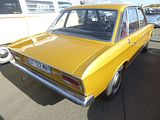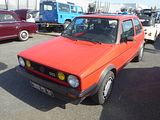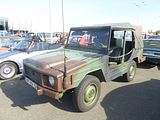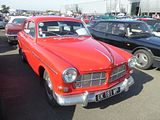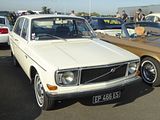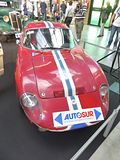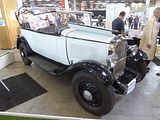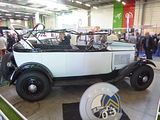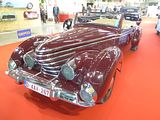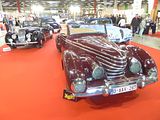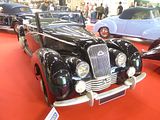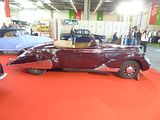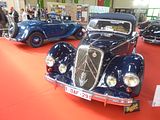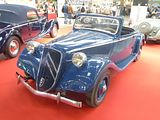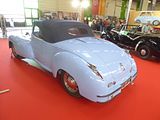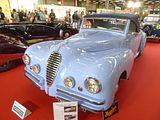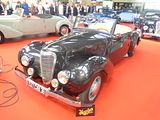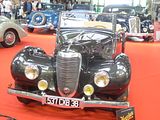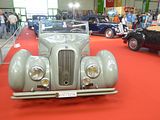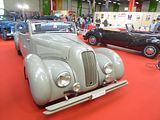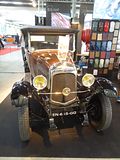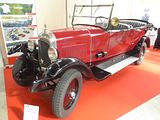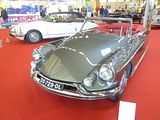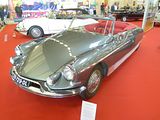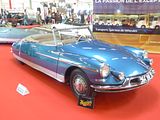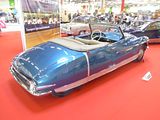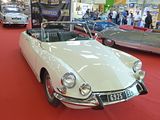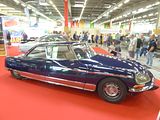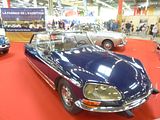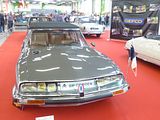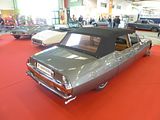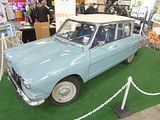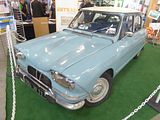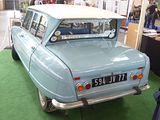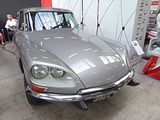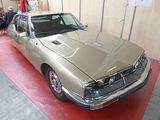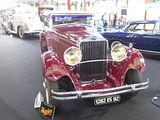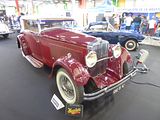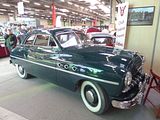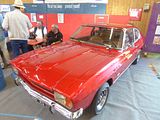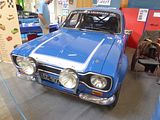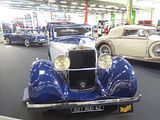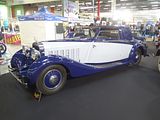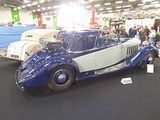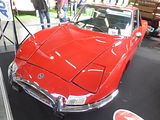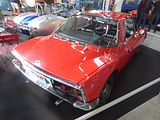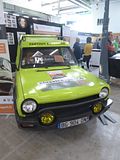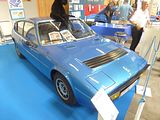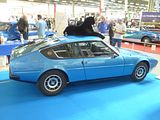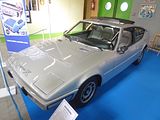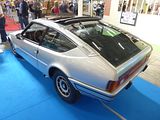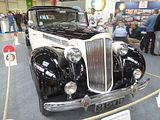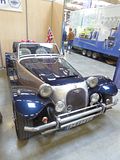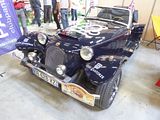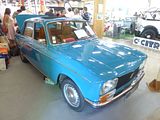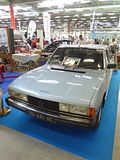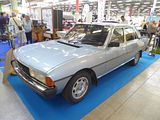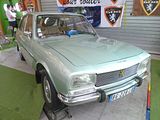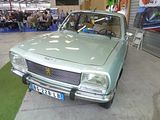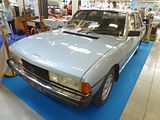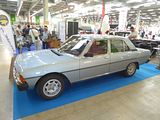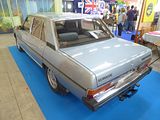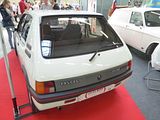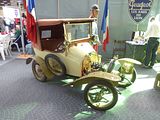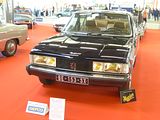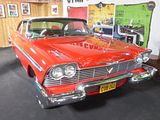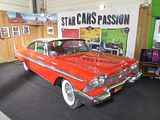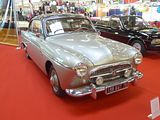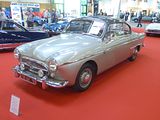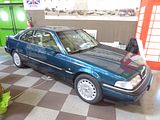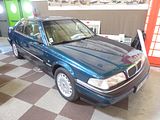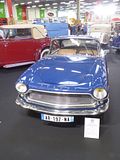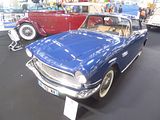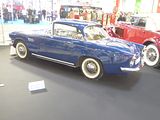There are more than enough car events held in the UK during the course of a season to keep the diary of an enthusiast very full indeed, with difficult choices to be made most weekends in the season where several different things vie for attention, from which only one can (usually) be attended during the course of a day. Coverage of many of them by the established print an online media as well as by countless figures on social media sites and channels, this one included, gives prospective attendees not just advance warning of forthcoming attractions, but also plenty of ideas of what to expect based on previous years. But of course it is not just the UK that is blessed with such a rich choice of events and coverage even in the UK press of some of the more significant overseas ones reveals that there is even more to think about when planning the diary, especially as many of these are only a short and relatively affordable flight away and can be combined with a weekend in some slightly more exotic location. Certainly it was media coverage which alerted me to the Automédon event a few years ago, with a short report and a couple of pictures in the leading UK classic car media hinting at something which would have a very French-biased content to it. Automédon is held in the first half of October, which means that it coincides with the last few days of the biennial Mondial de l’Automobile, the Paris Auto Show. And with the huge crowds that attend that event meaning that a weekday visit is infinitely preferable, when it came to planning my 2018 diary, I realised that I could spend a day at the Automédon after going to see the new cars at the Porte de Versailles, and still get back to the UK for an event at Brooklands on the Sunday. Automédon takes place at an exhibition centre in le Bourget, a suburb of Paris on the north eastern side, through which you pass on the RER train if you head into the city from the Charles de Gaulle airport, and is best known perhaps as once being the location of Paris’ airport and now having a flight museum. When I looked to see precisely where the exhibition centre is located and how to get there, it seemed that the bus from the CDG airport was the best bet, with a frequent service and a stop which meant it would be a short walk to the venue itself, so that is what I did. As I walked the last few hundred metres, I could see more and more classic cars, most of them French, and the sort of machines that you would only see occasionally on British soil, in vast quantity, all heading for the entrance.
THE OUTDOOR CARS
There is a large area to one side of the exhibition halls and this was packed with display cars. There were already a large number parked up when I walked in through the gates, and they continued to pour in all morning. Some departed early, but there place was taken by others that arrived later in the day so there was lots to see. I am sure that the glorious weather, with barely a cloud in sight encouraged man owners to bring their cars along, the result being a display which literally stunned me with its content. This being France, there was a predominance of French cars, and it would be quicker to list the models produced in the last 50 years that were not here. To save you trying to work out what was missing, I will enumerate them here. Just 5: the Citroen GS/GSA (bit of a surprise, that), Renault R14 (known in France as “La Poire”, the pear, for its tendency to rot quickly), the Renault R17 and Simca/Talbot’s Alpine, Solara and Horizon. There was at least one of everything else, and in most cases far more than that. And there were plenty of cars from other nations, too. Initially, parking was very carefully grouped, with separate lines of each of the French marques, and separate areas by nation, but as the day progressed this became less and less the case, with people parking their classic wherever there was space. Here, alphabetically, is what I came across during the day.
ALFA ROMEO
A couple of the models which bore Giulia badging had in fact started out as Giulietta cars, and there was an example of one of these here. This the more commonly seen of the pair, the lovely Giulia Spider 1600. Alfa had followed up the 1950 launch of the 1900 Berlina with a smaller model, the Giulietta. Known as the Type 750 and later 101 Series, the Giulietta evolved into a family of models. The first to be introduced was the Giulietta Sprint 2+2 coupé at the 1954 Turin Motor Show. Designed by Franco Scaglione at Bertone, it was produced at the coachbuilder’s Grugliasco plant near Turin. A year later, at the Turin Motor Show in April 1955, the Sprint was joined by the 4-door saloon Berlina. In mid 1955, the open two-seat Giulietta Spider, featuring convertible bodywork by Pininfarina, and it was one of these achingly pretty cars that was to be seen here. Alfa replaced the Giulietta with the Giulia in 1962, but as the Coupe and Spider were not ready, the Giulietta based models were kept in production, and renamed as Giulia. They gained a larger 1600cc engine, and this meant that the bonnet need to be raised a little to accommodate the new unit, so the easy recognition beyond Giulietta and Giulia Spiders is whether there is a flat bonnet or one with a slight hump and a vent in it.
This event rarely attracts large numbers of Alfa Romeo models, and that was the case here. All the cars I spotted were from the much-loved 105 Series, the mainstay of the range in the 1960s and early 70s. First of the all-new Giulia models to appear was the Berlina, launched in 1962. The styling was quite straight forward, but great attention was paid to detail. The engine bay, cabin and boot were all square shaped. But the grille, the rooflines and details on the bonnet and boot made for an integrated design from bumper to bumper. Thanks to Alfa Romeo using a wind tunnel during its development, the Giulia was very aerodynamic with a drag coefficient of Cd=0.34, which was particularly low for a saloon of the era and not a bad figure even for cars of today. Couple that with the fact that Alfa Romeo was one of the first manufacturers to put a powerful engine in a light-weight car (it weighed about 1,000 kilograms) and thanks to an array of light alloy twin overhead camshaft four-cylinder engine, similar to that of the earlier Giulietta models range, the car had a lively performance which bettered that of many sports cars of the day. The Tipo 105.14 was the first model, with a 1,570 cc Twin Cam engine with single down-draft carburettor generating 91 hp at 6500 rpm. The “TI” nomenclature referred to a class of Italian saloon car racing known as “Turismo Internazionale”, and had previously been applied to higher-performance versions of the 1900 and Giulietta saloons in the 1950s. However, for the Giulia saloon, the Ti was at first the only version available, and later, with the introduction of the TI Super and Super, the TI became the base version for the 1,600 cc engine class. The steering column gearchange (the only one in the Giulia range) was replaced with a floor change for 1964 (Tipo 105.08). Right hand drive cars, available from 1964, only ever had a floor change (Tipo 105.09). Brakes were by drums all around at first. Discs were introduced later, first at the front, and later all around. A brake servo was not fitted at first, but was introduced in later cars. The steering wheel featured the only horn ring ever in the Giulia range. The dashboard with a strip speedo is a notable feature, as is the steering wheel with a horn ring. The Giulia TI was phased out in 1968 and re-introduced as the austerity model 1600 S. Tipo 105.16 was a special racing model introduced in 1963. Quadrifoglio Verde stickers on the front wings were a distinguishing feature. Only 501 were made for homologation and today it is very rare and desirable. The 1,570 cc engine was fitted with two double-choke horizontal Weber 45DCOE carburettors for 110 hp at 6500 rpm. The body was lightened and a floor gearchange was fitted as standard, as were alloy wheels of very similar appearance to the standard steel ones of the TI. The TI’s instrument cluster with its strip speedometer was replaced with a three-instrument binnacle comprising speedometer, tachometer and a multi-gauge instrument (fuel, water temperature, oil temperature and pressure) – these instruments were similar to those fitted to the contemporary Giulia Sprint and Sprint Speciale coupes and Spider convertibles. The steering wheel was a three-spoke item with centre hornpush, also similar to that of the more sporting models. Braking was by discs all around, although the first cars used drums and early disc models lacked a servo which was introduced later. The police cars seen in The Italian Job were of this type. Tipo 105.06 was an austerity model made from 1964 to 1970 with a 1,290 cc single-carburettor engine for 77 hp at 6000 rpm. Four-speed gearbox with floor change fitted as standard (the 1300 was the only Giulia model not fitted with a five-speed gearbox). Though the engine was given a 105 series type number, it was basically the engine from the 101 series Giulietta Ti. This model appears not to have been exported to many markets outside Italy, if at all. Braking was by discs all around, without a servo at first, later with a servo. Tipo 105.26 was introduced in 1965. It transferred the technology from the racing TI Super to a road car, to make the most successful Giulia saloon. 1,570 cc engine with two double-choke Weber 40DCOE carburettors for a milder, but torquier tune than the TI Super – 97 hp at 5500 rpm. There was a new dashboard with two large round instruments (speedo and tacho) and clock, a sportier steering wheel with three aluminium spokes and centre horn push, similar to that of the Ti Super, later changed for one with the horn pushes in the spokes. All-around disc brakes with servo were fitted as standard from the outset. The serpent crest of the Sforza family appears in a badge on the C-pillar and is a distinguishing feature of the Super. For 1968, there was a suspension update, including revised geometry and a rear anti-roll bar. The wheels were changed in size from 5J x 15 to 5J x 14, and tyres from 155/15 to 165/14. For 1970, updates included dual-circuit brakes, centre-mounted handbrake lever to replace under-dash “umbrella handle”, larger external doorhandles, and top-hinged pedals (the latter in left hand drive models only; right hand drive continued with bottom-hinged pedals to the end of production). In 1972, Tipo 105.26 was rationalised into the Giulia 1.3 – Giulia 1.6 range. Tipo 105.39 built from 1965 to 1972. Right hand drive model replaced in 1970 by the 1300 Super. 1,290 cc engine with single down-draft carburettor for 81 hp at 6000 rpm. Unlike the re-deployed 101-series Giulietta engine of the austerity-model 1300, the 1300 ti motor was a 105 series engine, basically that of the sportier GT1300 Junior coupe with different camshaft timing (but the same camshafts) and induction system. Five-speed gearbox. Three-spoke bakelite steering wheel with plastic horn push covering the centre and spokes. Dashboard initially with strip speedo like that of the TI. For 1968, updates included a dashboard based on that of the Super, but with a simpler instrument binnacle, still featuring two large round instruments (speedo and tacho) and a separate fuel gauge, and the same suspension, wheel and tire updates applied to the Giulia Super in the same year. For 1970, updates included dual-circuit brakes, centre handbrake, larger external doorhandles and top-hinged pedals (on left hand drive cars only), again as applied to the Super for that year. Tipo 105.85 was basically a Giulia TI re-introduced in 1968 as a lower-level model to come between the 1300 and 1300 ti on one hand, and the Super on the other. It had a re-interpretation of the 1,570 cc single-carburettor engine for 94 hp at 5500 rpm and similar trim to the 1300 ti. Replaced in 1970 by the 1300 Super which offered similar performance in a lower tax bracket. The last cars from 1970 featured the top-hinged pedals, centre handbrake and dual-circuit brakes as for the Super and 1300 ti. Tipo 115.09 was introduced in 1970. It was basically a 1300 ti fitted with the engine from the GT 1300 Junior coupe that featured two double-choke horizontal carburettors; the engine actually had the GT 1300 Junior type number. This model was rationalised into the Giulia Super 1.3 – Giulia Super 1.6 range in 1972. In 1972 a rationalisation of the Giulia range saw the Super 1300 (Tipo 115.09) and the Super (Tipo 105.26) re-released as the Super 1.3 and Super 1.6. The two models featured the same equipment, interior and exterior trim, differing only in engine size and final drive ratio. The 1300 ti was dropped. A small Alfa Romeo badge on the C-pillar is a distinguishing feature, as are hubcaps with exposed wheel nuts. In December 1972 Alfa-Romeo South Africa released the 1600 Rallye. This locally developed more powerful 1600 cc version of the 1300 Super used the 1300’s single-headlight body shell. The car was largely ready for competition and was only planned to be built in limited numbers, and was fitted with racing-style rear-view mirrors, rally lamps, fully adjustable seats, and a limited-slip differential. Claimed power was 125 hp. The Giulia Super range was re-released in 1974 as the Nuova Super range, including the Giulia Nuova Super 1300 and 1600 This featured a new black plastic front grille and a flat boot lid without the characteristic centre spine. Otherwise the cars differed little from their Giulia Super predecessors and bore the same Tipo numbers with an S suffix. A Nuova Super fitted with a Perkins 1,760 cc diesel with 54 hp at 4000 rpm, was the firm’s first attempt at diesel power. The same Perkins diesel was used also in Alfa Romeo F12 van. The diesel version was slow, 138 km/h (86 mph), and the engine somehow unsuitable for a sport sedan so it was not big seller, only around 6500 examples were made in 1976 and the car was not sold in the UK. Production of the Giulia ceased in 1977.
Usually, you see more of the related Coupe models, and that was certainly the case on this occasion. The first car was called the Alfa Romeo Giulia Sprint GT, and was revealed at a press event held at the then newly opened Arese plant on 9 September 1963, and displayed later the same month at the Frankfurt Motor Show. In its original form the Bertone body is known as scalino (step) or “step front”, because of the leading edge of the engine compartment lid which sat 1/4 an inch above the nose of the car. The Giulia Sprint GT can be distinguished from the later models by a number of features including: Exterior badging: Alfa Romeo logo on the front grille, a chrome script reading “Giulia Sprint GT” on the boot lid, and rectangular “Disegno di Bertone” badges aft of the front wheel arches; flat, chrome grille in plain, wide rectangular mesh without additional chrome bars; single-piece chrome bumpers; no overriders. Inside the cabin the padded vinyl dashboard was characterised by a concave horizontal fascia, finished in grey anti-glare crackle-effect paint. Four round instruments were inset in the fascia in front of the driver. The steering wheel was non-dished, with three aluminium spokes, a thin bakelite rim and a centre horn button. Vinyl-covered seats with cloth centres and a fully carpeted floor were standard, while leather upholstery was an extra-cost option. After initially marketing it as a four-seater, Alfa Romeo soon changed its definition of the car to a more realistic 2+2. The Giulia Sprint GT was fitted with the 1,570 cc version of Alfa Romeo’s all-aluminium twin cam inline four (78 mm bore × 82 mm stroke), which had first debuted on the 1962 Giulia Berlina. Breathing through two twin-choke Weber 40 DCOE 4 carburettors, on the Sprint GT this engine produced 105 hp at 6,000 rpm. Like all subsequent models, the Sprint GT was equipped with an all-synchromesh 5-speed manual transmission. The braking system comprised four Dunlop disc brakes and a vacuum servo. The rear brakes featured an unusual arrangement with the slave cylinders mounted on the axle tubes, operating the calipers by a system of levers and cranks. According to Alfa Romeo the car could reach a top speed of “over 180 km/h (112 mph)”. In total 21,902 Giulia Sprint GT were produced from 1963 to 1965, when the model was superseded by the Giulia Sprint GT Veloce. Of these 2,274 were right hand drive: 1,354 cars fully finished in Arese, and 920 shipped in complete knock-down kit form for foreign assembly. For 1966, the Giulia Sprint GT was replaced by the Alfa Romeo Giulia Sprint GT Veloce, which was very similar but featuring a number of improvements: a revised engine—slightly more powerful and with more torque—better interior fittings and changes to the exterior trim. Alongside the brand new 1750 Spider Veloce which shared its updated engine the Sprint GT Veloce was introduced at the 36th Geneva Motor Show in March 1966, and then tested by the international specialist press in Gardone on the Garda Lake. Production had began in 1965 and ended in 1968. The Giulia Sprint GT Veloce can be most easily distinguished from other models by the following features: badging as per Giulia Sprint GT, with the addition of round enamel badges on the C-pillar—a green Quadrifoglio (four-leaf clover) on an ivory background—and a chrome “Veloce” script on the tail panel; black mesh grille with three horizontal chrome bars; the grille heart has 7 bars instead of 6; stainless steel bumpers, as opposed to the chromed mild steel bumpers on the Giulia Sprint GT. The bumpers are the same shape, but are made in two pieces (front) and three pieces (rear) with small covers hiding the joining rivets. Inside the main changes from the Giulia Sprint GT were imitation wood dashboard fascia instead of the previous anti-glare grey finish, front seats revised to a mild “bucket” design, and a dished three aluminium spoke steering wheel, with a black rim and horn buttons through the spokes. The Veloce’s type 00536 engine, identical to the Spider 1600 Duetto’s, featured modifications compared to the Giulia Sprint GT’s type 00502—such as larger diameter exhaust valves. As a result it produced 108 hp at 6,000 rpm, an increase of 3 hp over the previous model, and significantly more torque. The top speed now exceeded 185 km/h (115 mph). Early Giulia Sprint GT Veloces featured the same Dunlop disc brake system as the Giulia Sprint GT, while later cars substituted ATE disc brakes as pioneered on the GT 1300 Junior in 1966. The ATE brakes featured an handbrake system entirely separate from the pedal brakes, using drum brakes incorporated in the rear disc castings. Though the Sprint GT Veloce’s replacement—the 1750 GT Veloce—was introduced in 1967, production continued throughout the year and thirty final cars were completed in 1968. By then total Giulia Sprint GT Veloce production amounted to 14,240 examples. 1,407 of these were right hand drive cars, and 332 right hand drive complete knock-down kits. The 1750 GT Veloce (also known as 1750 GTV) appeared in 1967 along with the 1750 Berlina sedan and 1750 Spider. The same type of engine was used to power all three versions; this rationalisation was a first for Alfa Romeo. The 1750 GTV replaced the Giulia Sprint GT Veloce and introduced many updates and modifications. Most significantly, the engine capacity was increased to 1779 cc displacement. Peak power from the engine was increased to 120 hp at 5500 rpm. The stroke was lengthened from 82 to 88.5 mm over the 1600 engine, and a reduced rev limit from 7000 rpm to 6000 rpm. Maximum torque was increased to 137 lb·ft at 3000 rpm. A higher ratio final drive was fitted (10/41 instead of 9/41) but the same gearbox ratios were retained. The result was that, on paper, the car had only slightly improved performance compared to the Giulia Sprint GT Veloce, but on the road it was much more flexible to drive and it was easier to maintain higher average speeds for fast touring. For the United States market, the 1779 cc engine was fitted with a fuel injection system made by Alfa Romeo subsidiary SPICA, to meet emission control laws that were coming into effect at the time. Fuel injection was also featured on Canadian market cars after 1971. Carburettors were retained for other markets. The chassis was also significantly modified. Tyre size went to 165/14 from 155/15 and wheel size to 5 1/2J x 14 instead of 5J x 15, giving a wider section and slightly smaller rolling diameter. The suspension geometry was also revised, and an anti-roll bar was fitted to the rear suspension. ATE disc brakes were fitted from the outset, but with bigger front discs and calipers than the ones fitted to GT 1300 Juniors and late Giulia Sprint GT Veloces. The changes resulted in significant improvements to the handling and braking, which once again made it easier for the driver to maintain high average speeds for fast touring. The 1750 GTV also departed significantly from the earlier cars externally. New nose styling eliminated the “stepped” bonnet of the Giulia Sprint GT, GTC, GTA and early GT 1300 Juniors and incorporated four headlamps. For the 1971 model year, United States market 1750 GTV’s also featured larger rear light clusters (there were no 1970 model year Alfas on the US market). Besides the chrome “1750” badge on the bootlid, there was also a round Alfa Romeo badge. Similar Quadrofoglio badges to those on the Giulia Sprint GT Veloce were fitted on C pillars, but the Quadrofoglio was coloured gold instead of green. The car also adopted the higher rear wheelarches first seen on the GT 1300 Junior. The interior was also much modified over that of earlier cars. There was a new dashboard with large speedometer and tachometer instruments in twin binnacles closer to the driver’s line of sight. The instruments were mounted at a more conventional angle, avoiding the reflections caused by the upward angled flat dash of earlier cars. Conversely, auxiliary instruments were moved to angled bezels in the centre console, further from the driver’s line of sight than before. The new seats introduced adjustable headrests which merged with the top of the seat when fully down. The window winder levers, the door release levers and the quarterlight vent knobs were also restyled. The remote release for the boot lid, located on the inside of the door opening on the B-post just under the door lock striker, was moved from the right hand side of the car to the left hand side. The location of this item was always independent of whether the car was left hand drive or right hand drive. Early (Series 1) 1750 GTV’s featured the same bumpers as the Giulia Sprint GT Veloce, with the front bumper modified to mount the indicator / sidelight units on the top of its corners, or under the bumper on US market cars. The Series 2 1750 GTV of 1970 introduced other mechanical changes, including a dual circuit braking system (split front and rear, with separate servos). The brake and clutch pedals on left hand drive cars were also of an improved pendant design, instead of the earlier floor-hinged type. On right hand drive cars the floor-hinged pedals were retained, as there was no space for the pedal box behind the carburettors. Externally, the series 2 1750 GTV is identified by new, slimmer bumpers with front and rear overriders. The combined front indicator and sidelight units were now mounted to the front panel instead of the front bumper, except again on the 1971-72 US/Canadian market cars. The interior was slightly modified, with the seats retaining the same basic outline but following a simpler design. 44,269 1750 GTVs were made before their replacement came along. That car was the 2000GTV. Introduced in 1971, together with the 2000 Berlina sedan and 2000 Spider, the 2 litre cars were replacements for the 1750 range. The engine displacement was increased to 1962 cc. Oil and radiator capacities remained unchanged. The North American market cars had fuel injection, but everyone else retained carburettors. Officially, both versions generated the same power, 130 hp at 5500 rpm. The interior trim was changed, with the most notable differences being the introduction of a separate instrument cluster, instead of the gauges installed in the dash panel in earlier cars. Externally the 2000 GTV is most easily distinguished by its grille with horizontal chrome bars, featuring protruding blocks forming the familiar Alfa heart in outline, smaller hubcaps with exposed wheel nuts, optional aluminium alloy wheels of the same size as the standard 5. 1/2J × 14 steel items, styled to the “turbina” design first seen on the alloy wheels of the Alfa Romeo Montreal, and the larger rear light clusters first fitted to United States market 1750 GTV’s were standard for all markets. From 1974 on, the 105 Series coupé models were rationalised and these external features became common to post-1974 GT 1300 Junior and GT 1600 Junior models, with only few distinguishing features marking the difference between models. 37,459 2000 GTVs were made before production ended and these days they are very sought after with prices having sky-rocketed in recent years. Cars here ranged from an early “step front” to a 1600 Junior and a number of 1750/2000 GTVs.
Alfa replaced the Giulia-based Spider model with an all-new design which finally made its debut in 1966 together with the Giulia Sprint GT Veloce at an event organised in Gardone Riviera. With its boat tailed styling, it quickly found favour, even before taking a starring role in the film “The Graduate”. The original 1600cc engine was replaced by a more powerful 1750cc unit at the same time as the change was made to the rest of the range, and the car continued like this until 1970, when the first significant change to the exterior styling was introduced on the 1750 Spider Veloce, with the original’s distinctive elongated round tail changed to a more conventional cut-off tail, called the “Kamm tail”, as well as improving the luggage space. Numerous other small changes took place both inside and out, such as a slightly different grille, new doorhandles, a more raked windscreen, top-hinged pedals and improved interior trim. 1971 saw the Spider Veloce get a new, larger powerplant—a 1962 cc, 132 hp unit—and consequently the name was changed from 1750 Spider Veloce to 2000 Spider Veloce. The 1600 Spider restarted production a year later as the Spider 1600 Junior, and was visually identical to the 1300. 1974 saw the introduction of the rare, factory request, Spider-Targa. Based upon the Spider, it featured a Porsche style solid rear window and lift out roof panels, all made out of black GRP type material. Less than 2,000 models of such type were ever made and was the only part solid roof Spider until the introduction of the factory crafted hard top. The 1300 and 2000 cars were modified in 1974 and 1975 respectively to include two small seats behind the front seats, becoming a “two plus two” four seater. The 1300 model was discontinued in 1977. Also, between 1974 and 1976, the early-style stainless-steel bumpers were discontinued and replaced with black, rubber-clad units to meet increasingly stringent North American crash requirements. 4,557 examples of the 1300 Junior were made and 4,848 of the 1600 Junior as well as 16,320 2000 Spider Veloces and 22,059 of 2000 Spider Veloce US version. There were also 4,027 1750 Spider Veloces produced. Seen here were a couple of examples of the Series 2 cars.
Looking very different from the rest of the range was a rather special Coupe, designed by Zagato. First seen in public at the Turin Motor Show of 1969, the GT 1300 Junior Zagato was a limited production two seater coupe with aerodynamic bodywork penned by Ercole Spada while he was at renowned Milanese styling house Zagato Based on the floorpan, driveline and suspension of the 1300 Spider, the Junior Zagato had a floorpan shortened behind the rear wheels to fit the bodyshell. the model evoked the earlier, race-oriented Giulietta Sprint Zagatos which featured aluminium bodywork and had a very active competition history. However, the Junior Zagato featured a steel bodyshell with an aluminium bonnet and, on early cars, aluminium doorskins. The Junior Zagato was not specifically intended for racing and did not see much use in competition. In total 1,108 units were constructed, with the last being built in 1972 although the records suggest that a further 2 cars were built in 1974. In 1972 the 1600 Zagato came out of which 402 units were produced. In this case the floorpan was unaltered from the 1600 Spider, so that the normal fueltank could be left in place. As a consequence, the 1600 Zagato is approximately 100 mm (3.9 in) longer than the 1300 model. This can be seen at the back were the sloping roofline runs further back and the backpanel is different and lower. The lower part of the rear bumper features a bulge to make room for the spare wheel. The 1600 Zagato has numerous other differences when compared to the 1300 Junior Zagato so if you ever see two side by side, and were a real expert, you could probably tell them apart easily. The last 1600 Zagato was produced in 1973 and the cars were sold until 1975. This is definitely a “marmite” car, with some people loving the rather bold styling and others finding to just odd for their tastes. I am in the former category.
The striking Montreal was also here. During the 1950s, Alfa had undergone a fairly fundamental transformation from producing cars designed for racing or very high-end sports touring road machines, in small quantities, to being a manufacturer of more affordable cars, albeit with a sporting bias to their dynamics. But the desire to produce something exclusive and expensive was not completely lost, and indeed it was re-manifest in the next Alfa to be seen here, the very lovely Montreal. First seen as a concept car in 1967 at Expo 67, the car was initially displayed without any model name, but the public took to calling it the Montreal. It was a 2+2 coupe using the 1.6-litre engine of the Alfa Romeo Giulia TI and the short wheelbase chassis of the Alfa Romeo Giulia Sprint GT, with a body designed by Marcello Gandini at Bertone. One of the two concept cars built for Expo 67 is displayed in the Alfa Romeo Historical Museum in Arese, Italy, while the other is in museum storage. Reaction to the concept was sufficiently encouraging that Alfa decided to put the car into production. The result, the Tipo 105.64, was shown at the 1970 Geneva Motor Show and was quite different from the original, using a 2593 cc 90° dry-sump lubricated V8 engine with SPICA (Società Pompe Iniezione Cassani & Affini) fuel injection that produced around 200 PS (197 hp), coupled to a five-speed ZF manual gearbox and a limited-slip differential. This engine was derived from the 2-litre V8 used in the 33 Stradale and in the Tipo 33 sports prototype racer; its redline was set at 7,000 rpm, unheard of for a V8 at that time. The chassis and running gear of the production Montreal were taken from the Giulia GTV coupé and comprised double wishbone suspension with coil springs and dampers at the front and a live axle with limited slip differential at the rear.Since the concept car was already unofficially known as The Montreal, Alfa Romeo kept the model name in production. Stylistically, the most eye catching feature was the car’s front end with four headlamps partly covered by unusual “grilles”, that retract when the lights are switched on. Another stylistic element is the NACA duct on the bonnet. The duct is actually blocked off since its purpose is not to draw air into the engine, but to optically hide the power bulge. The slats behind the doors contain the cabin vents, but apart from that only serve cosmetic purposes. Paolo Martin is credited for the prototype instrument cluster. The Montreal was more expensive to buy than the Jaguar E-Type or the Porsche 911. When launched in the UK it was priced at £5,077, rising to £5,549 in August 1972 and to £6,999 by mid-1976. Production was split between the Alfa Romeo plant in Arese and Carrozzeria Bertone’s plants in Caselle and Grugliasco outside Turin. Alfa Romeo produced the chassis and engine and mechanicals and sent the chassis to Caselle where Bertone fitted the body. After body fitment, the car was sent to Grugliasco to be degreased, partly zinc coated, manually spray painted and have the interior fitted. Finally, the car was returned to Arese to have the engine and mechanicals installed. It is worth noting that because of this production method, there is not necessarily any correspondence between chassis number, engine number and production date. The Montreal remained generally unchanged until it was discontinued in 1977. By then, production had long ceased already as Alfa were struggling to sell their remaining stock. The total number built was around 3900. None of them were sold in Montreal, Quebec since Alfa did not develop a North American version to meet the emission control requirements in the United States & Canada. The car was both complex and unreliable which meant that many cars deteriorated to a point where they were uneconomic to restore. That position has changed in the last couple of years, thankfully, with the market deciding that the car deserves better, and prices have risen to you whereas a good one would have been yours for £20,000 only a couple of years ago, you would now likely have to pay more than double that.
Taking its name from the successful Formula One car of 1951, the Type 159, was the Alfetta, and there were several of these to be seen here. The 116 Series Alfetta was launched in 1972, equipped with a 1.8-litre four-cylinder. It was a three-box, four-door saloon (Berlina in Italian) with seating for five designed in-house by Centro Stile Alfa Romeo; the front end was characterised by twin equally sized headlamps connected to a central narrow Alfa Romeo shield by three chrome bars, while the tail lights were formed by three square elements. At the 1975 Brussels Motor Show Alfa Romeo introduced the 1,594 cc 08 PS Alfetta 1.6 base model, easily recognizable by its single, larger round front headlights. Meanwhile, the 1.8-litre Alfetta was rebadged Alfetta 1.8 and a few months later mildly restyled, further set apart from the 1.6 by a new grille with a wider central shield and horizontal chrome bars. Engines in both models were Alfa Romeo Twin Cams, with two overhead camshafts, 8-valves and two double-barrel carburettors. Two years later the 1.6 was upgraded to the exterior and interior features of the 1.8. In 1977 a 2.0-litre model was added. Launched at the March Geneva Motor Show, the Alfetta 2000 replaced the long running 115 Series Alfa Romeo 2000. This range-topping Alfetta was 10.5 cm (4.1 in) longer than the others, owing to a redesigned front end with square headlights and larger bumpers with polyurethane inserts; the rectangular tail light clusters and C-pillar vents were also different. Inside there were a new dashboard, steering wheel and upholstery materials. Just a year later, in July 1978, the two-litre model was updated becoming the Alfetta 2000 L. Engine output rose from 122 PS to 130 PS; inside, the upholstery was changed again and dashboard trim went from brushed aluminium to simulated wood. The 2000 received fuel injection in 1979. A turbodiesel version was introduced in late 1979, the Alfetta Turbo D, whose engine was supplied by VM Motori. Apart from a boot lid badge, the Turbo D was equipped and finished like the top-of-the-line 2000 L both outside and inside. Therefore, it received a tachometer—very unusual in diesels of this era, but no standard power steering, in spite of the additional 100 kg (220 lb) burden over the front axle. The turbodiesel, a first on an Alfa Romeo’s passenger car, was of 2.0 litres and produced 82 PS. The Alfetta Turbo D was sold mostly in Italy and in France, as well as a few other continental European markets where the tax structure suited this model. It was never offered in the UK. In 1981 Alfa Romeo developed in collaboration with the University of Genoa a semi-experimental Alfetta version, fitted with a modular variable displacement engine and an electronic engine control unit. Called Alfetta CEM (Controllo Elettronico del Motore, or Electronic Engine Management), it was shown at the Frankfurt Motor Show. The 130 PS 2.0-litre modular engine featured fuel injection and ignition systems governed by an engine control unit, which could shut off two of four cylinders as needed in order to reduce fuel consumption. An initial batch of ten examples were assigned to taxi drivers in Milan, to verify operation and performance in real-world situations. According to Alfa Romeo during these tests cylinder deactivation was found to reduce fuel consumption by 12% in comparison to a CEM fuel-injected engine without variable displacement, and almost by 25% in comparison to the regular production carburetted 2.0-litre. After the first trial, in 1983 a small series of 1000 examples was put on sale, offered to selected clients; 991 examples were produced. Despite this second experimental phase, the project had no further developments. In November 1981 the updated “Alfetta ’82” range was launched, comprising 1.6, 1.8, 2.0 and 2.0 Turbo Diesel models. All variants adopted the bodyshell and interior of the 2.0-litre models; standard equipment became richer. All Alfettas had black plastic rubbing strips, side sill mouldings, tail light surround and hubcaps; the 2000 sported a satin silver grille and a simulated mahogany steering wheel rim. July 1982 saw the introduction of the range topping Alfetta Quadrifoglio Oro (meaning Gold Cloverleaf, a trim designation already used on the Alfasud), which took the place of the discontinued 2000 L. The Quadrifoglio Oro was powered by a 128 PS version of the usual 1962 cc engine, equipped with the SPICA mechanical fuel injection used on US-spec Alfettas; standard equipment included several digital and power-assisted accessories like a trip computer, check control panel and electrically adjustable seats. Visually the Quadrifoglio Oro was distinguished by twin round headlights, concave alloy wheels, and was only available in metallic grey or brown with brown interior plastics and specific beige velour upholstery. In March 1983 the Alfetta received its last facelift; the exterior was modernised with newly designed bumpers (integrating a front spoiler and extending to the wheel openings), a new grille, lower body plastic cladding, silver hubcaps and, at the rear, a full width grey plastic fascia supporting rectangular tail lights with ribbed lenses and the number plate. The C-pillar ventilation outlets were moved to each side of the rear screen. Inside there were a redesigned dashboard and instrumentation, new door panels and the check control panel from the Quadrifoglio Oro on all models. Top of the range models adopted an overhead console, which extended for the full length of the roof and housed three reading spot lamps, a central ceiling light, and controls for the electric windows. Alongside the facelift two models were introduced: the 2.4 Turbo Diesel, replacing the previous 2.0-litre, and a renewed Quadrifoglio Oro, equipped with electronic fuel injection. Thanks to the Bosch Motronic integrated electronic fuel injection and ignition the QO had the same 130 PS output of the carburetted 2.0, while developing more torque and being more fuel efficient. In April 1984 the successor of the Alfetta debuted, the larger Alfa Romeo 90. At the end of the year the Alfetta Berlina went out of production, after nearly 450,000 had been made over a 12-year production period. This is a late model car.
As was still the practice in the 1970s, Alfa followed up the launch of the Alfetta Berlina with a very pretty coupe. Styled by Giugiaro, this car, initially called the GT, and premiered in the autumn of 1974, looked completely unlike the saloon on which it was based. The first cars had 1.8 litre four cylinder engines and there was one of those on show. In 1976 the range was expanded both up and down with a 1.6 and a 2.0 model, the latter adopting the legendary GTV name. A rare SE model from this period was part of the display, complete with period vinyl roof (look closely), and although the pain does appear a bit like a lot of older Alfa reds, having gone rather pink, this was the actual shade when the car was new. In 1981, with the 2.5 litre V6 engine that had been developed for the ill-fated Alfa 6 luxury saloon available, Alfa was able to create a true rival for the 2.8 litre Capri with the GTV6. A facelift modernised the look of the car with plastic bumpers front and rear and a new interior looked rather better as well as being more ergonomically logical. There was a good mix of the earlier chrome bumpered and later plastic bumpered models, the last with 2.0 and 2.5 GTV6 versions both represented. There was also a car sporting 3.0 badging and right hand drive. This is a South African car. From 1974 South African Alfetta’s were manufactured at Alfa Romeo’s own Brits plant. South Africa was one of two markets to have a turbocharged GTV6, with a Garrett turbocharger and a NACA intake. An estimated 750 were assembled before all production ceased in 1986. The South African range included a 3.0 litre GTV-6, predating the international debut of the factory’s 3.0 litre engine in 1987 (for the Alfa 75). and 212 of these were built in South Africa for racing homologation. The last 6 GTV-6 3.0’s were fuel injected. To this day, the GTV-6 remains the quintessential Alfa Romeo for South Africans.
Next in the sequence was this 116 Series Giulietta, a model introduced in November 1977 and while it took its name from the original Giulietta of 1954 to 1965, it was a new design based on the Alfa Romeo Alfetta chassis (including its rear mounted transaxle). While it was a conventional three-box saloon/sedan body style, a defining point of difference was at the rear, where there was a short boot, and a small aerodynamic spoiler, integrated into the body. The Giulietta was only offered in saloon form, but there were several estate/station wagon conversions made. First out was Moretti, whose conversion appeared in the first half of 1978. At launch, two models were available: Giulietta 1.3, with an oversquare 95 PS 1357 cc engine, and Giulietta 1.6, with a 109 PS 1570 cc engine, both Alfa Romeo Twin Cam inline-fours fed by two twin-choke carburettors. In April 1979, just under two years later, Giulietta 1.8 with a 122 PS 1,779 cc engine was added, and in May of the following year the Giulietta Super with a 2-litre engine (1,962 cc, 130 PS appeared. In summer of 1981, the Giulietta received a minor facelift, externally and internally, while the engines remained the same. The car got plastic protection around the lower body, while interior modifications included a new steering wheel and new seats. The instrument panel and the centre armrest were also modified. The Autodelta-produced Giulietta 2.0 Turbo Autodelta (175 PS) was introduced at the 1982 Paris motor show. This special version had a turbocharged 1,962 cc engine. The production Giulietta Turbodelta version had 170 PS and a KKK turbocharger coupled with two double-barrel Weber carburettors. All turbo versions were black with red interior; only 361 were produced. In the same year, the Giulietta 2.0 Ti and turbodiesel (VM) 1995 cc version with 82 PS were also introduced, going on sale in early 1983. In 1982, Alfetta and Giulietta turbodiesels achieved seven world speed records over 5/10/25/50 thousand kilometres and 5/10/25 thousand miles at Nardò (Lecce). While one of the quickest diesels in its category at the time, the Giulietta was rather costly and suffered from a very forward weight distribution (56.9 per cent over the front wheels). In late 1983, the “84” Giulietta (Series 3) was presented, with minor differences in appearance, bumpers were redesigned and the dashboard was significantly re-designed, the instruments changed slightly and the rear seat in some versions changed its form. Mechanically it was basically the same, with minor modifications to the brake booster and inlet manifold on some versions. The largest market for the Giulietta was South Africa, where a very successful TV advertising campaign by Alfa Romeo produced good sales between 1981 and 1984. Central to this campaign was emphasis of the Giulietta’s new ‘aerodynamic’ line, which was carried over to the 75, and then the 33. The Giulietta was the ‘last hurrah’ for Alfa in South Africa before the appearance of the 164 and 156 models in the 1990s. In 1985, after around 380,000 Giuliettas had been built, it was replaced by the Alfa Romeo 75, which used much of the Alfetta/Giulietta underpinnings.
Final Alfa model here was the Alfa 75s, the last Alfa model to be developed before the company was bought by Fiat. It was introduced in May 1985, to replace the 116 Series Giulietta with which it shared many components. It was named to celebrate Alfa’s 75th year of production. The body, designed by head of Alfa Romeo Centro Stile Ermanno Cressoni, was styled in a striking wedge shape, tapering at the front with square headlights and a matching grille. The 75 was only ever sold as a four door saloon, though at the 1986 Turin Auto Salon, a prototype 75 estate was to be seen, an attractive forerunner of the later 156 Sportwagon. This version was, however, never listed for sale, being cancelled after Fiat took control of Alfa Romeo. The car, dubbed the 75 Turbo Wagon, was made by Italian coachbuilder Rayton Fissore using a 75 Turbo as the basis. Two estate versions were to be found at the later 1987 Geneva Motor Show; one was this Turbo Wagon and the other was a 2.0 litre version named the Sportwagon. The 75 featured some unusual technical features, most notably the fact that it was almost perfectly balanced from front to rear. This was achieved by using transaxle schema — mounting the standard five-speed gearbox in the rear connected to the rear differential (rear-wheel drive). The front suspension was a torsion bar and shock absorber combination and the rear an expensive de Dion tube assembled with shock absorbers; these designs were intended to optimise the car’s handling; moreover the rear brake discs were fitted at the centre of the rear axle, near the gearbox-differential group. The engine crankshaft was bolted directly to the two-segment driveshaft which ran the length of the underside from the engine block to the gearbox, and rotated at the speed of the engine. The shaft segments were joined with elastomeric ‘doughnuts’ to prevent vibration and engine/gearbox damage. The 2.0 litre Twin Spark and the 3.0 litre V6 were equipped with a limited slip differential. The 75 featured a then-advanced dashboard-mounted diagnostic computer, called Alfa Romeo Control, capable of monitoring the engine systems and alerting the drivers of potential faults. The 75 engine range at launch featured four-cylinder 1.6, 1.8 and 2.0 litre petrol carburettor engines, a 2.0 litre intercooled turbodiesel made by VM Motori, and a 2.5 litre fuel injected V6. In 1986, the 75 Turbo was introduced, which featured a fuel-injected 1779 cc twin-cam engine using Garrett T3 turbocharger, intercooler and oil cooler. In 1987, a 3.0 litre V6 was added to the range and the 2.0 litre Alfa Romeo Twin Cam engine was redesigned to have now two spark plugs per cylinder, the engine was named as Twin Spark. With fuel injection and variable valve timing this engine produced 146 hp. This was the first production engine to use variable valve timing. In North America, where the car was known as the Milano, only the 2.5 and 3.0 V6s were available, from 1987 to 1989. The North American 2.5-litres were fundamentally different from their European counterparts. Due to federal regulations, some modifications were required. Most noticeable from the outside were the ‘America’ bumpers, with the typical rubber accordions in them. Furthermore, these bumpers had thick (and heavy) shock-absorbing material inside them and in addition, they were mounted to the vehicle on shock absorbers. To accommodate these shock absorbers, the ‘America’-bodies were slightly different from the European ones. The North American cars also had different equipment levels (depending on the version: Milano Silver, Milano Gold or Milano Platinum). electrically adjustable outside mirrors, electrically reclining seats and cruise control were usually optional in Europe. The car was also available with a 3-speed ZF automatic gearbox option for the 2.5 V6. Other, more common options such as electrically operated rear windows and an A/C system were standard in the USA. The USA-cars also had different upholstery styles and of course different dashboard panels also indicating speed in mph, oil pressure in psi and coolant temperature in degrees F, and as a final touch the AR control was different, including a seat belt warning light. The European-spec 2.5 V6 (2.5 6V Iniezione or 2.5QV) was officially sold only between 1985 and 1987, although some of them were not registered until 1989. Relatively few of them were sold (about 2800 units), especially when the 155 PS 1.8 Turbo was launched, which in some countries was cheaper in taxes because of its lower displacement. To create a bigger space between the V6 and the inline fours, the 2.5 was bored out to 2959 cc’s to deliver 188 PS and this new engine was introduced as the 3.0 America in 1987. As its type designation suggests, the 3.0 only came in the US-specification, with the impact-bumpers and in-boot fuel tank. However, the European ‘America’s’ were not equipped with side-markers or the door, bonnet and boot lid fortifications. Depending on the country of delivery, the 3.0 America could be equipped with a catalytic converter. In 1988 engines were updated again, the 1.8 litre carburettor version was replaced with fuel injected 1.8 i.e. and new bigger diesel engine was added to the range. In the end of 1989 the 1.6 litre carburettor version was updated to have fuel injection and 1990 the 1.8 Turbo and 3.0i V6 got some more power and updated suspension. The 3.0 V6 was now equipped with a Motronic system instead of an L-Jetronic. The 1.8 Turbo was now also available in ‘America’-spec, but strangely enough not available for the USA market. The 3.0 V6 did make it to the United States, and was sold as Milano Verde. The UK never particularly warmed to the 75 when it was new, but its reputation has got ever stronger as the car ages.
AUDI
There were three Audi models here, all of them related to the same basic design and platform, what is generally known as the B2 generation of the Audi 80. This had been launched in September 1978, as a four door saloon, like its predecessor, and available with a small number of different engines and trims. Deliveries of the fuel injected GLE and two door bodied cars began early in 1979. The body of the B2 Audi 80 was designed by Giorgetto Giugiaro. No Estate or Avant variant was available, as the Volkswagen Passat filled that role, as the B2 was intended to move the 80 upmarket from the mid-sized family segment to a compact executive model pitched to rival the BMW 3-Series. The corresponding B2 version of the Passat appeared two years later, and although the two cars shared the same platform and running gear as before, the Passat had a much stronger visual identity distinct from its Audi 80 sister in comparison with the B1. The 80 first became available with four-wheel drive in 1983. The model was essentially an Ur-Quattro without the turbocharger and with saloon bodywork. The four-wheel drive 80, however, weighed more than a front-wheel drive Audi 100 CD with the same 2144 cc 136 PS engine, and with its worse aerodynamics it was slower than the larger, better equipped, and lower-priced 100. The 80 quattro received twin headlamps, a front spoiler with integrated foglights, and a body-coloured rubber spoiler on the rear. There was also a “quattro” script on the bootlid and a twin exhaust. The luggage compartment was marginally smaller. The 80 quattro was a bargain compared to the Ur-Quattro, but less so in comparison with the two-wheel drive 80 GTE or the 100 CD, although they did not offer the impressive road holding that the quattros do. In 1983, the 80 Sport was introduced in the UK, based on the GTE. It came with quattro-style Ronal alloys, rubber rear spoiler, deep chin spoiler, striped charcoal Recaro interior, and optional body graphics including full-length “Audi Sport” stripes. In mid-1984, Audi gave the B2 a subtle facelift with tail lights resembling the ones of the Typ 44 Audi 100, and different front and rear bumpers and headlights and an updated interior, and introduced the 90 nameplate for the 5 cylinder cars, pushing them still further up-market. The 1.6- and 1.8-litre 4 cylinder engines were replaced by newer iterations of the same, enabling the fitment of catalytic converters. The saloons were offered until late 1986 in Europe, and the B2-based Audi Coupé lasted through to 1988 before being changed.
The 90 was the upmarket version of the B2 generation, launched in the autumn of 1984 as part of the facelifting of Audi’s mid-sized saloon car. Whereas the 80s all had four cylinder engines of 1.6 or 1.8 litre petrol and 1.6 Turbo Diesels, the 90s offered more power from their larger five cylinder engines, a 115 bhp 2 litre or the 136 bhp 2.2 litre (later enlarged to 2.3). Quattro all wheel drive transmission was an option on the larger engined model. The trim was noticeably more luxurious than in the 80s. The front end of the car was shared with the Coupe (the regular version of the urQuattro). The B2 generation Audi was a strong seller, with 1.680.146 models built between 1978 and the end of production, which was 1986 for the 80/90 and 1988 for the Coupe. The vast majority of these were 80s, of course (1.4 million of them), and even the Coupe sold more units – 169,047 – than the 90. With just over 105,500 sold, this was never a particularly common car when new. and now is very rare.
The Audi Coupé (B2, Typ 81/85) was produced from 1980 to 1988, as a less expensive version of its turbocharged, permanent four-wheel drive Audi Quattro initially without a turbo or four wheel drive, though later quattro was added as an option (Typ 85). Typ 81 was the internal model code for front-wheel drive Audi Coupés. The Coupé, first displayed at the Paris Salon 1980, featured a similar body shape to the Quattro, but without the knife-edged fender flares of the more expensive car. Mechanically, the biggest changes from the Quattro to the Coupé were the use of a naturally aspirated 1.9-litre carburettor petrol engine, 2.0-litre, 2.1-, 2.2-, or 2.3-litre fuel injected inline five-cylinder engine and a front-wheel drive drivetrain. Some lesser Coupés were also fitted with a 1.8-litre inline four-cylinder engine, injected or carburetted, and for the very first year of production a 1.6-litre “YN” 75 PS engine was available. The short-lived 1.6 was the only Coupé not to be fitted with a black rear spoiler. The Coupé was available as just plain “Coupé” or GL (four-cylinders only), “Coupé GT”, and “Coupé quattro” (without the GT tag). From 1986 until the end of production in late 1988, the Coupé GT was also available with the 110–112 PS 1.8-litre PV/DZ inline-four best known from the Golf GTi. For the last model year, the new 2,309 cc “NG” five cylinder was available, offering 136 PS at 5,600 rpm. This engine became available during 1987 for the last of the Audi Coupés sold in the US, where it produced 130 hp at 5,700 rpm as opposed to the 110 hp at 5,500 rpm available from the 2.2-litre five which had been used since the facelift for model year 1985. The Coupé had originally gone on sale in the US late in model year 1981 with the 100 hp 2,144 cc five-cylinder also used in the 5000 (Audi 100). The updated Coupé, introduced after the German industrial holidays in the autumn of 1984, was given new, slightly sloped radiator grille and headlights, a large wrap-around bumper with integrated spotlights and turn signals, plastic sill covers, and the large rear spoiler from the Audi Quattro. These changes brought the drag coefficient down to 0.36. A new dashboard was also introduced, as was a new interior. GL and standard versions were cancelled for model year 1987 and all FWD Coupés were from then referred to as “Coupé GT”. For the 1986 model year, the Coupés (as with all Audis) were available with more catalysed engine options. Also, the entire B2 range (Audi 80/90/Coupé) received stainless steel exhausts (for European markets at least). Also in September 1984, Audi made available the option of the quattro permanent four-wheel drive system to produce the Audi Coupé quattro, a model which was rarer than the turbocharged Quattro model. While most common with the 2.2-litre engine (also 2.3 for the last year, introduced 1987 for the US), in some markets the 1.8-litre four-cylinder models (90 and 112 PS engines) were also available with four-wheel drive. The Coupé and Coupé quattro models appear almost identical from the outside except for a few minor “quattro” specifics. While the GT had “COUPE GT” on the rear side windows, the CQ had the “quattro” decal as used on the Ur-Quattro. Similarly at the rear, the badging was “GT” and “quattro” respectively. The quattro versions also used the Ur-Quattro rear windscreen with “quattro” written into the heater elements (very obviously so on a cold and frosty morning), and the front grille was also adorned with the “quattro” badge from the Ur-Q. Inside, the cabin was identical except that the centre console received a differential lock switch, and LED bargraph displays in place of the GT’s three analogue-style gauges. Some Coupé quattros were distinguished by a body-coloured rear spoiler. Mechanically, the Coupé quattro depended on a combination of components from the GT and the Audi 80 quattro. The quattro permanent four-wheel drive drivetrain was almost identical to that used on the Ur-Quattro – the main differences being the use of the Coupé GT front struts, smaller 10 in diameter front brake disks, and lower ratios in the gearbox and rear differential. The damper and spring rates were also different from the Ur-Q. It was thus largely identical to the Audi 90 quattro and the North American Audi 4000 quattro. Wheels were 6.0Jx14″, with steel or aluminium alloy rims dependent on the market. 7.0Jx15″ Ronals, almost identical to the Ur-Quattro wheels, were also available. The CQ/90Q/4000Q also received their own exhaust manifold and downpipe. From September 1980 to September 1987, 174,687 Typ 81 Coupés were built. Quattro production ran from late 1984 to 1988, and was in the total region of 8,000 cars. There was one of the facelifted models here.
AUTOBIANCHI
Perhaps the least known Autobianchi, and certainly one of the rarest now is the A111. This 4-door saloon family car is the largest Autobianchi ever made. It was conceived as a replacement for the Primula, and followed the configuration of that car, which meant front wheel drive and a transverse engine. However, for this car, the managing director of Autobianchi, Enrico Ghiretti, desired a new three-box saloon. According to Giacosa’s memoirs, Ghiretti feared competition from the upcoming front-wheel drive Fiat 128 small family car (at the time still known as project X1/1) and was a proponent of conservative three-box styling, as opposed to than the Primula’s current 2-box hatchback or fastback bodies. The project was authorised by Fiat management, but since Fiat’s style centre was already overworked, the decision was taken to use a design for the dismissed project that would have been the Fiat 123, a replacement for the Fiat 1100 The chosen design was the most recent proposal for the transverse-engined front-wheel drive 123 E4; it was updated, chiefly in the front end to incorporate new rectangular headlamp lenses, and approved by Ghiretti for production. Therefore, on the outside the A111’s lines unsurprisingly recalled several Fiat designs, especially the 124 and 128. Christened A111, the new car—albeit larger in size—was based on the Primula’s platform and mechanicals, and used the 1.4-litre drivetrain of the most powerful Primula, the Coupé S of 1968. Size-wise, the A111 slotted between Fiat’s 128 and 124 sedans, being also significantly bigger than the previously biggest Autobianchi, the said Primula. The Autobianchi A111 was introduced in April 1969, and deliveries began in May. The interior, seating four or five, was rather well-appointed, with a genuine wood fascia on the dashboard, individual sliding and reclining front seats, fully carpeted floor, and cloth, cloth-and-leatherette or full leatherette upholstery. Autobianchi advertised a top speed of 155 km/h (96 mph). A lightly revised A111 was introduced at the 52nd Turin Motor Show in October/November 1970. A distinguishing feature of these “series 2” cars were double-stacked tail lamps, of the same design seen on the original A111. New bumpers gained rubbing strips but dispensed with the over-riders (bringing overall length to less than four metres), there was new model badging on the tail, and the interior was partly redesigned, including a new centre console and a shorter gear lever. As the 1970s progressed, Fiat introduced an increasing number of FWD cars under its own brand, and thus the Autobianchis became redundant. The last A111 left the production line in 1972, making the total number produced 56,984. The A111 remained without a direct replacement within the Autobianchi range, and thus the brand was reduced to a single model—the A112 upmarket supermini and its successor the Y10, the last car to bear the Autobianchi badge.
BENTLEY
A close relative of the Rolls Royce Silver Cloud, the S Type was first revealed in April 1955. It represented a complete redesign of the standard production car, the R Type. It was a more generously sized five- or six-seater saloon with the body manufactured in pressed steel with stressed skin construction, with the doors, bonnet and boot lid made of aluminium. The external appearance was very different, although the car still had the traditional radiator grille. Compared to the outgoing R Type, the new model had a three inch longer wheelbase, was lower of build without reducing headroom and with an enlarged luggage boot, softer suspension with electrically operated control of rear dampers, lighter steering and improved braking. The engine, still a clear descendants of the one originally used in the Rolls-Royce Twenty from 1922 to 1929, had its capacity increased to 4887cc, and a four-speed automatic gearbox was standard, with the ability to select individual ratios if desired, which was enough to give the Bentley a top speed of just over 100 mph and 0 – 60 acceleration times of around 13 seconds. Standard and from 1957, long wheelbase saloons were offered and some were sent to the coachbuilders for alternative bodies to be fitted. An upgrade in 1959, creating the S2, saw the installation of a new V8 engine, and in 1962, the S3 cars gained four round headlights. 3072 S Types were made, 145 of them with coachbuilt bodies as well as 35 of the long wheelbase cars, before the model was replaced by the new T Type in 1965. Seen here was an S3 with the regular saloon body.
BMW
Oldest of the small number of BMW cars here was an example from the 02 Series. The 1600-2, as the first “02 Series” BMW was designated, was an entry-level BMW, and was smaller, less expensive, and less well-appointed than the New Class Sedan on which it was based. BMW’s design director Wilhelm Hofmeister assigned the two-door project to staff designers Georg Bertram and Manfred Rennen. The 9.1 in shorter length and wheelbase and lighter weight of the two-door sedan made it more suitable than the original New Class sedan for sporting applications. As a result, the two door sedan became the basis of the sporting 02 Series. The 1600-2 (the “-2” meaning “2-door”) made its debut at the Geneva Show in March 1966 and was sold until 1975, with the designation being simplified to “1602” in 1971. The 1.6 litre M10 engine produced 84 hp at 5,700 rpm and 96 lb·ft. A high performance version, the 1600 TI, was introduced in September 1967. With a compression ratio of 9.5:1 and the dual Solex PHH side-draft carburettor system from the 1800 TI, the 1600 TI produced 110 hp at 6,000 rpm. Also introduced in September 1967 was a limited-production cabriolet, which would be produced by Baur from 1967 through 1971. A hatchback 1600 Touring model was introduced in 1971 but was discontinued in 1972. It was what came next which was more significant. Helmut Werner Bönsch, BMW’s director of product planning, and Alex von Falkenhausen, designer of the M10 engine, each had a two litre engine installed in a 1600-2 for their respective personal use. When they realised they had both made the same modification to their own cars, they prepared a joint proposal to BMW’s board to manufacture a two litre version of the 1600-2. At the same time, American importer Max Hoffman was asking BMW for a sporting version of the 02 series that could be sold in the United States. As per the larger coupe and 4-door saloon models, the 2.0 engine was sold in two states of tune: the base single-carburettor 2002 producing 101 hp and the dual-carburettor high compression 2002 ti producing 119 hp.In 1971, the Baur cabriolet was switched from the 1.6 litre engine to the 2.0 litre engine to become the 2002 cabriolet, the Touring hatchback version of the 02 Series became available with all engine sizes available in the 02 Series at the time and the 2002 tii was introduced as the replacement for the 2002 ti. The 2002 tii used the fuel-injected 130 hp engine from the 2000 tii, which resulted in a top speed of 185 km/h (115 mph). A 2002 tii Touring model was available throughout the run of the tii engine and the Touring body, both of which ended production in 1974. The 2002 Turbo was launched at the 1973 Frankfurt Motor Show. This was BMW’s first turbocharged production car and the first turbocharged car since General Motors’ brief offerings in the early 1960s. It produced 170 hp. The 2002 Turbo used the 2002 tii engine with a KKK turbocharger and a compression ratio of 6.9:1 in order to prevent engine knocking. Kugelfischer mechanical fuel injection was used, with a sliding throttle plate instead of the usual throttle butterfly. The 2002 Turbo was introduced just before the 1973 oil crisis, therefore only 1,672 were built. The 1802 was introduced in 1971 and was available with either the original 2-door sedan body or the 3-door Touring hatchback introduced that year. Production of the Touring model continued until 1974, with the 1802 sedan ending production the following year. The 1502, an economy model with an engine displacement of 1573 cc was introduced in 1975. This engine had a lower compression ratio of 8.0:1, therefore standard-octane petrol could be used. While the rest of the 02 Series was replaced in 1975 by the E21 3 Series, the 1502 was continued until 1977.
Related to the E3 saloons of 1968 were the E9 coupe models, and there was an example of one of those here, a 3.0 CS. These two-door coupés were built for BMW by Karmann from 1968 to 1975 and were developed from the New Class-based BMW 2000 CS coupé. The first of the E9 coupés, the 2800 CS, replaced the 2000 C and 2000 CS in 1968. The wheelbase and length were increased to allow the engine bay to be long enough to accommodate the new straight-six engine code-named M30, and the front of the car was restyled to resemble the E3 saloon. The rear axle, however, remained the same as that used in the lesser “Neue Klasse” models and the rear brakes were initially drums – meaning that the 2800 saloon was a better performing car, as it was also lighter. The CS’ advantages were thus strictly optical to begin with The 2800 CS used the 2,788 cc version of the engine used in the E3 2800 ssaloon. The engine produced 170 hp. The 2800CS was replaced by the 3.0 CS and 3.0 CSi in 1971. The engine had been bored out to give a displacement of 2,986 cc, and was offered with a 9.0:1 compression ratio, twin carburettors, and 180 hp in the 3.0 CS or a 9.5:1 compression ratio, Bosch D-Jetronic fuel injection, and 200 hp in the 3.0 CSi. There was a 4 speed manual and an automatic transmission variant. Introduced in May 1972, the 3.0 CSL was a homologation special built to make the car eligible for racing in the European Touring Car Championship. 1,265 were built. The “L” in the designation meant leicht (light), unlike in other BMW designations, where it meant lang (long). The lightness was achieved by using thinner steel to build the unit body, deleting the trim and soundproofing, using aluminium alloy doors, bonnet, and boot lid, and using Perspex side windows. The five hundred 3.0 CSLs exported to the United Kingdom were not quite as light as the others, as the importer had insisted on retaining the soundproofing, electric windows, and stock E9 bumpers on these cars. Initially using the same engine as the 3.0 CS, the 3.0 CSL was given a very small increase in displacement to 3,003 cc by increasing the engine bore by one quarter of a millimetre. This was done in August 1972 to allow the CSL to be raced in the “over three litre” racing category, allowing for some increase in displacement in the racing cars. In 1973,the engine in the 3.0 CSL was given another, more substantial increase in displacement to 3,153 cc by increasing the stroke to 84 mm. This final version of the 3.0 CSL was homologated in July 1973 along with an aerodynamic package including a large air dam, short fins running along the front fenders, a spoiler above and behind the trailing edge of the roof, and a tall rear wing. The rear wings were not installed at the factory, but were left in the boot for installation after purchase. This was done because the wings were illegal for use on German roads. The full aero package earned the racing CSLs the nickname “Batmobile”. In 1973, Toine Hezemans won the European Touring Car Championship in a 3.0 CSL and co-drove a 3.0 CSL with Dieter Quester to a class victory at Le Mans. Hezemans and Quester had driven to second place at the 1973 German Touring Car Grand Prix at Nürburgring, being beaten only by Chris Amon and Hans-Joachim Stuck in another 3.0 CSL 3.0 CSLs would win the European Touring Car Championship again in every year from 1975 to 1979. The 3.0 CSL was raced in the IMSA GT Championship in 1975, with Sam Posey, Brian Redman, and Ronnie Peterson winning races during the season. The first two BMW Art Cars were 3.0 CSLs; the first was painted by Alexander Calder and the second by Frank Stella.
BMW E21 is the first generation of the BMW 3 Series compact executive car, produced by from 1975 to 1981. Most E21s were sold as 2-door compact sedans, however a Baur cabriolet was also available. Under the direction of its 51% percent shareholder, Herbert Quandt, BMW decided upon a replacement for their aging 02 Series. Paul Bracq, Director of Design at BMW from 1970 to 1974, is credited with setting the design direction of the E21. In July 1975, BMW’s Board of Management first presented this new model series in the Munich Olympic Stadium for public appraisal. The frontal view of the new car was dominated by the BMW trademark kidney grille standing out clearly from the radiator cover. The styling of the new car bore a resemblance to the BMW E12 5 Series. The wedge shape of the two-door model was distinctive, extending all the way to the unusually high rear end. In response to criticism of the tail design, a black plastic trim panel between the tail lights was added.[citation needed] Like many other BMW models, the C-pillar of the E21 features a Hofmeister kink. The cockpit design of the E21 marked the introduction of a new design concept, with the centre console and central dashboard area angled towards the driver. This feature has become part of BMW’s interior design philosophy for many years. As a sign of passive safety, all edges and control elements within the interior were rounded off and padded. The suspension incorporated rack and pinion steering and MacPherson strut suspension at the front, and semi-trailing arm type independent suspension at the rear. The rear suspension design causes camber changes, which can introduce “snap oversteer” at the handling limits, and the car was castigated repeatedly for this (now, of course, the press would shout in joy about such an attribute! The power assisted brakes were discs on the front wheels, while the rear wheels had drum brakes. Initially, a Getrag four-speed manual was the standard transmission fitment. Five-speed overdrive Getrag gearboxes were fitted as standard in 1980, but close ratio ‘sport’ gearboxes were available at the car’s release as an option. Alternatively, purchasers could opt for the ZF 3 HP-22 three-speed automatic transmission. At the E21’s release, three models were available: with 316 (1.6-litre), 318 (1.8-litre) and 320 (2.0-litre) versions of the BMW M10 4-cylinder engine. To differentiate between models, the 320 model came with dual headlights, while the 316 and 318 had single headlights. The fuel-injected 320i was introduced at the end of 1975. It featured the M10 4-cylinder engine with Bosch K-Jetronic fuel injection, and a limited slip differential was available as an option. At the 1977 International Auto Show in Frankfurt, BMW unveiled its new variants of the E21, featuring the new straight-6 M20 engines (which were initially called “M60”). BMW had invested DM 110 million the M20 engine series. The 4-cylinder 320 model was replaced with the 320/6, featuring a 2.0 version of the M20 engine. The 323i model was introduced, featuring 2.3 litre with 141 hp, which gave the 323i a top speed of 200 km/h (124 mph). The braking system was also upgraded, with the 323i featuring disc brakes on all wheels. Options include power steering, a 5-speed close-ratio ‘dogleg’ sport gearbox, and 25% limited slip differential. For the 1980 model year, the four-cylinder models were upgraded: the 1.8 litre carburetted M10 unit was revised to produce 89 hp and entered the market in the updated 316, while a fuel-injected version of the 1.8 litre M10 was introduced in the 318i model (which replaced the carburetted 318 as the mid-range model). The 320is model (USA only) was released in 1980 using a 1.8 litre version of the M10. The “S Package” featured Recaro sport seats, a modified dash with no air conditioning (A/C could be added by the dealer), upgraded suspension components that included a rear anti-roll bar and a larger front anti-roll bar, a 5-speed transmission and limited-slip differential, cross-spoke alloy wheels, an upgraded tool kit, a dual operation manual sunroof, an AM/FM Blaupunkt radio with cassette player, fog lights, a 3-spoke leather-wrapped steering wheel and leather shift knob, a front air dam, a “delete” of the alphanumeric 320i markers on the rear boot lid and a limited colour palate of white, silver or black. Just 2,500 320is were produced. In 1981, the economy model 315 was introduced as a reaction to the second “oil crisis” in late 1979. More spartan than the other E21 models, it was the last E21 to be built and shared production with the E30.
The E12 was the first generation of BMW 5 Series mid-size luxury sedans, which was produced from June 1972 to 1981, as a replacement for the “New Class” saloons. The lead designer for the E12 was Paul Bracq. At the 1970 Geneva Motor Show, BMW had unveiled the 2200ti Gamish concept car, a 2-door sedan which was developed in conjunction with Bertone. Although the 2200ii Gamish concept car was shown as a potential replacement for the New Class sedans, the eventual E12 production model is visually very different to the concept car. At launch, the car was offered with a choice of 2 litre carburettor and injected engines, the 520 and 520i. Over the following years, BMW expanded the range, with the first addition being the more powerful 6 cylinder 525 in 1974, and then the cheaper 518 and more potent 528 joined the following year. In 1977, the M10 four cylinder unit in the 520 models was replaced by the M20 six cylinder unit. (which was initially named “M60”, but renamed to M20 in mid-1981), and this model is often referred to as the 520/6. A minor facelift came in at this time, too and the 525 and 528’s dual Zenith carburettors were replaced with a single Solex 4A1 DVG four-barrel. The 528 was produced until September 1977, replaced by the fuel-injected 528i, which began production in July 1978. More potent 530 and the M535i were added to the range in 1979. There was no M5 model for the E12, however the E12 M535i is considered to be the predecessor to the M5. The E12 was replaced by the similar looking E28 in 1981, although E12 production continued until 1984 in South Africa. The production total for the E12 is 699,094 units, including 23,100 produced in South Africa, fewer than any subsequent 5 series generation.
Final BMW of note was an E23 generation of the 7 series, produced from 1977 to 1987, with a 4-door saloon body style and 6-cylinder engines, to replace the BMW E3 sedans. The E23 introduced many electronic features for the first time in a BMW, including an on-board computer, service interval indicator, a “check control panel” (warning lights to indicate system faults to the driver), a dictaphone and complex climate control systems. It was also the first BMW to offer an anti-lock braking system (ABS), a driver’s airbag (optional, starting in 1985) and a new design of front suspension. Initially, all models were powered by a straight-six petrol engine, with the majority of cars using the M30 engine. Most E23 engines were fuel-injected, however the 728 and 730 models of 1978–1979 used a Solex four-barrel carburettor. The fuel-injected models initially used the Bosch L-Jectronic system, until the 1979 732i, which was the first BMW to use the Bosch Motronic fuel-injection system. The 1983 model year facelift (produced from September 1982) included styling changes to the front of the car: the ‘kidney’ grilles, valance/spoiler, bumper bars, etc. Inside the car, the dashboard and instrument panels were also updated. The rear suspension was updated and the 735i engine changed from the M90 to the M30B34. there were two different turbo-charged models, badged 745i, and neither of them were sold in the UK. The left hand drive European one was made from 1979–1986. It was initially powered by the M102 engine, which is a turbocharged 3.2 litre version of the M30 straight-six engine, producing 252 hp. In 1982, the engine was upgraded to the M106, which increased the capacity to 3.4 litres and the fuel injection system changed from Jetronic to Motronic. Boost pressure was reduced to 6 PSI, however power output was unchanged. All M102 cars were built with a 3-speed ZF 3HP22 automatic transmission. All M106 cars were built with a 4-speed ZF 4HP22 automatic transmission. Options included heated front and rear power reclining seats, gasoline fired heater, leather covered cellular telephone, rear-armrest radio control, water buffalo hide upholstery, and burl wood trim. The name 745i comes from the theoretical assumption that turbocharged engine have approximately 1.4 times more power than naturally aspirated engines. By this assumption, a 3.2 litre (3205cc) turbocharged engine would have similar power to a 4.5 litre (4487cc) naturally aspirated engine. The South African 745i model was powered by the naturally aspirated M88/3 engine, instead of the turbocharged M102/M106 engines of the European 745i. A right-hand-drive version of the turbocharged model was not possible due to the turbocharger being located in the right-hand side of engine bay. Instead, the 745i was fitted with the 286 hp M88/3 engine, as used in the E24 M635i and E28 M5. The engine uses a 24-valve DOHC valvetrain and the fuel injection system is Bosch ML-Jetronic. A production run of 209 South African 745i was built from 1983 to 1987, 192 of which were with an automatic gearbox and 17 with a 5-speed manual gearbox.
BUICK
There were four different Buick models that I photographed, showing the progression of styling over a 20 year period. Oldest of the car was a 57 Century Convertible, a car closely related to the Chevrolet and Oldsmobile versions cars of that year which were also to be seen here.
The other cars came from the late 60s and early 70s and included a 71 Riviera and 2 door LeSable.
CADILLAC
Oldest of the trio of Cadillac models that I feature here is this one, dating from around 1957.
The 1959 Cadillac is remembered for its huge sharp tailfins with dual bullet tail lights, two distinctive rooflines and roof pillar configurations, new jewel-like grille patterns and matching deck lid beauty panels. In 1959 the Series 62 had become the Series 6200. De Villes and 2-door Eldorados were moved from the Series 62 to their own series, the Series 6300 and Series 6400 respectively, though they all, including the 4-door Eldorado Brougham (which was moved from the Series 70 to Series 6900), shared the same 130 in wheelbase. New mechanical items were a “scientifically engineered” drainage system and new shock absorbers. All Eldorados were characterised by a three-deck, jewelled, rear grille insert, but other trim and equipment features varied. The Seville and Biarritz models had the Eldorado name spelled out behind the front wheel opening and featured broad, full-length body sill highlights that curved over the rear fender profile and back along the upper beltline region. Engine output was an even 345 hp from the 390 cu in (6.4 litre) engine. Standard equipment included power brakes, power steering, automatic transmission, back-up lamps, two-speed wipers, wheel discs, outside rearview mirror, vanity mirror, oil filter, power windows, six way power seats, heater, fog lamps, remote control deck lid, radio and antenna with rear speaker, power vent windows, air suspension, electric door locks and license frames. The Eldorado Brougham also came with air conditioning, automatic headlight dimmer, and a cruise control standard on the Seville and Biarritz trim lines. For 1960, the year that this Fleetwood Eldorado was made, the styling was toned down a little. General changes included a full-width grille, the elimination of pointed front bumper guards, increased restraint in the application of chrome trim, lower tailfins with oval shaped nacelles and front fender mounted directional indicator lamps. External variations on the Seville two-door hardtop and Biarritz convertible took the form of bright body sill highlights that extended across the lower edge of fender skirts and Eldorado lettering on the sides of the front fenders, just behind the headlamps. Standard equipment included power brakes, power steering, automatic transmission, dual back-up lamps, windshield wipers, two-speed wipers, wheel discs, outside rearview mirror, vanity mirror, oil filter, power windows, six-way power seats, heater, fog lamps, Eldorado engine, remote control trunk lock, radio with antenna and rear speaker, power vent windows, air suspension, electric door locks, license frames, and five whitewall tyres. Technical highlights were finned rear drums and an X-frame construction. Interiors were done in Chadwick cloth or optional Cambray cloth and leather combinations. The last Eldorado Seville was built in 1960. These cars were often finished in very bright colours – pink being surprisingly popular, and although unthinkable now, the bold hues go quite well with the style here. These 59 and 60 Cadillacs attract lots of interest from collectors and the public and this one was no exception.
By 1964, the styling excesses which had reached their apogee with the 1959 models have been toned down quite a lot, though the cars were still physically massive, something which would continue for another 15 years. The car seen here comes from the second series of Cadillac to bear the Coupe de Ville name. Cadillac had restyled and re-engineered this model for 1961. A new grille slanted back towards both the bumper and the hood lip, along the horizontal plane, and sat between dual headlamps. New forward slanting front pillars with non-wraparound windshield glass were seen. The revised backlight treatment had crisp angular lines with thin pillars on some models and heavier semi-blind quarter roof posts on others. De Ville models featured front series designation scripts and a lower body “skeg” trimmed with a thin, three-quarter-length spear moulding running from behind the front wheel opening to the rear of the car. Standard equipment included power brakes, power steering, automatic transmission, dual backup lights, windshield washer, dual speed wipers, wheel discs, plain fender skirts, outside rearview mirror, vanity mirror, oil filter, power windows and 2-way power seats. Rubberised front and rear coil springs replaced the trouble prone air suspension system. Four-barrel induction systems were now the sole power choice and dual exhaust were no longer available. A new short-decked four-door Town Sedan hardtop appeared mid-season. A mild face lift characterised Cadillac styling trends for 1962. A flatter grille with a thicker horizontal centre bar and more delicate cross-hatched insert appeared. Ribbed chrome trim panel, seen ahead of the front wheel housings in 1961, were now replaced with cornering lamps and front fender model and series identification badges were eliminated. More massive front bumper end pieces appeared and housed rectangular parking lamps. At the rear tail lamps were now housed in vertical nacelles designed with an angled peak at the centre. A vertically ribbed rear beauty panel appeared on the deck lid latch panel. Cadillac script also appeared on the lower left side of the radiator grille. The short-deck hardtop Town Sedan was moved from the De Ville series to the Series 6200, being replaced by a short-deck Park Avenue. In addition all short deck Cadillac models went from being 6-window sedans in 1961 to 4-window sedans in 1962 and 1963. Standard equipment included all of last year’s equipment plus remote controlled outside rearview mirror, five tubeless black wall tyres, heater and defroster and front cornering lamps. Cadillac refined the ride and quietness, with more insulation in the floor and behind the firewall. De Ville sales as a separate series exceeded their sales level as a trim level for the first time ever at 71,883 units, or nearly 45% of Cadillac’s total sales. The 1963 Cadillac was essentially the same as the previous year. Exterior changes imparted a bolder and longer look. Hoods and deck lids were redesigned. The front fenders projected 4.625 inches further forward than in 1962 while the tailfins were trimmed down somewhat to provide a lower profile. Body-side sculpturing was entirely eliminated. The slightly V-shaped radiator grille was taller and now incorporated outer extensions that swept below the flush-fender dual headlamps. Smaller circular front parking lamps were mounted in those extensions. A De Ville signature script was incorporated above the lower beltline moulding near the rear of the body. A total of 143 options including bucket seats with wool, leather, or nylon upholstery fabrics and wood veneer facings on dash, doors, and seatbacks, set an all-time record for interior appointment choices. Standard equipment was the same as the previous year. The engine was entirely changed, though the displacement and output remained the same, 390 cu in (6.4 litre) and 325 hp. There was another facelift in 1964 and really a minor one. New up front was a bi-angular grille that formed a V-shape along both its vertical and horizontal planes. The main horizontal grille bar was now carried around the body sides. Outer grille extension panels again housed the parking and cornering lamps. It was the 17th consecutive year for the Cadillac tailfins with a new fine-blade design carrying on the tradition. Performance improvements including a larger V-8 were the dominant changes for the model run. Equipment features were same as in 1963 for the most part. Comfort Control, a completely automatic heating and air conditioning system controlled by a dial thermostat on the instrument panel, was introduced as an industry first. The engine was bumped to 429 cu in (7 litre), with 340 hp available. Performance gains from the new engine showed best in the lower range, at 20 to 50 mph traffic driving speeds. A new technical feature was the Turbo-Hydramatic transmission, also used in the Eldorado and the Sixty Special. A De Ville script above the lower belt moulding was continued as an identifier. This was the first year for the De Ville convertible. De Ville sales reached 110,379 units, accounting for nearly two thirds of all Cadillacs sold.
CG
Not a well known name these days, CG is short for Chappe et Gessalin, itself the short-form of the name of French coachbuilder “Carrosserie Chappe Frères et Gessalin”. The company built automobile bodies and did contract assembly for other automobile manufacturers. It was also the parent of Automobiles CG, a French automobile maker founded in 1966 which built and sold complete cars under its own name. The CG 1000 Spyder was unveiled at the 1966 Salon de l’Auto in Paris. The compact convertible had a fibreglass body mounted on a steel chassis with a deep “U” centre backbone and tube-and-sheetmetal outriggers. The chassis was designed by CG. Power came from a 944 cc inline 4-cylinder Simca Poissy engine. This motor had a cross-flow aluminium cylinder head and a cast-iron block with 5 main bearings. It was mounted in the rear of the car, canted over at 15 degrees from vertical and drove the wheels through a 4-speed transaxle that used Porsche-style synchronizers. The radiator was mounted at the rear beside the engine. Steering was worm-and-roller by Gemmer. Front suspension was by a lower transverse leaf spring and upper A-arms while at the rear were swing-axles with semi-trailing arms and coil springs. Brakes were disks on all four wheels, courtesy of the Simca 1000 Bertone coupé. The car, weighting 640 kg, was attractive and displayed a very high quality of finish. Less well received was the vague steering and the meagre power from the stock engine. The price of the Spider was 16,990 francs. One year after the release of the 1000 Spider a new, lower-price model debuted; the 1000 Sport. The price for this model was down to 14,990 francs. While the engine was the same 944 cc unit, it had been modified by engine tuner Michel Tapie from Rodez and power had been boosted by 50 percent to 79 bhp. To bring the price down from that of the 1000 Spider, the roll-up glass windows were replaced by plastic sliders, the bumpers and hubcaps were removed, the dashboard was painted rather than covered and the seats were simple fibreglass tubs, changes which also brought the weight down to 600 kg. The 1000 Sport came with a removable hardtop. In 1968 the 1000 Spider and 1000 Sport disappeared from the lineup, and two new cars were introduced, one of which was the CG 1000S. Trim on the 1000S was similar to the original 1000 Spider, but the engine displaced 1,118 cc ) and produced 49 hp. The `S’ was available as either a full coupé or convertible. The other new model released in 1968 was the CG 1200S. This model was offered as a coupé or a convertible, although only 33 soft-tops were built by the factory. By upgrading to the engine from the Simca 1200 S coupé, CG was finally able to offer a sports car with performance comparable to the Alpine A110. With the 1,204 cc engine power output was 80 hp, twice that of the original 1000 Spider. Brakes were disks all around but were now activated by a servo-assisted dual-circuit system. Rack-and-pinion steering replaced the old Gemmer system and anti-roll bars were added front and rear. There was also a new rear axle with dual movable joints as found on the B-series Simcas, allowing for negative camber setup. The rear end now also had two shock-absorbers per side. The radiator was moved to the front of the car, which now had an opening to admit cooling air. Weight was 660 kg. A special model intended for racing was developed out of the 1200S. This CG, called the 548, was a lightweight special, the name of the car also being its weight in kilograms. To achieve this light weight many changes were made to the car. The lateral chassis beams were recessed into the main chassis and some lower-chassis details were restructured. The steel floor was replaced with aluminium and the engine and transaxle were mounted rigidly to two ties on the chassis, allowing the rear chassis structure to be removed completely, replaced only by a lateral rod tying the two sides of the chassis together. The bodywork was thinner than normal, all glass was replaced with acrylic or plexiglass deflectors, the bumperettes were removed and the fuel filler neck was relocated. The air intake at the front was larger than on the 1200S, and a large mesh opening in the rear allowed engine heat to escape. The rear deck now ended in a full-width spoiler. The car was replaced by the CG1300 in 1972.
CHEVROLET
There were also several Chevrolet models here. The oldest were a 55 Two-Ten and a 57 Bel Air Convertible, a duo from one of the most highly rated of all Chevrolets among enthusiasts. The story of these cars starts in 1955, when Chevrolet replaced the entire range of cars, producing what are sometimes referred to as the “Tri-Five” range, which would live for three years. Revolutionary in their day, they spawned a cult following that exists in clubs, website and even entire businesses that exclusively cater to the enthusiasts of the Tri Five automobiles. All featured a front-engine, rear-wheel-drive layout. 1955-1957 were watershed years for Chevrolet, who spent a million dollars in 1956 alone for retooling, in order to make their less expensive Bel Air models look more like a Cadillac, culminating in 1957 with their most extravagant tailfins and Cadillac inspired bumper guards. In 1955, Americans purchased 7.1 million new automobiles, including 1.7 million Chevrolets, giving the company fully 44% of the low-price market and surpassing Ford in total unit sales by 250,000. The Bel Air was an instant hit with consumers, with Base One-Fifty models starting under $1600 and featuring a six cylinder engine. The introduction of the new optional 170 hp 265ci V8, coupled with the Powerglide automatic transmission quickly earned the model the nickname “The Hot One”. In the first year of production, the oil filter was considered an option, although not having it led to significantly shorter engine life. With three basic model lines of 150, 210 and Bel Air and a range of body styles from 2 and 4 door Sedans to Coupes, Convertibles and Wagons, there were as many as 19 different Tri-five models available. The 1956 cars saw minor changes to the grille, trim and other accessories. It meant huge gains in sales for Chevrolet, who sold 104,849 Bel Air models, due in part to the new V8 engine introduced a year before. By this time, their 265cid V8 had gained popularity with hot rodders who found the engine easy to modify for horsepower gains. This wasn’t lost on Chevrolet’s engineers, who managed to up the horsepower in 1956 from 170 hp to 225 hp with optional add-ons. The average two door Bel Air in 1956 sold for $2100, which was considered a good value at the time. Prices ranging from $1665 for the 150 sedan with six cylinder engine to $2443 for the V8 equipped convertible, with Nomad models running slightly higher. Bigger changes came for 1957, including the large tailfins, “twin rocket” bonnet design, even more chrome, tri-colour paint and a choice from no less than seven different V8 engines. While in 1957, Ford outsold Chevrolet for the first time in a great while, years later the used 1957 Chevrolets would sell for hundreds more than their Ford counterparts. As the horsepower race continued, Chevrolet introduced a new version of their small block, with 283 cubic inches of displacement and 245 hp. They also introduced a limited number of Rochester fuel injected 283 engines that produced 283 hp, the first production engine to achieve 1 hp per cubic inch. For all intent and purposes, this made the 1957 Bel Air a “hot rod”, right off the production line. It was available with manual transmission only. The base 265cid engine saw an increase from 170 to 185 hp as well. While not as popular as the previous year’s offering, Chevrolet still managed to sell 1.5 million cars in 1957. Today, a 1957 Chevrolet Bel Air like this one is one of the most sought after collector cars ever produced.
From the volume-selling part of Chevrolet’s range were the Malibu from 1964 and 1969, a 1977 Caprice and an El Camino from the mid 80s.
There were a number of examples of the Camaro here. The Camaro was GM’s very definite response to the huge success of Ford’s Mustang, which had been codenamed Panther. Although there had been rumours that GM was doing something, this was an era when even the journalists were surprised. and on June 21, 1966, around 200 automotive journalists of them were when they received a telegram from General Motors stating, “…please save noon of June 28 for important SEPAW meeting. Hope you can be on hand to help scratch a cat. Details will follow…(signed) John L. Cutter – Chevrolet public relations – SEPAW secretary.” The following day, the same journalists received another General Motors telegram stating, “Society for the Eradication of Panthers from the Automotive World will hold first and last meeting on June 28…(signed) John L. Cutter – Chevrolet public relations SEPAW secretary.” These telegrams were something of a puzzle at the time. On June 28, 1966, General Motors held a live press conference in Detroit’s Statler-Hilton Hotel. It was to be the first time in history that 14 cities were connected in real time for a press conference via telephone lines. Chevrolet general manager Pete Estes started the news conference stating that all attendees of the conference were charter members of the Society for the Elimination of Panthers from the Automotive World and that this would be the first and last meeting of SEPAW. Estes then announced a new car line, project designation XP-836, with a name that Chevrolet chose in keeping with other car names beginning with the letter C such as the Corvair, Chevelle, Chevy II, and Corvette. He claimed the name, suggests the comradeship of good friends as a personal car should be to its owner and that to us, the name means just what we think the car will do… go. The Camaro name was then unveiled. Automotive press asked Chevrolet product managers, what is a Camaro? and were told it was a small, vicious animal that eats Mustangs. According to the book “The Complete Book of Camaro: Every Model Since 1967”, the name Camaro was conceived by Chevrolet merchandising manager Bob Lund and General Motors vice president Ed Rollett, while they were reading the book Heath’s French and English Dictionary by James Boïelle and by de V. Payen-Payne printed in 1936. Lund and Rollett found the word “camaro” in the French-English dictionary to mean friend, pal, or comrade. The article further repeated Estes’s statement of what the word camaro was meant to imply, that the car’s name “suggests the comradeship of good friends, as a personal car should be to its owner”. In fact, the actual French word that has that meaning is “camarade”, from which the English word “comrade” is derived, and not “camaro”. “Camaro” is not a recognised word in the French language. Be that as it may, the Camaro was first shown at a press preview in Detroit, Michigan, on September 12, 1966, and then later in Los Angeles, California, on September 19, 1966. Public introduction of the new model was on September 26, 1966. The Camaro officially went on sale in dealerships on September 29, 1966, for the 1967 model year It was an instant success. The first generation model ran for three years before an all new second generation car premiered (late) for the 1970 model year.
There were also a couple of second generation and one of the fourth generation Camaro cars from the late 80s.
The Corvette is about as American a sports car as you can get, and this year there were examples from three of the seven generations which have been produced in the 64 years that the name has been extant. Oldest was a C1 car, dating from the middle of the model’s life The first generation of Corvette was introduced late in the 1953 model year. Originally designed as a show car for the 1953 Motorama display at the New York Auto Show, it generated enough interest to induce GM to make a production version to sell to the public. First production was on June 30, 1953. This generation was often referred to as the “solid-axle” models (the independent rear suspension was not introduced until the second generation).Three hundred hand-built polo white Corvette convertibles were produced for the 1953 model year. The 1954 model year vehicles could be ordered in Pennant Blue, Sportsman Red, Black, or Polo White. 3,640 were built, and sold slowly. The 1955 model offered a 265 cu in (4.34 litre) V8 engine as an option. With a large inventory of unsold 1954 models, GM limited production to 700 for 1955. With the new V8, the 0-60 mph time improved by 1.5 seconds. A new body was introduced for the 1956 model featuring a new “face” and side coves; the taillamp fins were also gone. An optional fuel injection system was made available in the middle of the 1957 model year. It was one of the first mass-produced engines in history to reach 1 bhp per cubic inch (16.4 cc) and Chevrolet’s advertising agency used a “one hp per cubic inch” slogan for advertising the 283 bhp 283 cu in (4.64 litre) Small-Block engine. Other options included power windows (1956), hydraulically operated power convertible top (1956), heavy duty brakes and suspension (1957), and four speed manual transmission (late 1957). Delco Radio transistorised signal-seeking “hybrid” car radio, which used both vacuum tubes and transistors in its radio’s circuitry (1956 option). The 1958 Corvette received a body and interior freshening which included a longer front end with quad headlamps, bumper exiting exhaust tips, a new steering wheel, and a dashboard with all gauges mounted directly in front of the driver. Exclusive to the 1958 model were bonnet louvres and twin trunk spears. The 1959–60 model years had few changes except a decreased amount of body chrome and more powerful engine offerings. In 1961, the rear of the car was completely redesigned with the addition of a “duck tail” with four round lights. The light treatment would continue for all following model year Corvettes until 2014. In 1962, the Chevrolet 283 cu in (4.64 litre) Small-Block was enlarged to 327 cu in (5.36 litre). In standard form it produced 250 bhp. For an extra 12% over list price, the fuel-injected version produced 360 bhp, making it the fastest of the C1 generation. 1962 was also the last year for the wrap around windshield, solid rear axle, and convertible-only body style. The boot lid and exposed headlamps did not reappear for many decades.
An all-new C2 generation model was launched for 1963 and a couple of these were here. This model introduced us to the name Sting Ray. It continued with fibreglass body panels, and overall, was smaller than the first generation. The car was designed by Larry Shinoda with major inspiration from a previous concept design called the “Q Corvette,” which was created by Peter Brock and Chuck Pohlmann under the styling direction of Bill Mitchell. Earlier, Mitchell had sponsored a car known as the “Mitchell Sting Ray” in 1959 because Chevrolet no longer participated in factory racing. This vehicle had the largest impact on the styling of this generation, although it had no top and did not give away what the final version of the C2 would look like. The third inspiration was a Mako Shark Mitchell had caught while deep-sea fishing. Production started for the 1963 model year and ended in 1967. The 1963 model was the first year for a Corvette coupé and it featured a distinctive tapering rear deck (a feature that later reappeared on the 1971 “Boattail” Buick Riviera) with, for 1963 only, a split rear window. The Sting Ray featured hidden headlamps, non-functional bonnet vents, and an independent rear suspension. Corvette chief engineer Zora Arkus-Duntov never liked the split rear window because it blocked rear vision, but Mitchell thought it to be a key part of the entire design. Maximum power for 1963 was 360 bhp, raised to 375 bhp in 1964. Options included electronic ignition, the breakerless magnetic pulse-triggered Delcotronic first offered on some 1963 Pontiac models. On 1964 models the decorative bonnet vents were eliminated and Duntov, the Corvette’s chief engineer, got his way with the split rear window changed to a full width window. Four-wheel disc brakes were introduced in 1965, as was a “big block” engine option: the 396 cu in (6.49 litre) V8. Side exhaust pipes were also optionally available in 1965, and continued to be offered through 1967. The introduction of the 425 bhp 396 cu in big block in 1965 spelled the beginning of the end for the Rochester fuel injection system. The 396 cu in option cost $292.70 while the fuel injected 327 cu in (5.36 litre) engine cost $538.00. Few people could justify spending $245.00 more for 50 bhp less, even though FI could deliver over 20 mpg on the highway and would keep delivering fuel despite high G-loading in corners taken at racing speeds. Another rare ’63 and ’64 option was the Z06 competition package, which offered stiffer suspension, bigger, multi-segment lined brakes with finned drums and more, only a couple hundred coupes and ONE convertible were factory-equipped this way in 1963. With only 771 fuel-injected cars built in 1965, Chevrolet discontinued the option at the end of the ’65 production, having introduced a less-expensive big block 396 engine rated at 425 hp in the middle of the production year and selling over 2,000 in just a few months. For 1966, Chevrolet introduced an even larger 427 cu in 7 litre Big Block version. Other options available on the C2 included the Wonderbar auto-tuning AM radio, AM-FM radio (mid-1963), air conditioning (late-1963), a telescopic steering wheel (1965), and headrests (1966). The Sting Ray’s independent rear suspension was successfully adapted for the new-for-1965 Chevrolet Corvair, which solved the quirky handling problems of that unique rear-engine compact. 1967 was the final year for the C2 generation. The 1967 model featured restyled bumper vents, less ornamentation, and back-up lamps which were on the inboard in 1966 were now rectangular and centrally located. The first use of all four taillights in red started in 1961 and was continued thru the C-2 line-up except for the 1966. The 1967 and subsequent models continuing on all Corvettes since. 1967 had the first L88 engine option which was rated at 430 bhp, but unofficial estimates place the actual output at 560 bhp or more. Only twenty such engines were installed at the factory. From 1967 (to 1969), the Holley triple two-barrel carburettor, or Tri-Power, was available on the 427 L89 (a $368 option, on top of the cost for the high-performance 427). Despite these changes, sales slipped over 15%, to 22,940 – 8,504 coupes and 14,436 convertibles.
There were several of the C3 here, too. The third generation Corvette, which was patterned after the Mako Shark II concept car, and made its debut for the 1968 model year, then staying in production until 1982. C3 coupes featured the first use of T-top removable roof panels. The C3 introduced monikers that were later revived, such as LT-1, ZR-1, Z07 and Collector Edition. In 1978, the Corvette’s 25th anniversary was celebrated with a two-tone Silver Anniversary Edition and an Indy Pace Car replica edition of the C3. This was also the first time that a Corvette was used as a Pace Car for the Indianapolis 500. Engines and chassis components were mostly carried over from the C2, but the body and interior were new. The 350 cu in (5.7 litre) engine replaced the old 327 cu in (5.36 litre) as the base engine in 1969, but power remained at 300 bhp. 1969 was the only year for a C3 to optionally offer either a factory installed side exhaust or normal rear exit with chrome tips. The all-aluminium ZL1 engine was also new for 1969; the special big-block engine was listed at 430-hp but was reported to produce 560 hp and propelled a ZL1 through the 1/4 mile in 10.89 seconds. There was an extended production run for the 1969 model year due a lengthy labour strike, which meant sales were down on the 1970 models, to 17,316. 1970 small-block power peaked with the optional high compression, high-revving LT-1 that produced 370 bhp. The 427 big-block was enlarged to 454 cu in (7.44 litre) with a 390 bhp rating. The ZR-1 special package was an option available on the 1970 through 1972 model years, and included the LT-1 engine combined with special racing equipment. Only 53 ZR-1’s were built. In 1971, to accommodate regular low-lead fuel with lower anti-knock properties, the engine compression ratios were lowered which resulted in reduced power ratings. The power rating for the 350 cu in (5.7 litre) L48 base engine decreased from 300 to 270 hp and the optional special high performance LT1 engine decreased from 370 to 330 hp. The big-block LS6 454 was reduced from 450 to 425 bhp, though it was not used in Corvettes for 1970; it was used in the Chevelle SS. For the 1972 model year, GM moved to the SAE Net measurement which resulted in further reduced, but more realistic, power ratings than the previous SAE Gross standard. Although the 1972 model’s 350 cu in horsepower was actually the same as that for the 1971 model year, the lower net horsepower numbers were used instead of gross horsepower. The L48 base engine was now rated at 200 bhp and the optional LT1 engine was now rated at 270 bhp. 1974 models had the last true dual exhaust system that was dropped on the 1975 models with the introduction of catalytic converters requiring the use of no-lead fuel. Engine power decreased with the base ZQ3 engine producing 165 bhp, the optional L82’s output 250 bhp, while the 454 big-block engine was discontinued. Gradual power increases after 1975 peaked with the 1980 model’s optional L82 producing 230 bhp. Styling changed subtly throughout the generation until 1978 for the car’s 25th anniversary. The Sting Ray nameplate was not used on the 1968 model, but Chevrolet still referred to the Corvette as a Sting Ray; however, the 1969 (through 1976) models used the “Stingray” name as one word, without the space. In 1970, the body design was updated including fender flares, and interiors were refined, which included redesigned seats, and indication lights near the gear shift that were an early use of fibre optics . Due to government regulation, the 1973 Corvette’s chrome front bumper was changed to a 5 mph system with a urethane bumper cover. 1973 Corvettes are unique in that sense, as they are the only year where the front bumper was polyurethane and the rear retained the chrome two-piece bumper set. 1973 was also the last year chrome bumpers were used. The optional wire-spoked wheel covers were offered for the last time in 1973. Only 45 Z07 were built in 1973. From 1974 onwards both the front and rear bumpers were polyurethane. In 1974, a 5-mph rear bumper system with a two-piece, tapering urethane bumper cover replaced the Kamm-tail and chrome bumper blades, and matched the new front design from the previous year. 1975 was the last year for the convertible, (which did not return for 11 years). For the 1976 models the fibreglass floor was replaced with steel panels to provide protection from the catalytic converter’s high operating temperature. 1977 was last year the tunnelled roof treatment with vertical back window was used, in addition leather seats were available at no additional cost for the first time. The 1978 25th Anniversary model introduced the fastback glass rear window and featured a new interior and dashboard. Corvette’s 25th anniversary was celebrated with the Indy 500 Pace Car limited edition and a Silver Anniversary model featuring silver over gray lower body paint. All 1979 models featured the previous year’s pace car seats and offered the front and rear spoilers as optional equipment. 53,807 were produced for the model year, making 1979 the peak production year for all versions of the Corvette. Sales have trended downward since then. In 1980, the Corvette received an integrated aerodynamic redesign that resulted in a significant reduction in drag. After several years of weight increases, 1980 Corvettes were lighter as engineers trimmed both body and chassis weight. In mid-1981, production shifted from St. Louis, Missouri to Bowling Green, Kentucky, and several two-tone paint options were offered. The 1981 models were the last available with a manual transmission until well into the 1984 production run. In 1982, a fuel-injected engine returned, and a final C3 tribute Collectors Edition featured an exclusive, opening rear window hatch.
CHRYSLER
mid 50s
CITROEN
The Citroen cars were the first ones I came upon. And there were several long lines, each dedicated to an individual model type. Citroen having produced fewer model ranges until relatively recently, this was perhaps not a surprise. The absence of any examples of the GS and GSA certainly was, but otherwise, here was Citroen’s model history from the mid 30s to the late 80s, complete in its entirety.
There were two examples of the B12 here, a competitor to the Peugeot 177 and the Renault KZ. The B12 was manufactured using modern mass production technologies which in France at the time, were still unique to Citroën. It also used “all-steel” (“tout-acier”) bodies for its two most popular body types. First displayed at the Paris Motor Show in October 1925, the Citroën B12 shared its chassis and engine with the B10, which it replaced. The size of the 4-cylinder engine remained at 1,452 cc, and as with the earlier model, the B12 was sometimes known as the Citroën 10HP (or 10CV), the HP in the suffix being a reference to its fiscal horsepower, a number computed according to the cylinder diameters and used to define its taxation class. A range of body types was listed, although most of the cars came with “Torpedo” type or “Conduite Intérieure” (two-box saloon/sedan) bodies. Other body types listed were a cabriolet, a “Torpédo commercial” and something called a “Normande”. The B10 had been the manufacturer’s (and Europe’s) first production car comprising an all-steel body. Its replacement — the B12 — was the second. This approach garnered much positive reaction in an age that valued innovation, but the B10 itself had forced the manufacturer onto a very steep learning curve, which unfortunately had been shared by customers. The B10 had been insufficiently rigid. Once the car got moving, the body had twisted and flexed, causing sections of bodywork to become detached and doors to open spontaneously. The B10 had inherited its chassis from the B2, but it was quickly apparent that a stronger and stiffer chassis would be needed to complement the necessary rigidity of an all-steel car body. The “Type B12” came with a newly reinforced chassis which addressed the rigidity issues, but the car was nevertheless significantly heavier. With the engine still offering the same 20 HP of horsepower as before, the manufacturer’s listed top speed was now 70 km/h (44 mph) as against the 72 km/h (45 mph) claimed four years earlier for the “Type B2”. (Actual top speed would no doubt have varied according to the body type specified, weather conditions, and the weight of the passengers and their luggage.) The popular “Torpedo” type and “Conduite Intérieure” (two-box saloon/sedan) cars were the only ones featuring the much vaunted “all-steel” bodies in full. The others used a combination of old and new body structures, which removed the need to tool up dies for stamping out the relatively small numbers of panels needed for the less ubiquitous body types. Criticism of the B10’s brakes was addressed with the “Type B12” which incorporated a new system of drum brakes that now worked on all four wheels. (On the earlier car the front wheels had been unbraked.) There was also a new semi-elliptical leaf spring arrangement at the front. Like the “Type B10”, the “Citroën Type B12” was in effect a one-year model. Partly because of the challenges with the new body making techniques, only 17,259 B10s had been manufactured. For the 1926 model year, the B12 more than doubled than figure, with 38,381 cars produced. The successor model, the “Citroën Type B14”, was formally released at the Paris Motor Show in October 1926 (although it would be 1927 before the last of the B12s found customers). 38,381 were produced.
1934 saw the introduction of the Citroen’s revolutionary and mould-shattering front-wheel-drive semi-monocoque Citroën Traction Avant. The Traction endured a troubled and prolonged birth process, however, and was part of an ambitious investment programme which involved, also in 1934, the bankruptcy of the business, and its acquisition by Citroën’s principal creditor. The patron himself died in 1935. In this troubled situation, availability of the larger Rosalies (although re-engined with a turned-around version of the new Traction’s OHV four-cylinder engines) continued till 1938: it is only through the distorting prism of subsequent events that its reputation has been diminished when set against the technical brilliance of its successor. Produced for over 20 years, many different versions were made during that time, all with the same styling outline, but with power outputs ranging from 7 to 15CV, and different wheelbases, as well as some with Coupe and Convertible body styles. There was even one model with a large opening tailgate, the Commerciale.
In 1934, family-owned Michelin, as the largest creditor, took over the bankrupt Citroën company. The new management commissioned a market survey, conducted by Jacques Duclos. France at that time had a large rural population which could not yet afford cars; Citroën used the survey results to prepare a design brief for a low-priced, rugged “umbrella on four wheels” that would enable four people to transport 50 kg (110 lb) of farm goods to market at 50 km/h (30 mph), if necessary across muddy, unpaved roads. In fuel economy, the car would use no more than 3 l/100 km (95 mpg). One design requirement was that the customer be able to drive eggs across a freshly ploughed field without breaking them. In 1936, Pierre-Jules Boulanger, vice-president of Citroën and chief of engineering and design, sent the brief to his design team at the engineering department. The TPV (Toute Petite Voiture – “Very Small Car”) was to be developed in secrecy at Michelin facilities at Clermont-Ferrand and at Citroën in Paris, by the design team who had created the Traction Avant. Boulanger closely monitored all decisions relating to the TPV, proposing strictly reduced target weights. He created a department to weigh and redesign each component, to lighten the TPV without compromising function. Boulanger placed engineer André Lefèbvre in charge of the TPV project. Lefèbvre had designed and raced Grand Prix cars; his speciality was chassis design and he was particularly interested in maintaining contact between tyres and the road surface. The first prototypes were bare chassis with rudimentary controls, seating and roof; test drivers wore leather flying suits, of the type used in contemporary open biplanes. By the end of 1937 20 TPV experimental prototypes had been built and tested. The prototypes had only one headlight, all that was required by French law at the time. At the end of 1937 Pierre Michelin was killed in a car crash; Boulanger became president of Citroën. By 1939 the TPV was deemed ready, after 47 technically different and incrementally improved experimental prototypes had been built and tested. These prototypes used aluminium and magnesium parts and had water-cooled flat twin engines with front-wheel drive. The seats were hammocks hung from the roof by wires. The suspension system, designed by Alphonse Forceau, used front leading arms and rear trailing arms, connected to eight torsion bars beneath the rear seat: a bar for the front axle, one for the rear axle, an intermediate bar for each side, and an overload bar for each side. The front axle was connected to its torsion bars by cable. The overload bar came into play when the car had three people on board, two in the front and one in the rear, to support the extra load of a fourth passenger and fifty kilograms of luggage. In mid-1939 a pilot run of 250 cars was produced and on 28 August 1939 the car received approval for the French market. Brochures were printed and preparations made to present the car, renamed the Citroën 2CV, at the forthcoming Paris Motor Show in October 1939. On 3 September 1939, France declared war on Germany following that country’s invasion of Poland. An atmosphere of impending disaster led to the cancellation of the 1939 motor show less than a month before it was scheduled to open. The launch of the 2CV was abandoned. During the German occupation of France in World War II Boulanger personally refused to collaborate with German authorities to the point where the Gestapo listed him as an “enemy of the Reich”, under constant threat of arrest and deportation to Germany. Michelin (Citroën’s main shareholder) and Citroën managers decided to hide the TPV project from the Nazis, fearing some military application as in the case of the future Volkswagen Beetle, manufactured during the war as the military Kübelwagen. Several TPVs were buried at secret locations; one was disguised as a pickup, the others were destroyed, and Boulanger spent the next six years thinking about further improvements. Until 1994, when three TPVs were discovered in a barn, it was believed that only two prototypes had survived. As of 2003 there were five known TPVs. By 1941, after an increase in aluminium prices of forty percent, an internal report at Citroën showed that producing the TPV post-war would not be economically viable, given the projected further increasing cost of aluminium. Boulanger decided to redesign the car to use mostly steel with flat panels, instead of aluminium. The Nazis had attempted to loot Citroën’s press tools; this was frustrated after Boulanger got the French Resistance to re-label the rail cars containing them in the Paris marshalling yard. They ended up all over Europe, and Citroën was by no means sure they would all be returned after the war. In early 1944 Boulanger made the decision to abandon the water-cooled two-cylinder engine developed for the car and installed in the 1939 versions. Walter Becchia was now briefed to design an air-cooled unit, still of two cylinders, and still of 375 cc. Becchia was also supposed to design a three-speed gearbox, but managed to design a four-speed for the same space at little extra cost. At this time small French cars like the Renault Juvaquatre and Peugeot 202 usually featured three-speed transmissions, as did Citroën’s own mid-size Traction Avant – but the 1936 Italian Fiat 500 “Topolino” “people’s car” did have a four-speed gearbox. Becchia persuaded Boulanger that the fourth gear was an overdrive. The increased number of gear ratios also helped to pull the extra weight of changing from light alloys to steel for the body and chassis. Other changes included seats with tubular steel frames with rubber band springing and a restyling of the body by the Italian Flaminio Bertoni. Also, in 1944 the first studies of the Citroën hydro-pneumatic suspension were conducted using the TPV/2CV. The development and production of what was to become the 2CV was also delayed by the incoming 1944 Socialist French government, after the liberation by the Allies from the Germans. The five-year “Plan Pons” to rationalise car production and husband scarce resources, named after economist and former French motor industry executive Paul-Marie Pons, only allowed Citroën the upper middle range of the car market, with the Traction Avant. The French government allocated the economy car market, US Marshall Plan aid, US production equipment and supplies of steel, to newly nationalised Renault to produce their Renault 4CV. The “Plan Pons” came to an end in 1949. Postwar French roads were very different from pre-war ones. Horse-drawn vehicles had re-appeared in large numbers. The few internal combustion-engined vehicles present often ran on town gas stored in gasbags on roofs or wood/charcoal gas from gasifiers on trailers. Only 100,000 of the two million pre-war cars were still on the road. The time was known as “Les années grises” or “the grey years” in France.
Citroën finally unveiled the car at the Paris Salon on 7 October 1948. The car on display was nearly identical to the 2CV type A that would be sold the next year, but it lacked an electric starter, the addition of which was decided the day before the opening of the Salon, replacing the pull cord starter. The canvas roof could be rolled completely open. The Type A had one stop light, and was only available in grey. The fuel level was checked with a dip stick/measuring rod, and the speedometer was attached to the windscreen pillar. The only other instrument was an ammeter. In 1949 the first delivered 2CV type A was 375 cc, 9 hp, with a 65 km/h (40 mph) top speed, only one tail light and windscreen wiper with speed shaft drive; the wiper speed was dependent on the driving speed. The car was heavily criticised by the motoring press and became the butt of French comedians for a short while. One American motoring journalist quipped, “Does it come with a can opener?” The British Autocar correspondent wrote that the 2CV “is the work of a designer who has kissed the lash of austerity with almost masochistic fervour”.
Despite critics, Citroën was flooded with customer orders at the show. The car had a great impact on the lives of the low-income segment of the population in France. The 2CV was a commercial success: within months of it going on sale, there was a three-year waiting list, which soon increased to five years. At the time a second-hand 2CV was more expensive than a new one because the buyer did not have to wait. Production was increased from 876 units in 1949 to 6,196 units in 1950. In 1951 the 2CV received an ignition lock and a lockable driver’s door. Production reached 100 cars a week. By the end of 1951 production totalled 16,288. Citroën introduced the 2CV Fourgonnette van. The “Weekend” version of the van had collapsible, removable rear seating and rear side windows, enabling a tradesman to use it as a family vehicle on the weekend as well as for business in the week. By 1952, production had reached more than 21,000 with export markets earning foreign currency taking precedence. Boulanger’s policy, which continued after his death, was: “Priority is given to those who have to travel by car because of their work, and for whom ordinary cars are too expensive to buy.” Cars were sold preferentially to country vets, doctors, midwives, priests and small farmers In 1954 the speedometer got a light for night driving. In 1955 the 2CV side repeaters were added above and behind the rear doors. It was now also available with 425 cc (AZ), 12.5 hp and a top speed of 80 km/h (50 mph). In 1957 a heating and ventilation system was installed. The colour of the steering wheel changed from black to grey. The mirrors and the rear window were enlarged. The bonnet was decorated with a longitudinal strip of aluminium (AZL). In September 1957, the model AZLP (P for porte de malle, “boot lid”), appeared with a boot lid panel; previously the soft top had to be opened at the bottom to get to the boot. In 1958 a Belgian Citroën plant produced a higher quality version of the car (AZL3). It had a third side window, not available in the normal version, and improved details. In 1960 the production of the 375 cc engine ended. In the front fenders round turn signals were integrated. The corrugated metal bonnet was replaced by a five-rib glossy cover. Simultaneously, the grille was slightly modified (flatter shape with a curved top edge).
The larger DS was well represented, with numerous examples to show the evolution of the car over its 20 year production life. It is hard to imagine just how revolutionary this car must have seemed when it was unveiled at the Paris Show in 1955. 18 years in secret development as the successor to the Traction Avant, the DS 19 stole the show, and within 15 minutes of opening, 743 orders were taken. By the end of the first day, that number had risen to 12,000. Contemporary journalists said the DS pushed the envelope in the ride vs. handling compromise possible in a motor vehicle. To a France still deep in reconstruction after the devastation of World War II, and also building its identity in the post-colonial world, the DS was a symbol of French ingenuity. It also posited the nation’s relevance in the Space Age, during the global race for technology of the Cold War. Structuralist philosopher Roland Barthes, in an essay about the car, said that it looked as if it had “fallen from the sky”. An American advertisement summarised this selling point: “It takes a special person to drive a special car”. Because they were owned by the technologically aggressive tyre manufacturer Michelin, Citroën had designed their cars around the technically superior radial tyre since 1948, and the DS was no exception. The car featured a novel hydropneumatic suspension including an automatic levelling system and variable ground clearance, developed in-house by Paul Magès. This suspension allowed the DS to travel quickly on the poor road surfaces common in France. In addition, the vehicle had power steering and a semi-automatic transmission (the transmission required no clutch pedal, but gears still had to be shifted by hand though the shift lever controlled a powered hydraulic shift mechanism in place of a mechanical linkage, and a fibreglass roof which lowered the centre of gravity and so reduced weight transfer. Inboard front brakes (as well as independent suspension) reduced unsprung weight. Different front and rear track widths and tyre sizes reduced the unequal tyre loading, which is well known to promote understeer, typical of front-engined and front-wheel drive cars. As with all French cars, the DS design was affected by the tax horsepower system, which effectively mandated very small engines. Unlike the Traction Avant predecessor, there was no top-of-range model with a powerful six-cylinder engine. Citroën had planned an air-cooled flat-6 engine for the car, but did not have the funds to put the prototype engine into production. The 1955 DS19 was 65% more expensive than the car it replaced, the Citroën Traction Avant. This did impact potential sales in a country still recovering economically from World War II, so a cheaper submodel, the Citroën ID, was introduced in 1957. The ID shared the DS’s body but was less powerful and luxurious. Although it shared the engine capacity of the DS engine (at this stage 1,911 cc), the ID provided a maximum power output of only 69 hp compared to the 75 hp claimed for the DS19. Power outputs were further differentiated in 1961 when the DS19 acquired a Weber-32 twin bodied carburettor, and the increasing availability of higher octane fuel enabled the manufacturer to increase the compression ratio from 7.5:1 to 8.5:1. A new DS19 now came with a promised 83 hp of power. The ID19 was also more traditional mechanically: it had no power steering and had conventional transmission and clutch instead of the DS’s hydraulically controlled set-up. Initially the basic ID19 was sold on the French market with a price saving of more than 25% against the DS, although the differential was reduced at the end of 1961 when the manufacturer quietly withdrew the entry level ID19 “Normale” from sale. An estate version was introduced in 1958. It was known by various names in different markets: Break in France, Safari and Estate in the UK, Wagon in the US, and Citroën Australia used the terms Safari and Station-Wagon. It had a steel roof to support the standard roof rack. ‘Familiales’ had a rear seat mounted further back in the cabin, with three folding seats between the front and rear squabs. The standard Break had two side-facing seats in the main load area at the back. During the 20 year production life, improvements were made on an ongoing basis. In September 1962, the DS was restyled with a more aerodynamically efficient nose, better ventilation and other improvements. It retained the open two headlamp appearance, but was available with an optional set of driving lights mounted on the front bumpers. A more luxurious Pallas trim came in for 1965 Named after the Greek goddess Pallas, this included comfort features such as better noise insulation, a more luxurious (and optional leather) upholstery and external trim embellishments. The cars were complex, and not always totally reliable, One of the issues that emerged during long term use was addressed with a change which came in for 1967. The original hydropneumatic system used a vegetable oil liquide hydraulique végétal (LHV), similar to that used in other cars at the time, but later switched to a synthetic fluid liquide hydraulique synthétique (LHS). Both of these had the disadvantage that they are hygroscopic, as is the case with most brake fluids. Disuse allows water to enter the hydraulic components causing deterioration and expensive maintenance work. The difficulty with hygroscopic hydraulic fluid was exacerbated in the DS/ID due to the extreme rise and fall in the fluid level in the reservoir, which went from nearly full to nearly empty when the suspension extended to maximum height and the six accumulators in the system filled with fluid. With every “inhalation” of fresh moisture- (and dust-) laden air, the fluid absorbed more water. For the 1967 model year, Citroën introduced a new mineral oil-based fluid liquide hydraulique minéral (LHM). This fluid was much less harsh on the system. LHM remained in use within Citroën until the Xantia was discontinued in 2001. LHM required completely different materials for the seals. Using either fluid in the incorrect system would completely destroy the hydraulic seals very quickly. To help avoid this problem, Citroën added a bright green dye to the LHM fluid and also painted all hydraulic elements bright green. The former LHS parts were painted black. All models, including the Safari and ID, were upgraded at the same time. The hydraulic fluid changed to the technically superior LHM (Liquide Hydraulique Minéral) in all markets except the US and Canada, where the change did not take place until January 1969, due to local regulations. Rarest and most collectable of all DS variants, a convertible was offered from 1958 until 1973. The Cabriolet d’Usine (factory convertible) were built by French carrossier Henri Chapron, for the Citroën dealer network. It was an expensive car, so only 1,365 were sold. These DS convertibles used a special frame which was reinforced on the side-members and rear suspension swing arm bearing box, similar to, but not identical to the Break/Safari frame.
There were lots of Ami models here. This was a four-door, front-wheel drive supermini (B-segment), made from 1961 to 1978. At times it was the best-selling new car model in France. The Ami was offered in saloon and break (estate) body styles over two generations, the Ami 6 and the Ami 8. The Citroën Ami had its formal French launch on 25 April 1961, four months ahead of the August introduction of the widely anticipated Renault 4. Both the Renault 4 and the Citroën Ami responded to a perceived market need for a vehicle slightly larger and less rustic than the 2CV. The Ami is a rebodied 2CV with certain mechanical upgrades (particularly a larger engine than the 1950s 2CV), to compensate for the added weight. At launch all the cars were powered by an air cooled 602 cc two-cylinder flat engine which would also be offered at extra cost in the 2CV from 1970. The platform chassis and suspension is similar to the 2CV, being independent all round using leading and trailing arms and coil springs interconnected front to rear. The Ami’s seats were easily removable. Sales pitches of the Ami included photographs of the seats being used as picnic chairs. The Ami and the Ford Taunus P3 were the first cars with rectangular or lozenge-shaped (non-round) headlights. This technical innovation was developed by lighting manufacturers Hella (Taunus) and Cibie (Ami). Soon this innovation found its way to the exclusive coach built Maserati 5000 GT. At the time, it was an unquestioned article of faith that headlights were round, and in the United States, it was the law, so these new headlights were illegal there until 1975. Ten years later this had inspired European automakers to come up with various non-round headlamp shapes. The car went on sale in France in April 1961, though Citroën implemented some simple upgrades in time for the Paris Motor Show only six months later. The most visible change involved the replacement of the fixed windows on the rear doors with two-part horizontal sliding windows, similar to those already fitted on the front doors. Sales initially were not as good as those of the older 2CV; the Ami’s first full year of production was 1962, during which only 85,358 of the cars were sold, while the thirteen-year-old 2CV managed 144,759 sales during the same period. Although the Ami had a modern body, it shared the aggressively minimalist underpinnings of the older car, and this made it hard to justify a starting price for the Ami which, at the end of 1961, was 35% higher. The 1961 Ami 6 sedan is distinguished by an unusual reverse-raked notchback rear window, similar in style to the 1959 Ford Anglia 105E. A Break (estate) model joined the range in the autumn of 1964. The later Ami 8 saloon, launched in March 1969 has a fastback rear window. It was redesigned by the French car design and bodywork company, Heuliez. Most notable changes were the front part and bonnet and the sloping, rather than inverted, rear window on the saloon. The estate version of the Ami 8 had a similar general appearance to that of the Ami 6 although the later car’s taillights were integrated into the rear wings. The Ami Super was a flat-4 variant powered by the engine of the GS and produced between 1973 and 1976. At the launch of the GS, its original flat four-cylinder air-cooled 1015 cc 55 bhp DIN engine was considered to be underpowered. With surplus engines available, Citroën decided to fit the engine into the Ami 8 in January 1973. The car, which became the Ami Super, then easily reached 140 km / h. From the outside, it had a new front grille with six additional vents underneath. On the sides of the front wing there was a badge marked 1015 in reference to the new engine. The body is the same as the Ami 8 apart from changes to inner front wings, bonnet, front panel and bumper mountings. The chassis was also modified from the standard Ami 8 with alterations made to accommodate the 1015 cc engine. Other changes included thicker wire in the suspension springs, to give a tauter ride and front anti-roll bars. Rear anti-roll bars were fitted from 1974 onwards until the end of Ami Super Production in 1976. The Ami Super and Ami 8 Break (Estate) were fitted with 135 15 ZX Michelin tyres as standard while the Ami 8 Berline retained the Michelin 125 15 X although 135 15’s could be ordered as an option. Also on the Ami Super headlamps with built in Quartz iodine fog lights were offered as an option, other options included heated rear screens. Inside, the gear change is floor mounted, in place of the dashboard mounted gear lever of the Ami 6 and 8 and to accommodate this the hand brake of the Super curves up instead of down. The speedometer was also specific to the Ami Super differing slightly to allow higher speed numbers to be shown. The Ami Super was offered in the same three trim levels as the Ami 8, Luxe, Confort and Club on Saloon and Luxe and Confort on Break (estate) versions. These trim differences were fairly minor with Luxe models having bench front and rear seats and vinyl floor matting. Confort trim offered reclining front seats in place of the front bench. The Club models can be considered the Pallas of the Ami range featured sound proofing pads on the floor and bulkhead, carpet including boot lining, stainless steel trim on the window frames and side rubbing strips on the doors and rear wings. Club trim was only available up to the end of the 1973 model year, after that point Ami 8 and Ami super were only available in Luxe and Confort specification. From 1974 Ami Super models were revamped to feature a double line graphic along the exterior of the body sides, either in black or silver depending on body colour, with slotted wheels and double line detailing on the hubcaps. The rear window also featured a graphic in white proclaiming “Ami Super 1015cm³” As the Ami Super looked very much like an Ami 8, and could surprise many by demonstrating its dramatic performance advantage compared to the Ami 8 (55 hp compared to 32 hp). Quoted by Autocar magazine in the UK as a “Q car par excellence” sadly in France its 5CV tax rating made little sense in a small car and as a result sales were low compared to the Ami 8. In the UK however where no such tax penalties existed the Ami Super attracted healthy sales although is now a rare sight due to poor corrosion resistance, a feature suffered by many vehicles of this era. The Ami Super production reached close to 42,000 in sedan and station wagon by February 1976. The Ami 8 continued until early 1979 and reached in the region of 722,000 production, a significant percentage of the total of 1,840,396 of all Ami models.
Next model to be added to the range was the Dyane. Launched on its home market in August 1967, it was, of course, a development of the Citroën 2CV, and was intended as an answer to the increasingly popular Renault 4, which after its introduction in 1961 had affected 2CV sales. The Renault 4 incorporated many ideas copied from the Citroën Traction Avant, but on a smaller scale. Like the Renault 4, the Dyane was designed from the outset as a hatchback with some other styling differences, such as conventional round headlamps set into the front wings with a squared stainless steel trim ring – as opposed to the old-fashioned separate units found on the 2CV – and stainless steel wheel embellishments as standard. It was often asserted that the Dyane was intended to replace the 2CV, and although this had been the original idea, by the time the car was launched it was positioned to fill a small niche between the manufacturer’s 2CV and Ami models. The 2CV had been developed and, in 1948, launched at a time of austerity and low wages. More than twenty years later, with the much more modern Renault 4 selling strongly against the Citroën offerings, it was thought that buyers must be ready for a less aggressively basic approach. During the years since 1948 production technology had become more streamlined, as auto-industry wages grew ahead of the overall growth in the French economy, and production of the 2CV was, by the standard of more recent models, a very labour-intensive process. At the time of the Dyane’s development, the Citroën design department was busy on updates of the key DS and Ami models: design of the Dyane was therefore initially subcontracted to the Panhard design department, Panhard’s non-military business having in 1965 been absorbed into Citroën’s car business. The Panhard team under Louis Bioner (who had designed every Panhard model introduced between the late 1920s and the mid 1960s) produced a proposal that at a detailed level proved controversial with Citroën’s design chief, Robert Opron: the car was significantly reworked ahead of launch. The Dyane’s Panhard associations are also reflected in its name, Panhard having registered a copyright on the name Dyane along with Dyna, Dynavia and Dynamic. At launch the car was offered with two levels of equipment and trim: The Basic “Luxe” and the slightly better equipped “Confort”. The “Confort” version was differentiated from the outside through the inclusion of hub-caps on the wheels. The spare wheel and jack were mounted in a special cradle under the bonnet rather than both simply being placed loose on the floor of the luggage area at the back. The interior of the “Confort” was slightly less basic, with plastic moulded door panels rather than flat, vinyl covered hardboard. The steering wheel was less “rustic” than that which the less expensive “Luxe” version of the Dyane shared with the Citroën 2CV. The extra 615 francs in the 1967 domestic market listed price for the Dyane “Confort” represented a supplement of just over 10% when compared to the list price for the more basic “Luxe”. As with the 2CV, the engine was air-cooled, with a hemispherical combustion chamber and flat-topped pistons. and for the first five months only the 2CV’s 425cc engine was fitted. The “Dyane 6” was announced at the Brussels Motor Show in January 1968, fitted with the Ami’s 602cc M4 engine. This came with an advertised maximum output of 28 bhp, supporting a claimed top speed of 71 mph, which was a useful improvement over the 21 bhp of power and the claimed top speed of 100 km/h (62 mph) with which the Dyane had been launched. The 602cc engined Dyane did not replace the original 425cc engined car. However, two months later, in March 1968, the 425cc unit was replaced, in a car now described as the “Dyane 4”, by an improved 435cc engine providing 26 bhp. The extra power came from changes including not merely the slightly claimed cylinder dimensions, as well as an extra 2 mm of carburettor diameter and a raised compression ratio. Although there was a price to be paid in terms of higher fuel consumption, the listed top speed went up to 105 km/h (66 mph) and acceleration was measurably less anæmic. In September 1968 the M4 was replaced by an improved 602cc engine featuring higher compression pistons and forced induction from the engine fan giving slightly more power. As with the 2CV and Ami, cooling air was ducted straight to the heater, giving excellent demisting and heating. Mechanical contact-breakers were mounted at the front of the camshaft and located behind the cooling fan. The Fan was mounted on a tapered shaft and secured with a bolt at the bottom of a deep tube (the top of which engaged the starter handle). As the location of the points was not obvious to the uninformed, there were often neglected. The Coil fired both cylinders simultaneously (wasting one spark) and the spark plug wear was faster than it ought to have been; 6000 miles was not uncommon for a spark plug. Cylinder heads were held on with three studs and barrels slipped over the pistons. No cylinder-head gasket was used, and since the wings unbolted in a few minutes, it was possible to remove the cylinder heads and barrels, change the pistons or piston-rings and reassemble the top end very quickly, using only a few tools. The Dyane was based on the same platform chassis as the 2CV, sharing its advanced independent front to rear interconnected suspension. This comprised a central springing unit, running fore-and-aft in a tube on each side; each suspension arm on that side was linked to the spring, by a tie-rod and a ‘knife-edge’ pivot-pin. Early cars did not have conventional shock absorbers. The squeak you hear from most 2CVs and Dyanes as they go by over bumps is due to lack of lubrication either inside the spring tubes or to the ‘knife-edges’. The front hubs kingpins need to be greased every 600 miles. Since this is often overlooked, the king-pins can be prone to wear, although some movement is acceptable. During the Dyane’s first full year of production, supported by the interest and marketing activity generated by new-car launch, 98,769 Dyanes were produced which meant that it was indeed produced, even at this stage, in greater volumes than the 2CV with just 57,473 cars produced. In 1969 the Dyane was again produced at a higher rate, this time with 95,434 units as against 72,044 for the older car. However, the 2CV refused to die, and with 121,096 2CVs produced in 1970, the older car was back in front. The Dyane soldiered on, with French production rates remaining more than respectable, for more than another decade. However, the Dyane’s annual volumes would never again beat those of the 2CV and the car was deleted in 1980, several years before its older brother ended production. Few further changes were made, though from 1969, the Dyane 6 did gain a third side window, and a new grille was fitted from 1976. Minor trim updates were made, but the car remained resolutely utilitarian, and even the limited edition models such as the Code D’Azur of 1978 could not get away from the fact, not that enthusiastic owners really wanted anything else. 1,443,583 examples were made, but survival rates are low, and this car is far rarer than the 2CV.
Final version of these small air-cooled Citroens was a rather splendid Acadiane Van. This was derived from the Dyane and only available in left-hand drive, produced from 1977 to 1987. Production totalled 253,393 before being replaced by the Visa-based C15. Why Acadiane? Well, as Citroën had already used the prefix AK for its light commercials, so it was an obvious pun to name the AK Dyane “Acadiane”. There was no connection beyond the pun with the French-speaking region of Louisiana that is home to Cajun (Acadiane) cooking. The Acadiane differed from the Dyane on which it was based in having heavier-duty suspension, a slightly altered chassis and a rear-brake limiter whose action was dependent on the load. The Acadiane was also fitted with wind-down windows in the driver’s and passenger’s doors. The Dyane car had horizontally-sliding windows. The payload was approximately 500 kg (1,100 lb), but handling was impaired when fully loaded. The Acadiane was available in commercial (two-seater) form or as a “Mixte”, with sliding rear windows and a removable rear bench seat. Citroën and many other manufacturers continue to this day (Berlingo et al.) with the option of rear seats in a vehicle clearly designed as a commercial. The Mixte version also had a passenger sun visor, missing in the more basic commercial version. In line with many Citroën light commercials, the roof of the rear bodywork was corrugated to add extra rigidity at little cost. The Acadiane cruised on the flat comfortably and economically at 55 mph. Top gear in the four-speed box was usually referred to as overdrive. This had been so since the earliest days of the 2CV. In most circumstances it was best used as such. Progress could be maintained in top, but further acceleration was unlikely. As the motor thrived on revs, third made a perfectly good gear to get up to 80 km/h.
There were several examples of the uber-cool Méhari here. Much like the way the 1959 Mini became the 1964 Mini Moke, this small Citroen was based on an existing model, in this case, the 2CV/Dyane. 144,953 Méharis were built between the car’s French launch in May 1968 and 1988 when production ceased. A méhari is a type of fast-running dromedary camel, which can be used for racing or transport. A méhariste was a French Armée d’Afrique and Army of the Levant cavalryman that used these camels. The Méhari was based on the Citroën Dyane 6, and had a body made of ABS plastic with a soft-top. It also employed the 602 cc flat twin engine shared with the 2CV6 and Citroën Ami and because the standard Méhari weighed just 535 kg (1,179 lb), performance was respectable though very far from brisk. The vehicle also had the interconnected fully independent long-travel 2CV suspension used by all of the Citroën ‘A-Series’ vehicles. The colour was integrated into the ABS plastic material in production, and as a utilitarian vehicle, the options chart was quite limited. Only the Vert Montana remained in the catalogue for all the 18 years of production. Except for Azur blue, the official names of colours all refer to desert regions. Ultraviolet rays from the Sun impact the colourfastness of ABS plastic, so unrestored cars have a faded appearance. New bodies for restorations are only supplied in white colour, and now require painting on top of a specialist primer. A four-wheel drive version of the Méhari was produced from 1980 to 1983 and had excellent off-road qualities, due to the lightness of the vehicle. Unlike the earlier four wheel drive 2CV Sahara, which had two engines, this car only had one. Only 1300 were produced and so these cars are now both rare and highly sought after. The Méhari was sold in the United States in 1969 and 1970, where the vehicle was classified as a truck. As trucks had far more lenient National Highway Traffic Safety Administration safety standards than passenger cars in the US, the Méhari did not have seat belts. The Mehari did have limited sales success. Budget Rent-A-Car bought a number of them and offered them as rentals in Hawaii. Hearst Castle, in San Simeon, California, used them as groundskeeper cars. The cars had some differences from those sold elsewhere, with an altered front panel with larger 7″ sealed-beam headlamps being the most obvious.
Also rather splendid is the SM, an example of which was here. This glamorous Sports/GT Coupe still wows people nearly 50 years since its debut. The Citroën SM was first shown at the 1970 Geneva Motor Show, but work on the car had started way back in 1961, with ‘Project S’, which was envisaged to be a a sports variant of the revolutionary Citroen DS. For the next few years, many running concept vehicles were developed, and these became increasingly complex and upmarket from the DS. In 1968, Citroën purchased Maserati, with the intention of harnessing Maserati’s high-performance engine technology to produce a true Gran Turismo car, which would combine Citroen’s advanced suspension with a V6 Maserati engine. The car was a sensation when revealed, with its distinctive styling, an amazingly low drag coefficient of just 0.26, and as well as the advanced features from the DS such as lights that swivelled with the steering and the advanced hydropneumatic self-levelling suspension there were numerous technical innovations such as variable assistance for the power steering, rain sensitive wipers and the option of lightweight wheels of composite alloys. It was a further six months before customers could get behind the wheel, with the SM finally going on sale in France in September of that year. The origin of the model name ‘SM’ is not clear. The ‘S’ may derive from the Project ‘S’ designation, and the ‘M’ may refers to Maserati, hence SM is often assumed to stand for ‘Sports Maserati’. Another common hypothesis is that SM stood for Série Maserati and others have suggested it is short for ‘Sa Majesté’ (Her Majesty in French), which would aligns with the explanation that the DS model was so called as a contraction of the French word ‘Déesse’ (The Goddess). Regardless of the origins of the name, it attracted lots of attention, and came third in the 1971 Car of the Year competition (behind Citroen’s own revolutionary GS model). For a couple of years, sales were reasonable, but they fell off dramatically in 1973, not just because of the Oil Crisis that struck late that year, but largely because the SM’s technical complexity came with a price tag of some terrible reliability problems, something which owners of rival cars simply did not experience. To compound the owner’s misery, they needed to find and pay for Citroen specialists who understood the hydraulics and a Maserati specialist for the engine. Both categories were kept busy. Citroen declared bankruptcy in 1974 and the company was purchased in May 1975. Thanks to changes in US legislation, sales in that market, which had hitherto been the SM’s largest had ceased, and so with global sales of under 300 SMs in 1974, having divested itself of Maserati, new owner Peugeot took the obvious decision to cease production of the SM almost immediately. During the SM’s 5 year product life, a total of 12,920 cars were produced. With the exception of a handful of conversions for the Australian market, all SMs were made in left hand drive, which is perhaps one reason why UK sales amounted to just 325 cars from that total. Although this is often labelled as one of the 4 “nightmare cars of the apocalypse” (along with the Triumph Stag and Alfa Montreal), the reality is that the surviving cars have largely been “fixed” and they are now not the fearsome ownership proposition that many still assume.
There were quite a number of CX models here. Although it was perhaps not as radical a product as the DS, which it replaced had been, this was still something of a futuristic looking car when it was revealed in 1974. Indeed, it is considered by some enthusiasts as the last “real Citroën” before Peugeot took control of the company in 1976, and as history has now shown, is, it was to be the final successful model of the “big Citroën” era, which began in 1934, as Citroën sold nearly 1.2 million CXs during its 16 years of production. The CX’s flowing lines and sharp Kamm tail were designed by auto stylist Robert Opron, resembling its precursor the GS. Citroën had been using a Wind tunnel for many years, and the CX was designed to perform well in aerodynamic drag, with a low coefficient of drag (Cd in English; CX in French) of 0.36. Despite its fastback lines, the model was never sold as a hatchback, even though many of its rivals adopted this during the 1970s, and Citroen thus modified their own GS late in its life. Mechanically, the car was one of the most modern of its time, combining Citroën’s unique hydro-pneumatic integral self-levelling suspension, speed-adjustable DIRAVI power steering (first introduced on the Citroën SM), and a uniquely effective interior design that did away with steering column stalks, allowing the driver to reach all controls while both hands remained on the steering wheel. The CX suspension’s ability to soak up large undulations and yet damp out rough surfaces was extraordinary, with a consistent ride quality, empty, or fully laden. The suspension was attached to sub frames that were fitted to the body through flexible mountings, to improve even more the ride quality and to reduce road noise. “Car” magazine described the sensation of driving a CX as hovering over road irregularities, much like a ship traversing above the ocean floor. This suspension was used under license by Rolls-Royce on the Silver Shadow. The Mercedes-Benz 450SEL 6.9 was not built under license, but copied the Hydropneumatic suspension principles after the less effective Mercedes-Benz 600 Air suspension installation. The CX was conceived to be a rotary-engined car—with several negative consequences. The CX engine bay is small because rotary engines are compact, but the Comotor three-rotor rotary engine was not economical and the entire rotary project was scrapped the year the CX was introduced, and Citroen went bankrupt in 1974, partly due to a series of investments like Comotor that didn’t result in profitable products. Production versions of the CX were always powered by a modest inline 4 cylinder engine, transversely mounted. This saved space and allowed the CX to be 8″ shorter than the DS. At launch in 1974, the CX was rushed to market, with some teething troubles. Some very early models did not have power steering which made the car difficult and heavy to drive – the CX carries 70% of its weight over the front wheels. Initially there was a choice between three differently powered versions. The “Normale” CX car came with a 1985 cc version of the four cylinder engine from the predecessor model with a claimed maximum output of 102 PS, which was slightly more than had been available from the engine when fitted in the DS. The “Economique” version of the car (reflecting the continuing impact of the 1973 oil price shock) came with the same engine as the “Normale”, but the gear ratios were changed, along with the final drive ratio, giving rise to a 7 km/h (4 mph) reduction in top speed in return for usefully improved fuel economy. More performance came from the “CX 2200”, fitted with a 2175 cc version of the engine and a twin carburettor, resulting in a claimed maximum output of 112 PS. This was rather less than was available in the top spec DS23 EFi which featured a relatively powerful 141 PS fuel-injected 2.3-litre engine. The later 2200 improved on this, and eventually the same 2347 cc unit as used in the DS) arrived, originally only in the long wheel-base Prestige, but a regular CX 2400 arrived at the 1976 Paris Salon, to replace the CX 2200. By this time, Citroen had added a capacious Estate model to the range, called Safari, and a 2.2 litre Diesel powered model – important even in the mid 1970s in France – was also offered. Despite the challenging finances of Citroën at the time of launch, the CX was entered in numerous rally driving events, like Tour du Senegal and Paris-Dakar, winning 5 events outright. Most notable among these was in the 17,500 mile 1977 London–Sydney Marathon road race in which Paddy Hopkirk, driving a CX 2400 sponsored by Citroën’s Australian concessionaire, staged a come-from-behind sprint to obtain third place. The CX was initially a huge success in Europe, more than 132,000 being produced in 1978. It found customers beyond the loyal Citroën DS customer base and brought the technology of the advanced, but somewhat impractical, Citroën SM to the masses. Evolution of the car after this was gradual. More power came in 1977, with the CX GTi which received a modern Bosch L-Jetronic injection system, generating 128 PS, and there was a standard five speed gearbox, and in early 1978, the diesel engine was enlarged to 2.,5 litres. A five speed gearbox was available. A very mild facelift in 1979 saw the Douvrin 2 litre engines that were used in the rival Renault R20 fitted under the bonnet to create the CX Reflex and Athena. In 1981, factory rustproofing and a fully automatic transmission to replace the former semi-automatic gearbox were added. In 1984, the addition of a turbo to the 2.5 litre diesel engine made the CX Turbo-D 2.5 the fastest diesel sedan in the world, able to reach speeds up to 195 km/h (121 mph). In 1985, the GTi Turbo, with a top speed of over 220 km/h (137 mph), finally gave the CX the powerful engine that finally used the full capabilities of the chassis. A facelift later that year was an attempt to keep the car in the public eye, but its sales had peaked long ago, back in 1978, and better trim, a revised interior and new plastic bumpers were not going to help a 10 year old design in the face of stiff market competition. Just 35,000 units were produced in 1986 and 1987. There were few further changes for the rest of the CX’s life, with its successor, the XM appearing in early 1989. Production of the Estate models continued until 1991, by which time 1,170,645 CXs had been sold. There are far fewer survivors than there are of the DS family.
The Citroën LN (Hélène) and Citroën LNA (Hélèna) are city car automobiles produced by the French manufacturer Citroën between 1976 and 1986. The added “A” used in the name of the bigger engined LNA stood for Athlétique (Athletic). The LN was introduced in July 1976. It combined the bodyshell of the Peugeot 104 Z (a shortened floorpan version of the 104) with the economical 602 cc two-cylinder petrol engine of the Citroën 2CV. Equipment levels were low, but the LN’s key selling points were its cheap price and low running costs. There was evidence of defensiveness at the press launch, possibly because a car that looked like a Peugeot, but was assembled at a Citroën plant and fitted with a Citroën engine, sharply refuted assurances that the two marques would retain their individuality. Those assurances had been provided by the same press departments just a few months earlier, when Citroën had again run out of money and Peugeot had taken control. When pressed, Citroën explained that the LN project had been rushed through because of “the need to supply customers and the [dealership] network with a model to strengthen Citroën’s position at the lower end of the market” which was hardly a ringing endorsement of a range which at the time included the Ami and the Dyane as well as the venerable 2CV which would continue in production long after any of the others. Citroën made it clear that this would not happen again. They stayed true to this until the 1996 Citroën Saxo. Citroën sold the LN in its native France only, but a more powerful replacement, the LNA, was introduced on 6 November 1978 and was exported to much of the rest of Europe (including right-hand drive versions for Great Britain, where it was not launched until early 1983). It had the more powerful and modern 652 cc two-cylinder engine of the Citroën Visa with electrical ignition. In December 1982 a 1.1 L four-cylinder engine was added which had a top speed of nearly 90 mph (145 km/h) for the LNA 11E and 11RE, which spelled the end of the two-cylinder models in many markets. But like the smaller-engined LN, the LNA was cheap to buy and cheap to run. For Italy and France only, there was also an intermediate version called the LNA 10E, with a 954 cc Peugeot engine. By 1980 the LNA could also be purchased, in France, badged as the “LNA Entreprise”, with the back seat removed. This was effectively a function of taxation rules, whereby the two-seater car could be sold with a reduced rate of value-added tax, to the delight of budget conscious tradesfolk and sales representatives. After the LNA was launched, its Peugeot-sourced bodyshell also spawned the Talbot Samba which had square headlights and a different, slightly longer, rear body part. The mechanicals and a developed version of the full length 104 floorpan were used in the Citroën Visa that was also launched in 1978. 1983 cars arrived early, in July 1982, and benefited from new black plastic bumpers, a new decoration for the C-pillar, a newly positioned rubber side-stripe, new rear lights and, more elaborately styled wheels, which were shared with the manufacturer’s Visa Super E. In July 1985 Citroën introduced cars for the 1986 model year. The previously black grill and bumpers were now coloured grey, although LNA production ceased in the summer of 1986, around the same time as the Talbot Samba. Its successor, the Citroën AX, was launched shortly afterwards.
A couple of years later, Citroen launched their own small car, the Visa. It’s been quite a while since I last saw one of these, even in its native France, as despite the fact that Citroen built 1,254,390 examples of the model between 1978 and 1988, the model is all but extinct everywhere. There was a very long gestation to this car, which goes all the way back to 1965, when Robert Opron worked on the Citroën G-mini prototype and projet EN101, a replacement for the 2CV, using the flat twin engine from the 2CV. It was supposed to launch in 1970. The advanced space efficient designs with very compact exterior dimensions and an aerodynamic drag co-efficient Cd of 0.32, were axed because of adverse feedback from potential clients. With Citroen’s small car range all getting somewhat elderly, the decision was taken to try again, with the Citroën Prototype Y which was planned to replace the 2CV based Citroën Ami that dated back to 1960 in the early seventies. This was originally developed in co-operation with Fiat, built on the lessons from the Citroën G-mini and EN101 projects. It used the then new and advanced Fiat 127 platform, that used a transverse front wheel drive engine, with an end on gearbox layout that Fiat had pioneered in the 1960s. When co-operation with Fiat ended, a new Citroën designed platform was planned. After the takeover of Citroën by Peugeot in the wake of the 1974 oil crisis, the renamed “Projet VD (Voiture Diminuée)” became the Citroën Visa, incorporating the floor pan and advanced 104 engine, with its transmission (under the engine) and chassis. It was the first new model under the platform-sharing policy of PSA Peugeot Citroën that continues today. The earlier Citroën LN had just been a facelift of the Peugeot 104Z “Shortcut” with a re-engine and transmission from the Citroën Dyane. Eventually, in 1984, the original Citroën platform design from “Project Y” emerged as the Oltcit Club in Romania, using a Citroën Visa flat-twin engine and Citroën GS based gearbox, and Citroën GS flat-four engine and gearbox, and was also sold in Western Europe as the flat-four only Citroën Axel to recoup money that Citroën had invested in Romania, which the communist government could not repay. This project was problematic for Citroën due to build quality issues, only 60,184 cars were made, even though the base models were priced below the 2CV in Western Europe. The Axel was never sold in the UK. The five-door Citroën Visa and the three-door Axel look very similar, but there is no part interchangeable between these two Citroën models. The Visa entered a crowded market, with supermini competitors including the Chrysler Sunbeam, Mk1 Renault 5, Mk1 Ford Fiesta, Vauxhall Chevette, Mk1 VW Polo and Fiat 127. Though it was launched as a supermini, it was about the same length (3725mm) and height (1430mm), but slightly narrower at 1526mm than a Volkswagen Golf Mk1, which was in the next class up. It was part of a ‘between sizes’ policy that Citroën also followed with the BX. From its launch in September 1978, the front-wheel drive Visa was available in “Spécial” and “Club” models with a mapped electronic ignition 652 cc, 2-cylinder and a “Super” (later “Super E”) model (called the 11RE after 1984), with the advanced Peugeot 1,124 cc Douvrin engine / PSA X engine, a four-cylinder “Suitcase engine” — all aluminium alloy, chain driven overhead cam, with gearbox in the sump, sharing engine oil, mounted almost on its side. The 1124 cc was as economical as the Citroën 2CV-derived twin, but with much better performance. Later on it had 1,219 cc (Super X) and then 954 cc (10E after 1984) and 1,360 cc (1983 Visa GT and 14TRS after 1985) versions of the same engine. The ergonomic design of the Visa controls used a Citroën “PRN Satellite” (P=Pluie – Rain, R=Route – Road, N=Nuit – Night) which gave access on one cylindrical unit to wipers, washers, horn, indicators, headlamps and flashers, all mounted a finger’s reach away from the steering wheel. The heat and ventilation control sliders that moved in arcs, were on the other side of the steering wheel, also within closer reach than usual. In 1982 the Visa underwent a major external restyling, designed by Heuliez, to look more mainstream. It kept the original interior and “PRN Satellite” controls until 1985 when, along with the Citroën BX, it was updated with a new bulkier dashboard, instruments and switchgear that made the car feel smaller inside. Stalk switchgear like contemporary Peugeots added self-cancelling indicators, but it kept the original monospoke steering wheel. It had very soft, but well damped, long travel, fully independent suspension with coil-sprung MacPherson struts at the front and coil sprung trailing arms at the rear, that caused it to have a soft ride like the Citroën 2CV, but without such extreme roll angles. CAR magazine made the Visa diesel one of its top ten models on the market for two years running in the mid-1980s (January 1986 and 1987), for its versatility (higher models in the range had split rear seats which could be lifted-out to give an almost van-like luggage capacity); ride comfort (“like a limousine”); its ability to maintain high average speeds due to high levels of grip; and value for money. It was also particularly aerodynamically stable at high speeds for a relatively light, narrow and tall car. It would remain unperturbed by cross-winds and truck bow waves at motorway speeds. It also had at the middle ‘R’ trim level and above, (currently unfashionable), but practical, grey plastic side rubbing strips, to protect against car park damage. The very curved sides of the windscreen, enabled the use of a very large single wiper on the long narrow windscreen, without fouling the windscreen seal. The front of the revised car, was designed to aerodynamically reduce the deposition of dirt on the headlights, and to reduce the risk of stone chips to the headlights, bonnet and windscreen. The heating and ventilation system, (even though it used only a water control valve for temperature control and not air mixing), could provide cold air from fascia side vents, to the face while warming the car. The central directable fascia vents could be heated and angled, so that they could be pointed directly at the windscreen in front of the driver, to keep it clear in extreme misting conditions. There was also an additional mid level vent, to blow air between the front seats to the back of the car. The rear parcel shelf was in two hinged sections, one in the car, the other on the tailgate, to allow objects that were slightly too tall to still fit without removing the shelf. When carrying larger loads, the part of the shelf attached to the tailgate could be folded up, and fixed with the elasticated support strings, to protect the rear window and heated rear screen elements. Long time CAR magazine columnist George Bishop, actually bought one with his own money. Before the advent of the diesel model, the electronic ignition (mechanical and vacuum controlled), 1124cc high compression engined Super E, (later renamed 11RE) with high gearing, was the best seller in the range. It was better equipped than the base 1.0 litre Austin Metro and Ford Fiesta it was priced against, having height adjustable halogen headlights, intermittent rear wash-wipe and multi-speed / intermittent front wipers, heated rear window, removable split folding rear seats, as well as five doors when its main competitors in the UK only had three, (the five-door Metro was launched in 1985, the five-door mark three Fiesta launched in 1989). A five speed gearbox was optional, when the base model competitors could only be had with a four speed. Most 1980s base model hatchback economy cars did without halogen headlights and rear wash-wipes, even heated rear windows could be optional. The 1984 launched 954cc 10E model was a direct competitor on specification to the Metro and Fiesta, but significantly undercut them on price. A four-door convertible version, with the doors and window frames remaining intact, of the 11RE was also produced in the Heuliez factory from 1984. This was heavier and slower than the hatchback that it was based on. In spring 1984 the very successful diesel version was added. The Visa 17D and 17RD used the famously rugged and refined, class-leading 1,769 cc XUD diesel and transmission from the Peugeot 205. It also capably powered the Peugeot 405, which was two classes larger, and made light work of powering the lightweight Visa. It had too wide a track for the original engine compartment and wings, so the front wings were extended with large black plastic wheel arch panels. The spare wheel that in smaller petrol engine versions, was mounted on top of the flat or near horizontal engine, was bolted to the otherwise flat boot floor — compromising luggage space. In continental Europe, a basic diesel van the ‘Visa Enterprise’ was sold that used the normal Visa bodyshell with the rear doors welded shut. It mounted a spacesaver spare wheel under the bonnet, over the diesel engine. Some diesel hatchbacks there, also used this arrangement. At the Paris Salon 1984, for model year 1985, the 1.4 litre TRS was presented. This version was produced for two years (1985–1987), shared its engine with the Citroën BX14. Even though it received a favourable review by CAR magazine who felt it was a better performance/economy compromise than the 11RE, it wasn’t very successful, due to being squeezed by the Visa Diesel and the extremely competitively priced BX 14. Between 1985 and 1987 the 1.1 litre petrol and 1.7 litre diesel “Leader” special editions were marketed. In the latter half of the eighties a 55 PS catalysed version of the 1,360 cc engine was added for markets with stricter emissions standards. No automatic gearbox version was produced. The first sporting versions of the Visa included the “Visa GT” (1.4 litre with double-barrel carburettor and 80 hp, the “Visa Chrono” (93 hp) from the 1.4 litre engine, this time with two double-barrel carbs). The Visa “Mille Pistes” (112 hp) and four-wheel drive) was the rare production version of Citroen’s successful (if unlikely looking) Visa rally car, the Visa Chrono and Chrono II. At the Paris Salon 1984, for model year 1985, the high-performance 1.6 GTi was presented. The GTi used the 1.6 litre fuel injected XU5J engine and transmission combination (105 or 115 hp) versions) from the successful Pininfarina styled Peugeot 205 GTI. Citroën gave the GTi plastic wheel arch extensions and quad round headlights, to differentiate the model and try to make it look more sporty. It received good reviews about its ride, performance and roadholding, but due to its older, failed facelift looks and its five-doors, even with a much lower price than the chic 205 it was not a big seller. The Visa hatchback ceased production in 1988, after a production run of 1,254,390 cars. It was only partially replaced in the Citroën range by the smaller and less commodious 1987 five-door Citroën AX. The upper end of the range would eventually be replaced by the small engined models of the 1991 Citroën ZX, there being a 1.1 litre version of that car in some countries, but a 1.4 litre was the smallest engine in the UK. The 1985 Citroën C15 diesel box van version of the Visa continued to be produced until 2005, (although the petrols were phased out in the early 1990s), due to its practicality (able to load a standard pallet) and low running costs, even though the 1996 Citroën Berlingo was supposed to replace it. The C15 was also the basis of the Romahome camper van.
Despite the fact that 2,315,739 BXs were built during its 12-year production run, and the car sold well, these are getting increasingly scarce, even in France. The rather angular hatchback was designed by Marcello Gandini of Bertone, based on his unused design for the British 1977 Reliant FW11 concept and his 1979 Volvo Tundra concept car. It was the second car to benefit from the merger of Peugeot and Citroën in 1976, the first being the Citroën Visa launched in 1978. The BX shared its platform with the more conventional 405 that appeared in 1987, except the rear suspension which is from a Peugeot 305 Break. Among the features that set the car apart from the competition was the traditional Citroën hydropneumatic self-levelling suspension, extensive use of plastic body panels (bonnet, tailgate, bumpers), and front and rear disc brakes. The BX dispensed with the air cooled, flat four engine which powered the GS, and replaced it with the new PSA group XY, TU and XU series of petrol engines in 1360 cc, 1580 cc and, from 1984, 1905 cc displacements. In some countries, a weaker, 80 PS version of the 1580cc engine was badged as the BX15E instead of BX16. A 1124 cc engine, in the 11TE, very unusual in a car of this size, was also available in countries where car tax was a direct function of engine capacity, such as Ireland, Italy, Portugal and Greece. The 11TE model was seen by foreign motoring press as slow and uncomfortable. It was fitted to the cars made from 1988 to 1993 and produced 55 hp. The 1.1 and 1.4 models used the PSA X engine (known widely as the “Douvrin” or “Suitcase Engine”), the product of an earlier Peugeot/Renault joint venture, and already fitted in the Peugeot 104 and Renault 14. The 1.6 version was the first car to use the all-new short-stroke XU-series engine. It was produced in a new engine plant at Trémery built specifically for this purpose, and was later introduced in a larger 1.9-litre version and saw long service in a variety of Peugeots and Citroëns. The XUD diesel engine version was launched in November 1983. The diesel and turbo diesel models were to become the most successful variants, they were especially popular as estates and became the best selling diesel car in Britain in the late 1980s. Despite being launched on the continent in the autumn of 1982, it wasn’t launched onto the British market until August 1983, initially only with 1.4 and 1.6 petrol engines, although further engine options and the estate model would arrive later, and it would go onto become one of the most popular foreign-built cars here during the second half of the 1980s. A year after the launch of the hatchback model, an estate version was made available. In 1984 power steering became optional, welcome particularly in the diesel models. In the late 1980s, a four-wheel drive system and turbodiesel engines were introduced. In 1986 the MK2 BX was launched. The interior and dashboard was redesigned to be more conventional-looking than the original, which used Citroën’s idiosyncratic “satellite” switchgear, and “bathroom scale” speedometer. These were replaced with more conventional stalks for light and wipers and analogue instruments. The earlier GT (and Sport) models already had a “normal” speedometer and tachometer. The exterior was also slightly updated, with new more rounded bumpers, flared wheelarches to accept wider tyres, new and improved mirrors and the front indicators replaced with larger clear ones which fitted flush with the headlights. The elderly Douvrin engine was replaced by the newer TU-series engine on the 1.4 litre models, although it continued to be installed in the tiny BX11 until 1992. 1988 saw the launch of the BX Turbo Diesel, which was praised by the motoring press. The BX diesel was already a strong seller, but the Turbo model brought new levels of refinement and performance to the diesel market, which brought an end to the common notion that diesel cars were slow and noisy. Diesel Car magazine said of the BX “We can think of no other car currently on sale in the UK that comes anywhere near approaching the BX Turbo’s combination of performance, accommodation and economy”. In 1989, the BX range had further minor revisions and specification improvements made to it, including smoked rear lamp units, new wheeltrims and interior fabrics. Winning many Towcar of the Year awards, the BX was renowned as a tow car (as was its larger sister, the CX), especially the diesel models, due to their power and economy combined with the self levelling suspension. The biggest problem of the BX was its variable build quality, compared to its competition. In 1983, one quarter of the production needed “touchups” before they could be shipped, though later models were more solid. The last BX was sold around 1994, by which time its successors had already been launched. It had been partially replaced by the smaller ZX in early 1991, but its key replacement was the slightly larger Xantia that went on sale at the beginning of 1993.
Final Citroen here was an AX. Development of this model started in 1983, and was initially also going to form the basis of a sister model from Talbot to replace the Samba; however, the falling popularity of the Talbot brand – coupled with the huge success of the new Peugeot 205 – had led to Peugeot deciding to axe it by the time the Citroën AX was launched, and so the Talbot version never made it into production. The car was available on the left-hand drive continental markets from its launch on 2 October 1986, as a three-door hatchback with 1.0, 1.1 and 1.4-litre TU-series belt driven OHC engines. A range of five-door models was added in 1987 and a 1.4 litre diesel engine was introduced in 1988. The latter was replaced by a 1.5 litre unit in September 1994. The right-hand drive version for the UK market was launched in August 1987, initially only as a three-door hatchback, with a five-door version joining the range a year later, effectively replacing the five-door Citroën Visa, which was discontinued that year. With the final demise of the classic Citroën 2CV in 1990, the AX became the smallest model in the Citroën range. The very earliest cars had an issue with gear shifters falling off; this was rectified by the time the AX reached export markets. It was initially backed by a memorable television advertising campaign filmed in China, starring actress Janet Mas and an elderly gentleman, whose character was simply known as Mr. Wong. The car was very economical, largely because of excellent aerodynamics for its class of car (drag coefficient of 0.31) and a very light weight of 640 kg (1,411 lb) for the basic version. This was due to the extensive use of plastic panels in non-load bearing areas and varying the thicknesses of steel in the bodyshell to be the minimum needed to take required loads. Another target for the engineers was lowering friction in the engines. The AX has fully independent suspension with unusually long wheel travel. It also optionally used self-coloured plastic bumpers. This technology came from the PSA Peugeot-Citroën / Renault / French government ECO 2000 project. The production version was much more conservative than the original ‘one box’ design prototype, that was closer to the Eco 2000 styling after negative reactions in focus groups. The “one-box” city car eventually came to market with the Renault Twingo, launched in 1992. In 1989, a naturally aspirated diesel AX, using the 1360 cc all aluminium alloy TUD engine, managed a figure of 2.7 litres/100 km (100 mpg), totalling over 1,000 miles from Dover to Barcelona. This was the longest ever distance travelled on 10 gallons of fuel and earned it a place in the Guinness Book of Records as the most economical production car. Also available was a 4×4 variant, but with limited success when compared to the rival Fiat Panda 4×4. The AX 4×4 was only available with five doors and was not sold in the United Kingdom. The first performance version was the limited-run AX Sport from 1987, with a 1.3 engine and twin carburettors producing 95 bhp, wearing iconic white steel wheels (5,5″ x 13″) which resembled those on its brother, the Peugeot 205 Rallye. The AX Sport used Solex ADDHE 40 carburettors until late 1988 and was then replaced with Weber DCOM 40s, just like the 205 Rallye 1,3. The AX Sport had a shorter inlet manifold than the 205 Rallye, to save room in the smaller engine compartment. In phase 2 guise the Sport was available in other colours and with optional GT wheels and rear spoiler. Later, the AX 14GT, with a single-carburettor 85 bhp 1.4 engine also found in the Peugeot 205 XS, was introduced. From 1991, this model utilised fuel injection to coincide with the revamp of the entire range and to coincide with tougher 1992 EU emission regulations that introduced exhaust catalytic converters. Late 1991 saw the range revised, with a heavily facelifted tailgate and interior being the most notable changes. The front turn signals were now clear, and the Citroën logo was moved to the center of the bonnet. The much maligned dashboard was replaced by a more conservative design. The following year saw the introduction of the most powerful AX variant, the 100 bhp GTi. The GT was sold alongside the GTi for a few months, but was eventually phased out. New models were also introduced, such as the Forte, Spree, Elation and Dimension. In January 1995, the Citroën AX Echo was launched, with a top speed of 110 mph (180 km/h). Its closest competitor, the Peugeot 106 Ski, (that shared components with the AX), was outsold by the Echo. From June 1996, following the introduction of the Saxo, the range was slimmed-down, with production of the AX ending in December 1998, after a 12-year production run. It had been withdrawn from the UK market during the first half of 1997, following the demise of right-hand drive production. A total of 2,425,138 AXs were produced.
DAIMLER
The SP250 “Dart” was quite unlike any previous Daimler model, the marque having a history of producing a series of luxurious saloon and open topped models. But by the mid 1950s, the once proud Coventry marque was in trouble, with a range of cars which were expensive and just not selling. New models were seen as a potential way of changing things around, so shortly after being appointed Managing Director of BSA’s Automotive Division in 1956, Edward Turner was asked to design a saloon car powered by a new V8 engine. The engine drawings were finalised by March 1958 but the saloon prototype, project number DN250, was not available for examination by the committee formed in 1958 to report on the feasibility of the V8 cars. The committee’s evaluation centred on the prototypes being tested at the time, which were for the SP250 sports car project. according to the feasibility study conducted by the committee, the SP250 would generate a profit of more than £700,000 based on a projection of 1,500 cars being sold in the first year of production and 3,000 cars per year for the second and third years of production. Two-thirds of the sales of the car were expected to be in the United States. The study also determined that the body should be made from fibreglass, with shorter time to the beginning of production, tooling costs of £16,000 as opposed to £120,000 for steel bodies, and lower cost to change the styling. That meant that the car was able to be launched at the 1959 New York Show, christened the Daimler Dart. Chrysler, whose Dodge division owned the trademark for the “Dart” model name, ordered Daimler to change the name under threat of legal action. With little time to come up with a new name, Daimler used the project number, SP250, as the model number. The car certainly looked quite unlike previous Daimlers, but whether that was a good thing is less clear as the SP250 won “The Ugliest Car” via vote at that 1959 show. That was not the only problem with the car, either. The original version, later called the A-spec, could reach a speed of 120 mph, but the chassis, a “14-gauge ladder frame with cruciform bracing” based on the Triumph TR3, flexed so much that doors occasionally came open, marring its reputation. The car featured the smaller of the two hemi-head V8 engines which Edward Turner had designed. 2547cc in capacity, it was a V8, iron block, OHV unit, with a single central camshaft operated valves through short pushrods with double heavy-duty valve springs, aluminium alloy hemispherical cylinder heads, and twin SU carburettors which meant it put out 140 bhp.The manual gearbox, the first of the type used by Daimler since they started using the pre-selector type across their range in the 1930s,, was reverse-engineered from the Standard gearbox used in the Triumph TR3A. Early examples of the car were not particularly reliable. Sales were slow, initially, and Daimlers problems were compounded when, not long after they had been acquired by Jaguar, an in-house rival in the form of the E Type arrived on the scene. New bosses at Jaguar did not kill off the SP250, though, but they were immediately concerned about the chassis flex. They brought out the B-spec. version with extra outriggers on the chassis and a strengthening hoop between the A-posts. There were also other detail improvements, including an adjustable steering column. Bumpers had originally been an optional extra. With the basic specification not including full bumpers, the A-spec. cars have two short, chromium-plated ‘whiskers’ on the body on either side of the front grille and two short, vertical bumpers, or “overriders” at the rear, which were not included if the rear bumper was optioned. B-spec. and the later C-spec. cars do not have the ‘whiskers’ that A-spec. have and some do not have the optional front bumper, so there is very little front protection for these cars. A planned Coupe version of the car, the DP250 never got beyond the prototype phase, and Ogle Design’s proposal for a Coupe version was not taken up, the styling for that concept ending up forming the Reliant Scimitar GT. The SP250 ended production in 1964. Just 2,654 SP250s were produced in five years of production, far short of the projection of 3,000 per year by the second year of production. Jaguar did built a prototype replacement under project number SP252 with a neater body style but decided not to proceed with production, as they figured that the cost to build the SP252 would have been greater than that of Jaguar’s popular and more expensive E-Type, thereby creating internal competition from a product with no practical profit margin and with uncertain market acceptance. These days, surviving SP250s are viewed rather more positively than they were when new, and a certain Quentin Willson, who has owned one for many years, is particularly positive about the car’s merits.
DB
DB (until 1947 known as Deutsch-Bonnet) was a French automobile maker between 1938 and 1961, based in Champigny-sur-Marne near Paris. The firm was founded by Charles Deutsch and René Bonnet, an offshoot of the Deutsch family’s existing coachbuilding shop which had been taken over by Bonnet in 1932. Immediately before the war the partners concentrated on making light-weight racing cars, but a few years after the war, starting with the presentation of a Panhard based cabriolet at the 1950 Paris Motor Show, the company also began to produce small road-going sports cars. By 1952 the company no longer had its own stand at the Paris Motor Show, but one of their cars appeared as a star attraction on the large Panhard stand, reflecting the level of cooperation between the two businesses. The company was defunct by 1961, as Deutsch and Bonnet’s differing design philosophies hamstrung further cooperation. The number of DB’s built is not certain; estimates of up to 2,000 cars are mentioned but more conservative numbers are closer to 1,000. The cars seen here are the Le Mans model, offered as a convertible and hardtop, and first shown in 1959. These were built by DB until 1962, and continued until 1964 by René Bonnet. About 660 of the Mille Miles/Coach/HBR were built, and 232 DB Le Mans (not including the Bonnet-built cars). Later versions could be equipped with engines of 1 and 1.3 litres, and superchargers were also available. No two cars may have been alike, as they were built according to customer specifications from a wide range of options.
DODGE
FACEL VEGA
Founded by Jean Daninos in 1939, Forges et Ateliers de Construction d’Eure-et-Loir (FACEL) specialised in manufacturing aircraft components and metal furniture. After the war the company supplied car bodies to Panhard, Simca and Ford France before branching out into automobile manufacture in its own right with the launch of the Vega at the 1954 Paris Salon. Government legislation had effectively killed off France’s few surviving luxury car manufacturers after WW2 but that did not deter Daninos in his bold attempt to revive what had once been a great French motoring tradition. A luxurious Grande Routière, the Vega took its name from the brightest star in the Lyra constellation and featured supremely elegant coupé bodywork welded to a tubular-steel chassis. There being no suitable French-built power unit, Daninos turned to the USA for the Vega’s Chrysler’s V8 engine, while there was a choice of push-button automatic or manual transmission. Launched in 1961 and advertised as ‘Le Coupé 4-places le plus rapide du Monde’ (‘The fastest 4-seat Coupé in the World’) the Facel II in manual-transmission form could out-accelerate two-seater rivals such as the Aston Martin DB4, Ferrari 250GT and Mercedes-Benz 3000SL. Sadly, it was destined to be the last of the V8-engined models, production ceasing in 1964 after an unsuccessful venture into engine manufacture effectively bankrupted the company. Production of the preceding HK500 amounted to only 500-or-so units between 1958 and 1961 and that of the Facel II to a mere 182. Today these rare Franco-American classics are highly sought after.
In 1960, Facel entered the sports car market with the Facellia, a small car similar in size to the then popular Mercedes 190SL. Facellias were advertised in three body styles: cabriolet, 2+2 coupé and 4-seat coupé — all with the same mechanical parts and a 2,450 mm (96.5 in) wheelbase. Styling was similar to the Facel HK500, but with rather elegant (though fingernail-breaking) flush door handles. Following Facel Vega’s demise several of M Daninos’s styling cues were “borrowed” by Mercedes-Benz. Prices were roughly US$4,000 for the Facellia, US$5,500 for the Facel III and US$6,000 for the Facel 6. With the idea of creating a mass-produced all-French sports car competing with the Alfa Romeos, Facel moved away from American engines. The Facellia had a 4-cylinder 1.6 litre DOHC engine built in France by Paul Cavallier of the Pont-à-Mousson company (which already provided manual gear boxes for the company’s larger models). The engine had only two bearings supporting each camshaft, using special steels, as opposed to the usual four or five. Despite the metallurgical experience of Pont-à-Mousson, this resulted in excessive flex, timing problems and frequent failures. Famed engineers Charles Deutsch and Jean Bertin were called in to solve the issues, but it was not enough and the engine was pronounced a disaster and the Facellia with it. Company president, Jean Daninos having been obliged to resign in August 1961 in response to the company’s financial problems, the new boss, a former oil company executive called André Belin, gave strict instructions to the after-sales department to respond to customer complaints about broken Facellia engines by replacing the units free of charge without creating “difficulties”. The strategy was intended to restore confidence among the company’s customer base. It would certainly have created a large hole in the income statement under the “warranty costs” heading, but it may have been too late for customer confidence. The troublesome engine was replaced with a Volvo B18 powerplant in the Facel III, but the damage was done. Production was stopped in 1963 and despite the vision of it being a “volume” car, only 1,100 were produced – still enough to make this Facel’s highest production number. Facel lost money on every car they built, with the luxury car side of the company being supported entirely by the other work done by Facel Metallon. The small Facellia met with little success and the losses from this, due to strong competition at the luxury end of the market, killed off the business which closed its doors at the end of October, 1964. What was, according to some, the best small Facel, the Facel 6, which used an Austin-Healey 2.8-litre engine, came too late to save the company with fewer than 30 having been produced when the financial guarantors withdrew their support.
FERRARI
Launched at the Paris Motor Show in 1975 as a direct replacement for the Dino 246, and designed by Pininfarina with sweeping curves and aggressive lines, the 308 GTB and later targa-topped 308 GTS have gone on to become one of the most recognised Ferraris of all time. Fitted with a 2.9 litre DOHC V8 engine fed by four Webber 40DCNF Carburettors, the power output of 255bhp was sufficient to propel the 308 from 0 to 60mph in 6.5 seconds and on to a top speed of 159 mph. Tougher emissions standards in the 1980s challenged Ferrari more than many other marques. In 1980, fuel injection was adopted for the first time on the 308 GTB and GTS models, and power dropped quite noticeably fro 240 bhp to 214bhp. Two years later, at the 1982 Paris Motor Show, Ferrari launched the 308 quattrovalvole, in GTB and GTS form. The main change from the 308 GTBi/GTSi it succeeded were the 4-valves per cylinder—hence its name, which pushed output back up to 240 hp restoring some of the performance lost to the emission control equipment. The new model could be recognised by the addition of a slim louvred panel in the front lid to aid radiator exhaust air exit, power operated mirrors carrying a small enamel Ferrari badge, a redesigned radiator grille with rectangular driving lights on each side, and rectangular (in place of round) side repeaters. The interior also received some minor updates, such as a satin black three spoke steering wheel with triangular centre; cloth seat centres became available as an option to the standard full leather. Available included metallic paint, a deep front spoiler, air conditioning, wider wheels, 16-inch Speedline wheels with Pirelli P7 tyres, and a satin black roof aerofoil (standard on Japanese market models). Apart from the 32-valve cylinder heads, the V8 engine was essentially of the same design as that used in the 308 GTSi model. The gear and final drive ratios were altered to suit the revised characteristics of the four valves per cylinder engine. One other significant benefit of the QV four valve heads was the replacement of the non-QV models sodium valves which have been known to fail at the joint between the head and the stem. Bosch K-Jetronic fuel injection and Marelli Digiplex electronic ignition were carried over from the GTBi/GTSi. The car was produced in this form until the launch of the 328 models in the autumn of 1985 which had larger 3.2 litre engines and a number of styling changes. 308 GTB models are becoming increasingly sought after, with prices rising steadily and quite steeply. 308 GTB and GTS models were both present here.
Object of many a poster on a young enthusiast’s bedroom wall when the car was new was the Testarossa and there was an example from the family of cars here. A replacement for the BB512i, the final iteration of Ferrari’s first ever mid-engined road car, the Testarossa was launched at the Paris Show in October 1984. The Pininfarina-designed car was produced until 1991, with the same basic design then going through two model revisions, with the 512 TR and later F512 M which were produced from 1992 to 1996 before the model was replaced by the front-engined 550 Maranello. Almost 10,000 Testarossas, 512 TRs, and F512 Ms were produced, making it one of the most-produced Ferrari models, despite its high price and exotic design. The Testarossa followed the same concept as the BB512, but was intended to fix some of the criticisms of the earlier car, such as a cabin that got increasingly hot from the indoor plumbing that ran between the front-mounted radiator and the midships-mounted engine and a lack of luggage space. This resulted in a car that was larger, and at 1,976 millimetres (78 in) wide the Testarossa was half a foot wider than the Boxer and immediately condemned for being too wide, though these days it does not appear anything like as wide as it did when new. This resulted in an increased wheelbase that stretched about 2.5 in to 100 in which was used to accommodate luggage in a carpeted storage space under the front forward-opening lid. The increase in length created extra storage space behind the seats in the cabin. Headroom was also increased with a roofline half an inch taller than the Boxer. The design came from Pininfarina with a team of designers led by design chief Leonardo Fioravanti, the designer of many contemporary Ferraris. The design was originated by Nicosia, but the guidance of Fioravanti was equally important. Being a trained aerodynamicist, Fioravanti applied his know-how to set the aerodynamics layout of the car. This meant the large side intakes were not only a statement of style but actually functional – they drew clean air to cool the side radiators and then went upward and left the car through the ventilation holes located at the engine lid and the tail. As a result, the Testarossa did not need a rear spoiler like Lamborghini’s Countach yet produced zero lift at its rear axle. The aerodynamic drag coefficient of 0.36 was also significantly better than the Lamborghini’s 0.42. Pininfarina’s body was a departure from the curvaceous boxer—one which caused some controversy. The side strakes sometimes referred to as “cheese graters” or “egg slicers,” that spanned from the doors to the rear wings were needed for rules in several countries outlawing large openings on cars. The Testarossa had twin radiators in the back with the engine instead of a single radiator up-front. In conjunction the strakes provided cool air to the rear-mounted side radiators, thus keeping the engine from overheating. The strakes also made the Testarossa wider at the rear than in the front, thus increasing stability and handling. One last unique addition to the new design was a single high mounted rear view mirror on the driver’s side. On US based cars, the mirror was lowered to a more normal placement in 1987 and quickly joined by a passenger side rear view mirror for the driver to be able to make safe easy lane changes. Like its predecessor, the Testarossa used double wishbone front and rear suspension systems. Ferrari improved traction by adding 10-inch-wide alloy rear wheels. The Testarossa drivetrain was also an evolution of the BB 512i. Its engine used near identical displacement and compression ratio, but unlike the BB 512i had four-valve cylinder heads that were finished in red. The capacity was 4,943 cc, in a flat-12 engine mid mounted. Each cylinder had four valves, lubricated via a dry sump system, and a compression ratio of 9.20:1. These combined to provide a maximum torque of 361 lb/ft at 4500 rpm and a maximum power of 390 hp at 6300 rpm. That was enough to allow the Testarossa to accelerate from 0–60 mph in 5.2 seconds and on to 100 mph. The original Testarossa was re-engineered for 1992 and released as the 512 TR, at the Los Angeles Auto Show, effectively as a completely new car, with an improved weight distribution of 41% front: 59% rear. The F512 M was introduced at the 1994 Paris Auto Show, with the M standing for “modificata”. That car is easy to spot as it lost the pop-up headlights and gained awkward glazed in units. Seen here was a 512TR.
Final Ferrari model I spotted was an F355 Spider. Launched in May 1994 as an evolution of the Ferrari 348, just about everything was changed, and improved for the F355. Design emphasis for the F355 was placed on significantly improved performance, but driveability across a wider range of speeds and in different environments such as low-speed city traffic was also addressed, as the Honda NS-X had proved that you could make a supercar that could be lived with every day. Apart from the displacement increase from 3.4 to 3.5 litres, the major difference between the V8 engine in the 348 and F355 was the introduction of a 5-valve cylinder head. This new head design allowed for better intake permeability and resulted in an engine that was considerably more powerful, producing 375 hp. The longitudinal 90° V8 engine was bored 2mm over the 348’s engine, resulting in the small increase in displacement. The F355 had a Motronic system controlling the electronic fuel injection and ignition systems, with a single spark plug per cylinder, resulting in an unusual 5 valves per cylinder configuration. This was reflected in the name, which did not follow the formula from the previous decades of engine capacity in litres followed by number of cylinders such as the 246 = 2.4 litres and 6 cylinders and the 308 of 3.0 litres and 8 cylinders. For the F355, Ferrari used engine capacity followed by the number of valves per cylinder (355 = 3.5 litres engine capacity and 5 valves per cylinder) to bring the performance advances introduced by a 5 valve per cylinder configuration into the forefront. 5. The frame was a steel monocoque with tubular steel rear sub-frame with front and rear suspensions using independent, unequal-length wishbones, coil springs over gas-filled telescopic shock absorbers with electronic control servos and anti-roll bars. The car allows selection between two damper settings, “Comfort” and “Sport”. Ferrari fitted all road-going F355 models with Pirelli tyres, 225/40ZR 18 in front and 265/40 ZR 18 in the rear. Although the F355 was equipped with power-assisted steering (intended to improve low-speed driveability relative to the outgoing 348), this could optionally be replaced with a manual steering rack setup by special order. Aerodynamic designs for the car included over 1,300 hours of wind tunnel analysis. The car incorporates a Nolder profile on the upper portion of the tail, and a fairing on the underbody that generates downforce when the car is at speed. These changes not only made the car faster but also much better to drive, restoring Ferrari to the top of the tree among its rivals. At launch, two models were available: the coupe Berlinetta and the targa topped GTS, which was identical to the Berlinetta apart from the fact that the removable “targa-style” hard top roof could be stored behind the seats. The F355 would prove to be last in the series of mid-engined Ferraris with the Flying Buttress rear window, a lineage going back to the 1965 Dino 206 GT, unveiled at the Paris Auto Show. The Spider (convertible) version came later in the year. In 1997 the Formula One style paddle gear shift electrohydraulic manual transmission was introduced with the Ferrari 355 F1 adding £6,000 to the dealer asking price. This system promised faster gearchanges and allowed the driver to keep both hands on the steering wheel, It proved to be very popular and was the beginning of the end for the manual-transmission Ferrari. Ferrari produced 4,871 road-going Berlinetta models, of which 3,829 were 6-speed and 1,042 were F1 transmissions. The Spider proved to be the second-most popular F355 model, with a total production of 3,717 units, of which 2,664 were produced with the 6-speed transmission and another 1,053 produced with the F1 transmission. A total of 2,577 GTS models were produced, with 2,048 delivered with the 6-speed transmission and another 529 with the F1 transmission. This was the last GTS targa style model produced by Ferrari. This made a total production run of 11,273 units making the F355 the most-produced Ferrari at the time, though this sales record would be surpassed by the next generation 360 and later, the F430.
FIAT
Oldest design of the small number of Fiat models here was the Nuova 500. Known as project 110, the brief for the Nuova 500 was to create a micro-car that would not only carry on the tradition of the earlier Topolino, but which would also take sales away from the ever popular Lambretta and Vespa scooters of the day. It clearly needed to be smaller than the 600 which had been released with a conventional 4 cylinder engine. Not an easy task, but development started in 1953 and by August 1954, two designs were ready to be shown to Fiat management. They selected one, and serious development began. At first the car was referred to as the 400, as it was going to have a 400cc engine, but it was soon realised that this was just too small, so a larger 500cc air-cooled engine was developed. It was signed off in January 1956, with production starting in March 1957 in advance of a June launch. Fiat’s marketing department got busy, with hundreds of the new car taking to the streets of Turin, each with a pretty girl standing through the open sunroof that was a feature of all the early cars. The press loved it. 50 units were shipped to Britain, where the car made its debut at Brands Hatch, and again the reception was enthusiastic. But the orders just did not come in. Fiat went for a hasty rethink, relaunching the car at the Turin Show later that year. power was increased from 13 to 15 bhp, and the poverty spec was lessened a little, with headlight bezels, brightwork on the side and chrrome hubcaps, a Nuova500 badge on the engine cover, winding side windows (the launch cars just had opening quarterlights) and the option of a heater fan. It was enough to get sales moving. The original car was still offered, at a lower price, called the Economy. In the first year of production, 28,452 Fiat 500s were made. Over the next 19 years, the car changed little in overall appearance, but there were a number of updates with more power and equipment added. A 500 Sport was launched in August 1958, with a more powerful version of the 499cc engine. It lost the soft top, having a ridged steel roof, to increase strength of the body. It was only available in grey with a red side flash. The first major changes came in 1960 with the 500D. This looks very similar to the Nuova, but with two key differences. One is the engine size: the D features an uprated 499 cc engine producing 17 bhp as standard, an engine which would be used right through until the end of the L in 1973; and the other is the roof: the standard D roof does not fold back as far as the roof on the Nuova, though it was also available as the “Transformable” with the same roof as the Nuova. The D still featured “suicide doors”. There were larger rear light clusters, more space in the front boot thanks to a redesign of the fuel tank and new indicators under the headlights. A year later, Fiat added a light on the rear-view mirrors and a windscreen washer, but the car still lacked a fuel gauge. Sales increased from 20,900 in 1960 to 87.000 in 1961, 132,000 in 1962 and by 1964, the last year of production, they hit 194,000 units. The D was replaced in 1965 by the 500F, which finally moved the door hinges from back to the front, owing to changes in Italian safety laws. There was a deeper windscreen and thinner door pillars, which increased the height of the car by 10mm, improving visibility for the driver. The 500F ran through to 1975, from 1968 alongside the more luxurious 500L which was added to the range in 1968. The L is easy to tell apart, with its bumper overriders. The final updates created the 500R, which incorporated many changes from the 126 under the skin of the classic shape, and in this form production continued alongside the newer 126 until 1976.
This is a 1500 Cabriolet, an update of the earlier Pininfarina styled 1200TV Cabriolet, but with the more powerful 1500cc engine under the bonnet. The grille, previously in two segments, was now a wider single-piece unit of a more trapezoidal design. The Osca engined 1600 S, with its twin cam 1568 cc engine developing 90 PS continued to be available with the same new front end treatment as that of the 1500 Cabriolet, but is recognised by its additional lamps at the outer corners of the grille. All of the coupés and convertibles were replaced by the new 124 coupés and spiders in 1966.
The first 124 Spider made its debut at the Turin Show in 1966, and continued in production until the mid 1980s, bearing its desginer, Pininfarina’s badges in later years when it remained popular in the American market. Early cars had 1400 and 1600cc engines, and these were gradually enlarged first 1800cc and then 2 litre, with fuel injection being added for more power and emissions compliance during the 1970s. Fiat spotted the potential of the car for more than just boulevard cruising, though, so in November 1972 they announced the Fiat Abarth 124 Rally, an overtly sporting version. Its main purpose was to receive FIA homologation in the special grand touring cars (Group 4) racing class, and replace the 1.6-litre Fiat Sport Spider rally car which had been campaigned. At the time, the 124 had already won the 1972 European Rally Championship at the hands of Raffaele Pinto and Gino Macaluso. The 124 Rally was added to the Sport Spider range, which included the 1600 and 1800 models; the first 500 examples produced were earmarked for the domestic Italian market. Amongst the most notable modifications over the standard spider there were independent rear suspension, engine upgrades, lightweight body panels, and a fixed hard top. In place of the usual rear solid axle, there was a Chapman-type McPherson strut independent suspension, supplemented by a longitudinal torque arm. At the front a radius rod on each side was added to the standard double wishbones. The Abarth-tuned type 132 AC 4.000 1.8-litre, twin-cam engine was brought from the standard 118 to 128 PS DIN by replacing the standard twin-choke carburettor with double vertical twin-choke Weber 44 IDF ones, and by fitting an Abarth exhaust with a dual exit exhaust The 9.8:1 compression ratio was left unchanged. The transmission was the all-synchronised 5-speed optional on the other Sport Spider models, and brakes were discs on all four corners. Despite the 20 kg (44 lb) 4-point roll bar fitted, kerb weight was 938 kg (2,068 lb), roughly 25 kg (55 lb) less than the regular 1.8-litre Sport Spider. The bonnet, boot lid and the fixed hard top were fibreglass, painted matt black, the rear window was perspex and the doors aluminium. Front and rear bumpers were deleted and replaced by simple rubber bumperettes. A single matte black wing mirror was fitted. Matte black wheel arch extensions housed 185/70 VR 13 Pirelli CN 36 tyres on 5.5 J × 13″ 4-spoke alloy wheels. Inside, the centre console, rear occasional seats, and glovebox lid were eliminated; while new features were anodised aluminium dashboard trim, a small three-spoke leather-covered Abarth steering wheel, and Recaro corduroy-and-leather bucket seats as an extra-cost option. The car carried Fiat badging front and rear, Abarth badges and “Fiat Abarth” scripts on the front wings, and Abarth wheel centre caps. Only three paint colours were available: Corsa red, white, and light blue.
It was good to see the Fiat 128 here. Named European Car of the Year in 1970, over three million were manufactured, but few are left. Introduced in 1969, it was built in an entirely new plant in Rivalta, north-west of Turin, specifically to manufacture the car. With engineering by Dante Giacosa and engine design by Aurelio Lampredi, the 128 was noted for its relatively roomy passenger and cargo volume — enabled by a breakthrough innovation to the front-engine, front-drive layout which became the layout “adopted by virtually every other manufacturer in the world”. Front-wheel drive had previously been introduced to small, inexpensive cars with the British Mini. As engineered by Alec Issigonis, the compact arrangement located the transmission and engine sharing a single oil sump — despite disparate lubricating requirements — and had the engine’s radiator mounted to the side of the engine, away from the flow of fresh air and drawing heated rather than cool air over the engine. The layout often required the engine be removed to service the clutch. As engineered by Dante Giacosa, the 128 featured a transverse-mounted engine with unequal length drive shafts and an innovative clutch release mechanism. The layout enabled the engine and gearbox to be located side by side without sharing lubricating fluid while orienting an electrically controlled cooling fan toward fresh air flow. Fiat tested this then new engineering for a full five years in the Autobianchi Primula, Fiat’s less market-critical subsidiary, Autobianchi which allowed them to sufficiently resolve the layout’s disadvantages, including uneven side-to-side power transmission, uneven tyre wear and potential torque steer, the tendency for the power of the engine alone to steer the car under heavy acceleration. The compact and efficient layout — a transversely-mounted engine with transmission mounted beside the engine driving the front wheels through an offset final-drive and unequal-length driveshafts — subsequently became common with competitors and arguably an industry standard. The 128 used an all new 1.1 litre Fiat SOHC engine, engineered by noted engine designer Aurelio Lampredi, featuring an iron block mated to an aluminium head along with a belt-driven single overhead camshaft producing 49 hp. The 128 was styled similarly to the 124 and 125 and featured rack-and-pinion steering, front disc brakes, independent rear suspension with a transverse leaf spring, and a strut-type front suspension with integral anti-roll bar. Initially, the 128 was available as a two-door or four-door sedan. At the 1970 Turin Motor Show a three-door station wagon model called “Familiare” was added to the line-up. The car was only available with a 1116 cc engine on launch, though the two-door-only 128 Rally edition launched in 1971 used a 1,290 cc unit. Also in 1971, the Sport Coupé, an all-new coupé body on a shortened 128 platform, was unveiled at the Turin Show. On launch it was available with both existing 128 engines. The 128 range underwent a facelift in 1972, featuring a revised grille. 1974 saw the launch of the 128 Special, which used the Rally engine in a four-door sedan body. In 1975 the 128 3P (3-door) Berlinetta replaced the Sport Coupé. In 1976, the range received new bumpers, rectangular headlights, tail lights and dashboard as well as modifications to the engines. At this time, the estate was also renamed the “Panorama”. Production of all 128s except that of the base 1,100 cc powered model ended in 1979 after the introduction of the Fiat Ritmo/Strada in 1978. In 1980 production of the small three-door station wagon Panorama was dropped from the range and 128 production finally ended in 1985.
There were two examples of the very elegant 130 here, a car which the market still does not rate anything like as highly as you might expect. Looking very different to the 130 Berlina which had launched in 1969, the 130 Coupé appeared in 1971 at Geneva Show exhibiting a completely new 2-door body and a completely new interior, both the exterior and interior of which were the work of Paolo Martin at Pininfarina. The car won a design prize, attributed to Pininfarina, and this helped Pininfarina begin a new life after all those years relying on the “Fiat 1800/Peugeot 404/Austin A60” concepts. Pininfarina extended the Fiat 130 Coupé line with two proposals that were rejected by Fiat: the Maremma in 1974 (2-door shooting brake) and the Opera in 1975 (4-door saloon). Paolo Martin never got involved in these Fiat 130 Coupé variations, as he left the company soon after the design prize in 1971. The car was mechanically the same as the 130 Saloon, which meant it had a 165 bhp 3.2 litre V6 unit and a standard Borg Warner 3 speed automatic gearbox with the option of a 5 speed ZF manual. The interior was particularly luxurious by the standards of the day (and other Fiats). It was costly, though, and sales were modes, with 347 being sold in the first year. This ramped up to 1746 in 1972, but then fell steadily every year, reaching 4,491 when production ceased in 1977.
Final Fiat here were a couple of examples of the Ritmo, the replacement for the popular 128 saloon, which for the UK was rechristened the Strada, as someone thought that the Italian name of Ritmo would be too hard for the English tongue. Fiat started work on the Ritmo in 1972, at a time when the hatchback bodystyle for small family cars was still relatively uncommon in Europe, although Fiat had utilised it for its 127 supermini. In the intervening years, however, rival European manufacturers began launching small family hatchbacks, the most notable being the Volkswagen Golf in 1974. Prior to its launch, the press speculated that the project codename 138 would be the final production name, however, Fiat resolved to follow the precedent set by the Fiat Mirafiori by giving its new car the Ritmo name, rather than another three digit number. Technologically, the biggest innovation of the Ritmo was not the car itself (since it was mechanically based on its predecessor, the Fiat 128) but the way in which it was manufactured at the Cassino plant. Fiat, in conjunction with its subsidiary Comau, developed the pioneering “Robogate” system which automated the entire bodyshell assembly and welding process using robots, earning the car the advertising slogan “Handbuilt by robots”, immortalised in a memorable television advertising campaign showing the robots assembling the Ritmo bodyshells to the strains of Rossini’s The Barber of Seville. The avant-garde nature of its exterior design is highlighted by large plastic bumper bars integrated into the styling (a trend that became an industry standard, thanks to this plastic’s ability to absorb small impacts without damage, unlike the then more prevalent metal bumper bars), the manner in which these intersected the front round headlights and incorporated the rear taillights plus licence plates, and how round shapes (such as the headlights, door handles and the rear edge of the roof ending in an upward sweep) were combined within overall sharp lines (e.g. from those of the sloping rear hatch and slanted rear window corners to the badges and shape of the side indicators and rear view mirrors). Its aerodynamic design resulted in an excellent — for its era — drag coefficient of Cd=0.38, The initial 4-cylinder engine range included 1.1-Litre 60 PS 1.3-litre 65 PS and 1.5-litre 75 PS petrol engines, which were reasonably refined and economical. Suspension was independent all-round, the braking system comprised front discs and rear drums and the wheels measured 13-inch in diameter. Gearboxes ranged from a standard 4-speed manual (5-speed optional on CL models) and an optional 3-speed Volkswagen-derived automatic. The Ritmo finished second in the European Car of the Year awards, finishing narrowly behind the winning car, the Simca-Chrysler Horizon – which was similar in concept. The CL range was the better-equipped model (with the 60 CL comprising 80% of total initial sales in Italy) and the whole range also distinguished itself by having numerous optional accessories unseen in past Fiat cars. These included: larger tyres; a rev counter; stereo system; safety seatbelts and headrests; passenger-side rear view mirror; split-fold rear seat; tinted windows; rear window wiper; heated rear window; metallic paint; sunroof . The instrumentation was incorporated in a rectangular pod with modular slots that could house various gauges and switches, either standard depending on the model or optional (e.g. digital clock and switches for hazard lights or adjustable-speed ventilation fan). Whilst well received in the key Italian and German markets, the first series of the Ritmo was criticised for its basic interior trim (e.g. no fabric on door panels) and other assembly shortfalls. As a consequence, Fiat quickly responded in 1979 with various revisions and the introduction of the Targa Oro (“Gold plate”) range. The latter was based on the Ritmo 65 (or 75 for export markets) and was distinguished by, among other things: a mink paint (or black for the 3-door version), gold striping plus accents in the alloy wheels, foglights, dark bumper bars and velour trim interiors. That same year, the 65 CL range could also be had with a VW-derived automatic transmission, and a 1,049 cc petrol engine built by Fiat of Brazil that had the same power and torque figures as those of the 128-derived 1.1-litre engine, was also introduced to power the “60 L” models available in some markets. At the 1980 Geneva Motor Show, a 5-door only diesel version — marketed as the Ritmo D and available in both L and CL trim — was introduced with a 1,714 cc 55PS engine.To accommodate this considerably heavier engine, the steering rack was slowed down (from 3.5 to 4 turns) and the suspension adjusted. Nonetheless, a 65.5% forward weight distribution was hard to mask and both handling and braking suffered when compared to petrol-powered Ritmos. In 1981, the Targa Oro and 75 models were replaced by the 5-door only Ritmo Super (or Superstrada in some export markets). They brought higher specification and fittings (from chrome trimmings to a more complete instrumentation and optional central locking), larger 14-inch wheels and, most significantly, revised engines with 75 PS (1300) and 85 PS (1500). This extra power was gained through slight alterations to the camshaft profile, a twin carburettor, and a twin exhaust system. Other differences included lower profile tyres (Pirelli P8) and a close-ratio 5-speed manual gearbox. The steering was also somewhat faster. By this time, the Ritmo range in Italy also included 3- and 5-door manual versions of the 75 CL and 3-door 75 CL Automatica, with the price of the popular 60CL now ranging from ₤6,868,000 to 7,180,000 for the 3- and 5-door versions, respectively. In May 1981, the first sports version, the Ritmo 105 TC, was launched. Available only as a 3-door, it was powered by a 105 PS Fiat DOHC engine with a displacement of 1,585 cc, which was derived from that used in the 131 and 132 models. This car had the same 14-inch wheels as the Ritmo Super, but with black centre hubcaps. British and Irish models had black and silver Speedline alloy wheels (5.5 x 14) as standard. Other distinguishing features relative to the normal range included: front fog lights integrated into the front bumper; integrated front spoiler combined with wheel arch extensions; black lower door paint; black mesh air intake; rear spoiler at the base of the rear window. Series 2 cars would be introduced in 1982, with more conventional frontal styling. In 1983, Fiat completed the range with the Ritmo ES (“energy saving”) models and the hot hatch, Ritmo Abarth 130 TC. The latter was based on the 125 TC (which had not been sold in the UK) but was powered by a 1,995 cc engine with power output increased to 130 PS. This was achieved by replacing the single Weber carb used in the 125 TC with twin Solex/Weber carburettors on a side-draught manifold, and via improved cam profiles. The 130 TC had a top speed of 195 km/h (121 mph) and accelerated from 0 to100 km/h (62 mph) in 7.8 seconds. It was fitted with Recaro bucket seats in Britain and it remained the only 1980s European hot hatch to continue to use carburettors instead of fuel injection. Ignition timing was controlled electronically. Although appearing outwardly similar to the restyled 105 TC with its lower door and wheelarch trims, the 130 TC could be distinguished by its polished four-spoke alloy wheels (continued from the earlier 125 TC), aerodynamic perspex front door wind deflectors, and lower hatchback spoiler. The powerful twin-cam was mated to a close ratio five-speed ZF manual gearbox and had superior performance to its contemporary rivals, which included the Volkswagen Golf GTI, Ford Escort XR3i, Vauxhall Astra GTE and the MG Maestro. In its day, it was faster than all of them, but it found relatively few buyers.
FORD
During the 1950s and 60s, Ford of Germany offered a range of cars called Taunus, and there were a couple of these here, the P3 generation 17M Saloon and Turnier. Introduced in 1960, the Taunus P3 had a completely new body in a very modern style. The look of car reminded some critics of a bath tub, and it consequently gained the soubriquet “Taunus Badewanne”. At a time when competitors boasted that all four corners of the vehicles were visible from the driver’s seat, the new Taunus instead offered a streamlined form. However, in Germany the concept of streamlining in cars was associated with narrow passenger cabins reminiscent of the 1930s and of the still popular Volkswagen Beetle. The new Taunus, however, provided greater interior width than its predecessor despite being no wider on the outside. Although the 1.7 litre version was launched with the same 60 PS power output as the outgoing model, the new model was a full 10 km/h (6 mph) faster, which was attributed to improved aerodynamics and a lighter body-shell. The front end styling is reminiscent of the 1961 U.S. Ford Thunderbird and Lincoln Continental. Three engines were offered: a 1.5 litre: 1498 cc with 55 hp in the 15M,and a 1.7 litre: 1698 cc, 60 or 65 hp for the 17M with this latter being increased in 1961 to an 1.8 litre: 1758 cc, with 70 or 75 hp but still called the 17M. Various bodies were offered including a two and four door saloon, the estate and a convertible. It was a very successful car.
Throughout the 60s, the Taunus remained as Ford of Germany’s range of family cars, with several different models, all quite different from those offered by Ford of Britain, but that changed in 1970 when a new model, the Taunus Cortina (TC), was introduced. The Taunus was offered as a two- or four-door saloon or a five-door estate (identified like previous Taunus estates as the Turnier) and between 1970 and 1975, a fashionable fast-back coupé was also included in the Taunus range. This model also formed the basis of the Cortina Mk.III, with both being developed under the auspices of Ford of Europe. Most major components including key parts of the bodyshell were identical, but there were different door skins and rear wing pressings from the “coke-bottle” styling of the Cortina, and there was never a Cortina III equivalent to the fast-back bodied Taunus TC coupé, the car seen here.
The Capri was launched across Europe, but even here there were differences with the UK and Germany using their own engines.
It was nice to see a Mark 2 Capri here, as these seem to be the rarest of the three generations of the “Car you always promised yourself”. It was introduced on 25 February 1974. After 1.2 million of the original model had been sold, and with the 1973 oil crisis, Ford chose to make the new car more suited to everyday driving with a shorter bonnet, larger cabin and the adoption of a hatchback rear door (accessing a 630-litre boot). By the standards of the day, the Capri II was a very well evolved vehicle with very few reliability issues. Although the car appeared the same in all European markets, there were still different engines between the UK models (1.3, 1.6, 1.6GT, 2.0 and 3.0) and Germany where the Capri had the same 4 cylinder engines at the bottom of the range, a 1.3-litre (55 PS), 1.6-litre (72 PS ), 1.6-litre GT (88 PS), and 2.0-litre (99 PS) but the upper reaches included a 2.3-litre V6 (108 PS) as well as the UK sourced 3.0-litre V6 with 140 PS. All were available with either a four-speed Ford Type 5 manual transmission or one of Ford’s new C3 three-speed automatic transmissions available on all models except the 1.3, the C3 automatic transmission proved to be a very popular option among Ghia buyers, therefore it became standard on all Ghia models after the 1976 model year and the four-speed manual transmission became optional. As before, there were plenty of trim levels and options, so you could personalise your Capri. Ford introduced the John Player Special limited edition, (known as the JPS) in March 1975. Available only in black or white, the JPS featured yards of gold pinstriping to mimic the Formula 1 livery, gold-coloured wheels, and a bespoke upgraded interior of beige cloth and carpet trimmed with black. In May 1976, and with sales decreasing, the intermediate 3.0 GT models disappeared to give way for the upscale 3.0 S and Ghia designations. In October 1976, production was limited to the Saarlouis factory only. In 1977 Ford RS dealerships started offering various different performance and handling upgrades for the Capri, Escort, Cortina, and Fiesta. Cars with these upgrades equipped are referred to as ” X Pack ” models.
From inception, Ford in the UK and Ford in Germany produced their own ranges of cars, and in markets where both were sold, they competed against each other. It was only with the Consul and Granada that were launched in the spring of 1972 that they finally arrived at a single model range that would be offered to customers. But even then, there were differences between the UK-market Dagenham built and European market Cologne built cars, with the British Pinto 2 litre and Essex 3 litre V6 engines under the bonnet of UK market cars and the 1.7 and 2 litre V4 engines that had been used in the high end Taunus models continuing in the continental cars. A two door model that was added to the range in March 1973 was never offered to British customers, but was developed as there was still a significant market for large saloons with just two doors in Germany (the Mark 2 Granada was offered with 2 doors as well), and there was a Coupe. This one did eventually come to the UK, in 1974, when it was launched as the top of the range 3.0 Ghia model, with just about every conceivable item of equipment included as standard, and the first Ford to bear the Ghia badging that would be systematically applied to every range in the next couple of years. A Saloon version with Ghia badging followed later in the year, and this sold more strongly, so the Ghia Coupe was never a big seller, and is quite rare now. There was a nice example of the Coupe model here.
Representing the Escort was a car from the Mark 3 generation. It does tend to be the sporting ones that you see these days and that was the case here, with an XR3i Cabriolet, as most of the “cooking” versions have simply disappeared. A sporting model was announced with the launch of the first front wheel drive 1.1, 1.,3 and 1,6 litre cars in October 1980. This was the XR3, and it came initially with a carb fed 1.6 litre engine generating 105 bhp and had a four speed gearbox. Fuel injection finally arrived in October 1982 (creating the XR3i), eight months behind the limited edition (8,659 examples), racetrack-influenced RS 1600i. The Cologne-developed RS received a more powerful engine with 115 PS, thanks to computerised ignition and a modified head as well as the fuel injection. For 1983, the XR3i was upgraded to 115bhp thanks to the use of fuel injection and a five speed transmission had been standardised. Both variants proved very popular, getting a significant percentage of Escort sales and also as a slightly more affordable alternative to a Golf GTi. For those for whom the performance was not quite enough, Ford had an answer, withe the RS Turbo. This 132 PS car was shown in October 1984, as a top of the range car, offering more power than the big-selling XR3i and the limited production RS1600i. Going on sale in the spring of 1985, it proved to be somewhat of a disappointment, with the chassis coming in for severe criticism. The RS Turbo Series 1 was only marketed in a few European nations as production was limited to 5,000 examples, all in white. They were well equipped, with the alloy wheels from the limited production RS 1600i, Recaro seats, and a limited slip differential. One car only was finished in black; it was built especially for Lady Diana. Ford facelifted the entire Escort range in January 1986, and a few months later, a revised Series 2 RS Turbo emerged, which adopted the styling changes of the less potent models, and the new dashboard, as well as undergoing a mechanical revision and the addition of more equipment including anti-lock brakes. The Series 2 cars were available in a wider range of colours.
Also a sporting version of a car sold in quantity in less form was this Sierra RS Cosworth, a very sporting version of Ford’s upper-medium sized family car, was built by Ford Europe from 1986 to 1992, the result of a Ford Motorsport project with the purpose of producing an outright winner for Group A racing in Europe. The project was defined in the spring of 1983 by Stuart Turner, then recently appointed head of Ford Motorsport in Europe, who had realised right away that Ford was no longer competitive in this area. Turner got in touch with Walter Hayes, at the time the vice-president of public relations at Ford, to get support for the project. Hayes had earlier been the driving force behind the development of the Ford GT40 that won Le Mans in 1966, and the Cosworth DFV engine that brought Ford 154 victories and 12 world championships in Formula One during the 1960s and 1970s. Hayes found the project very appealing and promised his full support. Turner then invited Ken Kohrs, vice-president of development, to visit Ford’s longtime partner, the automotive company Cosworth, where they were presented a project developed on Cosworth’s own initiative, the YAA engine. This was a twin cam, 16-valve engine based on Ford’s own T88 engine block, better known as the Pinto. This prototype proved an almost ideal basis for the engine Turner needed to power his Group A winner. Therefore, an official request for a turbocharged version (designated Cosworth YBB) capable of 180 HP on the street and 300 HP in race trim, was placed. Cosworth answered positively, but they put up two conditions: the engine would produce not less than 204 HP in the street version, and Ford had to accept no fewer than 15,000 engines. Turner’s project would only need about 5,000 engines, but Ford nevertheless accepted the conditions. The extra 10,000 engines would later become one of the reasons Ford also chose to develop a four door, second generation Sierra RS Cosworth. To find a suitable gearbox proved more challenging. The Borg-Warner T5, also used in the Ford Mustang, was chosen, but the higher revving nature of the Sierra caused some problems. Eventually Borg-Warner had to set up a dedicated production line for the gearboxes to be used in the Sierra RS Cosworth. Many of the suspension differences between the standard Sierra and the Cosworth attributed their development to what was learned from racing the turbocharged Jack Roush IMSA Merkur XR4Ti in America and Andy Rouse’s successful campaign of the 1985 British Saloon Car Championship. Much of Ford’s external documentation for customer race preparation indicated “developed for the XR4Ti” when describing parts that were Sierra Cosworth specific. Roush’s suspension and aerodynamics engineering for the IMSA cars was excellent feedback for Ford. Some production parts from the XR4Ti made their way into the Cosworth such as the speedometer with integral boost gauge and the motorsport 909 chassis stiffening plates. In April 1983, Turner’s team decided on the recently launched Sierra as a basis for their project. The Sierra filled the requirements for rear wheel drive and decent aerodynamic drag. A racing version could also help to improve the unfortunate, and somewhat undeserved, reputation that Sierra had earned since the introduction in 1982. Lothar Pinske, responsible for the car’s bodywork, demanded carte blanche when it came to appearance in order to make the car stable at high speed. Experience had shown that the Sierra hatchback body generated significant aerodynamic lift even at relatively moderate speed. After extensive wind tunnel testing and test runs at the Nardò circuit in Italy, a prototype was presented to the project management. This was based on an XR4i body with provisional body modifications in fibreglass and aluminium. The car’s appearance raised little enthusiasm. The large rear wing caused particular reluctance. Pinske insisted however that the modifications were necessary to make the project successful. The rear wing was essential to retain ground contact at 300 km/h, the opening between the headlights was needed to feed air to the intercooler and the wheel arch extensions had to be there to house wheels 10” wide on the racing version. Eventually, the Ford designers agreed to try to make a production version based on the prototype. In 1984, Walter Hayes paid visits to many European Ford dealers in order to survey the sales potential for the Sierra RS Cosworth. A requirement for participation in Group A was that 5,000 cars were built and sold. The feedback was not encouraging. The dealers estimated they could sell approximately 1,500 cars. Hayes did not give up, however, and continued his passionate internal marketing of the project. As prototypes started to emerge, dealers were invited to test drive sessions, and this increased the enthusiasm for the new car. In addition, Ford took some radical measures to reduce the price on the car. As an example, the car was only offered in three exterior colours (black, white and moonstone blue) and one interior colour (grey). There were also just two equipment options: with or without central locking and electric window lifts. The Sierra RS Cosworth was first presented to the public at the Geneva Motor Show in March 1985, with plans to release it for sale in September and closing production of the 5,000 cars in the summer of 1986. In practice, it was launched in July 1986. 5545 were manufactured in total of which 500 were sent to Tickford for conversion to the Sierra three-door RS500 Cosworth. The vehicles were manufactured in right hand drive only, and were made in Ford’s Genk factory in Belgium. Exactly 500 RS500s were produced, all of them RHD for sale in the UK only – the biggest market for this kind of Ford car. It was originally intended that all 500 would be black, but in practice 56 white and 52 moonstone blue cars were produced.To broaden the sales appeal, the second generation model was based on the 4 door Sierra Sapphire body. It was launched in 1988, and was assembled in Genk, Belgium, with the UK-built Ford-Cosworth YBB engine. Cylinder heads on this car were early spec 2wd heads and also the “later” 2wd head which had some improvements which made their way to the 4X4 head. Suspension was essentially the same with some minor changes in geometry to suit a less aggressive driving style and favour ride over handling. Spindles, wheel offset and other changes were responsible for this effect. Approximately 13,140 examples were produced during 1988-1989 and were the most numerous and lightest of all Sierra Cosworth models. Specifically the LHD models which saved weight with a lesser trim level such as manual rear windows and no air conditioning. In the UK, the RHD 1988-1989 Sierra Sapphire RS Cosworth is badged as such with a small “Sapphire” badge on the rear door window trims. All 1988-1989 LHD models are badged and registered as a Sierra RS Cosworth with no Sapphire nomenclature at all. “Sapphire” being viewed as a Ghia trim level that saw power rear windows, air conditioning and other minor options. Enthusiasts of the marque are mindful of this and will describe the LHD cars by their body shell configuration, 3 door or 4 door. As the Sapphire Cosworth was based on a different shell to the original three-door Cosworth, along with its more discreet rear wing, recorded a drag co-efficient of 0.33, it registered slightly better performance figures, with a top speed of 150 mph and 0-60 of 6.1 seconds, compared to the original Cosworth. In January 1990, the third generation Sierra RS Cosworth was launched, this time with four wheel drive. As early as 1987, Mike Moreton and Ford Motorsport had been talking about a four wheel drive Sierra RS Cosworth that could make Ford competitive in the World Rally Championship. The Ferguson MT75 gearbox that was considered an essential part of the project wasn’t available until late 1989 however. Ford Motorsport’s desire for a 3-door “Motorsport Special” equivalent to the original Sierra RS Cosworth was not embraced. The more discreet 4-door version was considered to have a better market potential. It was therefore decided that the new car should be a natural development of the second generation, to be launched in conjunction with the face lift scheduled for the entire Sierra line in 1990. The waiting time gave Ford Motorsport a good opportunity to conduct extensive testing and demand improvements. One example was the return of the bonnet louvres. According to Ford’s own publicity material, 80% of the engine parts were also modified. The improved engine was designated YBJ for cars without a catalyst and YBG for cars with a catalyst. The latter had the red valve cover replaced by a green one, to emphasise the environmental friendliness. Four wheel drive and an increasing amount of equipment had raised the weight by 100 kg, and the power was therefore increased to just about compensate for this. The Sierra RS Cosworth 4×4 received, if possible, an even more flattering response than its predecessors and production continued until the end of 1992, when the Sierra was replaced by the Mondeo. The replacement for the Sierra RS Cosworth was not a Mondeo however, but the Escort RS Cosworth. This was to some extent a Sierra RS Cosworth clad in an “Escort-like” body. The car went on sale in May 1992, more than a year after the first pre-production examples were shown to the public, and was homologated for Group A rally in December, just as the Sierra RS Cosworth was retired. It continued in production until 1996. The Sierra and Sapphire Cosworths were undoubted performance bargains when new, but they also gained a reputation both for suffering a lot of accidents in the hands of the unskilled and also for being among the most frequently stole cars of their generation. These days, though, there are some lovely and treasured examples around and indeed you are far more likely to see a Cosworth version of the Sierra than one of the volume selling models.
This rather sizeable car is a 1958 Fairlane. The first Fairlane had been seen in 1955, taking their name from Henry Ford’s estate, Fair Lane, near Dearborn, Michigan. Over time, the name referred to a number of different cars in different classes; the Fairlane was initially a full-sized car, but became a mid-sized car from the 1962 model year Second generation cars arrived in 1957, when a new style gave a longer, wider, lower, and sleeker look with low tailfins. The new proportions and modern styling were a hit with customers to the extent that the Ford outsold Chevrolet in 1957 for the first time since 1935. A new top trim level was reversed, the Fairlane 500. For the first time, the lower-level Custom line had a shorter wheelbase than the Fairlane. Engines were largely the same as the year before. The big news for 1957 was the introduction of the Fairlane 500 Skyliner power retractable hardtop, whose solid top hinged and folded down into the boot space at the touch of a button. Another facelift for 1958 had fashionable quad headlights, a grille that matched the 1958 Thunderbird, and other styling changes. New big-block FE V8s of 332 and 352 CID (5.4 and 5.8 litres) replaced the previous largest V8s, and a better three-speed automatic transmission was also available. A new top-level full-sized model was introduced at mid-year 1959, the Ford Galaxie. The 1959 Galaxie displayed both “Fairlane 500” and “Galaxie” badging.
There were large numbers of Mustang models here, definitely the most numerous of the surprisingly large number of American cars on display. Most of them were from the first generation, which ran from 1964 to 1973, but there was also a second generation car and I was interested to see one of the limited edition GT-H Convertible cars which were produced specifically for Hertz in the US in 2007. These distinctive cars with the gold stripe down the middle of the black body were offered at selected locations in the US, and then some of the Convertible models were shipped over to the Netherlands for a further turn of duty, so you do see them occasionally in Europe. I rented one of the Coupe models in 2007 and enjoyed it enormously.
There was also a Thunderbird here, this being one of the 1966 models among other “land yacht” sized cars.
HONDA
Very few Japanese cars were sold in France in the 1970s, so this Honda Coupe Z would have been a real rarity when new. And it is still a rarity now, as very few have survived. The two-door Honda Z debuted in October 1970 and was marketed until 1973 in most countries. It complied with Japan’s kei car regulations, which are highly governed. The smaller-engined Honda Z360 was available in Japan (and other markets, such as Australia) with a 354 cc twin. In the UK they came only in 600 cc form and were called simply ‘Honda Z’ with no mention of the engine size in the name. The Z360 originally featured an air-cooled, 354 cc, 2-cylinder SOHC engine with a 4- or 5-speed transmission driving the front wheels. Outputs were 31 hp at 8500 rpm for the Act and Pro versions, and 36 hp at an astronomical 9000 rpm for the sportier TS and GS models. The Z600 model’s 598 cc SOHC engine was rated at 36 hp. In December 1971, the Z360 received a facelift and a water-cooled engine, it too producing 36 hp at 9000 rpm. Only a month later, the 31 PS engine used in the lower spec variants (Standard, Deluxe, Automatic, Custom) also became water-cooled. The engine’s technical achievements reflected influence from Honda’s larger 1.3 litre air-cooled four cylinder used in the Honda 1300 coupe and sedan. The Z featured coil sprung and independent front suspension and leaf springs on a beam axle rear suspension. The interior accommodated two adults, with a very small rear seat A rear glass hatch with a black plastic surround opened to a shallow cargo area. Below the cargo area a compartment, accessible via a lid beneath the number plate, held the spare wheel and tools. Later versions, after a November 1972 facelift, deleted the extra lid and also moved the license plate down to the position it vacated. These also received the new EA engine of 356 cc, now only available in a more powerful, 36 hp version. Production ended in 1974, after the new Civic had arrived and the Oil Crisis had diminished the market for “fun” cars. Total production was 40,586 units. In Europe only the Z600 was marketed, as the N360 had been considered underpowered. 918 cars were sold in Europe, most of them in France and Switzerland. A large number of these cars found their way to Germany (where it had not been marketed), where the engines were downsleeved to 242 cc in order to fit a particular “Class IV” category of driver’s licenses which did not require an exam. These models first appeared in 1969 after the last 250 cc car in regular production, the Goggomobil 250, had been discontinued. The engine offered from 12.5 to 14 PS and provided a top speed of 85 km/h (53 mph).
Surprisingly, there were two examples of the Prelude here, from different generations. Older of the duo was a second generation car, released in Japan on November 25, 1982 and worldwide in the spring of 1983. Riding on an all-new platform, the Prelude was initially available with an A18A or ET-2, 1.8 L 12-valve twin carburettor engine, producing 105 PS. In Japan, Asia and Europe, it later became available with a 2-litre DOHC 16-valve PGM-FI engine although this engine was not released in Europe until 1986. The JDM B20A produced 160 PS at 6300 rpm, while the European B20A1 produced only 137 hp. This was the first generation of Prelude to have pop-up headlights, which allowed for a more aerodynamic front clip, reducing drag. Opening the headlights, however, especially at higher speeds, produced significantly more drag. The design retained nothing of the first generation, being considerably more aerodynamic and with large glass surfaces. As with the predecessor, it was amply equipped, with an air of “mini-gran turismo” rather than that of a sports car. It also offered, as an option, Honda’s new “A.L.B.” anti-lock brakes. In Japan, the Prelude was one of the key models sold at Japanese Honda dealership sales channels, called Honda Verno, which offered performance-oriented products. All Honda Verno products, like the Vigor, initially shared the concealed headlights introduced with this generation Prelude that would help identify “sports” products from Honda in Japan however, the approach was short-lived. This version of the Prelude was far more popular in Britain than its predecessor, and sold well at a time when sports cars were declining in popularity and many manufacturers were withdrawing from this market sector; including Ford, who did not replace the Capri after its 1986 demise, even though it had been one of Britain’s 10 most popular new cars as recently as 1980. The European lineup originally consisted of the base Prelude, without power steering, and the well-equipped EX which was also available with an automatic transmission and the A.L.B. brakes. It was replaced in 1987 by the third generation car.
On April 9, 1987, the third-generation Prelude was released in the Japanese domestic market and released later that year worldwide. Featuring evolutionary styling from its predecessor, it shared design cues from the Honda NSX that would be introduced later in 1989. The Prelude featured innovative features for its time such as a 0.34 drag coefficient, roof pillars made of high-strength metal and its signature feature, the available option of the world’s first mechanical four wheel steering system available in a mass-production passenger car. Honda had expected 30% of buyers to plump for four-wheel-steering, but the car was a runaway success in the home market and 80% of buyers did in the first year. The third-generation Prelude was exclusively powered by variants of the Honda B20A engine, a base carburettor version with a SOHC 12-valve valvetrain, or a DOHC variant with Honda’s PGM-FI fuel injection and 16 valves. The engine was tilted backwards by 18 degrees, which made it possible to make the bonnet 30 mm (1.2 in) lower than on the previous generation. It was well received by judges of the European Car of the Year accolade for 1988, finished third in a contest where the Peugeot 405 was the runaway winner and the Citroen AX came second. This was one of the best performances by a Japanese built or branded car until the Nissan Micra won the award five years later. A facelift was revealed in Japan on November 21, 1989. Front and rear bumpers were revised, front and rear tail lights featured clear indicators and a revised parking light design. Many of the interior parts were also revised, including the dash bezel, the door handle and window switches. It would continue until the release of the fourth generation model in 1992.
JAGUAR
Although bearing a family resemblance to the earlier XK120 and XK140, the XK150, launched in the spring of 1957, was radically revised. A one-piece windscreen replaced the split screen, and the wing line no longer dropped so deeply at the doors. The widened bonnet opened down to the wings, and on the Roadster the windscreen frame was moved back 4 inches to make the bonnet longer. The XK140’s walnut dashboard was replaced by one trimmed in leather. On the early Drophead Coupés, the aluminium centre dash panel, which was discontinued after June 1958, had an X pattern engraving similar to the early 3.8 E-Type. Thinner doors gave more interior space. On the front parking lights, which were located atop the wings, a little red light reminded the driver the lights were on. Suspension and chassis were very similar to the XK140, and steering was by rack and pinion; power steering was not offered. The standard engine, the similar to the XK140, but with an new “B” type cylinder head, was the 3.4 litre DOHC Jaguar straight-6 rated at 180 SAE bhp at 5750 rpm but most cars were fitted with the SE engine whose modified cylinder head (B type) and larger exhaust valves boosted the power to 210 SAE bhp at 5500 rpm. Twin 1.75-inch (44 mm) SU HD6 carburettors were fitted. While the first XK150s were slower than their predecessors, the deficit was corrected in the spring of 1958 with a 3.4-litre “S” engine whose three 2-inch SU HD8 carburettors and straight-port cylinder head increased power to a claimed 250 SAE bhp. For 1960, the 3.4 litre engine was bored to 3.8 litres, rating this option at 220 hp in standard tune or 265 hp in “S” form. A 3.8 litre 150S could top 135 mph and go from 0–60 mph in around 7.0 seconds. Fuel economy was 18mpg. Four-wheel Dunlop 12 in disc brakes appeared for the first time although it was theoretically possible to order a car with drums. When leaving the factory the car originally fitted either 6.00 × 16 inch Dunlop Road Speed tyres as standard, or you could specify 185VR16 Pirelli Cinturato CA67 as a radial option on either 16 × 5K½ solid wheels (basic models) or 16 × 5K wire wheels. Production ended in October 1960, and totalled 2265 Roadsters, 4445 Fixed Head Coupés and 2672 Drophead Coupés.
One of the most loved Jaguars of all time, both when it was new, and still now, is the Mark 2 saloon. Many will tell you that it is not the 3 Series BMW that “invented” the “compact sports saloon” car class, but this model, which dates back to 1959. A thorough revision of the small Jaguar saloon that had joined the range in 1955, the Mark 2 was notable in that it was the first car to use the Arabic numeral in its name, as opposed to the Roman numerals of the larger Jaguar models. At launch, the earlier model which had hitherto been known by its engine size was christened the Mark 1. Although clearly based on that car, the updated car looked significantly different, with an increase of 18% in cabin glass area greatly improving visibility. The car was re-engineered above the waistline. Slender front pillars allowed a wider windscreen and the rear window almost wrapped around to the enlarged side windows now with the familiar Jaguar D-shape above the back door and fully chromed frames for all the side windows. The radiator grille was amended and larger side, tail and fog lamps repositioned. Inside a new heating system was fitted and ducted to the rear compartment (although still notoriously ineffective). There was an improved instrument layout that became standard for all Jaguar cars until the XJ Series II of 1973. As well as the familiar 2.4 and 3.4 litre engines, what made this car particularly special was that it was also offered with the potent 220 bhp 3.8 litre unit that was fitted to the XK150 and which would later see service in the E Type. This gave the car a 0 – 60 time of around 8.5 seconds and a top speed of 125 mph. No wonder that the Mark 2 became popular as a get-away car for the criminal fraternity, and to keep up with and catch them, many police forces bought the car as well. With revised suspension and standard four wheel disc brakes, the car was effective on the track, taking plenty of class wins when new, and it is still popular in historic racing circles today. The quickest and most successful private entries came from John Coombs, a man with significant race experience who operated a large Jaguar dealership in Guildford. Coombs would undertake modifications to meet the demands of his customers, so not all the cars that he worked on are the same. Jaguar replaced the Mark 2 with simplified and slightly more cheaply finished 240 and 340 models, as an interim measure until an all-new model was ready to take over from them. The 3.8 litre disappeared from the range at this time, but in the 7 years it had been in production, it had been the best seller of the range, with around 30,000 cars produced, as compared to 28,666 of the 3.4 litre and 25,741 of the 2.4 litre model.
Replacement for the XK models came in 1961 with the E Type, and it stunned the world at its premier at the 1961 Geneva Show. Considered by many to be Sir William Lyons’ greatest achievement, not only did the car have stop-you-in-your-tracks gorgeous styling, but it had explosive performance (even if the 150 mph that was achieved in The Autocar’s Road Test is now known to have been with a little “help”), but it was the price that amazed people more than anything else. Whilst out of reach for most people, who could barely afford any new car, it was massively cheaper than contemporary Aston Martins and Ferraris, its market rivals. It was not perfect, though, and over the coming years, Jaguar made constant improvements. A 2+2 model joined the initial range of Roadster and Coupe, and more powerful and larger engines came when the 3.8 litre was enlarged to 4.2 litres, before more significant styling changes came with the 1967 Series 2 and the 1971 Series 3, where new front end treatments and lights were a consequence of legislative demands of the E Type’s most important market, America.
Final Jaguar here was one of the first series XJ6 models.
LANCIA
Oldest Lancia model here was a Flaminia. Although superficially similar to its illustrious Aurelia predecessor and materially “better” in just about every respect, this never managed to capture buyers’ imaginations in the same way when new, and even now, it has to play second fiddle to the older car. The first model in the range was the Berlina, which was launched at the 1957 Geneva Show. It had a Pininfarina styled body which took much inspiration from the Florida concept car that had been shown in the previous year. Much was new under the skin. Its larger 2.5 litre 100 bhp V6 engine was new in detail, and was designed to allow for further increases in capacity, which would come in time. I was smoother than the Aurelia engines and had more torque, and with better cylinder head design and revised cooling, it was more robust, as well. There was synchromesh on all four gears. Lancia’s famous sliding pillar suspension was banished in favour of unequal length wishbones and coil springs which required less maintenance and were more refined. But the car was heavy, and complex, and exceedingly expensive. Lancia thought that their customers would pay a premium for “the best”, but tastes were changing, and the Berlina was never a strong seller, with fewer than 3000 of them being constructed, most of them being the first series cars. Just 549 of the later second series model with 110 bhp and disc brakes were made between 1961 and 1963, hardly surprising when the car cost more than a Rolls Royce Silver Cloud, as it did in the UK. The later cars had a 2.8 litre engine and 125 bhp, and just 599 of these were made between 1963 and 1968. There was more success with the coachbuilt two door variants which joined the range. The most successful of these, the Pininfarina Coupe, was the first to appear. This was made between 1959 and 1967, during which time 5284 of these mostly steel-bodied cars were constructed. In many ways they were very like the Berlina, just a bit smaller, though there was a floor mounted gear lever, and the cars had more power. The first 3200 of them had a 119 bhp single carb engine with a sport camshaft. Later 3Bs had a triple choke Solex from 1962 and the power went up to 136 bhp. It was only a year after the Pininfarina car’s debut when Touring of Milan announced their Flaminia models. These aluminium bodied cars were sold in three distinct variants between 1960 and 1965. The single carburettor GT was followed by a Convertible in 1960, both of them uprated to 140 bhp triple Weber 3C spec in 1961. The 2.8 litre 3C took over in 1963 and were supplemented by a new 2+2 version called the GTL, with a taller roofline, front-hinged bonnet, longer doors and more substantial seats. It is the rarest of all Flaminia models, with just 300 made. The styling house to offer a car was Zagato, with their Sports and SuperSports. Only 526 were made and there is a complicated production history which probably shows the sort of chaotic thinking that was going on at Lancia and which would lead to is bankruptcy and take over by Fiat in 1969. The first 99 Sports had faired-in headlights and the 119 bhp engine. From 1960 another 100 cars were built with expose lights until the introduction of the Sport 3C with the 140 bhp triple carb. Zagato made 174 of those in 1962 and 1963, still with the exposed lights. The faired-in lights returned in 1964 on the SuperSport, which also had a Kamm tail, and with DCN Webers this one put out 150 bhp. 150 of these were made between 1964 and 1967. Many of the earlier cars were upgraded early in their life, so if you see one now, you cannot be totally sure of is true origin. Production of the car ceased in 1970, with fewer than 13,000 Flaminia of all types having been built. These days, the cost to restore them properly – and it is a huge job – exceeds the value of most of them, by some margin, as Berlina and Coupe models tend not to sell for more than £30k. The Zagato cars are a different matter, and when they come up for sale, routinely go for over £300k. The Touring cars – considered by most to be the prettiest tend to be around £100k for the GT and another 50 – 80k for a convertible – a long way from the value of an Aston Martin DB4 Volante, which cost roughly the same when new. The example seen here is a Sport, with the Zagato body.
There were a couple of the 2000 Coupe here. These were the final versions of the Flavia family. Named after the Via Flavia, the Roman road leading from Trieste (Tergeste) to Dalmatia, and launched at the 1960 Turin Motor Show, the Flavia was initially available only as a four-door saloon, featuring a 1.5 litre aluminium boxer engine, Dunlop disc brakes on all four wheels, front-wheel drive and front suspension by unequal-length wishbones. This model was soon joined by a two-door coupé, designed by Pininfarina on a shortened platform. Vignale built 1,601 two-door convertibles, while Zagato designed an outlandish-looking light weight two-door sport version. The sport version has twin carburettors for extra power (just over 100 hp); however, this version of the engine was notoriously difficult to keep in tune. Even the single-carburettor engine suffered from the problem of timing chain stretch. Sprockets with vernier adjusters were fitted to allow for chain wear, and the cam timing was supposed to be checked every 6000 miles. Early cars also suffered from corrosion of the cylinder heads caused by using copper gaskets on aluminium heads; nevertheless, the car was quite lively for its day, considering the cubic capacity. Later development of the engine included an enlargement to 1.8 litres, a mechanical injection version using the Kugelfischer system, and a five-speed manual gearbox. Towards the end of the 1960s, when Fiat took control of the company, the Vignale and Zagato versions were discontinued. The coupé and saloon versions received new bodywork, first presented in March 1969 at the Geneva Motor Show. The engine increased to 2.0 litres, available with carburettor or injection, and four- or five-speed gearbox. The 2.0 litre models were only made with revised Pininfarina Coupe and revised Berlina bodies. The model was updated further in 1971, with squared off styling, becoming the 2000 in which guise it was produced for a further 4 years.
Lancia replaced the long-running Appia with a new model in 1963, the Fulvia. Like the larger Flavia which had been shown 3 years earlier, it came with front wheel drive, and a host of exquisite engineering which ensure that even though it was expensive, it was actually not profitable for its maker, and was a direct contribution to the marque’s bankruptcy and take over by Fiat in 1969. It was not long before the initial Berlina saloon model was joined by a Coupe. First seen in 1965. the Coupe proved to be the longest lived of all Fulvia variants, surviving until 1976 when it was effectively replaced by the 1300cc version of the Beta Coupe. Before that, it had undergone a steady program of updates, with more powerful engines, including a capacity increase from the initial 1200cc of the narrow angle V4 to 1300 and then later 1600cc, and the car was developed into a successful rally machine for the late 60s. The Sport Zagato version was designed by Ercole Spada at Zagato and was intended to be the more sporting model of the range. It was also considerably more expensive. Early cars had an unusual side hinged bonnet, but this was changed on the Series 2 models which were launched in 1970, and which also switched to all-steel bodies.
The Beta family formed the core of Lancia’s range throughout the 1970s, The Berlina model came first, launched at the 1972 Turin Show. In its day, it sold in grater numbers than cars like the rival BMW, though few would believe that now. In 1973 the second style to appear was a 2+2 two-door coupé with a 93″ wheelbase, although due to the fuel crisis it did not become available to the public until early 1974. It was launched with 1.6 and 1.8 engines. New 1.6 and 2.0 engines replaced the original units in late 1975 followed by a 1.3 in early 1976, at which point the Fulvia Coupe was deleted. In 1978 automatic transmission and power steering became available. In 1981 the car received a minor facelift and at the same time the 2.0 became available with fuel Bosch electronic fuel injection. In 1983 a 2.0 VX supercharged engine became available with an output of 135 bhp. The bodywork was developed in-house by a Lancia team led by Aldo Castagno, with Pietro Castagnero acting as styling consultant. Castagnero had also styled the Beta’s predecessor, the Lancia Fulvia saloon and coupé. The car was popular in the mid 1970s with 111,801 examples being built, though they are quite rare now. Seen here were a couple of Coupe models, including a VX, with the supercharged engine, and an HPE.
Lancia launched the Delta in 1979, as what we would now think of as a “premium hatch”. Offered in 1300 and 1500cc engines, this car, which collected the prestigious “Car of the year” award a few months later, brought Italian style and an expensive feeling interior to a new and lower price point in the market than Lancia had occupied since the early days of the Fulvia some 15 years earlier. The range grew first when a model was offered using the 4 speed AP automatic transmission and then in late 1982, more powerful models started to appear, with first a 1600cc engine, and then one with fuel injection, before the introduction of the HF Turbo. All these cars kept the same appearance and were quite hard to tell apart. These were the volume models of the range, but now they are very definitely the rare ones, as it is the performance versions which have survived and are now much loved classics, even though relatively were sold when they were new, thanks to a combination of the fact that they were quite costly and that they only ever came with left hand drive. The Integrale evolved over several years, starting off as the HF Turbo 4WD that was launched in April 1986, to homologate a new rally car for Lancia who needed something to fill the void left by the cancellation of Group B from the end of 1986. The Delta HF 4X4 had a four-wheel drive system with an in-built torque-splitting action. Three differentials were used. Drive to the front wheels was linked through a free-floating differential; drive to the rear wheels was transmitted via a 56/44 front/rear torque-splitting Ferguson viscous-coupling-controlled epicyclic central differential. At the rear wheels was a Torsen (torque sensing) rear differential. It divided the torque between the wheels according to the available grip, with a maximum lockup of 70%. The basic suspension layout of the Delta 4WD remained the same as in the rest of the two-wheel drive Delta range: MacPherson strut–type independent suspension with dual-rate dampers and helicoidal springs, with the struts and springs set slightly off-centre. The suspension mounting provided more isolation by incorporating flexible rubber links. Progressive rebound bumpers were adopted, while the damper rates, front and rear toe-in and the relative angle between springs and dampers were all altered. The steering was power-assisted rack and pinion. The car looked little different from the front wheel drive models. In September 1987, Lancia showed a more sophisticated version of the car, the Lancia Delta HF Integrale 8V. This version incorporated some of the features of the Delta HF 4WD into a road car. The engine was an 8-valve 2 litre fuel injected 4-cylinder, with balancing shafts. The HF version featured new valves, valve seats and water pump, larger water and oil radiators, more powerful cooling fan and bigger air cleaner. A larger capacity Garrett T3 turbocharger with improved air flow and bigger inter-cooler, revised settings for the electronic injection/ignition control unit and a knock sensor, boosting power output to 185 bhp at 5300 rpm and maximum torque of 224 lb/ft at 3500 rpm. The HF Integrale had permanent 4-wheel drive, a front transversely mounted engine and five-speed gearbox. An epicyclic centre differential normally split the torque 56 per cent to the front axle, 44 per cent to the rear. A Ferguson viscous coupling balanced the torque split between front and rear axles depending on road conditions and tyre grip. The Torsen rear differential further divided the torque delivered to each rear wheel according to grip available. A shorter final drive ratio (3.111 instead of 2.944 on the HF 4WD) matched the larger 6.5×15 wheels to give 24 mph/1000 rpm in fifth gear. Braking and suspension were uprated to 284 mm ventilated front discs, a larger brake master cylinder and servo, as well as revised front springs, dampers, and front struts. Next update was to change the engine from 8 valves to 16. The 16v Integrale was introduced at the 1989 Geneva Motorshow, and made a winning debut on the 1989 San Remo Rally. It featured a raised centre of the bonnet to accommodate the new 16 valve engine, as well as wider wheels and tyres and new identity badges front and rear. The torque split was changed to 47% front and 53% rear. The turbocharged 2-litre Lancia 16v engine now produced 200 bhp at 5500 rpm, for a maximum speed of 137 mph and 0–100 km/h in 5.5 seconds. Changes included larger injectors, a more responsive Garrett T3 turbocharger, a more efficient intercooler, and the ability to run on unleaded fuel without modification. The first Evoluzione cars were built at the end of 1991 and through 1992. These were to be the final homologation cars for the Lancia Rally Team; the Catalytic Evoluzione II was never rallied by the factory. The Evoluzione I had a wider track front and rear than earlier Deltas. The bodyside arches were extended and became more rounded. The wings were now made in a single pressing. The front strut top mounts were also raised, which necessitated a front strut brace. The new Integrale retained the four wheel drive layout. The engine was modified to produce 210 bhp at 5750 rpm. External changes included: new grilles in the front bumper to improve the air intake for engine compartment cooling; a redesigned bonnet with new lateral air slats to further assist underbonnet ventilation; an adjustable roof spoiler above the tailgate; new five-bolt wheels with the same design of the rally cars; and a new single exhaust pipe. Interior trim was now grey Alcantara on the Recaro seats, as fitted to the earlier 16V cars; leather and air conditioning were offered as options, as well as a leather-covered Momo steering wheel. Presented in June 1993, the second Evolution version of the Delta HF Integrale featured an updated version of the 2-litre 16-valve turbo engine to produce more power, as well as a three-way catalyst and Lambda probe. A Marelli integrated engine control system with an 8 MHz clock frequency which incorporates: timed sequential multipoint injection; self-adapting injection times; automatic idling control; engine protection strategies depending on the temperature of intaken air; Mapped ignition with two double outlet coils; Three-way catalyst and pre-catalyst with lambda probe (oxygen sensor) on the turbine outlet link; anti-evaporation system with air line for canister flushing optimised for the turbo engine; new Garrett turbocharger: water-cooled with boost-drive management i.e. boost controlled by feedback from the central control unit on the basis of revs/throttle angle; Knock control by engine block sensor and new signal handling software for spark park advance, fuel quantity injected, and turbocharging. The engine now developed 215 PS as against 210 PS on the earlier uncatalysed version and marginally more torque. The 1993 Integrale received a cosmetic and functional facelift that included. new 16″ light alloy rims with 205/45 ZR 16 tyres; body colour roof moulding to underline the connection between the roof and the Solar control windows; aluminium fuel cap and air-intake grilles on the front mudguards; red-painted cylinder head; new leather-covered three-spoke MOMO steering wheel; standard Recaro seats upholstered in beige Alcantara with diagonal stitching. In its latter years the Delta HF gave birth to a number of limited and numbered editions, differing mainly in colour, trim and equipment; some were put on general sale, while others were reserved to specific markets, clubs or selected customers.
MARCADIER
Perhaps the most bizarre vehicle of the day, and certainly something I’ve never seen before was this, a Marcadier Barzoi 2. Many of the styling details are off, but arguably the strangest details of the ensemble are the weird inset reverse-pop-up headlights. If you look at the panel in front of the lights, you’ll notice that it pops up and shield the lights when not in use, creating a slick aerodynamic front profile. Surprisingly, this was not a kit car, well, not in a kit that consumers could put together anyway. The chassis is from under a Simca 1000 Rallye, as is the engine, an 80 bhp 4 cylinder unit, mounted at the back. The Barzoi 2 was the last road car Fournier-Marcadier built and only 50 were made.
MARCOS
MASERATI
Sole Maserati here was a third generation Quattroporte. The Tipo AM 330 was developed under the Alejandro de Tomaso-GEPI ownership. After the brief parenthesis of the Citroen-era front-wheel drive Quattroporte II, the third generation went back to the classic formula of rear-wheel drive and large Maserati V8 engine. It was designed by Giorgetto Giugiaro. A pre-production Quattroporte was introduced to the press by Maserati president Alejandro de Tomaso on 1 November 1976, in advance of its début at the Turin Motor Show later that month. It was only three years later though, in 1979, that the production version of the car went on sale. Initially “4porte” badging was used, changed in 1981 to Quattroporte. Two versions of the V8 engine were available: a 4,930 cc one producing 280 PS and a smaller 4,136 cc engine producing 255 PS which was phased out in 1981. The interior was upholstered in leather and trimmed in briar wood. The Quattroporte III marked the last of the hand-built Italian cars; all exterior joints and seams were filled to give a seamless appearance. From 1987 the Royale superseded the Quattroporte, as a built-to-order ultra-luxury version of the Quattroporte. It adopted a higher compression 4.9-litre engine, putting out 300 PS. Besides the usual leather upholstery and veneer trim, the passenger compartment featured a revised dashboard with analogue clock, four electrically adjustable seats, retractable veneered tables in the rear doors and a mini-bar. Visually the Royale was distinguished by new disc-shaped alloy wheels and silver-coloured side sills. De Tomaso announced a limited run of 120 Royales, but when production ceased in 1990 only 53 of them had been made. In all, including the Royale, 2,155 Quattroporte IIIs were produced.
MATRA
This car started out as the René Bonnet Djet in June 1962 and became known in retrospect as the Djet I. The car was named “Djet” because Bonnet thought the French would not pronounce the word “jet” correctly. The Bonnet Djet was the world’s first mid-engined production road car, beating the De Tomaso Vallelunga which was introduced in 1963, even though the first production Djets did not leave the factory until July 1963. It was powered by a 65 PS 1,108 cc engine from a Renault 8 in a mid-engine location mated to a gearbox from the Renault Estafette van. This power-train gave the car a top speed of 165 km/h (103 mph), or 190 km/h (118 mph) in the later Djet III with a Gordini engine. The fibreglass body was bonded directly to a steel chassis. The Djets were built in a factory in Romorantin owned by Matra. The competition Aérodjet of 1963 came with special long-tailed bodywork and bigger fenders to accommodate wider wheels. The Djet’s suspension was quite advanced for the time, being a fully independent system having upper and lower A-arms with coil springs and disc brakes at all four wheels. The car accommodated just two people, as the engine took the space where a rear seat would otherwise be. The Djet I was 3,800 mm (149.6 in) long by 1,400 mm (55.1 in) wide by 1,150 mm (45.3 in) high and weighed only 600 kg (1,323 lb). The Djet was priced at 20,000 French francs at launch, the same as its much larger and more luxurious contemporary, the Facel-Vega Facellia. Bonnet believed that the competition record of the Djet and his company would be enough to convince the public to purchase the Djet, but this would not prove to be the case. When Bonnet got into financial troubles, Matra, who already supplied both the bodyshells and the factory for the Djet, took over René Bonnet Automobiles and its debts in October 1964. Production of the original Djet was stopped in December 1964. Matra’s CEO Jean-Luc Lagardère considered this a great opportunity for Matra to expand into the automobile market. Former Simca designer Philippe Guédon was hired to modify the original Bonnet Djet. The car became slightly bigger, measuring 4,220 mm (166.1 in) long by 1,500 mm (59.1 in) wide by 1,200 mm (47.2 in) high and weighing 660 kg (1,455 lb). Production resumed in April 1965 with two new versions; the Matra Bonnet Djet V and the Djet V S, the latter having a Gordini-tuned engine. After the Paris Motor Show in 1965, the Roman numerals and the Bonnet name were dropped. The car was now called the Matra Sports Djet 5. In 1966, a version with a bigger Gordini engine became available and the Djet name was dropped in favour of its original meaning: Jet. The model range now consisted of the Jet 5 (1,108 cc Renault 8 Major engine), Jet 5 S (1,108 cc Renault 8 Gordini engine) and Jet 6 (1,255 cc Renault Gordini engine). During the two years before Matra took over, 198 Bonnet Djets were produced, with all but 19 being built to the lower-powered Djet I specification. After becoming the Matra Djet in 1964 a further 1,491 cars were produced before production ended in 1968.
In 1965 Matra’s CEO Jean-Luc Lagardère decided to develop a sports car that would be more accessible to the ordinary, non-racing public, a voiture des copains (car for chums), as its successor, and the result was the first “true” Matra sports car, (the Djet had been a René Bonnet design) the Matra M530. The car was named after Matra’s R.530 missile, and designed by a former Simca designer called Philippe Guédon. Like its predecessor, the M530 was built on a steel frame with polyester body and had a mid-engine. To accommodate a 2+2, mid-engine layout and a reasonable boot, various engine options were considered. In the end, the running gear came from Ford in Germany: the “high compression” 1699 cc Ford Taunus V4 engine and gearbox from the Taunus 15M TS were chosen. This combination was compact enough to fit between the rear seats and the boot. Other unusual features of the M530 were its targa top roof, pop-up headlights and, most notably, the outstanding avant-garde design. The first 530 (badged Matra Sports M530A) was shown to the public on March 7, 1967 at the Geneva Motor Show. It had a 70 DIN hp Ford 1700 cc V4 engine, which gave the car a top speed of 175 km/h (109 mph). It entered production a month later, incorporating modifications that included the addition of a chrome bumper bar to provide for the front grill much needed protection from parking shunts, a modest reshaping of the dashboard to give the passenger a little more knee room, and the repositioning of the ignition key to facilitate access. In its first two production years, the chassis was built by Carrier in Alençon and assembly was undertaken by French coachbuilder Brissonneau et Lotz at Creil. The engine bay of the early model 530 was accessible by removing the acrylic glass rear window. 1969 saw many changes to the 530. First, the running gear followed the same evolution as the Ford model it was taken from and power increased to 75 DIN hp by using a different carburettor. Secondly, Matra closed a deal with Chrysler Europe, to sell their cars through the Simca dealer network from 1970 onwards and jointly develop the M530’s successor. Finally, the cars were now constructed completely at the Matra Automobiles factory in Romorantin. Introduced at the 1970 Geneva Motor Show was the Matra Simca M530LX, which was a minor redesign of the 530A by Michelotti. The most notable changes were the rear hatch (now made of glass and opens with struts like a hatchback) and the front bumper. A budget version of the 530, the Matra Simca 530SX, was introduced in October 1971. The SX lacked the targa top roof and pop-up headlights; instead, there were four fixed headlights mounted on top of the front. The only available colours were orange and white, and the SX featured black bumpers instead of the LX’s chrome bumpers. M530’s production ceased in 1973, after a total of 9,609 cars (2,062 530A, 4,731 530LX and 1,146 530SX) were built.
To replace the M530, an example of which will be seen later in this report, Matra worked in cooperation with the automaker Simca. Designed by the Greek, Antonis Volanis, the new car was marketed as Matra-Simca Bagheera to highlight the link, except for the final production year 1980, when it was re-badged Talbot-Matra Bagheera after Chrysler Europe’s demise and subsequent takeover by PSA. Named after the panther from The Jungle Book, the Bagheera was created using stock Simca components, including the engines, gearbox and suspension elements, but unlike the front wheel drive Simca 1100 and 1307 cars it shared them with, it was a mid-engined car. The Bagheera’s body was made of polyester, mounted on a steel structure. It was formed in the shape of a sleek hatchback, with a rear hatch that allowed access to the engine mounted behind the passenger compartment. There was only one row of seats, but it featured an unusual combination of three abreast, one of the few three-passenger sports cars ever made. When launched in 1973, the Bagheera was only available with a 4 cylinder 1294cc engine. In 1975, the range grew to include a 1442cc version of the same engine. The Bagheera is also notable as one of the few manufacturers in the world to have developed a “U engine” for this vehicle. As Matra engineers believed the Bagheera could use a more powerful unit, they created a unique construction out of two 1.3 litre Simca engines, joined side-by-side by a common pan unit, the two crankshafts being linked by chain. This resulted in a 2.6 litre 8-cylinder unit, producing 168 bhp. However, Chrysler Europe was unwilling to pursue the project due to the developing fuel crises as well as its own financial problems. Thus, the U8-powered Bagheera remained as a prototype and only three units were ever built. In 1976, the Bagheera underwent a major restyling, with basically only the rear hatch unchanged, producing the Bagheera type II. Another change took place in 1978, when the dashboard was replaced again, and in 1979 the Bagheera was given conventional door handles in lieu of the previous “hidden” ones. Production of the Bagheera ended in 1980, when it was replaced by Matra Murena, with 47,802 Bagheeras built in total. Very few Bagheeras remain in existence today, as they suffered badly from quality issues (the Bagheera won the ADAC Silberne Zitrone = “Silver Lemon” award in 1975 for the poorest quality car of that moment) and extensive body rot. Though the polyester panels couldn’t rust, the underlying steel chassis had almost no protection. Matra learned from this and fully galvanised the Bagheera’s successor.
There were a number of examples of the now highly-thought of Rancho. Thought of as a leisure activity vehicle, the Rancho was created by the French engineering group Matra, in cooperation with the automaker Simca, to capitalise on the off-road trend started by the Range Rover, with an “off-road look” offered at a much lower price than the British car. The Rancho was launched in 1977. Designed by Antonis Volanis, the Rancho was based on the pick-up version of Simca’s popular 1100, using its front structure and a stretched chassis. The rest of the body was made by Matra from fibreglass and polyester, including the mouldings adorning the body, which made it look more “sturdy”. This technology would later be used on the Renault Espace, as well. The ground clearance was also increased. Unlike most off-roaders, it was not fitted with all-wheel drive, retaining the 1100s front-wheel drive layout. Other elements retained from the 1100 included the dashboard and front seats which were identical with the ones found in the Simca 1100 GLS. The Rancho was powered by the 1442 cc, 80 bhp version of the “Poissy engine” straight-4 engine. The Rancho’s optional third row of seats (making it an early MPV) shared head restraints with the normal rear seats. Sales of the model were quite respectable, but they could do nothing to alleviate the larger problems at Chrysler Europe (Simca’s parent company). Chrysler finally sold its European arm to PSA in 1978, which was then rebranded as Talbot in 1979. The Matra-Simca Rancho became the Talbot Matra Rancho. Production continued until 1984, and 57,792 were made. During its life, the Rancho was offered in several versions. Apart from the basic Rancho, there was the Grand Raid, around 2000 of which were built, fitted with such “off-road” extras as an electric winch on the front bumper and the spare wheel mounted on the roof – as well as a limited-slip differential. The Rancho X was the upscale model, with additional standard items such as alloy wheels and metallic paint. The Découvrable model’s rear cabin consisted of an open frame with roll-down fabric covers, which could serve as an “open” car during good weather. Finally, the Rancho AS was the commercial version, with no rear seat, making it exempt from the French tax on passenger cars. Rarest of the lot was the Midnight, only 100 of which were made. Although the bodies do not rust, the mechanicals are less durable, so there are not that many survivors, down to just single figures in the UK, sadly.
The Matra Murena was a 3-seat single row sports car with mid-engined rear wheel drive, produced from 1980 through 1983. Replacing the Bagheera, a similar vehicle resulting from the first fruits of the Matra-Simca cooperation, the Murena employed the base Bagheera structure, but substantial changes were made to address some of the concerns regarding the previous model. The car still had a steel spaceframe with body panels made of fibreglass-polyester, but to counter the rust issues plaguing the Bagheeras, the spaceframe was galvanized, the first production car to use galvanized steel for all chassis parts. This, coupled with the composite panels, made the car essentially immune to rust, except for the rear trailing arms of the suspension. The Murena also inherited the Bagheera’s mid-engined layout together with the sleek hatchback body shape, with the rear hatch allowing access to the engine mounted behind the passenger compartment, and a luggage area. The styling was all-new, though, and the body very aerodynamic for its time. A unique feature carried over from the previous model was the seating arrangement – all three seats were placed in one row, with the middle seat folding down to become an armrest when not in use by a passenger. The engine selection was different, however. The base model had a 1.6 engine, while the more powerful version employed the 2.2 engine that was also the base engine for the top of the range Talbot Tagora saloon. This engine was also available with the so-called “S-kit” that upgraded its output to 142bhp At first, this was a dealer-fitted option, but later it could be ordered straight from the factory. The standard carburation was via a single Solex downdraft carburettor, but S models had twin side draft carburettors. The car had good performance and handling. It was only available in left hand drive specification, although a very small number of right hand drive conversions were made. Production ceased when the Matra factory in Romorantin switched to production of the Renault Espace multi-people carrier.
MEGA
This is another oddity, a Mega Tjaffer, also known as the Mega Club, Mega Cabriolet, or Mega Ranch, which was produced from 1992 to ‘98 by French microcar specialists Aixam. Despite being manufactured in France, it was pretty popular in the Netherlands (hence where ‘Tjaffer’ came from). At its most basic, the Tjaffer is a plastic Citroën AX body slapped on a galvanized metal chassis. The beauty of that whole plastic thing was the fact that these bad boys were customizable because most of the superstructure was easily removable. You could take off the roof panels, the doors, the entire rear structure—hell, you could even pop out the dashboard, control buttons, seats, and steering wheel. Everything was held together with push buttons and zippers. No tools required. If you’re looking at this and saying, “isn’t that basically a Citroën Méhari?” you would not be incorrect. The Tjaffer and Méhari are both pretty similar, but the Tjaffer contains more bodywork. Sure, you could throw a soft-top roof on the Méhari, but that was nothing compared to the actual plastic roof of the Tjaffer. You could choose between a 1.1 or 1.4 litre petrol engine or a 1.5 litre diesel engine. While it was normally a front-wheel drive car, there was a 4×4 model available that you couldn’t even really take off-road because the poor car just couldn’t handle it. You’d have better luck on mud or snow than in your average microcar—just don’t get any funny ideas. It’s also pretty important to note that, uh, when you bought the thing, it didn’t actually come with a roof or doors. Those were part of a separate Wind & Waterproof package. So, the $14,000 you were spending on the most basic 1.1 litre engine didn’t even come with a whole entire car! There were only about 150 models sold, all of them in the Netherlands.
MERCEDES-BENZ
This may look like a pre-war car, but in fact Mercedes produced it, the W136 or 170 right up to 1955. Launched in 1936, it soon became Mercedes’ top-selling model, with over 75,000 made by 1939. Enough of the W136’s tooling survived Allied bombing during World War II (or could be recreated post-war) for it to serve as the foundation upon which the company could rebuild. By 1947 the model 170 V had resumed its place as Mercedes’ top-seller, a position it held until 1953. Most of the cars produced, and an even higher proportion of those that survive, were two or four door “Limousine” (saloon) bodied cars, but the range of different body types offered in the 1930s for the 170 V was unusually broad. A four-door “Cabrio-Limousine” combined the four doors of the four door “Limousine” with a full length foldaway canvas roof. Both the four door bodies were also available adapted for taxi work, with large luggage racks at the back. There was a two-door two seater “Cabriolet A” and a two-door four seater “Cabriolet B” both with luggage storage behind the seats and beneath the storage location of the hood when folded (but without any external lid for accessing the luggage from outside the car). A common feature of the 170 V bodies was external storage of the spare wheel on the car’s rear panel. The two seater roadster featured a large flap behind the two seats with a thinly upholstered rear partition, and which could be used either as substantial luggage platform or as a very uncomfortable bench – the so-called mother-in-law’s seat. In addition to the wide range of passenger far bodied 170 Vs, a small commercial variant was offered, either as a flatbed truck or with a box-body on the back. Special versions of the 170 V were offered, adapted for use as ambulances or by the police, mountain rescue services and military. Production restarted in May 1946. The vehicles produced were versions of the 170 V, but in 1946 only 214 vehicles were produced and they were all light trucks or ambulances. Passenger car production resumed in July 1947, but volumes were still very low, with just 1,045 170 Vs produced that year. There was no return for the various open topped models from the 1930s. Customers for a Mercedes-Benz 170 V passenger car were restricted to the four door “Limousine” sedan/saloon bodied car. Production did ramp up during the next couple of years, and in 1949 170 V production returned to above 10,000 cars. From May 1949 the car, badged in this permutation as the Mercedes-Benz 170D, was offered with an exceptionally economical 38 PS diesel engine. The 170D was the world’s third diesel fuelled passenger car, and the first to be introduced after the war. A number of updates were made in 1950 and 1952, with more modern and more powerful engines among the changes, but with the appearance of the new Ponton bodied Mercedes-Benz 180 in 1953, the 170 models suddenly appeared very old fashioned. The 170 V was delisted in September 1953: in July 1953 the manufacturer had replaced the existing 170 S with the reduced specification 170 S-V. The car that resulted combined the slightly larger body from the 170 S with the less powerful 45 PS engine that had previously powered the 170 V. The vehicle provided reduced performance but at a reduced price, while salesmen steered more prosperous buyers to the new Ponton bodied 180. The diesel powered 170 S continued to be sold, now branded as the 170 S-D. The internal “W191” designation which had distinguished the previous 170 Ss was removed, and the 170 Ss manufactured from 1953 returned to the “W136” works designation that they had shared with the 170 V till the end of 1951. In September 1955 the last Mercedes-Benz W136, the Mercedes-Benz 170 S was withdrawn from production.
Produced between May 1955 and February 1963, having first been seen in prototype at the 1954 New York Auto Show, the 190SL was designed as a more affordable sports car than the exclusive and rather pricey 300SL, sharing its basic styling, engineering, detailing, and fully independent suspension. While both cars had double wishbones in front and swing axles at the rear, the 190 SL did not use the 300 SL’s purpose-built W198 tubular spaceframe. Instead, it was built on a shortened monocoque R121 platform modified from the W120 saloon. The 190 SL was powered by a new, slightly oversquare 105 PS Type M121 1.9 litre four cylinder engine. Based on the 300 SL’s straight six, it had an unchanged 85 mm bore and 4.3 mm reduced 83.6 mm stroke, was fitted with twin-choke dual Solex carburettors, and produced 120 gross hp. In detuned form, it was later used in the W120 180 and W121 190 models. Both the 190 SL and the 300 SL were replaced by the Mercedes-Benz 230SL in 1963.
From a similar time period is this lovely 220S Coupe, from the “Ponton” series, the main stay of the range from their introduction in 1953 throughout the rest of the 50s. The Ponton was Daimler-Benz’s first totally new Mercedes-Benz series of passenger vehicles produced after World War II. In July 1953, the cars replaced the pre-war-designed Type 170 series and were the bulk of the automaker’s production through 1959, though some models lasted through 1962. The nickname comes from the German word for “pontoon” and refers to one definition of pontoon fenders — and a postwar styling trend, subsequently called ponton styling. A bewildering array of models were produced, with a mixture of 180 four and 220 six cylinder engines, with Mercedes W numbers of W120 for the 4 cylinder cars, and W180 for the 220s, as well as W105 for the little known or seen 219, a six cylinder model with a smaller engine. Mercedes introduced fuel injection to the 220 model in 1958, creating the W128 220SE, and the company was rare among car makers in the 50s in offering a diesel engine, so 180D models were also offered. As well as the regular saloon models as seen here, there were Coupe and Cabriolet models which are very highly prized (and priced) these days.
The W116 was the first Mercedes to be known officially by the title “S Class”, although sometimes it is now applied to the car’s predecessor as well, since it was also called – among other things – the 280SE. The ‘new’ S-class generation development began in 1966, which was only a year after the launch of the W108/09. This was the first Mercedes saloon to feature the brand new corporate styling theme which was to be continued until 1993 when the 190 was discontinued. The design, finalised in December 1969 was a dramatic leap forward, with more masculine lines that combined to create an elegant and sporty character. The basic design concept carried through the themes originally introduced on the R107 SL-Class roadster, especially the front and rear lights. As for the SL, the W116 received the ridged lamp covers which kept dirt accumulation at bay; this was to remain a Mercedes-Benz design theme into the 21st century. The W116 was Friedrich Geiger’s last design for Mercedes-Benz; his career had started with the Mercedes-Benz 500K in 1933. The car was presented in September 1972. The model range initially included two versions of the M110 engine (Straight-six with 2746 cc displacement)—the 280 S (using a Solex carburetor) and the 280 SE (using Bosch D-Jetronic injection), plus the 350 SE, powered by the M116 engine (V8 with 3499 cc displacement). After the 1973 Fuel Crisis, a long-wheelbase version of the 280 was added to the lineup. Half a year later, in early 1973, two new models powered by the M117 engine (V8 with 4520 cc displacement) were added to the range—the 450 SE and the 450 SEL (with a 100 mm longer body). The 450 had 225 PS in most markets, federalised cars offered 190 hp while Swedish market cars had an EGR-valve and 200 PS until 1976. The 450s received a plusher interior as well, with velour or leather seats rather than the checkered cloth of the lesser models. The door insides were also of a different design, being pulled up around the windows. The most notable W116 was the high-performance, limited-production 450 SEL 6.9, which was introduced in 1975. This model boasted by far the largest engine installed in a post-war Mercedes-Benz (and any non-American production automobile) up to that time, and also featured self-levelling hydropneumatic suspension. The 300 SD sedan (American market only) had a turbocharged 3.0-litre inline-five diesel engine developed from the C111 experimental vehicle. In September 2013, a 1979 W116 300 SD was campaigned in the 24 Hours of Lemons at Carolina Motorsports Park, where it completed 166 laps at an average speed of 54.8 MPH. It won the highest prize of the event, the Index of Effluency. Other than mild issues relating to brake and tire wear, no mechanical issues were encountered. After numerous modifications to handling, the car was again run in February 2014 at Barber Motorsports park in Birmingham, AL. It placed 44th, but turned 281 laps at an average pace of 59.6 MPH. One of the key advantages of the 300 SD is its exceptional fuel economy on track, where it burns just 2.5 GPH (Roughly 18MPG). In July 2014 it placed first in class at Sebring. It is still active in the series. The 450 SE was named the European Car of the Year in 1974, even though the W116 range was first introduced at the Paris Motor Show in October 1972. The W116 range became the first production car to use an electronic four-wheel multi-channel anti-lock braking system (ABS) from Bosch as an option from 1978 on. Production totalled 473,035 units. The W116 was succeeded by the W126 S-Class in 1979.
MERCURY
Cougar Convertible
MG
Final version of the popular T Series sports car was the TF, launched on the 15 October 1953. Although it looked quite a bit different, this was really just a facelifted TD, fitted with the TD Mark II engine, headlights faired into the wings, a sloping radiator grille concealing a separate radiator, and a new pressurised cooling system along with a simulated external radiator cap. This XPAG engine’s compression ratio had been increased to 8.1:1 and extra-large valves with stronger valve springs and larger carburettors increased output to 57.5 bhp at 5,500 rpm. In mid-1954 the engine capacity was increased by 17 per cent to 1466 cc and designated XPEG. The bore was increased to 72 mm and compression raised to 8.3:1 giving 63 bhp at 5,000 rpm and a 17 per cent increase in torque. The car was now designated TF1500, and externally distinguished by a cream background enamel nameplate on both sides of the bonnet, placed just to the rear of the forward bonnet-release buttons. Production ended at chassis number TF10100 on 4 April 1955 after 9,602 TFs had been manufactured, including two prototypes and 3,400 TF1500s. A number of replica models have been built in more recent years, with the Naylor of the mid 1980s being perhaps the best known.
The MGA replaced the long running T Series sports cars and presented a complete styling break from MG’s earlier sports cars. Announced on 26 September 1955, the car was officially launched at the Frankfurt Motor Show. A total of 101,081 units were sold through the end of production in July 1962, the vast majority of the 58.750 cars made were exported. Only 5869 cars were sold on the home market, the lowest percentage of any British car. It was replaced by the MGB. The MGA design dates back to 1951, when MG designer Syd Enever created a streamlined body for George Philips’ TD Le Mans car. The problem with this car was the high seating position of the driver because of the limitations of using the TD chassis. A new chassis was designed with the side members further apart and the floor attached to the bottom rather than the top of the frame sections. A prototype was built and shown to the BMC chairman Leonard Lord. He turned down the idea of producing the new car as he had just signed a deal with Donald Healey to produce Austin-Healey cars two weeks before. Falling sales of the traditional MG models caused a change of heart, and the car, initially to be called the UA-series, was brought back. As it was so different from the older MG models it was called the MGA, the “first of a new line” to quote the contemporary advertising. There was also a new engine available, therefore the car did not have the originally intended XPAG unit but was fitted with the BMC corporate B-Series type allowing a lower bonnet line. The MGA convertible had no exterior door handles, however the coupe did. It was a body-on-frame design and used the straight-4 1489cc “B series” engine from the MG Magnette saloon driving the rear wheels through a 4-speed gearbox. Suspension was independent with coil springs and wishbones at the front and a rigid axle with semi-elliptic springs at the rear. Steering was by rack and pinion. The car was available with either wire-spoked or steel-disc road wheels. The 1489 cc engine fitted with twin H4 type SU Carburettors produced 68 hp at first, but was soon uprated to 72 hp. Lockheed hydraulic drum brakes were used on all wheels. A high-performance Twin-Cam model was added for 1958. It used a high-compression (9.9:1 later 8.3:1) DOHC aluminium cylinder head version of the B-Series engine producing 108 hp. Due to detonation problems, a 100 bhp low-compression version was introduced later. Four-wheel disc brakes by Dunlop were fitted, along with Dunlop peg drive knock-off steel wheels similar to wheels used on racing Jaguars, unique to the Twin-Cam and “DeLuxe” MGA 1600 and 1600 MkII roadsters. These wheels and chassis upgrades were used on a small number of the “DeLuxe” models built after Twin-Cam production came to a halt. Aside from the wheels, the only outside identifier was a “Twin-Cam” logo near the vent aside the bonnet. A careful look at the rear wheel vents would also reveal another feature unique to Twin-Cam and DeLuxe: those 4 wheel Dunlop disc brakes . The temperamental engine was notorious for warranty problems during the course of production, and sales dropped quickly. The engine suffered from detonation and burnt oil. Most of the problems with the Twin-Cam engine were rectified with the low-compression version, but by then the damage had been done. Many restored Twin-Cams are running more reliably today than they ever did during production. The Twin-Cam was dropped in 1960 after 2,111 had been produced. Production ended in April 1960, but had slowed to a trickle long before. In May 1959 the standard cars also received an updated engine, now at 1588 cc producing 79.5 bhp . At the front disc brakes were fitted, but drums remained in the rear. Externally the car was very similar to the 1500 with differences including: amber or white (depending on market) front turn indicators shared with white parking lamps, separate stop/tail and turn lamps in the rear, and 1600 badging on the boot and the cowl. 31,501 of these were produced in less than three years. A number of 1600 De Luxe versions were produced with leftover special wheels and four-wheel disc brakes of the departed Twin-Cam, or using complete modified Twincam chassis left redundant by the discontinuance of that model. Seventy roadsters and 12 coupés were built. The engine size was increased again to 1622 cc by increasing the bore from 75.4 mm to 76.2 mm for the 1961 Mark II MGA. The cylinder head was also revised with larger valves and re-engineered combustion chambers. Horsepower increased to 90 bhp. It also had a higher ratio 4:1 rear axle, which made for more relaxed high-speed driving. An inset grille and Morris Mini tail lamps appearing horizontally below the deck lid were the most obvious visual changes. 8,198 Mark II roadsters and 521 coupés were built. As with the 1600 De Luxe, there were also some Mark II De Luxe versions; 290 roadsters and 23 coupés were produced.
MINI
There were just a couple of examples of the classic “Issigonis” designed Mini here. First of these was a Cooper, produced from 1961 for 10 years, and an instant hit for its increased performance which allowed keen drivers to take fuller advantage of the capabilities of the chassis.
Although British production of the Cooper ended in 1971, they did live on a while longer, but in left hand drive form, with Innocenti badges and some different detailing, especially the front grille. Innocenti was an Italian machinery works originally established by Ferdinando Innocenti in 1920. Over the years they produced Lambretta scooters as well as a range of cars, most of them with British Leyland origins. After World War II, the company was famous for many years for Lambretta scooters models. From 1961 to 1976 Innocenti built under licence the BMC (later the British Leyland Motor Corporation, or BLMC for short) Mini, with 998 cc and 1,275 cc engines, followed by other models, including the Regent (Allegro), with engines up to 1,485 cc. The company of this era is commonly called Leyland Innocenti. The Innocenti Spyder (1961–70) was a rebodied version of the Austin-Healey MKII Sprite (styling by Ghia). The car was produced by OSI, near Milan. In 1972 BLMC took over control of the company in a £3 million deal involving the purchase of the company’s land, buildings and equipment. BLMC had high hopes for its newly acquired subsidiary at a time when, they reported to the UK press, Italian Innocenti sales were second only to those of Fiat, and ahead of Volkswagen and Renault. There was talk of further increasing annual production from 56,452 in 1971 to 100,000. However, the peak production under BLMC was 62,834 in 1972, in spite of exports increasing from one car in 1971 to more than 17,000 in 1974. Demonstrating their ambitions, the British company installed as Managing Director one of their youngest UK based senior executives, the then 32-year-old former Financial Controller Geoffrey Robinson. Three years later BLMC ran out of money and was nationalised by the UK government. In February 1976, the company passed to Alejandro de Tomaso and was reorganised by the De Tomaso Group under the name Nuova Innocenti. Benelli had a share and British Leyland retained five percent, with De Tomaso owning forty-four percent with the aid of a rescue plan from GEPI (an Italian public agency intended to provide investment for troubled corporations). Management was entirely De Tomaso’s responsibility, however, and later in 1976 GEPI and De Tomaso combined their 95% of Innocenti (and all of Maserati) into one new holding company. However, with the loss of the original Mini, the Austin I5, and the (admittedly slow-selling) Regent, sales were in freefall. Production was nearly halved in 1975 and was down to about a fifth of the 1974 levels in 1976. After this crisis, however, the new Bertone-bodied Mini began selling more strongly and production climbed to a steady 40,000 per annum by the end of the ’70s. The first model had Bertone-designed five-seater bodywork and was available with Leyland’s 998 cc and 1275 cc engines. Exports, which had been carried out mainly by British Leyland’s local concessionaires, began drying up in the early eighties as BL did not want to see internal competition from the Innocenti Mini. Sales to France (Innocenti’s biggest export market) ended in 1980, with German sales coming to a halt in 1982. Around the same time, the engine deal with Leyland ended, and production soon dropped into the low twenty thousands. Later models, from model year 1983 on, used 993 cc three-cylinder engines made by Daihatsu of Japan. De Tomaso developed a turbocharged version of this engine for Daihatsu which found use in both Innocenti’s and Daihatsu’s cars. Fiat bought the company in 1990, and the last Innocenti models were versions of the Uno-based Fiat Duna Saloon and Estate, which were badged Elba. The brand was retired in 1996. The car seen here was badged Cooper 1300, and these cars had lots of little differences compared to the Longbridge and Cowley made models. Innocenti had been assembling Minis since 1965, creating finished cars from CKD kits, the first cars called Innocenti 850. In 1971, they started to produce the Innocenti Cooper 1300, following the demise of the model in the UK, which had been replaced by the 1275GT, and it continued until 1975 when all the Issigonis Minis were deleted, to be replaced by the hatchback Bertone Mini 90 and 120 cars
MORRIS
First of a couple of the popular (in the UK) ADO16 cars that were sold under every badge that was in the BMC portfolio in the 1960 was this Morris 1300GT. Along with an identical bar the badges Austin version, this was launched in the autumn of 1969 and featured then fashionable sporting styling features such as a vinyl roof and rostyle wheels. With its twin carburettor 1275cc A series engine, performance was decent for the day, and the cars were quite popular. Rust has claimed almost all of them now, so they are rare in the UK.
NISSAN
The 280ZX was successor to the 240Z and 260Z sports and marked a repositioning of the model to be more of a grand tourer. It was launched in the autumn of 1978 and reached Europe in the spring of 1979.
The 280ZX was a complete redesign, retaining only the L28 inline-six engine and other driveline components from its predecessor. Both two-seat and four-seat (2+2) designs were offered. Compared to the more overtly sporting earlier models, the 280ZX was a much softer, heavier car, with less focus on driving and more on driver comfort and refinement. Softer suspension, better sound insulation, more comfortable seats, and ample equipment including high-end audio systems defined the new ZX. In the spirit of the times, emissions controls and aerodynamics were markedly improved over the first generation Z-cars, while weight was down somewhat as long as the buyer did not pick much from the very long options list. The exterior design was evolutionary, less rounded and with better integrated safety bumpers. Many parts, including the rear-axle and the power steering came from the Datsun 810 luxury sedan. Most of the design effort went into the entirely different and much more modern interior. It sold well in America, but found relatively little success in Europe. A replacement, the 300ZX, came in 1983, and this marked a return to a more sporting focus.
The 300C was the export version of the Nissan Cedric Y30 series, a luxury car at the top of the Nissan range. It was produced between 1984 and 1987 and available as a saloon and an estate. Arriving in the European market at the same time as the larger estate model, the saloon was meant to target the German luxury executive cars that dominated the class in the 80s (Mercedes S-Class, BMW 7 Series). Trimmed in moquette cloth, the car featured adjustable front seats, adjustable steering wheel, power steering, air conditioning, tinted windows, a LW/MW/FM stereo/cassette player, and a 3.0L V6. The saloon featured the same independent front suspension as the estate, but had a five-link suspension system for ride quality. An automatic with overdrive gearbox and a 3.0L V6 engine gave the saloon a max speed of 120 mph (193 km/h), with 0-60 mph being achieved in about 8.4 seconds. There was an Estate version, too, whose primary differences were a five speed manual gearbox, and no air conditioning, steel wheels and rear drum brakes instead of the saloon’s discs, and had one less exhaust silencer. It was altogether a less luxurious but more rugged car, but with the flip-up rear-facing seat in the cargo area, it was one of few seven seaters on offer at the time, which helped it achieve a few sales. Neither model sold in anything more than handfuls across Europe.
OLDSMOBILE
There were two Oldsmobile cars I spotted, a 1955 Holiday 88 and a 1957 Convertible. These were closely related to the Chevrolets of the same era that were here, differing only in styling details and trim. Oldsmobile was positioned as a slightly more upmarket offering than Chevrolet.
OPEL
The first generation Opel GT debuted as a styling exercise in 1965 at the Paris and Frankfurt motor shows. The production vehicle used mechanical components from the contemporary Opel Kadett B and two-door hard top bodywork by French contractor Brissonneau & Lotz. The styling of the GT was often cited as similar to the 1968 Chevrolet Corvette which went on sale in September 1967. The Opel GT was equipped with a base 1.1 L OHV inline-four engine, which produced 67 hp (SAE) at 6,000 rpm. However, most buyers chose an optional 1.9 L camshaft in head engine, which produced 102 hp (SAE) at 5200 to 5400 rpm. Some of the early 1968 models also came with a slightly higher compression “H” code cylinder head. In 1971, due to emissions regulations, Opel reduced the compression ratio of the 1.9 L engine used in the US and output fell to 83 hp (SAE). There was also a GT/J model, which was a less expensive version of the 1900-engined GT which was sold only in Europe. Standard transmission was a manual four-speed. A three-speed automatic was available with the 1.9 L engine.The Opel GT uses a steel unibody and a conventional front-engined, rear-wheel drive layout. The engine is mounted far back in the chassis to improve weight distribution. Front suspension consists of upper A-arms and a lower transverse leaf spring. A live axle and coil springs are used in the rear. The power-assisted braking system uses discs in the front, drums in the rear. Steering is unassisted. One unusual feature of the Opel GT is the operation of the pop-up headlights. They are manually operated, by way of a large lever along the centre console next to the gearlever. Unlike most pop-up headlights, they both rotate in the same direction (counterclockwise from inside the car) about a longitudinal axis. One standard joke about GT owners was that you can easily spot them due to the heavy muscles on their right arm built up by using the lever to pop up the headlights. Designed by Opel stylist Erhard Schnell, the GT is a fastback, that has neither an externally accessible trunk nor a conventional hatchback. There is a parcel shelf behind the seats that can only be accessed through the main doors. Behind the parcel shelf is a fold-up panel that conceals a spare tyre and jack. The interior of the GT is surprisingly large for a car of its size, owing to its original design process in which the exterior metal was sculpted around an interior model. Headroom and legroom are sufficient for those over 6 feet (1.83 m) tall. During 1968 to 1973, a total of 103,463 cars were sold. The most collectible GTs are probably the first few hundred cars hand-assembled in 1968 and the 1968–1970 models with the 1.1 L engine, which totalled 3,573 cars. Of the later cars, 10,760 were the cheaper model (GT/J), which lacked nearly all chrome parts and offered fewer standard features. In some markets, items like a limited slip differential, front and rear anti-sway bars, heated rear window, and engine bay light were standard, although most cars were shipped without them. In North America, the GT was sold at Buick dealerships. Reasons for ending production were the need to redesign the car to remain competitive with up-and-coming sports models, such as the Datsun 240Z, as well as the termination of Brissonneau and Lotz’ bodybuilding contract. Unusually for the period, here was no Vauxhall equivalent model to the GT sold in the United Kingdom.
There were two distinct generations of Manta, the car that Opel conceived to compete against the Ford Capri. The second, the Manta B, in Opel speak lasted far longer than the first. It was launched in August 1975. This two-door “three-box” car was mechanically based directly on the then newly redesigned Opel Ascona, but the overall design was influenced by the 1975 Chevrolet Monza. The Manta had more “sporty” styling, including a droop-snoot nose not seen on the Ascona, which was similar to the UK equivalent, the Cavalier Mk1. Engines were available ranging from the small 1.2-litre OHV engine, the 1.6-litre CIH and the 1.9-litre CIH. Also in 1976 the GT/E engine from the Manta A series was adapted into the Manta B programme spawning the GT/E Manta B series. In 1979 the GT/E had the engine replaced with the new 2.0 litre CIH and with a new designed Bosch L injection system. Power output was now 108 hp. The 1.9-litre engine gave way to the 2.0 litre S engine which was aspirated by a Varajet II carburettor. This engine was the most used engine by Opel at the time, and was to be found in several Opel Rekord cars. In 1978, a three-door hatchback version appeared to complement the existing two-door booted car. This shape was also not unique, being available on the Vauxhall Cavalier Sports Hatch variant. Both Manta versions received a facelift in 1982, which included a plastic front spoiler, sideskirts for the GT/E and GSi models, a small wing at the rear and quadruple air intakes on the grille. Also the 1.2-, 1.6- and 1.9-litre engines were discontinued and replaced by the 1.3-litre OHC engine, the 1.8-litre OHC and the 2.0-litre S and E CIH engines (although the 75 PS 1.9N continued to be available in a few markets). The GT/E was renamed and was called the GSi from 1983 (except in the UK where the GT/E name continued). Production of the Manta continued well after the equivalent Ascona and Cavalier were replaced by a front-wheel-drive model “Ascona C”. The Vauxhall Cavalier Mk1 Sportshatch and Coupe did not continue past 1981, and there were no coupe versions the MK2 Cavalier range. In 1982 the 1.8-litre Opel Family II engine from the Ascona C was fitted in the Manta B (replacing the CIH unit) making a more economical Manta B to drive. It could run 14 km per litre and use unleaded fuel. The 1.8 was very popular and was in production for 5 years (1982–1987). The 2.0S models where discontinued in 1984 and only the GSi was available with the “large” engine (GT/E in the UK). In 1986 Opel released the last Manta B model the Exclusive (1987 in the UK), giving it all of the best in equipment. Recaro seats with red cloth, grey leather like interior and the full bodypack known from the i200 models. This consisted of twin round headlights in a plastic cover, front spoiler and rear lower spoiler from Irmscher, sideskirts and the known 3 split rear spoiler of the Manta 400 (producing 80 kg (176 lb) of weight on the rear at 200 km/h). In the UK, the Exclusive GT/E models were available in colours such as Dolphin Grey with matching dark grey cloth seats with red piping. These also had the quad headlights, front spoiler but a rear bumper which housed the number plate, coupled with a black plastic strip between the rear light clusters. The rear spoiler was similar to the standard GT/E. Opel finally ceased the production of the Manta B in 1988, only producing the GSi version after 1986 (it was sold as the GT/E in the UK). Its successor, the Calibra – sold as a Vauxhall in Britain, and as an Opel everywhere else – was launched in 1989.
PANHARD
This splendid 1938 Panhard, which had a 6 cylinder 2.9 litre 100 bhp engine is known as the “Noon Devil”, on account of its central driving position, with a seat either side of the driver, the suggestion being that the caddish male driver could have a lady on either side! Very few were built.
Far more successful was the Dyna X. Mindful of the precarious economic situation in France in the aftermath of war, and aware of government enthusiasm for expanding the strategically important aluminium industry, the Panhard company, which had been known in the 1930s as a manufacturer of expensive six- and eight-cylinder sedans, purchased the rights to build a lightweight compact saloon car designed by the visionary engineer Jean Albert Grégoire and first exhibited as the AFG (Aluminium Français Grégoire) Dyna at the Paris Motor Show in 1946. They called it the Dyna X. The dramatic change of direction was not well received by everyone at Panhard, but it did usher in a period during which Panhard was one of the most loyal followers of the Pons Plan. In view of the fates of France’s luxury auto-makers in the next ten years, and the huge development potential that Panhard extracted from the Dyna X, this adherence to the Pons Plan was probably good for Panhard, at least until the early 1960s. The Dyna was made production ready and was emerging in commercial quantities from Panhard’s Ivry plant by 1948: it set the pattern for Panhard passenger cars until the firm abandoned automobile production in 1967. Grégoire had during the 1920s and 1930s become known for his expertise in two particular areas of automobile construction, these being lightweight bodies and front wheel drive. The AFG Dyna, planned under difficult circumstances in occupied France, had an all-steel tubular frame chassis, to which was attached a lightweight aluminium four-door superstructure. The style of the saloon was modern and aerodynamic. The compact engine and the lack of a radiator permitted a wind-cheating front design on which the headlights perched like frogs’ eyes, between the wings and bonnet line. The shape of the car changed little during its model life. The Dyna X’s low profile engine was characteristically idiosyncratic. The two cylinder front mounted boxer unit was air-cooled. At launch in 1946 the 610 cc unit delivered a claimed maximum output of 24 hp at 4000 rpm, which by 1949 had increased to 28 hp at 5000 rpm. The car’s aluminium body gave it an excellent power-to-weight ratio and in this form a maximum speed of 110 km/h (68 mph). The Dyna X made a considerable impression in the touring car championships of the late 1940s. The car was also noted for its frugal fuel consumption. Engine displacement was increased in 1950 to 745 cc, and to 851 cc in 1952, by which time claimed output had increased to 40 hp in the Dyna 130. The gearbox was a four speed manual unit controlled using a column mounted lever, featuring synchromesh on the top three ratios. Power was transmitted to the front wheels, front wheel drive having been a specialty and an enthusiasm of Grégoire for many years. As well as the four door saloon, alternative bodies included the two-door cabriolet and a 3-door estate version. A ‘Fourgonette’ light van version was also offered. The chassis and engine of the Dyna turned up in the Panhard Dyna Junior sports car of 1951 and were also a popular basis for low-volume lightweight sports cars produced by specialist manufacturers.
This stylish car is a CD, a car designed by Charles Deutsch and built by Panhard from 1963 to 1965. The CD was named for Deutsch and is considered a continuation of the line of Panhard-powered vehicles built by Deutsch-Bonnet. The car was the production version of the CD Dyna that raced at Le Mans in June 1962. At the end of 1961 the partnership between French engineer and aerodynamicist Charles Deutsch and his longtime collaborator René Bonnet ended. Shortly afterwards venerable French automaker Panhard approached Deutsch to design a successor to his DB HBR 5 for the 1962 24 Hours of Le Mans. While this would be Deutsch’s first solo project, he had already designed cars with Panhard components, and a detailed drawing of a car that anticipated the CD Dyna, and may have been a planned HBR 6, dates from as early as October 19, 1960. Panhard gave approval for work to start on the car at the end of January 1962, and factory manager Etienne de Valance began to build a team of drivers. Five cars were built; one prototype with a body of hand-hammered steel and four more with bodywork in glass-reinforced plastic (GRP) by Chappe et Gessalin. A tubular steel space-frame was considered but the car would instead get a steel backbone chassis. The first car, chassis number 101, was finished in just 70 days. The next four cars were given designations 102 through 105. The car was variously called the CD-Panhard coach, the Panhard et Levassor CD Le Mans and the CD-Panhard Dyna Coupé, but in the results of the 1962 24 Heures du Mans it is listed as the CD Dyna. The design of the body was handled by Deutsch and aerodynamicist Lucien Romani along with his protégé Marcel Hubert. The engines were Panhard’s air-cooled boxer twins tuned by Deutsch and Société Moteur Moderne. Power was boosted by means of enlarged valves, a higher-lift camshaft and two Zenith down-draught carburettors. While the first engine built had also been enlarged to 954 cc the Le Mans cars would all have a smaller 702 cc engine. The car’s transaxle was from the Panhard PL 17. The CD was sold in two trim levels; GT and Rallye. The GT sold for 15,500 francs, and the Rallye for 16,500 francs. The engine in both was Panhard’s 848 cc (51.7 cu in) M5-T “Tigre”. The engine in the GT was a standard model fed by a single Zenith type 38 NDIX down-draught carburetor that made 36.5 kW (49 hp). The Rallye model had two carburetors and produced about 44.0 kW (59 hp). The four-speed gearbox was a Panhard component with a direct-drive third gear and overdrive fourth that drove the front wheels. The transmissions in the Rallye versions had a final-drive ratio almost 10% “taller” (numerically lower) than the GT. Top speed for the GT was 165 km/h, and 180 km/h for the Rallye. Suspension was independent at all four corners. The front suspension comprised lower A-arms and an upper transverse leaf spring with lever-arm shock-absorbers. The rear suspension was semi-trailing arms with torsion-bars and lever-arm shock-absorbers. Steering was rack-and-pinion from the PL17. Braking was by System ETA (évécuation thermale accéléré), with a light alloy drum on the outside of the wheel for cooling and an iron lining. Tyres were Dunlop XAS FF 145×380 front and rear. The Panhard CD debuted at the 1962 Salon de l’Auto in Paris. Due to problems encountered producing the fibreglass bodies the first cars were not delivered until April 1963. In September 1964 the Panhard CD won the Grand Prix de l’Art et de l’Industrie Automobiles Français (Sports and Grand Touring category) at the Paris Salon de l’Auto. From 1963 to July 1965, 179 cars were sold: 122 GTs and 57 Rallyes. Adding the five CD Dyna brings the total production for all cars to 184. The chassis numbers began with 101 for the first steel-bodied prototype, went from 102 to 105 for the rest of the CD Dynas and then continued into the production series with numbers from 106 to 284. According to some sources three additional cars were left unassembled.
There were a number of examples of the PL17 here. Believe it or not, under that huge bonnet, powering a rather sizeable family saloon is a 2 cylinder engine with a capacity of a mere 851cc, which put out just 42 bhp. First presented in 1959, the model’s name was derived from “PL” for “Panhard et Levassor” (the original full name of the company), with the “17” coming from the sum of 5+6+6, being 5 CV (fiscal horses, in the French power rating system) plus 6 for the car’s six seats, plus 6 for the car’s economy of 6 L/100 km (47 mpg). The car was relatively expensive, though, costing more than a 1300cc Simca Aronde, and although it had roominess on its side, the lack of syncromesh in the gearbox made it hard to drive. Production ceased in 1965.
This rather attractive car, a Panhard 24CT, would turn out to be the last model from this French marque before Citroen, who had bought the company in 1955, would decide to kill the brand off. The Panhard 24 was launched in 1964 and was produced for three years. It was powered by a front-mounted air-cooled two-cylinder boxer motor: the basic design of this unconventional engine dated back to the 1940s. In 1965 a lengthened Panhard 24 was launched and promoted as a two-door four- or five-seat saloon. Plans for a four-door version which might have enabled the car more effectively to replace the commercially successful Panhard PL 17 saloon were never implemented, however. The car received a memorable press launch on 23 June 1963. A two tone Panhard 24 CT coloured in plum and grey was presented (although two tone paint work would not be a regular feature of the production versions). Journalists were shown the car in a large garden near Montlhéry, with a back drop of antique statues and rose bushes, complemented by imaginative lighting effects. Two versions were offered from 1964, the 24 C and the 24 CT. They were promoted respectively as a four-seater and as a 2+2, but they shared a wheelbase of 2,290 mm (90.2 in) and the same interior dimensions. The C had a relatively basic interior and an advertised engine output of 42 bhp (DIN) equating to 50 bhp (SAE): relatively few were sold and this version was dropped after a year. The CT was more luxuriously equipped and boasted an engine output of 50 bhp (DIN) equating to 60 bhp (SAE). The CT would prove more popular: but overall sales volumes were from the start lower than Panhard had anticipated for the car, which may have contributed to arguments against progressing development of the four-door version that had been envisaged. In 1965, the 2,550 mm (100.4 in) wheelbase versions became available, offering space for four or five, but still only with two doors. These were designated the Panhard 24 B and the Panhard 24 BT. Equipment levels and engine options were as for the shorter C and CT versions. In 1966, possibly in a belated bid for the mass market, a stripped down basic version, the Panhard 24 BA was offered. In contrast to the 24s offered for sale thus far, this one had a very basic interior. Even the lidded glove box was replaced by an open shelf. Only 161 24 BAs were produced, although enthusiasts have suggested that they nevertheless compromised the upmarket image of the more expensive versions. Although the Panhard 24 had a new modern body, the engine was an old friend. The two-cylinder air-cooled boxer motor of 848 cc, harked back to the 850 cc engine that had first appeared in the Panhard Dyna X in 1952 (itself an enlarged version of Panhard’s 610 cc boxer motor first seen in 1947). By 1954 when they appeared in the then newly announced Dyna Z these engines had been developed to the point where they produced a claimed output of 42 bhp or 50 bhp, according to version, and it was with these two output levels that the engine soldiered on in both the PL 17 and, subsequently, in the 24. The engines were compact and efficient, but they had originally been developed for aluminium bodied cars: by the 1960s it was no longer economically practical to construct cars in this price bracket out of aluminium, and while the Panhard 24 was not a heavy car, it was heavier than earlier Panhard saloons. At the same time, the competition had not been standing still. The claimed maximum speed ranged from 135 km/h (84 mph) for the long-wheelbase 42 bhp Panhard 24 to 150 for the short-wheelbase 50 bhp version. A slightly faster Tiger 10 S-engined version was reportedly capable of 160 km/h (100 mph). The 24’s performance was adequate, but probably fell short of the expectations triggered by the car’s sporty profile. And power delivery from an air-cooled flat two-cylinder engine did not sound as effortless as from the four-cylinder water-cooled power units on which the European auto industry by this time was increasingly standardising for the middle market. It has also been suggested that engine reliability suffered because many of the younger generation of car mechanics were not fully familiar with all the eccentricities of the Panhard power plants. Also familiar from a succession of post war Panhard saloons was the four-speed all-synchromesh gear box and the front-wheel-drive configuration. The wheels were independently suspended with telescopic shock absorbers and a torsion bar for the rear axle. The drum brakes with which the early 24s were delivered drew criticism for inadequate stopping power and excessive vibration: after 1965 the 24BT and 24CT received front disc brakes which addressed the problem. The interior was very well-appointed for this size of car, reflecting a determination not to let the car compete on price in the volume end of the small car market (already by now contested by the Citroën Ami). The Panhard 24 was one of the first cars to offer optional seat belts. The front seat backs were adjustable for rake and the seats were also – unusually at this time – adjustable for height. The passenger’s sun visor included a vanity mirror with its own light and the steering wheel was adjustable. The car also boasted an unusually elaborate heater. During 1964 and 1965 Panhard produced approximately 10,000 24s per year: 1966 saw that rate approximately halved. Still desperately short of production capacity, Citroën faced a choice between developing the Panhard 24 and perpetuating the Panhard brand, or using the capacity of the Ivry plant to increase further the output of the popular 2 CV vans. The vans won, and production of the Panhard 24 officially ended on 20 July 1967 after 28,651 had been built.
PANTHER
Panther Westwinds of Byfleet in Surrey built a series of pastiche models in the 1970s, starting with the Jaguar SS100 inspired J72 that was launched in 1972. After heading upmarket still further with the DeVille and then producing the amazing 6 wheeled Six, which never got beyond a couple of cars, a model with greater volume prospects arrived in 1977. Called Lima, it used Vauxhall mechanicals under its glassfibre body which echoed the styling of British sports cars from the 1930s and 1940s, 897 units were made before it was updated and renamed in 1982 as the similar looking Kallista. This car had an aluminium body and used Ford mechanicals, including a range of engines from a 1.6 litre 4 cylinder to the 2,8 Essex and later 2.9 litre Cologne V6 units. There was a small but steady market for the car, and it would be produced throughout the 1980s, and it was only when Panther over-reached itself with the ambitious Solo that the company collapsed. Korean giant Ssangyong bought what remained and produced a badge engineered version in 1992 called the SsangYong Kallista. Only 78 of the SsangYong models were ever built. The example seen here is a Lima.
PEUGEOT
Oldest of the many Peugeot models outside were a number of the 202 series. Production started in January 1938, and the car was formally launched on 2 March 1938 with a dinner and presentation for the specialist press in the fashionable Bois de Boulogne district of Paris. The previous autumn, at the 1937 Paris Motor Show, Peugeot had staged a massive “referendum” among visitors to the show stand to find out what customers expected from the new small car then under development. It is not clear whether there would still have been time to incorporate any of the suggestions of the public in the car as launched, but the participative nature of the exercise certainly generated positive pre-launch publicity for the 202. The steel bodied 202 was instantly recognisable as a Peugeot from the way that the headlights were set, as on the older 302, close together, in a protected location behind the front grille. Most customers chose the four-door berline version which by 1948 came with a steel-panel sliding sun roof included in the price. However the boot/trunk was small and could be accessed only from within the car, there being no outside boot lid. The two-seater two-door cabriolet “décapotable” did have a separate boot lid but cost approximately 30% more than the berline. Priced very closely to the berline was a structurally similar four-door four-seater “berline découvrable”, which featured a full fold away hood: this type of body would become difficult to provide using the monocoque body structure then becoming mainstream and which would be a feature of the Peugeot 203. Both the Peugeot 202 and the Peugeot 203 had frontal suicide doors. Between 1947 and 1949 the manufacturer produced 3,015 timber bodied “hatch” (hatchback) conversions: this model cost 55% more than the berline, and anticipated future Peugeot policy by using a slightly longer chassis than that used on other 202 versions. The extensive use of timber took the company back to a technology that it had abandoned in 1931 when production of the Type 190 ended, and according to the manufacturer was above all a response to shortage of sheet steel in post-war France. There were only two models offered in France in this class offering so wide a range of body types; the other was the still popular but soon to be replaced Simca 8. The 202 was powered by a 1133 cc water-cooled engine giving a maximum of 30 PS at 4000 rpm and a top speed of approximately 100 km/h (62 mph). Fuel-feed came via overhead valves, at a time when the most obvious competitor, the recently introduced Renault Juvaquatre, was still powered by a side-valve power unit. Power was transferred to the rear wheels by means of a three-speed manual transmission featuring synchromesh on the top two ratios. Back in 1931 the 202’s predecessor, the Peugeot 201, had been the first mass market volume model to feature independent front suspension. Independent front suspension, widely held to improve both the road holding and the ride of the car, was again incorporated on the new 202, meaning that this was a feature across the entire Peugeot range: the same claim could not be made for the range on offer from rival Renault. As on the contemporary Citroën Traction, relatively elaborate “Pilote” style wheels, featuring alternating holes and structural metal support sections round the outside of the inner hub, were replaced by simpler (and cheaper to produce) pressed disc wheels when, following a heroic reconstruction effort at the Sochaux plant, production could be resumed in 1946 following the war.
Small improvements continued to be implemented almost until the point where production ended. Hydraulic brakes were a new feature for 1946. Shortly after this the dashboard was redesigned to incorporate a (very small) glove box. For 1948 the wheels were embellished with chrome plated hub caps and the car received redesigned hydraulic shock absorbers (which turned out to be of the design recently finalised for the forthcoming new 203 model). A final fling, exhibited in October 1948 was the Peugeot 202 “Affaires”, a reduced specification version, with the heater removed and thinner tires fitted. The 202 Affaires also lost the sliding-steel-panel sunroof which by now had become a standard fitting on the regular 202 Berline. The list price was 320,000 Francs which represented a saving of more than 6% on the list price for the standard car. The bargain basement marketing may have helped clear accumulated component inventory, but the cabriolet version was nevertheless delisted shortly after the October 1948 Motor Show closed: by now commentators and potential customers were focused on the Peugeot 203, formally launched in 1948, by which time it had already been the subject of extensive pre-launch promotion and publicity by Peugeot for more than a year.
The Peugeot 203 was the first new design that Peugeot produced after WW2. The car was exhibited at the Paris Motor Show in 1947, but by then had already been under development for more than five years. Volume manufacturing was initially hampered by strikes and shortages of materials, but production got under way late in 1948, with buyers taking delivery of 203s from early 1949. During its twelve-year production run nearly 700,000 203s of all variants rolled off the assembly line in Sochaux, France. Between the demise of the 202 in 1949 and the launch of the 403 in 1955, the 203 was the only model produced by Peugeot. The majority of the 203s were saloon bodied, but Estate Coupe and Cabrio versions were offered as well.
The Peugeot 403, introduced in 1955, approximately thirteen years after the demise of the 402, can be seen as the older car’s natural heir. Immediately after World War II the market demanded smaller cars, and Peugeot acknowledged this by concentrating during the late 1940s and early 1950s on their 202 and 203 models. The 403 made its debut in saloon body style on 20 April 1955 at the Trocadéro Palace in Paris. For several months before it was launched numerous 403s, their badges removed, were circulating on the local roads near the manufacturer’s PSA Sochaux factory, becoming so familiar that the locals no longer noticed them, but still attracting from Paris motoring journalists and photographers to a town that usually was of little interest to the national media. Styled by Pininfarina, the 403 featured ponton, three-box styling incorporating, except on the most basic models, an opening roof panel. The collaboration with Pininfarina marked the start of a partnership which would see the Italian designer producing designs for Peugeot, including those many mainstream volume models, for more than fifty years. Regarding the 403 itself there were persistent rumours that the design was one originally intended for a replacement Fiat 1900 which had been rejected when Turin had decided to defer replacement of the Fiat for another four years. Unusual in Europe at the time, but appreciated by customers, was the way that the rear doors opened wide – to a full 90 degrees. Also unusual were the windows in the rear doors that opened fully into the door frame to the point where they disappeared, despite the intrusion into the door frame of a wheel arch which must have made the fit of the window when opened very marginal. The 403 came with an enlarged version of the Peugeot 203’s 1290 cc petrol engine. Displacing 1468 cc, the straight-four unit employed pushrod-actuated valves and hemispherical combustion chambers and a crossflow cylinder head to produce 65 hp at about 5,000 rpm and 75 lb·ft of torque at 2,500 rpm. An unusual feature at the time was the thermostatically controlled engine fan which cut out when the engine temperature fell to 75°C and re-engaged when the engine temperature increased to 84°C. Claimed advantages included an improvement in fuel consumption of between 5% and 10% according to average speed and the avoidance, under many conditions, of fan noise. Another little noticed but ingenious feature involved a small hot water based heating device for the carburettor linked to the heater for the passenger cabin in such a manner that it operated only when the driver turned on the heater and not when the ambient temperature was high enough for the heater to be left off. The TN3 engine size gave the car a “tax horsepower” of 8 CV (8 hp), which placed it a class below the soon-to-be-replaced 11 CV Citroën Traction, but at least one class above the small cars produced by the principal competitor manufacturers. The 403 came with a manual 4-speed all-synchromesh transmission driving the rear wheels. The gear change lever stuck out from the right side of the steering column. For the Paris Motor Show in October 1957 the manufacture offered, at extra cost, an electro-magnetic Jaeger automatic clutch, activated when changing gear, but this was too costly to find many buyers. The wheelbase was lengthened by 10 inches to create the five door Peugeot 403 “Familiale” and “Commerciale” estate versions. The Familiale provided a third row of seats and was described as a 7/8 seater while the Commerciale offered a more conventional seat configuration for an estate car. The lengthened 403 estate had a solid rear axle fitted to an aluminium differential case. It came with a manual column change gearbox and, in its “Familiale” guise, fully reclinable front seats. Sunroof and steel belted radial tyres were standard. A diesel powered Peugeot 403 estate was introduced in the Autumn of 1958, the first of a long line, followed by a diesel saloon a year later. Although the car was subject to various improvements during the production run, these were mostly very minor in nature. Improvements for 1959 included moving the nozzles for the windscreen washer from the strip of metal between the base of the windscreen and the bonnet/hood a short distance to the rear edge of the bonnet/hood itself, thus presumably improving the angles at which the washer water hit the screen. This was also the year that the semi-circular ring inside the lower half of the diameter of the steering wheel used to operate the horn was replaced by a full circular horn-ring, so that drivers accustomed to holding the upper half of the steering wheel did not need to loosen their grip in order to sound the horn. Upon the 203’s discontinuation in 1960, a 47 hp version of its 1290 cc powerplant became available as an option on a reduced specification version of the 403, branded initially as the “403 Sept” (“7”) and soon afterwards as the “403 Berline Luxe”. Car tax in France was based on engine size, and the smaller engined 403 fell within the 7CV taxation class rather than the 8CV of the bigger version. . A two-door cabriolet version of the car was also offered, with a luxurious interior featuring high quality leather upholstery. In 1958 the 403 cabriolet cost 80% more than the entry level “berline grand luxe” 403 sedan, and presumably for this reason the convertible 403 was produced and sold only in very modest numbers. In the spring of 1961 production of the 403 cabriolet came to an end, in anticipation of the launch later that year of the manufacturer’s 404 Cabriolet. 2-door pickup and 3-door van commercial variants of the 403 were also produced. On display here was a regular 403 Berline.
The replacement for the 403 was the 404 Berline, which was built from 1960 to 1975, though the commercial pick-up versions continued until 1988, and under licence, it was manufactured in various African countries until 1991. Styled by Pininfarina, the 404 was offered initially as a saloon, estate, and pickup. A convertible was added in 1962, and a coupé in 1963. The 404 was fitted with a 1.6 litre petrol engine, with either a Solex carburetor or Kugelfischer mechanical fuel injection or a 1.9 litre diesel engine available as options. Introduced at the Paris Motor Show as an option was the inclusion of a 3-speed ZF automatic transmission, similar to the unit already offered on certain BMW models, as an alternative to the standard column-mounted manual unit. Popular as a taxicab, the 404 enjoyed a reputation for durability and value. Peugeot’s French production run of 1,847,568 404s ended in 1975. A total of 2,885,374 units had been produced worldwide at the end of production. All bodystyles were in evidence here.
There were plenty of examples of the 204, not perhaps a surprise this was France’s best seller for a part of its 11 year production life. The Peugeot 204, a small family car, was produced between 1965 and 1976. It was launched in Paris on 23 April 1965 and was Peugeot’s first venture into the world of front wheel drive. The car came with a single overhead cam aluminium alloy transversely-mounted 1130 cc petrol engine (the maximum allowed for the 6CV ‘car tax’ class in France at the time), a format which would become the sine qua non of small cars over the next few years, but which was relatively unusual in the mid 60s. The gearbox and differential were located directly below the engine block, and the 204 was also the first Peugeot to be equipped with disc brakes, albeit only on the front wheels. It was praised for its excellent handling, decent performance and good fuel economy. The compact engine and the transverse engine combined with a body wider than the class average to provide a level of interior space comparable to larger cars such as Peugeot’s own 404: both cars were Pininfarina designs. The 204 featured neither the fins of the 404 nor the sharp corners characteristic of the other major French launch of 1965. The resulting less aggressive look has been seen as a ‘more European’ moving away from a tendency to follow US styling trends that had been apparent in new car launches during the preceding two decades. The Peugeot 204’s frontal styling owed much to the 1961 Cadillac Jacqueline by Pininfarina, whilst its rear and that of the prototype Pininfarina styled Mini-based MG ADO 34 of 1964 are strikingly similar. The rear end of the 1970 Lancia Flavia Pininfarina Coupe of 1969–74 also displays the same influence. The options list was not extensive but, as with the larger Peugeot sedans, it was possible to specify a sliding steel panel sunroof. At launch only the four-door saloon version was offered, but the five-door ‘break’ estate came along less than six months later in the Autumn of 1965. 1966 saw the arrival of a two-door cabriolet and a three-door hatchback, marketed as a coupé. Both employed a shortened chassis and were priced only 20% above the level of the (admittedly not particularly aggressively priced) saloon. The range was completed in 1966 with the arrival of the ‘fourgonette’ van version which in most respects followed the design of the estate, but with only one door on each side and a steel panel in place of the side windows behind the B pillar. Towards the end of 1968, a 1255 cc diesel engine option became available for the 204 Estate and Fourgonette (van) versions. At the time, this is thought to have been the smallest diesel engine fitted in a commercially available car anywhere in the world. In April 1973 the diesel unit was increased in size to 1357 cc, and in September 1975 this diesel unit finally became an option on the 204 saloon. Fuel economy on the 204 Diesel was startlingly good, with overall fuel consumption at 5.7 litres per 100 km, but performance was correspondingly underwhelming with a claimed top speed of 130 km/h (81 mph). Out of the approximately 150,000 diesel 204s produced, fewer than 30,000 were saloons. When the Peugeot 204 was launched in 1965, obvious domestic market competitors were the Renault 10 and the Simca 1300. Both were rear-wheel-drive, and the Renault was rear-engined. Of the traditionally more avant garde competitors, Citroën produced, till 1970, only cars that were substantially smaller or substantially larger while Panhard, starved of product investment, had retreated into a low volume niche, offering a model which would soon be withdrawn in order to free up production capacity for small Citroën vans. For Peugeot, a traditional manufacturer of conventional bourgeois sedans, to launch a transverse-engined front-wheel-drive saloon, was startling: no secret was made of the extent to which the 204 had been inspired by British developments from BMC. The Peugeot was the same length as the Renault 10 and over 20 cm shorter than the Simca 1300, but its configuration conferred a clear space advantage, as subsequent model introductions from Simca in 1967 and Renault in 1970 appeared to acknowledge. Sales of the 204 got off to a cautious start, with no need to compete solely on price: the car was heavily trailed by press leaks so that by the time of its formal announcement over 5,000 had already been ordered unseen. By 1969 the 204 had nonetheless climbed to the top of the French sales charts and, together with the newly introduced 204 based 304, redefined the domestic market for small sedans in the process. The sales success of the 204 also moved Peugeot from fourth to second place in the French sales charts, overtaking Simca and Citroen in the process. In this case market share seems to have been increased without excessively compromising corporate profitability: the commercial rivals would each suffer a financial collapse, the businesses both coming under the control of Peugeot, within the next ten years. In the 1960s Europe was still for most purposes divided into national markets and 72% of the 204s produced were sold in France. Principal export markets within Europe were West Germany and Benelux. However, most western European markets took some 204s. In Africa the 204 never achieved the popularity of its larger siblings. Nevertheless, the 204 was not entirely unknown outside Europe. In the UK, the car was expensive. Launch cars listed at £903 when you could buy a much more plush Triumph 1300 for £835, so whilst the car was praised by the press for its dynamic attributes, its meagre levels of equipment were also an impediment to sales. 1969 had seen the launch of the Peugeot 304 which was essentially a 204 with a slightly larger engine, a restyled front end and, in the case of the saloon version, a substantially increased rear overhang giving rise to more luggage space. The 204 range was correspondingly pruned: the 204 coupé and cabriolet received the dashboard of the new 304 in 1969 only to be withdrawn in 1970, replaced by similarly bodied 304 equivalents. The estate and fourgonette continued to be offered, along with the saloon, until the 204 range was withdrawn in 1976. Although the model run lasted more than a decade, the Peugeot 204 changed very little during that time: very early saloons/berlines had a split rear bumper with numberplate set between the two halves, a flat rear panel and small oval tail lights. For 1975, the stainless steel front grill was replaced by a black plastic grill of the same overall shape. The gearshift for RHD UK cars was moved from the steering column to the floor and then in September 1975, less than a year before production ceased, it received a more modern petrol engine, now of 1127 cc. Claimed maximum output, which at launch had been 53 bhp, increased to 59 bhp, though there was a marginal reduction in maximum torque. Following the demise of the 204 the new 1127 cc engine found its way into a version of the Peugeot 304 estate: the smaller engine enjoyed in France tax benefits when compared to the 1290 cc engines fitted to most 304s. In 1976, when the 204 was withdrawn, it had been joined in the Peugeot range by the ‘supermini’ class Peugeot 104. Like the 203 before it, the 204 had no immediate replacement. Ultimately the hatchback Peugeot 205 introduced late in 1982 occupied a market position comparable to that occupied till 1976 by the 204. In the meantime the Peugeot 304 soldiered on until 1980, complemented since late 1977 by its 305 replacement. Once the 304 was being produced in tandem with its successor it could be priced more aggressively, so that customers who till 1976 would have chosen a 204 were able to afford what was virtually the same car with a larger engine and a larger boot. On display here were examples of the 204 Saloon, Estate, Cabrio and Coupe.
The 404 was replaced by the 504 in Peugeot’s range, though the two continued in parallel for some time, since the 504 was larger and more costly. Just as with the 404, a number of body styles, all penned by Pininfarina were added to the range. The Coupe, as seen here, came at the 1969 Geneva Show, six months after the launch of the Saloon. Mechnically it was the same as the saloon, but it looked very different. Later it would gain the Douvrin V6 engine which gave it more refinement, if not that much more performance. The car was never sold in the UK, though a few have found their way to the country, but in Europe it proved popular despite its ambitious price tag.
The 304 was introduced to the public at the Paris Motor Show in September 1969. Peugeot, which had always been a financially prudent company, saw a gap in the mid-size car market in France, Italy and the rest of Western Europe. By using the smaller 204’s midsection, development costs were minimized resulting in a higher profit margin because of the higher pricing structure in the larger, better equipped market. The 304’s main competitors on its home market came from Renault and Simca, with Citroen noticeably absent from this sector at the launch. The 304 was a success for Peugeot and was noted for several advanced features under its Pininfarina styled exterior. With its independent suspended front-wheel-drive drivetrain and disc brakes, it rode and handled better than most of its contemporaries, including some cars in higher price brackets.The chassis served Peugeot well and lasted for approximately 24 years adapted to derivative models. There was a distinct upmarket feel to the 304, its handsome lines were well suited to postwar Europe’s newly affluent middle classes who desired roomy, advanced and stylish cars to park in their driveways. At about this time the Autoroutes were opening up France and car manufacturers around Europe knew that any car launched hence, would need to add an ability to travel at high speeds, in relative comfort with sure-footed handling to its lineup in order to compete. The 304 fulfilled this brief and became one of the best-selling cars in its market segment., with 1, 178.423 produced. Coupe and Convertible models were part of the range, but these constituted a relatively small percentage of total sales. The saloon model was deleted in the summer of 1979, but the estate remained until spring 1980, both cars replaced by the Peugeot 305.
The only example of the small 104 series of cars that I spotted were the Z models. On its launch in 1972, the Peugeot 104 was offered as a compact four-door saloon. Although it had a short, sloping rear end that suggested a hatchback, there was originally a separate boot/trunk, as on a conventional saloon. Power was provided from a 954 cc Douvrin engine called the PSA X engine, an all-aluminium alloy, chain driven overhead cam, with gearbox in the sump, sharing engine oil, which was jointly developed with Renault. This transmission-in-sump arrangement was similar to that pioneered by the Mini. It gave good levels of economy and refinement as well as having an impressive chassis which made ride and handling excellent. The engine was mounted leaning backwards, at a 72 degree angle. A three-door coupé was launched on a shortened chassis, with the same 954 cc engine as the saloon. Headlights were larger and rectangular in shape, rather than square. Originally sold as the “104 Coupé”, shorter wheelbase models later received names beginning with a “Z” (e.g. ZL, ZA, ZS2). Equipment levels which begin with a “G” or an “S” were used for the longer four/five-door variants. A facelift in July 1976 saw the four-door saloon replaced with a five-door hatchback. Peugeot had been afraid that a five-door 104 would steal sales from the old-fashioned 204 Break, but with production of the 204 coming to an end in July 1976 this was no longer a concern. Rear light clusters were modified slightly with indicators that wrapped around to the sides of the car, and a 1.1-litre engine was also made available. The coupé was made available in two versions, the ZL and also the more powerful ZS with 66 PS. A modified camshaft on the 954 cc engines also retarded the valve timing in order to favour fuel economy at the price of a slight power reduction. The revised models only appeared in right-hand drive form at the end of the year. 1977 proved to be the most successful year for the 104, with 190,000 being built. For the 1978 facelift, the coupé gained a third (cheaper) commercial variant with only two seats, the ZA, and all coupé variants were given larger rear light clusters with integral reversing lights. Higher specification five-door models gained the larger headlights and grille introduced for the coupé. The more powerful engine from the ZS was briefly available in the five-door hatchback “Sundgau” special edition, of which 1,200 examples were built in March and April 1978. For 1979 the ZL Coupé was upgraded to a 57 PS version of the 1,124 cc engine. The 1980 facelift was minor, with model designations changing in line with other vehicles in the Peugeot line-up. However, a 1.2-litre engine was now also offered (in the SR), with the same power as the lesser 1.1 The 1982 facelift incorporated smaller headlights, a new grille and rear light clusters that included reversing lights. The amount of chrome trim was reduced and generally replaced by black plastic. At the end of summer, the ZS coupé variant was given an 80 PS (79 hp) 1,360 cc engine to improve its performance. The existing 72 PS version remained on sale at a lower price until the 1984 model year was introduced. The power gain was achieved by using two carburettors rather than one double-barrel unit. In 1983, the number of models offered was reduced to make way for the new 205 and exports to most foreign markets gradually came to an end. It remained on sale in France until the end of production in 1988. The sporting ZS remained on sale until late 1985; for the 1986 model year only the 50 PS 1,124 cc engine remained. There was a minor facelift in 1987, introducing a new grille with three body-coloured horizontal bars and anthracite bumpers – now without a chrome band. The Z, Style Z, and five-door GLS continued to be available with this engine in the home market until 1988.
Designed by Pininfarina, the 604 was unveiled at the Geneva Motor Show in March 1975, and it immediately drew praise for its formal, handsome styling. Sales began in September 1975. The car was based on the established 504 model, using its bulkhead, doors, and part of the floorpan, but under the bonnet was the new 144 PS 2.7-litre V6 Douvrin PRV engine, developed in conjunction with Renault and Volvo, It was Peugeot’s first entry into the large luxury saloon market for 40 years, the last having been the short-lived Peugeot 601 of 1934. France’s car manufacturers had had not much success internationally in the executive segment since then, but it was felt that building a car that was bigger and more costly than the 504 was viable owing to the increased affluence of the French market which Peugeot felt could accommodate a car more expensive than the 504. Price at launch was in the UK was sold ₤4,785, which compared to ₤4,399 for a BMW 520, ₤4,361 for a Citroën CX Pallas, and ₤3,485 for a Ford Granada 3000 GL. The 604 was introduced during the recession caused by the 1973 energy crisis, which created a marketplace that was even more unfriendly to large-engined cars in France, but even so over 36,000 cars were built in the first full year of production, and the car was praised for its many strengths which included a well damped and supple ride, equal to a contemporary Jaguar XJ6, its “good handling”, its spacious passenger compartment and highly rated steering described as “a model of its kind”, “highly accurate” and “one of the finest yet produced”. The 604 had unusually wide opening doors which made entry and egress very easy for users. This was especially appropriate for the car in its role as a limousine. Originally available in a single specification, as the 604 SL, there was a choice of a four speed manual or a three speed automatic gearbox and a small list of optional equipment items. The 604 was launched in the US in 1977, with twin rectangular headlights and larger bumpers, but few were sold and the car did not last long in that market, fading away by about 1980, though the car was available for some time after that. In September 1978, the somewhat quicker 604 TI model with Bosch K-Jetronic fuel injection and a five-speed manual transmission was added to the range. The initial sales momentum was not maintained, though, and with he launch of the similarly sized but cheaper Peugeot 505 in 1979 along with another oil crisis, sales of the V6-engined 604 halved. Peugeot did launch some detuned economy versions of the 604, but they did not do much to increase the car’s overall sales. Most surprisingly, an 80hp four cylinder turbodiesel version, with four or five speed manual or three speed automatic transmission had been introduced at the 1978 Geneva Motor Show, alongside the expected 305 D. The 604 D Turbo was the the first production turbodiesel car to be sold in Europe, the Mercedes-Benz 300 SD having been marketed in North America since 1977. The model used the 80 PS 2,304 cc Indénor Diesel engine familiar from the popular 504 GLD, but with a turbo fitted. This was a reliable engine, overshadowed by one major problem. Like many diesel engines of the time they were hard to start in the cold weather, the 604 was one of the worst with this problem, it was a very difficult car to start and some owners ensured it was parked on a hill to get around this. However, some minor tweaks to the glow plugs and compression made the car easier to start. Peugeot initially tried to convince buyers of the upper-middle class that the 604 had “the engineering of the Mercedes-Benz 280E, the handling of the BMW 5 Series and the elegance of the Jaguar XJ6” but this assertion did not convince enough buyers of this proposition. By 1981, only 7,000 examples were produced during the year which was when the 604 STi, with Michelin TRX tyres and alloy wheels, was introduced. From January 1981, the automatic gearboxes used in the 604 were no longer sourced from General Motors’ factory in Alsace, but rather from ZF in Germany. The existing diesel model was replaced with two different specifications, GRDT and SRDT. Total body immersion anti-corrosion treatment was also introduced across the entire range. The diesel engine was enlarged in 1983 to a 2.5 litre unit which generated an additional 10 PS, giving it much improved performance. In 1984, the 604 GTi with a 2.8-litre engine was introduced, replacing the 2.7-litre STi and a new GTDT diesel model was introduced. Production continued until 1985, when a mere 581 examples were produced, with sales continuing into 1986. Peugeot’s next major executive car, the 605, was not launched until 1989 although a V6-engined 505 served as an interim flagship model.. Despite critical acclaim early on, the 604 was a commercial failure. Over a 10 year life, the production of 153,252 units was half that of the V8 engine Rover 3500 and an eighth of its stablemate, the CX. Peugeot made a profit on each car made, primarily because of the shared tooling and engineering with the 504, but the car ceased production without an immediate successor.
There was even a very rare American spec 604 here.
First of the 05 generation cars was the 305, and a few of these were here. During the mid 1970s, the motoring press speculated that a new Peugeot would soon arrive, in order to update the company’s model lineup, in an attempt to make the Peugeot more internationally appealing. Since Peugeot had only recently discontinued their long-running 404 model, many people thought that the purpose of the new car would to fill the gap, previously occupied by the 404, between the 304 and 504 models, to compete against cars like the Ford Cortina/Taunus and Renault 12. It therefore would have been natural for the new car to be called the 405, commencing a new “05” generation of Peugeot models. The car was to be developed from and use the running gear from the smaller 304, but in terms of size and price, it was to succeed the already-defunct 404, especially considering that the top model in the new range would cost more than the entry-level 504, and that the 304 would remain in production some time after the new car was introduced. Instead of being called the 405, the new car was called the 305. When it made its press début in November 1977, the motoring press were initially confused as to why it was called a 305 rather than a 405, but it sold well anyway. It was similar in size to its French competitor the Renault 18, which was launched around the same time. Across Europe it competed with cars like the Ford Cortina/Taunus, Vauxhall Cavalier/Opel Ascona and Simca 1307/Chrysler Alpine. The Peugeot 305 was unveiled in November 1977, and was initially available as a four-door saloon with a choice of two petrol engines: a 1,290 cc, 65 PS (64 hp) unit for the GL and GR models or a 1,472 cc, 74 PS (73 hp) for the top-specification SR model. Four months later Peugeot announced the 305 GRD, discreetly identified from the outside by the letters “GRD” on the left side of the boot lid, and powered by a 1,548 cc diesel unit incorporating an aluminium engine block with an overhead camshaft along with a Bosch injector pump, and offering up to 50 PS (49 hp). At Paris 1980, the sportier 305 S with twin carburettors and 89 PS (88 hp) was introduced. After the 1982 facelift, the top model became the GTX, with 105 PS). The 305 was the first of the “05” generation of Peugeots, a generation which survived until the end of 605 production in 1999. Despite the performance limitations of the smaller engine, the gearbox in all 305s was excellent, with extremely precise and light gear changes. The 305 combined a front-wheel-drive car with an excellent and durable gearbox. On the downside, there was no fifth gear provided but, especially at motorway speeds, the four gears gave the 305 the maximum power it needed in fourth. Peugeot was reported to have said that the car had no difficulty reaching 95 mph (153 km/h) if pushed to the limit. Its key competitors were the Ford Escort, Volkswagen Golf & Opel Kadett/Vauxhall Astra, but it was actually considerably larger than most other cars in its class. In fact, it was almost as large as the Ford Cortina, Opel Ascona/Vauxhall Cavalier & Fiat 132. Power came from 1.3 litre or 1.5 litre petrol and 1.55 litre diesel engines and later, after the facelift, the 1.5 litre was replaced by a 1.6 litre and a Peugeot 1.9 petrol and XUD diesel engine were added. These were the same as used in the Talbot Horizon, a model acquired in 1979 when Peugeot took over Chrysler’s European division and rebranded it as Talbot. The facelifted ‘series 2’ models arrived at the Paris Salon in late 1982, to keep the 305 competitive with newer designs like the Ford Sierra and the new version of the Vauxhall Cavalier/Opel Ascona. They had revised frontal styling, new improved front suspension and steering, a new dashboard and a modified under bonnet and subframe layout to allow the new generation of XU series engines with 5-speed gearbox to be fitted. Thus switching from the Mini type in-sump gearbox arrangement used also in the 204 and 304 to the now-universal end-on gearbox configuration (pioneered by Fiat in the 1960s Autobianchi Primula), of front-wheel drive with a transverse engine and a gearbox on the end of the engine and unequal-length drive shafts. However, the GL / GR and van models continued to use the earlier XL/XR series engines with four-speed gearbox for a few more years. Sales of the 305 were strong in France and most other countries where the car was sold, In Britain, its original competitors were the Ford Cortina MK4, Vauxhall Cavalier MK1 and Morris Marina. It was launched around the same time as its key French rival, the Renault 18. Later in its production life, it was competing with newer rivals including the Ford Sierra, MK2 Vauxhall Cavalier, Austin Montego, Renault 21 and the British-built Nissan Bluebird. In 1979, the 305 won 1979 the What Car? Car of the Year in the United Kingdom, although it was largely overlooked by the motoring press for that year’s European Car of the Year award, who voted the Chrysler/Simca Horizon as the winner, the Fiat Ritmo/Strada in second place and the Audi 80 in third place. The body was done by Italian stylist Pininfarina and was completely new. It was all-steel monocoque which strongly resembled the BMW 3 Series of the time. The design is based on Peugeot’s ‘VSS’ prototype safety vehicle, which Peugeot created to improve car safety. This meant that the car had front and rear crumple zones, side impact protection, a protected fuel tank and bolt-on front wings. Three bodystyles were available, consisting of a conventional three-box four-door sedan, a five-door station wagon, and a three-door panel van. A series of aerodynamic research studies called VERA (Véhicule Économe de Recherche Appliquée, “applied research in economical vehicles”) was also begun in 1981. The diesel VERA was significantly lightened (from 925 to 750 kg or 2,040 to 1,650 lb) and made more aerodynamic. A large rear wing, skirts covering parts of the rear wheels, and deeply scalloped sections behind the front wheels were all noticeable. The Cx was reduced from 0.44 to 0.319, helping lower fuel consumption between 33 and 38 percent. At the 1982 Geneva Salon the VERA 02, with a 1,362 cc turbodiesel, was shown, and the more radical VERA Plus followed later in 1982 – this was no more than a thinly veiled Peugeot 309 prototype. The 305 estate marked the debut of the now standard PSA Peugeot Citroën rear suspension layout. This is fully independent using trailing arms. It is very compact and was designed to minimise suspension intrusion into the wide flat loadspace, while providing excellent ride and handling. This was later developed (in other Peugeots) to use torsion bars instead of the 305’s horizontal coil springs, and it was a key ingredient of the success of the Peugeot 205. The torsion bars system was very similar to those used by Renault and Simca for many years previously. Production of saloons ceased in 1988, following the launch of the slightly larger and more powerful Peugeot 405, which was a much stronger seller in the United Kingdom. Production of 305 estates and vans ceased in 1989. The diesel engine fitted to the phase 2 305 was capable of over 50 mpg (Imp). The engine at the time was regarded as the best diesel around where most other engines notably those from Volkswagen and British Leyland sounded agricultural in comparison.
Next in the 05 generation was the 505, which had a long production life, as it was built from 1979 to 1992 in Sochaux, as well as being manufactured in various other countries including Argentina (by Sevel from 1981 to 1995), China, Indonesia and Nigeria. 1,351,254 505s were produced between 1978 and 1999 with 1,116,868 of these being saloons, but there are very few of them left in the UK, or even Europe (Africa is a different matter, of course!). Officially unveiled on 16 May 1979, the 505 was the replacement for the 504 with which it shared many of its underpinnings. It was originally available only as a saloon. There was a long wait for the estate, which when it did come included an eight-passenger Familiale version, both being seen at the 1982 Geneva Motor Show. The 505’s styling, a collaboration between Pininfarina and Peugeot’s internal styling department, is very similar to that of its smaller brother the 305. The original interior was designed by Paul Bracq, generally more well known for his work for Mercedes-Benz and BMW. The UK launch came in October 1979. The 505 was the last of Peugeot’s rear-wheel drive cars, with a front engine, mounted longitudinally. The suspension system included MacPherson struts and coil springs at front and semi-trailing arms with coil springs at rear, with a body-mounted rear differential and four constant-velocity joints. Station wagons (and most sedans built in Argentina) had instead a live-axle rear suspension, with Panhard rod and coil springs. Stabiliser bars were universal at front but model-dependent at rear. The car used disc brakes at the front, and either disc or drum brakes at the rear, depending on the model. The steering was a rack and pinion system, which was power assisted on most models. The first cars came with the familiar 2 litre carburettor and the Douvrin injected petrol engines and a 2.1 litre diesel. This latter was gradually upgraded to larger and more powerful units and a GTi model, the first Peugeot to bear the name was launched in 1984. Later Peugeot would add a Turbo 4 cylinder unit and the 2.7 litre Douvrin V6 engine, to give the car a more luxurious feel which it needed when it took over from the 604 as the marque’s flagship. The Break (Estate) and Familiale versions were quite different from saloons. The wheelbase was also longer, to help make it one of the most spacious in the market, at 2,900 mm (114 in). This was, not coincidentally, the same exact wheelbase as had been used on both the 404 and 504 estate derivatives. The Familiale (family estate), with its third row of bench seats (giving a total of eight forward-facing seats), was popular with larger families and as a taxi. The two rows of rear seats could be folded to give a completely flat load area, with 1.94 cubic metres of load capacity. The total load carrying capacity is 590 kg (1,301 lb). When released, it was hailed as a luxury touring wagon. The Familiale was marketed as the “SW8” in the United States, for “station wagon, eight seats.” The 505 was praised by contemporary journalists for its ride and handling, especially on rough and unmade roads; perhaps one reason for its popularity in less developed countries; – “Remember that the 505´s predecessor, the 504, had an outstanding ride. It took a British-market model on a hard charging drive across the green lanes of the Chilterns. The impacts were well suppressed and the car veritably floated over the undulations and potholes. I concluded that the 505 is as good as the 504 (but no better).” The 505 also had good ground clearance; if it wasn’t enough though, Dangel offered a taller four-wheel drive version of the 505 estate equipped with either the intercooled turbodiesel 110 hp engine or the 130 hp 2.2 L petrol engine. The four-wheel drive 505 also had shorter gear ratios. The interior styling was viewed positively in contemporary reviews: “Having settled into the 505’s neat cockpit one notices how handsomely styled it all would appear to be. The tweed seats and brown trim look smart and less confrontational than offerings from a certain other French marque.” But the ergonomics were criticised too: “The ashtray was competitively sized but is placed directly behind the gear stick. For British market cars, this will be a constant nuisance while our continental cousins will consider the placement quite logical and natural.” The range was given a facelift, including an all new interior, in 1986, but European Peugeot 505 production began to wind down following the launch of the smaller Peugeot 405 in 1987. Saloon production came to a halt in 1989, when Peugeot launched its new flagship 605 saloon, while the estate remained in production until 1992 – although plans for an estate version of the 605 never materialised. The 605 was in production for a decade but never matched the popularity of the 505. In some countries such as France and Germany, the 505 estate was used as an ambulance, a funeral car, police car, military vehicle and as a road maintenance vehicle. There were prototypes of 505 coupés and 505 trucks, and in France many people have modified 505s into pickup trucks themselves.
A legend event whilst still in production was the 205, affectionately (and even officially) known as “Le sacre numero” (the sacred number), and there were a number of them here, all the high end sporting models. Peugeot launched their new “supermini”, the 205 in January 1983, just one day after Fiat had presented the Uno, one of the car’s principal rivals. It was an immediate hit, with smart styling and a range of engines which combined with sharp handling made it good to drive. Mindful of the success of the Golf GTi, in the class above, and how a small car with good handling could take more power, as the Mini Cooper had proved, Peugeot came up with the GTi in early 1984. The first models had a 1.6 litre XU5J engine, producing 105 PS, which was uprated in 1987 with a cylinder head with larger valves thus becoming XU5JA, which took the power output up to 115 bhp. Visually the car retained the good looks of the 3 door version of the regular models, but it featured plastic wheel arch extensions and trim, beefier front and rear bumper valances and judicious use of red badging and trim. The shell also underwent some minor changes, including larger wheel arches (to suit the larger wheels , and the suspension was redesigned and sat lower on the GTI with stiffer springs, different wishbones and a drop-linked anti-roll bar. Red was a dominant colour inside. The car was an instant hit. At the end of 1986, Peugeot followed up with a more potent model, the 1.9 GTi, whose XU9JA engine produced 128 PS. Internally the engine of this car and the 1.6 model are very similar, the main differences on 1.9 litre versions being the longer stroke, oil cooler, and some parts of the fuel injection system. The shorter stroke 1.6 litre engine is famed for being revvy and eager, while the 1.9 litre feels lazier and torquier. Outside the engine bay the main differences between the 1.6 GTi and the 1.9 GTi are half-leather seats on the 1.9 GTi vs. cloth seats and disc brakes all-round (1.9 GTi) vs. discs at the front and drum brakes at the back; as well as the 14-inch Speedline SL201 wheels on the 1.6 GTi vs. 15 inch Speedline SL299 alloys on the 1.9 GTi. The 205 is still often treated as a benchmark in group car tests of the newest GTI models or equivalent. Peugeot itself has never truly recreated this success in future GTI models, although they came very close with the highly regarded GTI-6 variant of the Peugeot 306.
Joining these were examples of the 205 Rallye, which were produced from 1988 to 1992, having been engineered and produced by Peugeot-Talbot Sport. This edition of the 205 was positioned as a cost effective alternative to the 205 GTI, retaining its sporty character, but being less expensive to buy or maintain. To achieve this, Peugeot used a derivative of the TU-series engine used in the post-1987 205s, which was designated TU24. The engine is essentially the same engine as was in the 1.1 litre 205 with the cylinders bored out to a total engine displacement of 1294 cc, a sports camshaft and twin Weber carburettors. The 1.3 litre engine produced 102 hp at 6800 rpm. The car got the 1.6 GTI front suspension with ventilated brake discs, and the 1.6 GTI rear axle with drum brakes. The 205 Rallye was completely stripped of almost all soundproofing, electrical systems or other luxury items, bringing down the weight to no more than 794 kg (1,750 lb). Its minimalistic equipment, together with the high revs needed to unleash all of the engine’s horsepower gives the 205 Rallye a very spartan character and makes it a difficult but rewarding car to drive hard, which is one of the reasons it is now very popular among 205 GTI enthusiasts. Peugeot expected to build around 5000 Rallyes. In the end 30,111 Rallyes were produced, even though they were only sold in certain mainland European markets (including France, Belgium, Portugal, Spain, Italy and The Netherlands). The distinctive aesthetic features of the 205 Rallye include the squarer wheel arches (which are different from GTI arches), the steel body-coloured wheelrims and the rainbow-coloured Peugeot-Talbot sport decals on the front grille and the tailgate. They were only available in white. The Rallye was sold with a reduced-weight interior with the Peugeot-Talbot sport logo embroidered in the front seats. From 1990 to 1992 Peugeot also built a 1.9 litre version of the 205 Rallye. Only about 1000 of them were produced and they were only sold in Germany, because the 1.3 litre version did not meet German road regulations. The 1.9 Rallye is just a 105 bhp 1.9 GTI with the Rallye bodyshell and the new-style clear indicators and rear light units. Although they are even rarer than the 1.3 Rallye, they are less popular among Peugeot enthusiasts, because they lack the raw and spartan character of the 1.3 Rallye and are 150 kg (331 lb) heavier. In 1994 Peugeot introduced the Rallye to the UK market, it was available in two colours (500 white, 250 yellow) and was essentially a re-badged XT. It came equipped with black cloth seats embroidered with the Peugeot-Talbot Sport logo, the Peugeot-Talbot sports colours behind the front arches and over the back arches, as well as the same markings on the grille and tailgate of its European brother. It was powered by an iron-blocked 1360 cc TU3.2 engine with the same twin-choke solex carburettor found on the earlier XS engine. It produced 75 bhp and achieved 107 mph (172 km/h) with a 0-60 mph of 11.7 seconds. After the 205 Rallye, Peugeot again used the ‘Rallye’ designation for some of its 106 and 306 models.
There was also a rather nice 309 GTi here. The 309, a size larger than the 205 never found quite the same appeal as the smaller car, even though many will claim that in GTi guise, it was actually a better car. It was launched in 1987, eighteen months or so behind the regular models. and was available in both three and five door forms. Arguably the top of the range, fitted with the 1905 cc XU9 engine, producing 130 PS 128 bhp), though it was later detuned at around the time of the facelift to 122 PS (120 bhp) to conform with 95 octane unleaded and emissions regulations. The GTI came with some features unique to the range, such as the large black boot spoiler, driving lights and fog lights in the front bumper, remote opening rear windows (three door only), and the Speedline 1.9GTI alloys, the first car to be fitted with them. Also benefitted from uprated suspension, tinted glass, a deep front airdam, a leather steering wheel and internally adjustable headlights. Items on the options list included central locking/electric windows (as part of a twinned options pack), a sliding glass sunroof, and metallic/black paint. A late addition to the range and only produced for a limited period was the GTi 16V. It featured the PSA XU engine XU9J4 160 PS (158 bhp) 16V 1.9 alloy engine from the 405 Mi16/Citroën BX 16V. It also included slightly uprated suspension (stiffer rear torsion bars, and wider track width both front and rear). The GTI16 was produced in LHD only, due to clearance issues with the master cylinder in RHD cars. The very high power-to-weight ratio (160PS / 975 kg) resulted in a highly responsive drive, even by modern standards. There are few survivors these days.
Final Peugeot here was the 405, the much lauded family saloon and estate that was launched in 1987, and which was accoladed with the Car of the Year trophy a few months later.
PLYMOUTH
Older of the two Plymouth cars I spotted was this 1958 Plaza. The Plaza was Plymouth’s entry-level car in the mid 50s and was priced under the Plymouth Savoy. It was offered in sedan, coupe and wagon variants. Known as Plymouth’s “Price Leader”, in 1958 the Plaza offered buyers the widest choice of options to date. Options formerly reserved only for higher priced lines were available on the Plaza for the first time in history. The Business Coupe, which was the least produced model of Plymouth in 1958 (1,472 units), differed from the regular 2dr Club Sedan in that the rear seat was an optional accessory. Plymouth also added a special edition to the Plaza fleet in ’58. Based on a Plaza Club Sedan, the “Silver Special” had a custom paint job with silver paint on the roof and in the Sportone inserts plus a short stainless steel spear that accented the front fenders and extended partially into the front doors. The final custom touch was on the rear fins where the Silver Special bore “Forward Look” emblems instead of the traditional “Plaza” scripts. It is isn’t known how many of the 94,728 Plazas produced in 1958 were fitted with the Silver Special trim package, but they are believed to be very rare cars. Like most models of its kind in the 1950s and 1960s, the Plaza — with its minimal trim and plain cloth-and-vinyl upholstery, and limited option choices — saw most of its appeal toward fleet buyers, such as police departments, where luxury and comfort were not primary concerns. However, the model was available to budget-conscious private consumers who wanted or needed the room of a full-sized automobile and the availability of such items as a V-8 engine and automatic transmission. For the 1959 model year, Plymouth discontinued the Plaza and moved the Savoy name down to its entry level model.
Second Plymouth was something very different, a Prowler, a retro-styled production car manufactured and marketed from 1997 to 2002 and based on the 1993 concept car of the same name. Chrysler engineers were given free rein to design whatever they wanted in a “hot rod” or “sportster” type vehicle. Thomas C. Gale, Chrysler’s design and international director “love for 1930s-era hot rods inspired Chrysler’s latest design triumph, the retro-styled Plymouth Prowler.” Gale, “who has a hotted up 1932 Ford in his garage, … [approved] the rod-inspired Plymouth Prowler as the company’s follow-up show-stopper to the Dodge Viper. An early influence is credited to a Chrysler-sponsored project at the Art Center College of Design that resulted in a thesis by Douglas “Chip” Foose that included drawings of a retro-roadster. Foose “designed it as a coupe for Chrysler to begin with but modified it to a roadster version.” One of the most striking design features of the Prowler are the open, Indy racer-style front wheels. The Prowler featured a powertrain from Chrysler’s LH-cars, a 24-valve, 3.5 L Chrysler SOHC V6 engine producing 214 hp at 5850 rpm. For the 1999 model year, the engine was replaced with a more powerful, aluminium-block, 253 hp at 6400 rpm version of the engine. Both engines were coupled to a four-speed Autostick semi-automatic transmission. The transmission was located at the rear of the vehicle and joined to the engine by a torque tube that rotated at engine speed, an arrangement similar to that used by the C5 Corvette, Porsche 944, and Alfa Romeo 75, and helped to facilitate a desirable 50-50 front-rear weight distribution. The Prowler was the first rear-wheel drive Plymouth since the 1989 Plymouth Gran Fury and would stand as the last Plymouth model with that layout. While criticised for having only a V6 engine, Chrysler’s High Output 3.5 had a horsepower rating similar to (or higher than) the company’s Magnum V8s of that era. While not making nearly as much torque as a V8, Prowler’s light weight helped to achieve rapid off-the-line acceleration. The car prominently featured aluminium construction, in many cases adhesively bonded, chiefly in the chassis. The body was produced in Shadyside, Ohio, and the car was assembled by hand at the Conner Avenue Assembly Plant (CAAP) in Detroit, Michigan. The Prowler was offered in a single generation in a front-engine, rear-drive, rear-transmission configuration — with an overall production of 11,702.
PONTIAC
PORSCHE
Those who get a little fed up with the massive presence of 911 models which seems to be increasingly common at more and more events would probably have been quite relieved to find that there were only a couple of Porsche models here, and neither of them were 911s. Older of the pair was a 356 Coupe. The 356 was created by Ferdinand “Ferry” Porsche (son of Dr. Ing. Ferdinand Porsche, founder of the German company), who founded the Austrian company with his sister, Louise. Like its cousin, the Volkswagen Beetle (which Ferdinand Porsche Senior had designed), the 356 was a four-cylinder, air-cooled, rear-engine, rear-wheel-drive car utilising unitised pan and body construction. The chassis was a completely new design as was the 356’s body which was designed by Porsche employee Erwin Komenda, while certain mechanical components including the engine case and some suspension components were based on and initially sourced from Volkswagen. Ferry Porsche described the thinking behind the development of the 356 in an interview with the editor of Panorama, the PCA magazine, in September 1972. “….I had always driven very speedy cars. I had an Alfa Romeo, also a BMW and others. ….By the end of the war I had a Volkswagen Cabriolet with a supercharged engine and that was the basic idea. I saw that if you had enough power in a small car it is nicer to drive than if you have a big car which is also overpowered. And it is more fun. On this basic idea we started the first Porsche prototype. To make the car lighter, to have an engine with more horsepower…that was the first two seater that we built in Carinthia (Gmünd)”. The first 356 was road certified in Austria on June 8, 1948, and was entered in a race in Innsbruck where it won its class. Porsche re-engineered and refined the car with a focus on performance. Fewer and fewer parts were shared between Volkswagen and Porsche as the ’50’s progressed. The early 356 automobile bodies produced at Gmünd were handcrafted in aluminium, but when production moved to Zuffenhausen, Germany in 1950, models produced there were steel-bodied. Looking back, the aluminium bodied cars from that very small company are what we now would refer to as prototypes. Porsche contracted with Reutter to build the steel bodies and eventually bought the Reutter company in 1963. The Reutter company retained the seat manufacturing part of the business and changed its name to Recaro. Little noticed at its inception, mostly by a small number of auto racing enthusiasts, the first 356s sold primarily in Austria and Germany. It took Porsche two years, starting with the first prototype in 1948, to manufacture the first 50 automobiles. By the early 1950s the 356 had gained some renown among enthusiasts on both sides of the Atlantic for its aerodynamics, handling, and excellent build quality. The class win at Le Mans in 1951 was clearly a factor. It was always common for owners to race the car as well as drive them on the streets. They introduced the four-cam racing “Carrera” engine, a totally new design and unique to Porsche sports cars, in late 1954. Increasing success with its racing and road cars brought Porsche orders for over 10,000 units in 1964, and by the time 356 production ended in 1965 approximately 76,000 had been produced. The 356 was built in four distinct series, the original (“pre-A”), followed by the 356 A, 356 B, and then finally the 356 C. To distinguish among the major revisions of the model, 356’s are generally classified into a few major groups. 356 coupés and “cabriolets” (soft-top) built through 1955 are readily identifiable by their split (1948 to 1952) or bent (centre-creased, 1953 to 1955) windscreens. In late 1955 the 356 A appeared, with a curved windshield. The A was the first road going Porsche to offer the Carrera 4 cam engine as an option. In late 1959 the T5 356 B appeared; followed by the redesigned T6 series 356 B in 1962. The final version was the 356 C, little changed from the late T6 B cars but with disc brakes to replace the drums.
Second of the Porsche cars here was the 914, a model born of a joint need that Porsche had for a replacement for the 912, and Volkswagen’s desire for a new range-topping sports coupe to replace the Karmann Ghia. At the time, the majority of Volkswagen’s developmental work was handled by Porsche, part of a setup that dated back to Porsche’s founding; Volkswagen needed to contract out one last project to Porsche to fulfill the contract, and decided to make this that project. Ferdinand Piëch, who was in charge of research and development at Porsche, was put in charge of the 914 project. Originally intending to sell the vehicle with a flat four-cylinder engine as a Volkswagen and with a flat six-cylinder engine as a Porsche, Porsche decided during development that having Volkswagen and Porsche models sharing the same body would be risky for business in the American market, and convinced Volkswagen to allow them to sell both versions as Porsches in North America. On March 1, 1968, the first 914 prototype was presented. However, development became complicated after the death of Volkswagen’s chairman, Heinz Nordhoff, on April 12, 1968. His successor, Kurt Lotz, was not connected with the Porsche dynasty and the verbal agreement between Volkswagen and Porsche fell apart. In Lotz’s opinion, Volkswagen had all rights to the model, and no incentive to share it with Porsche if they would not share in tooling expenses. With this decision, the price and marketing concept for the 914 had failed before series production had begun. As a result, the price of the chassis went up considerably, and the 914/6 ended up costing only a bit less than the 911T, Porsche’s next lowest price car. The 914/6 sold quite poorly while the much less expensive 914/4 became Porsche’s top seller during its model run, outselling the Porsche 911 by a wide margin with over 118,000 units sold worldwide. Volkswagen versions originally featured an 80 PS fuel-injected 1.7 L flat-4 engine based on the Volkswagen air-cooled engine. Porsche’s 914/6 variant featured a carburettor 110 PS 2.0 litre flat-6 engine from the 1969 911T, placed amidships in front of a version of the 1969 911’s “901” gearbox configured for a mid-engine car. Karmann manufactured the rolling chassis at their plant, completing Volkswagen production in-house or delivering versions to Porsche for their final assembly. 914/6 models used lower gear ratios and high brake gearing in order to try to overcome the greater weight of the 6 cylinder engine along with higher power output. Suspension, brakes, and handling were otherwise the same. A Volkswagen-Porsche joint venture, Volkswagen of America, handled export to the U.S., where both versions were badged and sold as Porsches, except in California, where they were sold in Volkswagen dealerships. The four-cylinder cars were sold as Volkswagen-Porsches at European Volkswagen dealerships. Slow sales and rising costs prompted Porsche to discontinue the 914/6 variant in 1972 after producing 3,351 of them; its place in the lineup was filled by a variant powered by a new 100 PS 2.0 litre, fuel-injected version of Volkswagen’s Type 4 engine in 1973. For 1974, the 1.7 L engine was replaced by a 85 PS 1.8 litre, and the new Bosch L-Jetronic fuel injection system was added to American units to help with emissions control. 914 production ended in 1976. The 2.0 litre flat-4 engine continued to be used in the 912E, which provided an entry-level model until the 924 was introduced.
RENAULT
A couple of examples of the 4CV were on display. There seem to be several different accounts surrounding the conception of the car, one being that it was originally conceived and designed covertly by Renault engineers during the World War II German occupation of France, when the manufacturer was under strict orders to design and produce only commercial and military vehicles, in defiance of the direction of the boss, Louis Renault, whereas another version says that in 1940, he had directed his engineering team to “make him a car like the Germans’. Regardless, the truth is that work did go on during the war, with the occupying Germans who were keeping a watch on the company turning a blind eye to what came to be known as Project 106E. Certainly those working on the project were looking closely at the Volkswagen and their new car had a similar overall architecture to that, while recalling the modern designs of the fashionable front-engined passenger cars produced in Detroit during the earlier 1940s. The first prototype had only two doors and was completed in 1942, and two more prototypes were produced in the following three years. An important part of the 4CV’s success was due to the new methodologies used in its manufacture, pioneered by Pierre Bézier, who had begun his 42-year tenure at Renault as a tool setter, moving up to tool designer and then becoming head of the Tool Design Office. As Director of Production Engineering in 1949, he designed the transfer lines (or transfer machines) producing most of the mechanical parts for the 4CV. The transfer machines were high-performance work tools designed to machine engine blocks. While imprisoned during World War II, Bézier developed and improved on the automatic machine principle, introduced before the war by GM. The new transfer station with multiple workstations and electromagnetic heads (antecedents to robots), enabled different operations on a single part to be consecutively performed by transferring the part from one station to another. The 4CV was ultimately presented to the public and media at the 1946 Paris Motor Show and went on sale a year later. Volume production was said to have commenced at the company’s Billancourt plant a few weeks before the Paris Motor Show of October 1947, although the cars were in very short supply for the next year or so. Renault’s advertising highlighted the hundreds of machine-tools installed and processes adopted for the assembly of the first high volume car to be produced since the war, boasting that the little car was now no longer a prototype but a reality. On the 4CV’s launch, it was nicknamed “La motte de beurre” (the lump of butter); this was due to the combination of its shape and the fact that early deliveries all used surplus paint from the German Army vehicles of Rommel’s Afrika Korps, which were a sand-yellow colour. Later it was known affectionately as the “quatre pattes”, “four paws”.The 4CV was initially powered by a 760 cc rear-mounted four-cylinder engine coupled to a three-speed manual transmission. In 1950, the 760 cc unit was replaced by a 747 cc version of the “Ventoux” engine producing 17 hp. Despite an initial period of uncertainty and poor sales due to the ravaged state of the French economy, the 4CV had sold 37,000 units by mid-1949 and was the most popular car in France. Across the Rhine 1,760 4CVs were sold in West Germany in 1950, accounting for 23% of that country’s imported cars, and ranking second only to the Fiat 500 on the list. The car remained in production for more than another decade. Claimed power output increased subsequently to 21 hp as increased fuel octanes allowed for higher compression ratios, which along with the relatively low weight of the car (620 kg) enabled the manufacturers to report a 0–90 km/h (0–56 mph) time of 38 seconds and a top speed barely under 100 km/h (62 mph) The engine was notable also for its elasticity, the second and top gear both being usable for speeds between 5 and 100 km/h (3 and 62 mph); the absence of synchromesh on first gear would presumably have discouraged use of the bottom gear except when starting from rest. The rear mounting of the engine meant that the steering could be highly geared while remaining relatively light; in the early cars, only 2¼ turns were needed from lock to lock. The unusually direct steering no doubt delighted some keen drivers, but road tests of the time nonetheless included warnings to take great care with the car’s handling on wet roads. In due course, the manufacturers switched from one extreme to the other, and on later cars 4½ turns were needed to turn the steering wheel from lock to lock. Early in 1953, Renault launched a stripped-down version of the 4CV bereft of anything which might be considered a luxury. Tyre width was reduced, and the dummy grille was removed from the front of the car along with the chrome headlamp surrounds. The seats were simplified and the number of bars incorporated in the steering wheel reduced from three to two. The only colour offered was grey. The car achieved its objective of retailing for less than 400,000 Francs. With the Dauphine already at an advanced stage of development it may have made sense to try and expand the 4CV’s own market coverage downwards in order to open up a clearer gap between the two models which would be produced in parallel for several years, but reaction to the down-market 4 CV, branded as the “Renault 4CV Service”, must have disappointed Renault as this version disappeared from the Renault showrooms after less than a year. The poor sales performance may have been linked to the growing popularity of the Citroën 2CV: although at this stage powered by an engine of just 375 cc and offering sclerotic performance, the 2CV was bigger than the Renault and in 1952 came with a starting price of just 341,870 francs The 4CV’s direct replacement was the Dauphine, launched in 1956, but the 4CV in fact remained in production until 1961. The 4CV was replaced by the Renault 4 which used the same engine as the 4CV and sold for a similar price.
The Frégate was conceived in the years immediately following World War II. Renault, which then had recently been brought under control of the French state, needed a new modern, upmarket model both to improve its image and to cater to the needs of middle class consumers in the hoped for economic recovery. Several prototypes were produced before the Frégate design was put into production. Initially, the car was to have had a rear-engined layout as in the recently launched 4CV, but Renault abandoned the rear-engined “Project 108” and in 1949, although it was late in the design process, decided to go with an engine mounted ahead of the driver. The engineering was rushed because of the switch to a front-engined configuration. The Frégate was unveiled at the 1950 Paris Motor Show, but the first model was not delivered until November 1951. The assembly plant at Flins where the car was assembled, which was to be renamed after Pierre Lefaucheux after his death, was formally opened in October 1952. Production built up only slowly. Even in 1953 it was reported that the Frégate, with approximately 25,000 units sold on the French market, was comfortably outpaced by the standard wheelbase versions of Citroën’s ’11 Normale’ model, with approximately 35,000 sold that year, despite the Citroën being little changed since its unveiling fifteen years earlier and, since the war, available from the manufacturer’s French factory only in black. From its appearance late in 1950 until 1953 the car was branded simply as the Frégate, but the nomenclature became more complicated at the Paris Motor Show in October 1952, and from early 1953 the Frégate was available in two trim levels, as the “Frégate Affaires” and the “Frégate Amiral”, advertised at 799,300 francs and 899,000 francs respectively. The “Frégate Amiral” was little changed from the previous year’s Frégate, although the interior was slightly reworked and it did feature twin fog lights at the front whereas the previous year’s model came with just a single fog light. Further minor external modifications for the October 1953 Motor Show included updated door handles and a change to the badge on the car’s nose. The motif on the little shield was still diamond-shaped, but within the diamond the image of a three-masted frigate (“frégate”) had been replaced by a tiny outline map of mainland France containing the inscription “RNUR-France”. The “Frégate Affaires” offered a price saving of approximately 100,000 francs in return for a reduced specification that involved a simplified dashboard, reduced interior trim, the removal of exterior chrome over-riders from the bumpers as well as the loss of the twin fog lights and windscreen washer which remained a standard feature on the “Frégate Amiral” The launch of a cut-price Frégate was presumably part of the same strategy that was behind the launch of the cut-price 4CV Service. Neither of these stripped down versions were well received by customers: in the Frégate’s case, this was one of several attempts to make the model more competitive that failed to shake Citroen’s dominance of the French market for large family cars. Renault addressed the complaints about the lack of power from the 2 litre engine by introducing in 1956 the new 2141 cc Etendard engine, which produced 77 hp. A new, luxurious Grand Pavois trim package was launched the same year. In 1957 a three-speed ‘Transfluide’ semi-automatic transmission, incorporating a fluid coupling, became an option along with a slightly more powerful version of the 2141 cc engine producing 80 bhp. The 1958 models saw another modified front grille. The prominent wide chrome oval and horizontal bars were removed to leave only the row of thin bars over which, since 1955, they had been placed. An estate variant, the Renault Domaine was launched in 1956 and was powered by the 2141 cc Etendard engine. A luxury estate, the Renault Manoir was introduced in October 1958, featuring “Transfluide” automatic transmission included in the price. Citroën reinforced their domination of the market for larger saloon cars in 1955 with the introduction of the futuristic DS, followed in 1957 by its more aggressively priced ID variant. Sales of the Frégate peaked in 1955 with 37,717 cars sold before slumping to 24,608 in 1956 and collapsing to 9,772 in 1957: volumes failed to recover as competition from Simca and Citroën intensified in the large car sector through the later 1950s. On 18 April 1960 the final Frégate emerged from the plant, after just 1,158 cars had been built during that year to date. In total, 163,383 Frégates were made in the Flins-sur-Seine factory.
Even less well known these days is the Colorale. Recently nationalised, and enjoying booming sales with their Renault 4CV, Renault management at the end of the 1940s sought to move their business upmarket. Company strategy called for a robust functional vehicle, equally at home in the cities or the countryside, and appealing also to overseas markets in remaining parts of the French empire. With colonial and rural customers in its sights, the car was named Colorale, a portmanteau of the (French) words ‘COLOniale’ and ‘ruRALE’. Body panels were stamped and assembled by the Chausson company at Gennevilliers before final assembly at the Renault Billancourt plant. The front of the car closely resembled that of the smaller Renault 4CV, indicating a conscious intention to give different Renault models a ‘family look’. With its robust spacious body and the option of four wheel drive the Colorale was in some ways an even more radical design than the innovative and commercially more successful Renault hatchbacks that would appear in the 1960s: the Colorale in several important respects recalled the SUVs which would proliferate towards the end of the twentieth century. In the 1950s, however, the French marketplace was less welcoming to the Colorale which was slower and less elegant than other cars in this price bracket. In French overseas territories customers appear to have been less resistant to the radical new Renault, but it was nonetheless the more conventional Peugeot designs that gained a more enduring foothold in the French colonies and in the new independent states which succeeded some of them. The Colorale featured the four cylinder ’85 series’ sidevalve engine first seen in 1936 in the Primaquatre. The engine was robust, but with the compression ratios achievable using the low octane fuels available in Europe in the 1940s, the 2,383 cc engine, although it attracted a high (14CV) level of car tax, only managed a claimed power output of 48 hp. With a weight of 1,640 kg (3,616 lb), the Colorale consumed petrol at an alarming rate and achieved its claimed top speed of 100 km/h (62 mph) only with difficulty. The 1953 Colorale, introduced at the 1953 Paris Motor Show, featured the four cylinder engine recently developed for the Frégate. This 1,996 cc unit offered 58 hp and an increased maximum speed which now exceeded 105 km/h (65 mph) could now be claimed. The new engine also conferred tax advantages resulting from its smaller size which placed the car in the 11CV tax band. However, the improved power output came with reduced torque, and overall “on-road” performance continued to be viewed as leisurely. Several different versions were offered, including a light van and a small truck. The most popular versions were the five door Prairie and the three door Savane. The Colorale Prairie was by far the best-selling Colorale. Featuring a six-light (three side windows on each side) body, it was a 4-door family car able to accommodate 6 people and offering a generous cargo area: with the rear seat folded down, the Prairie provided nearly three cubic meters of load space. Externally similar to the Prairie was a taxi version which featured a central row of rear-facing foldaway seats after the manner of a standard London taxi in the later twentieth century, but this had disappeared from the model listings by 1952. The Colorale Savane was similar to the Prairie but had only one door each side. Blinds were included for the rear side windows in order to make the car cooler in hot climates: the opening windscreen was promoted as a device for improving the ventilation. The Savane was also favoured as an alternative to a light commercial van, particularly suited to rough roads on account of its upgraded suspension. Approximately 43,000 Colorales had been manufactured by the time production ended in 1957.
This van is a Dauphinoise, based on the Juvaquatre, a small family car produced between 1937 and 1960, although production stopped or slowed to a trickle during the war years. The Juvaquatre was produced as a saloon until 1948 when the plant switched its full attention to the new Renault 4CV. During the second half of 1952 the plant restarted production of the Juvaquatre saloons for a period of approximately five months. In 1950 a van based station wagon body joined the range; later models of the station wagon (from 1956 on) were known as the Renault Dauphinoise. The saloon found itself overshadowed and was soon withdrawn from production after the appearance in 1946 of the Renault 4CV (which was France’s top selling car in the post-war years). However, there was no estate version of the rear engined 4CV or Dauphine, and the Juvaquatre “Dauphinoise” station wagon remained in production until replaced by the Renault 4 in 1960.
The Dauphine was huge success for Renault globally, with over two million of them being produced between 1956 and 1967, all of them in a single body style – a three-box, 4-door saloon – as the successor to the Renault 4CV. All the cars looked the same, though there were variants, such as the sport model, the Gordini, a luxury version, the Ondine, and the 1093 factory racing model, and the car formed the basis for the Caravelle/Floride, a Dauphine-based two-door coupé and two-door convertible. The car’s predecessor, the 4CV had been a success for Renault, too, with over 500,000 produced by 1954. The Dauphine was born during a conversation with Lefaucheux and engineer Fernand Picard. The two agreed the 4CV was appropriate in its postwar context, but that French consumers would soon need a car appropriate for their increasing standard of living. Internally known as “Project 109” the Dauphine’s engineering began in 1949 with engineers Fernand Picard, Robert Barthaud and Jacques Ousset managing the project. A 1951 survey conducted by Renault indicated design parameters of a car with a top speed of 110 km/h (68 mph), seating for four passengers and fuel consumption of less than 7 L/100 km(40 mpg). The survey indicated that women held stronger opinions about a car’s colours than about the car itself. Engineers spent the next five years developing the Dauphine. Within the first year, designers had created a ⅛th-scale clay model, studied the model’s aerodynamics, built a full-scale clay model, studied wood interior mockups of the seating, instrument panel, and steering column – and built the first prototype in metal. Having largely finalised the exterior design, testing of the prototype began at Renault’s facilities at Lardy by secrecy of night, on July 24, 1952. Using new laboratories and new specially designed tracks, engineers measured maximum speed, acceleration, braking and fuel consumption as well as handling, heating and ventilation, ride, noise levels and parts durability. Engineers tested parts by subjecting them to twisting and vibration stresses, and then redesigning the parts for manufacture. By August 1953 head engineer Picard had an almond-green prototype delivered to Madrid for dry condition testing, ultimately experiencing only five flat tyres and a generator failure after 2,200 km. Subsequently, Lefaucheux ordered engineers to test a Dauphine prototype directly against a Volkswagen Beetle. The engineers determined that noise levels were too high, interior ventilation and door sealing were inadequate and most importantly, the engine capacity was insufficient at only 4 CV (748 cc). The four-cylinder engine was redesigned to increase its capacity to 845 cc by increasing the bore to 58 mm, giving the car a new informal designation, the 5CV. By 1954 a second series of prototypes incorporated updates, using the older prototypes for crash testing. Lefaucheux followed the testing carefully, often meeting with his engineers for night testing to ensure secrecy, but did not live to see the Dauphine enter production. He was killed in an accident on February 11, 1955, when he lost control of his Renault Frégate on an icy road and was struck on the head by his unsecured luggage as the car rolled over. The Flins factory was renamed in his honour, and he was succeeded on the project by Pierre Dreyfus. By the end of testing, drivers had road tested prototypes in everyday conditions including dry weather and dusty condition testing in Madrid, engine testing in Bayonne, cold testing at the Arctic Circle in Norway, suspension testing in Sicily, weatherseal testing in then-Yugoslavia – a total of more than two million kilometres of road and track testing.In December 1955, Pierre Bonin (director of the Flins Renault Factory) and Fernand Picard presented the first example to leave the factory to Pierre Dreyfus, who had taken over the project after Lefaucheux’s death. Renault officially revealed the model’s existence to the press through L’Auto Journal and L’Action Automobile et Touristique in November 1955, referring to it simply by its unofficial model designation “the 5CV”. Advance press preview testing began on February 4, 1956, under the direction of Renault press secretary Robert Sicot, with six Dauphines shipped to Corsica. Journalists were free to drive anywhere on the island, while under contract not to release publication before the embargo date of March 1, 1956. The Dauphine debuted on March 6, 1956 at Paris’ Palais de Chaillot with over twenty thousand people attending, two days before its official introduction at the 1956 Salon International de l’Auto in Geneva. Renault considered the name Corvette for its new model, but to avoid a conflict with the recently launched Chevrolet Corvette instead chose a name that reinforced the importance of the project’s predecessor, the 4CV, to France’s postwar industrial rebirth. At introduction, the Dauphine was positioned in the marketplace between the concurrently manufactured 4CV, and the much larger Frégate. The new model followed the 4CV’s rear-engine, four-door three-box sedan format, while providing greater room and power and pioneering a new focus for Renault on interior and exterior color and design.The Dauphine used a version of the 4CV’s water-cooled Ventoux engine with capacity increased from 760 cc to 845 cc, and power increased from 19–32 hp. Engine cooling was facilitated by air intakes behind each rear door and a vented rear fascia. The Dauphine had a front-hinged boot lid, which housed the headlights and opened to a seven-cubic-foot boot. The spare tyre was carried horizontally under the front of the car, behind an operable panel below the bumper. The interior featured adjustable front bucket seats and a rear bench seat, a heater, painted dash matching the exterior, twin courtesy lamps, a white steering wheel, rear bypassing (vs. roll down) windows, twin horns (town and country) selectable by the driver and twin open bins on the dashboard in lieu of gloveboxes. Exterior finishes included a range of pastel colours. The Gordini version was offered with a 4-speed transmission, four-wheel disc brakes from 1964 and increased horsepower, performance tuned by Amédée Gordini to 37 hp. The 1093 was a factory racing model limited edition of 2,140 homologated, which were tuned to 55 hp and featured a twin-barrel carburettor, rear track rods, four-speed manual transmission and tachometer, had a top speed of 140 km/h (87 mph), and were produced in 1962 and 1963. All were painted white with two thin blue stripes running front to back along the hood, roof and boot. The Dauphine was made under licence in a number of countries around the world.
Although a very French product of its time, its inspiration comes from America. In the late 1950s, Renault was envious of the growing success in North America of the Volkswagen Beetle and were looking for ways they might match the Volkswagen’s success with their own Renault Dauphine. At a convention of North American distributors that took place in Florida, Renault’s US dealers called for the creation of a Dauphine coupé/cabriolet which would improve Renault’s image in the critical US market. Renault’s chairman, Pierre Dreyfus, agreed, and since the concept had been born at a convention in Florida the car instantly became known within the company as the “Renault Floride”. Ironically, the “Floride” name was considered unsuitable for 49 of the 50 states of the USA, however, since it could have implied disrespect to states other than Florida. For this reason an alternative name, “Caravelle”, was from the start used for North America and for other major markets (including the UK) where the principal language was a form of English. The Floride was unveiled at the 1958 Paris Motor Show. A small rear-engined design by Pietro Frua at Carrozzeria Ghia, it used the floorpan and engine of the Renault Dauphine. The car was offered as a 2+2 coupe, a 2+2 cabriolet and as a convertible, the latter being a cabriolet with a removable hardtop. The 89.2 in wheelbase was shared with the Renault Dauphine but longer overhangs meant that overall the Floride was longer by a significant 12.6 in, as well as being slightly lower and very slightly wider. At launch the Floride, like the Dauphine on which it was based, came with an 845cc four-cylinder water-cooled engine mounted at the back of the car. However, the power unit on the Floride was fed using a Solex 32 mm carburettor as against the 28 mm diameter of the Solex carburetor on the Dauphine. The Florides making their French show debut on the stand at the 1958 Paris Motor Show came with a claimed power output of 37 hp. By the time deliveries commenced, in early summer 1959, it was also possible for customers to specify a performance version, engineered by Amedee Gordini, which produced 40 hp by means of various modifications to the inlet manifold and camshaft, and a compression ratio raised from 7.6:1 to 8.0:1. Power was delivered to the rear wheels via a three speed manual transmission with synchromesh on the upper two ratios. For a supplement of 200 New Francs customers could instead specify a four speed transmission on the slightly heavier coupé version of the car. Having regard to the car’s power-to-weight ratio most customers chose to pay extra for the four speed gear box. Although designed by Frua of Italy, the car’s body was constructed locally, by the automobile body maker Société des usines Chausson, based in Asnières-sur-Seine at the northern edge of Paris, and known in France as the producer of many of the school bus bodies used for transporting children in country areas. In October 1959, the Floride, along with the Renault Dauphine, appeared with significant suspension improvements. The new suspension was conceived by the by now almost legendary automotive engineer Jean-Albert Grégoire and baptised by Renault “Suspension Aérostable”, being intended to improve the car’s ride and road holding. The addition of extra rubber springs at the front reduced roll and auxiliary air spring units (mounted inboard of the conventional coils) at the rear gave the rear wheels a small degree of negative camber and increased cornering grip. In March 1962, the Caravelle received a new 956 cc engine that would be also used by the new Renault 8 from June. Although the new “Sierra” series five-bearing engine shared no components with the existing 845 cc Dauphine engine, it was conceptually very similar: the engine size was chosen in order to come in (slightly) below the top of the 5CV car tax band in France. It had a sealed cooling system as well as a new front suspension, new rear geometry, new steering, and a new gear linkage. Moving the radiator behind the engine also freed up an extra 12 cm of space behind the front seat. Maximum power output increased to 48 hp. Four-speed transmission, already included in the price at no extra cost on some export markets, now came as part of the standard with the new engine even for French buyers, although bottom gear still made do without synchromesh The upgraded cars, first presented at the 1962 Geneva Motor Show, now featured disc brakes on all four wheels: the Floride was the first French volume car to benefit from this enhancement which also reduced unsprung weight by approximately 6 kg The Caravelle name also replaced the Floride name in all markets from 1962 onwards. In 1964 another R8-derived engine of 1108 cc was introduced to the Caravelle, producing 55 hp. This model was tested by “Autocar” magazine in November 1965, who found it had a top speed of 89 mph and accelerated from 0-60 mph in 17.8 seconds, with an “overall” fuel consumption of 30.2 mpg. The Caravelle’s performance closely matched that of the contemporary Triumph Spitfire 4 under most headings, though the Spitfire was a couple of mph ahead on top speed. The British car market was still protected by tariffs at this time, but even allowing for that the Renault looks expensive in this company: The Caravelle came with a UK recommended price of £1039 as against £666 for the Spitfire 4. Production got under way slowly, with only 3,777 cars completed in 1959. However, in 1960, following the important “Aérostable” suspension upgrades, Renault produced 36,156 Florides. By the mid-1960s the Caravelle, which had been fashionably styled at launch, was looking dated, while the reduction and elimination of internal tariffs within the Common Market led to intensified competition in France for buyers of inexpensive sports cars, notably from Italy. Between 1966 and 1967 annual production tumbled from 4,880 to 2,991. During 1968 only 1,438 were produced, and it was during the summer of that year that Renault withdrew the Caravelle.
Renault made over 8 million R4 models between 1961 and the end of production in 1992, and the car was very popular not just in its native France, but throughout Europe throughout the 70s, but when did you last see one? There are some left, but not many, as rust has claimed almost all those 8 million, even in its native France. There was several here, though.
The Renault Estafette was a light commercial front-wheel drive van, first introduced in 1959 and made until 1980. In the summer of 1944 the French Ministry of Industrial Production set out a prescriptive plan to make the most of scarce resources for the post war motor industry. It was headed by Paul-Marie Pons and so it was known as the Plan Pons. Under the Plan Pons, Peugeot, Renault and Chenard & Walcker were restricted to making vans for 1000–1400 kg while Citroën was to make small trucks for 2 and 3.5 tonnes. However, Pierre-Jules Boulanger at Citroen ignored the Plan Pons and went ahead with the design of the Citroën H Van, which launched in 1947. This unitary body with no separate frame design, with four-wheel independent suspension, and front-wheel drive, offered a powerful motor, capacity, and an exceptionally low loading floor. It was an immediate success, and continued in production to 1981. Renault obeyed the Plan Pons instructions and designed the 206 E1 following general pre-war design ideas. It had a fixed chassis onto which the van body was bolted and the body was made by fitting metal panels to a wooden frame. This old-fashioned method paid off in terms of the time it took to build and overall production costs, because at the time stamped body panels were relatively expensive and it also saved weight. In this period of material shortages Renault did the best they could and the 1000 kg as it became known was a success, but not on the scale of Citroen’s H Series that was selling to small businesses such as shop keepers and tradesmen. It was for this reason that Renault decided to fill the gap between the 300 kg Renault Juvaquatre and the 1000 kg 206 E1. It was clear that they needed a front-wheel-drive van, but the company had just signed up to a policy of rear-engined, rear-drive models with the 4cv and the Dauphine, then under development for 1957. The only example of a rear-engined van was the Volkswagen Type 2, and it did not offer load-space or a low floor to rival the Citroen. Reluctantly Fernand Picard, the designer of the 4cv, agreed to give the go-ahead to the team headed by Guy Grosset-Grange to try something new. As a question of production logic, they had to use existing Renault parts, and that meant the new engine being developed for the Dauphine, but adapting it for a front drive van was not simply a matter of moving it and turning it around, and therefore they had to match it to a new gearbox, which gave them the opportunity to choose gear ratios to suit the van’s needs. They also worried if the 845 cc engine would cope with a 600 kg payload, and they doubted it would have enough power or durability, until they heard of the German Gutbrod Atlas that was carrying 1000 kg using a tiny 622 cc engine. They brought one to France, and used it as a test bed for the 845 cc engine and were soon satisfied that it would work well. And so began over 2 million kilometres of testing. Launched in June 1959, the new van was to be called the Estafette from the Italian Staffetta, meaning Courier. At launch, the engine, although mounted near the front of the Estafette, was of the same size and output as that fitted to the recently introduced Renault Dauphine. The Estafette’s emphasis was always on economy and practicality rather than on power or heavy-duty performance. It was introduced in four body types; the normal van with the rear door in three sections, in a variation on the stable door style. The upper part with the window hinged upwards, while the lower part was divided into two halves, opening to the left and to the right. A sliding door on the pavement side of the load space was also normally fitted, as was a sliding driver’s door. There was a high roof version with translucent plastic roof that on its lower part was left unpainted and the top was normally white (though later models could be fully painted). The pickup version had a tubular frame to support the canopy which could easily be pushed forward and stored behind the cab which was closed off. The tailgate of this model could be used as a convenient loading ramp or be removed altogether. A minibus was also introduced seating eight passengers and the driver. Originally the Estafette was available only in four colours from the factory; grey, blue, yellow or orange. The Estafette gave all it had promised, with its low floor and wide rear opening; the high roofed version were especially popular with companies having to load bulky items because although the 0.8cu metre increase in capacity didn’t sound a lot, it did allow a man to stand inside to help load. And it was very popular as a mobile shop, which at markets became as typically French as the ice cream van is English. In 1961 came the Alouette version which was a simpler version of the minibus with removable seats that could convert it into a camper van and was indeed popular with French conversion companies. Finally a chassis-cab version was introduced onto which innumerable bodies could be fitted. In May 1962 the 800 kg (1,764 lb) rated Estafette was the first vehicle to receive Renault’s newly developed “Sierra” series water-cooled four-cylinder 1,108 cc five-bearing engine, which was destined to appear in a passenger car a month later with the launch, in June 1962, of the Renault 8. In 1968 a series of 70 vans were issued to the police at the winter Olympics held in Grenoble, and this led to a long term contract, but Renault’s biggest customer for the Estafette was PTT, the French telephone company. In 1968 it gained the 1,289 cc engine later seen in the Renault 12 to give a full 1000 kg capacity. In 1973 the grille was updated, with a plainer modern look. The Estafette continued in production until 1980 when it was replaced by the Trafic, having sold over 500,000 units.
The R8 was first launched in the autumn of 1962, as a replacement for the Dauphine, still rear engined, but featuring a boxier and roomier body and an all new 956cc engine that developed 43 bhp. A more powerful model, the 8 Major , was released in 1964, featuring an 1108 cc engine developing 49 hp. A still more powerful version, the R8 Gordini, was also released that year, with a tuned engine of the same capacity but developing 89 hp. The extra power was obtained by a cross-flow head and twin dual-choke 40mm side-draft Solex carburettors. A four-speed close ratio manual transmission, dual rear shock absorbers and uprated springs were fitted. The Gordini was originally available only in blue, with two stick-on white stripes. It was also distinguishable from the 8 Major by the bigger 200mm headlamp units. In 1965, the Renault 10 Major, a more luxurious version of the 8 with different front and rear styling, was released, replacing the 8 Major. In 1967, the R8 Gordini received a facelift including two additional headlights (in effect Cibie Oscar driving lights), and its engine was upgraded to a 1255cc unit rated at 99 hp. The original Gordini cross-flow head design was retained, and twin dual-choke 40mm Weber side-draft carburettors. Both the R8 and the R10 were heavily revised for 1969, with some of the R10’s features being incorporated in the R8, resulting in a new R8 Major which replaced the basic model. The changes also saw the addition of the R8S, a sportier model with a 1108cc engine rated at 59 hp. The R8 Gordini continued largely unchanged until production ceased in 1972, by which time over 11,000 units had been built. The vast majority of surviving R8s are now presented as Gordinis, though many of them are recreations that started out as a more humble model, much as has happened with Mark 1 Escorts and Lotus Cortinas.
Renault launched the R10, or R10 Major (and branded in some markets as the Renault 1100) in September 1965, replacing the Renault 8 Major. This was a lengthened version of the Renault 8 with an increased front overhang and a much enlarged front luggage compartment, its capacity increased from 240 to 315 litres. The dimensions of the central passenger cabin were unchanged, however. The 1,108 cc engine, which for some markets had already appeared in top of the range versions of the Renault 8, came from the Renault Caravelle. In the French market the Renault 10 found itself struggling to compete with the successful Peugeot 204 introduced in the same year. Early R10 models had round headlights, but just two years after launch the R10 was facelifted with rectangular headlights now further differentiating it from the Renault 8. A larger 1289 cc engine from the new Renault 12, was fitted to the Renault 10 for the Motor Show in October 1970, giving birth to the Renault 10-1300. Although the engine mounted at the back of the Renault 10-1300 was in most respects identical to that fitted at the front of the Renault 12, the unit in the older car was effectively detuned, with a lowered compression ratio and a listed maximum output of 48 PS whereas the unit in the Renault 12 was advertised as providing 54 PS. In effect this placed Renault in the bizarre position of offering two competing models in the same market category, but the older rear engined design came with a listed price 1,000 francs (approximately 10%) lower and a top speed of 135 km/h (84 mph) as against 145 km/h (90 mph) for the entry level Renault 12. The 1108cc version of the engine was also offered for 1970, but only when combined with the Jaeger “button operated” semi-automatic transmission which had been offered in earlier versions of the car since 1963. French production of the Renault 10 ceased at the end of summer 1971.
By the early 1960s, Renault was building a series of small cars, like the hatchback Renault R4 and the slightly larger rear engined Renault Dauphine. They had built a much larger model, the Frégate, between 1951–1960, but with a modest production total of 163,383 units, it had not been replaced. A number of design studies were produced, as with people gaining more money after the lean years of the 1950s, it was clear that there was a market for large family cars in France, which rivals Citroen, with their DS and Peugeot with the 404 were dominating. Renault conceived a car that would be a bit smaller, and quite a bit cheaper than the Citroen, aiming at a gap in that marque’s model range. Whether they knew it or not at the time is unclear but we no know that Citroen themselves were planning to fill the gap between the 2CV/Ami and the much larger ID and DS. It was called Projet F, but when they got word of what Renault were planning, Citroen cancelled their car. That left the field clear for Renault. Under the skin, the layout of the R16 actually owed quite a lot of the much older Citroën Traction Avant – front-wheel drive, engine mounted inline behind the transmission. torsion bar suspension, and column mounted gearlever. In addition the car had an aluminium engine and an electric cooling fan, both technical innovations. The big innovation, however, was the modern, practical bodystyle – introducing the hatchback to the mid size family segment. This allowed the interior to be immensely flexible, and could be configured in seven different ways. This body style was halfway between a saloon and an estate, and, before the term hatchback was coined, journalists struggled to describe it. A review in the English Motoring Illustrated in May 1965 stated: “The Renault Sixteen can thus be described as a large family car but one that is neither a four door saloon and nor is it quite an estate. But, importantly, it is a little different.” One peculiarity of the R16, and the later Renault R5, is that the two back wheel axles shafts are not in-line. The left wheelbase is 70 mm (2.76 in) longer than the right wheelbase, to accommodate the torsion bar suspension. This and the soft front seats gives the car a particularly smooth ride even over big bumps. The suspension had the longest travel on a car of this size; if the handbrake was applied and reverse gear engaged, the rear bumper would rise about one foot. The engine was mounted north-south in the front, behind the gearbox/transaxle. This contributed to the handling and balance of this car by keeping the weight closer to the centre of the car. Traditional front drive layouts are either east-west or in some cases north-south but with the engine in front of the transmission. Although this north-south/forward gearbox layout gave excellent handling, servicing access to the engine was so difficult that the Renault 16’s successor, the Renault 20, kept the north-south layout but put the engine ahead of the gearbox. Gear changing was performed by means of a column-mounted lever which allowed for a more spacious front cabin, Column changes were fairly rare by the 1960s, but the design was forced on Renault by the position of the transmission in front of the engine. Pre-launch publicity was extensive, with semi-authorised media leaks. The French magazine ” L’Auto-Journal” had reported details of the car, in an exclusive report, towards the end of 1963. During October 1964, timed to coincide with the Paris Motor Show, Renault distributed photographs of its innovative new family car, still at this stage described simply as the forthcoming “Renault 1500”, for publication as “scoop” pictures in various magazines. It was only two months later that the car, now officially named a “Renault 16”, was approved for sale by the French homologation authorities. The car was shown to the world’s press in a presentation on the Côte-d’Azur in the first few days of January 1965. Series production started in March 1965 at the company’s recently completed Sandouville plant, a few kilometres to the east of Le Havre. The car had its formal launch in March 1965 at the Geneva Motor Show, and was made available for sale to the public during June 1965. Equipment levels were high for the price. Initially, Renault sold the R16 with just a 1470cc petrol engine in Grand Luxe (GL) and Super specifications, for both of which 55 PS (54 hp) was claimed. The Renault R16 was voted European Car of the Year by a board of European motoring journalists in 1966. It was the third year of the accolade’s existence, and the Renault 16 was the first French winner of the award. Demand was strong right from the word go. Minor changes were made for 1967, when ventilation and heating were both improved, and the dashboard was redesigned. An automatically operated choke became available. These early cars are very rare now. They are most easily identified by the slightly ovoid shaped rear lights. At the Geneva Motor Show in March 1968, Renault presented a more powerful model, the 1565cc TS which could top 100 mph. It also featured an all-new instrument panel that included a tachometer and water temperature gauge, and many other new features including two-speed windscreen wipers, a heated rear window, passenger reading light, and optional powered windows. An automatic transmission version, designated the Renault 16 TA, was introduced a year later at the 1969 Geneva Motor Show. Other changes included giving the other R16 models the same wheels and brakes as the TS, and that model got standard reversing lights mounted beneath the tail-lights. The other models had them available as an optional extra. Renault started to assemble the car in Australia, to get around the punitive import restrictions in that country. By this time, the model had been launched in the US market as well. The 16 had no major competitors until the arrival of the Alec Issigonis designed Austin Maxi in 1969, but the BL car remained barely known outside the UK, whereas the Renault found favour across Europe. In 1970, racing driver Stirling Moss exclaimed: “There is no doubt that the Renault 16 is the most intelligently engineered automobile I have ever encountered and I think that each British motorcar manufacturer would do well to purchase one just to see how it is put together”. In 1971, the R16 underwent a mild revamp. Among the most obvious changes were new rectangular taillights. The Grand Luxe and Super were replaced by the L and TL specifications, both of which gained the same 1565cc engine as the TS (but with the cylinder head from the 1470cc). The TA was discontinued and an automatic transmission was made available as an option across the whole R16 range. The top-line model was the TX, launched at the Paris Motor Show in October 1973, featuring an enlarged 1647cc version of the TS engine, coupled with a 5-speed manual transmission, still operated by a column change. The specification included power windows for the front doors and central door locking, one of the first family cars in Europe to feature such equipment. The TX was distinguishable from other R16s by its four rectangular headlights. One more visual change was to come, in 1974 when the aluminium grille of all the other models was replaced by a black plastic one. By now, the car was over 10 years old and new rivals had appeared on the market, such as VW’s Passat (though it did not receive a hatchback until 1977) and the Chrysler Alpine. Renault came up with a cheaper version of the larger R30 model, the R20 in late 1975 as the planned replacement, but they kept the R16 in production right through until January 1980. It was not until 1989, when a hatchback version of the R21 joined the saloon model that Renault would have another hatch model of this size in their range. The R16 had been a great success, with 1,845,959 R16s produced during a production run of 15 years. The car sold well in most of Europe, winning praise for its spacious and comfortable interior. Retired Renault styling chief Patrick le Quément made no secret of his admiration for the R16 — and incorporated a subtle tribute to its “bird-beak” grille in the corporate look he devised for models such as the Laguna, Mégane and Scénic that the company launched in the 1990s. Sadly, the R16 suffered from rust problems like most other cars of the period, and so there are not many left.
The R6 was launched at the 1968 Paris Motor Show, and was intended to be an upmarket alternative to the Renault 4 that would compete with the Citroën Ami 6 and the recently launched Citroën Dyane. It used a similar dashboard-mounted gear-lever and over-the-engine linkage to that used in the Renault 4 and the small Citroëns with which it competed. The R6 used the R4 platform as well as its 845 cc engine and was technically near-identical, but its hatchback body was larger and more modern. Visually it resembled the larger Renault 16. In its first two years of production, the R6 was criticised by the press for the R4-derived engine’s lack of power in the heavier R6. In part because of this, the R6 had worse fuel economy than the larger and outdated Renault 8, which had a bigger engine and better performance as well. To overcome this, an additional version using the 1.1 litre Cléon-Fonte engine (an engine used in the Renault 8 since 1962) was unveiled at the 1970 Paris Motor Show and was widely regarded as a big improvement. Power was increased from 34 to 45 PS. The smaller engined model continued to be available until June 1979; it was sold as the Renault 6 L after August 1977. The new car also had higher equipment levels as well a new gearbox, cooling system and front disc brakes. The new cooling system necessitated a supplementary grille beneath the original one (in the place occupied by the license plate of the R6-850), while the disc brakes meant slightly redesigned rims with openings in them. In June 1973 the R6 was revamped with square headlights, new rear lights, a plastic grille, and new bumpers. The front indicator lights also moved from between the bumper and the headlights to the bumper itself. The mechanicals remained untouched. In 1978 there was a very mild facelift, with a black grille being the most obvious change. Production and sales in France and most of Europe ended in 1980 with no direct successor, but in Spain and Argentina the car was still produced and sold until 1986.
There were plenty of examples of the R12 here. This 2.5 million unit selling car was introduced at the Paris Motor Show in October 1969. Work had begun on it was early as January 1964, when the Styling Centre began to design a model intended to bridge the gap between the Renault 8 and the Renault 16. At the time of its launch, the R12 was only available as a 4-door saloon, in L and TL specifications. The more expensive TL featured two separate reclining front seats instead of one front bench seat, armrests on the doors, lights in the boot and glovebox, a heated rear window, and extra warning lights. It would have been a simple matter to install the light weight engine from the Renault 16 in the Renault 12, and this was later done for some high-end versions. However Renault had successfully built market share since 1945 by competing aggressively on price. In the closely contested 1300cc category it was left to the new Peugeot 304 to attract customers willing to pay a premium price, while for the Renault 12, at launch, the aluminium block of the Renault 16 was rejected on cost grounds. Instead, Renault specified an enlarged version of the iron Cléon unit, used since 1962 in the Renault 8/10. The engine’s size was increased to 1289 cc for use in the 12. Listed power output was 60 hp which provided for a respectable top speed of 145 km/h (90 mph). The new version of the five-bearing engine initially fitted on the Renault 12 retained the removable cylinder liners that Renault had long favoured. The longitudinal placement of the engine, most of its mass positioned ahead of the front wheels, allowed the R12 to have a very simple design of the gear-selector that was placed on the floor of the car, and not on the dashboard as with the R4 or on the steering column as with the R16. On the early cars the handle to operate the handbrake was placed under the dashboard. The handbrake was later relocated to a position between the two front seats. The R12’s suspension also differed from that of the R4 and R16, using a rigid (but light) rear axle as opposed to four-wheel independent suspension. The use of a rigid rear axle from a manufacturer that had championed all-round independent suspension for twenty-five years was seen by many commentators as a retrograde step. In 1970, two new variants were introduced. The estate was launched with the same trim levels and engines as in the saloon and a high performance Renault 12 Gordini model was introduced equipped with the all-aluminium 1565 cc block from the R16 TS fitted with two double-barrel Weber carburettors producing 125 PS (123 hp), a reinforced crankshaft, a five speed gearbox, ventilated disc brakes on the front wheels and normal disc brakes on the rear wheels, as well as a tuned suspension. The Gordini was able to reach 185 km/h (115 mph) and was sold with paint schemes comprising a solid pastel colour (there were several to choose from) with double white stripes added on, the most famous combination being French Blue with stripes. 2225 Renault 12 Gordinis were sold in 1971 but after that sales began a free fall. Renault stopped production of the Gordini in 1974 after 5188 had been sold (compared to 11,607 Renault 8 Gordinis). In October 1972, the more upmarket R12 TS was introduced. It used the same 1289 cc engine as in other R12s, but was equipped with a single, double barrel Weber carburettor, which increased power to 64 PS ( 63 hp) and raised the top speed to 150 km/h (93 mph). Aesthetically, the car was distinguishable from other R12s by its special Gordini-style wheels, a chrome strip along the side of the car, and in some countries, two extra headlights. The TS also featured integrated headrests, a tachometer and a cooling-fluid temperature gauge. October 1972 was also when the hand brake lever was relocated from a position ahead of the driver to a floor-mounted location between the front seats. This became possible because now, even on the base “L” version of the car, the front bench seat was replaced by two individual seats. In October 1973, the R12 TR appeared. This model slotted between the TL and TS, and had automatic transmission as standard. The whole range was facelifted in 1975 with a simplified grille, new rear lamps and dashboard. The Renault 12’s successor, the Renault 18, was launched in 1978, but French production of the Renault 12 continued for two more years in spite of its successor’s instant popularity.
It was nice to see the original R5 here, in both the “cooking” versions and the high performance Alpine, the name that was used everywhere apart from the UK where trademark reasons meant Renault had to use the Gordini name instead. The Renault R5 was styled by Michel Boué, who designed the car in his spare time, outside of his normal duties. When Renault executives learned of Boué’s work, they were so impressed by his concept they immediately authorized a formal development programme. The R5 was launched in January 1972, going on sale in Europe that year, but not reaching the UK until 1973. It was well received and narrowly missed out on the 1973 European Car of the Year award, which was instead given to the Audi 80. The R5 borrowed mechanicals from the similarly popular Renault 4, using a longitudinally-mounted engine driving the front wheels with torsion bar suspension. OHV engines were borrowed from the Renault 4 and larger Renault 8: there was a choice, at launch, between 782 cc and 956 cc according to price level. A “5TS/5LS” with the 1,289 cc engine from the Renault 12 was added from April 1974. As on the Renault 4, entry level Renault 5s had their engine sizes increased to 845 cc in 1976 and at the top of the range later models had the engine sizes expanded to 1,397 cc. It was one of the first modern superminis, which capitalised on the new hatchback design, developed by Renault in the mid 1960s on its larger R16. It was launched a year after the booted version of the Fiat 127, and during the same year that the 127 became available with a hatchback. Within five years, a number of rival manufacturers – namely Ford, General Motors and Volkswagen – had launched a similar car. The Renault 5 was targeted at cost conscious customers, and the entry level “L” version came with the same 782 cc power plant as the cheaper Renault 4 and drum brakes on all four wheels. In 1972 it was priced in France at below 10,000 francs. However, for many export markets the entry level version was excluded from the range and front wheel disc brakes were offered on the more powerful 956 cc “Renault 5TL” along with such attractions under the bonnet and an alternator, and in the cabin reclining back rests for the front seats. From outside the “TL” was differentiated from the “L” by a thin chrome strip below the doors. The early production R5 used a dashboard-mounted gearshift, linked by a rod which ran over the top of the engine to a single bend where the rod turned downwards and linked into the gearbox, which was positioned directly in front of the engine. A floor-mounted lever employing a cable linkage replaced this arrangement in 1973. An automatic version, with the larger 1,289 cc engine, was added in early 1978. At the time, the automatic usually represented just under five percent of overall Renault 5 production. Door handles were formed by a cut-out in the door panel and B-pillar. The R5 was one of the first cars produced with plastic (polyester and glass fibre) bumpers, which came from a specialist Renault factory at Dreux. These covered a larger area of potential contact than conventional car bumpers of the time and survived low speed parking shunts without permanently distorting. This helped the car gain a reputation as an “outstanding city car”, and bumpers of this type subsequently became an industry standard. The R5’s engine was set well back in the engine bay, behind the gearbox, allowing the stowage of the spare wheel under the bonnet/hood, an arrangement that freed more space for passengers and luggage within the cabin. The GTL version, added in 1976, featured a 1,289cc engine tuned for economy rather than performance and was distinguished from earlier versions by thick polyester protection panels along the sides. A five-door R5 was added to the range in 1979, making it one of the first cars of its size to feature four passenger doors. The three-speed Automatic, which received equipment similar to the R5 GTL but with a 1,289 cc 55 bhp engine, a vinyl roof, and the TS’ front seats, also became available with five-door bodywork. In March 1981 the automatic received a somewhat more powerful 1.4 litre engine, which paradoxically increased both performance and fuel economy at all speeds.
The first “hot” Renault that achieved notable sales success was the one based on the first version of the R5. These cars were branded Alpine in their native France, but as that name was registered to Chrysler UK who had attached it to the family hatchback that was sold as the Simca 1307/1308 in Europe, Renault had to come up with an alternative. It was not hard. They chose Gordini and the model was launched in the UK in early 1979. As the market for hot hatches started to take off, and everyone seemed to be adding a Turbo to their cars, Renault followed suit and in 1982 created a more powerful pocket rocket with a R5 Gordini Turbo, or R5 Alpine Turbo for left hand drive markets, as is the case with the car seen here.
Effectively a coupe version of the Renault R12 saloon, there were two distinct models, the R15 and R17, both launched at the same time, a the 1971 Paris Show. The main visual differences between the two cars were their headlight configuration (the 15 had two rectangular headlights whereas the 17 had four round headlights) and their rear side windows. The R15 TL had the same 1289cc engine as the R12, whereas the R15 TS and R17 TL had a more powerful 1565cc engine from the Renault R16 TL and the top of the range R17TS had more power from its fuel injected engine – 109 bhp, rather than 90bhp and a five speed gearbox. At the 1974 Paris Motor Show, the R17TS was renamed the “17 Gordini”. This new name was an attempt to fill the gap left by the recently discontinued Renault 12 Gordini, nothing was changed beyond the badging. There was a minor facelift announced in March 1976, most noticeable on the grille of the 15, where the chrome edge surround was replaced with a body-coloured one: the headlights were enlarged and brought forward to a position approximately flush with the surround. The grille of the 17 also lost its chrome surround, although on both cars the partially chrome front bumper now curved up at the edges to roughly half-way up the height of the grille. The R15 and R17 remained in production until summer 1979 when they were both replaced by the Renault Fuego. They were reasonably popular when new, though they cost rather more than the Ford Capri, the main UK market rival, but there are only a handful of survivors in the UK, so it was nice to see this R15 model here.
A Renault you see very rarely these days (sadly) is one of the R20/30 range, and indeed there were only a couple of them here, even though over 622,000 R20s and 145,000 R30s were produced in Sandouville near Le Havre, France. Launched in March 1975, the Renault 30 TS was the first Renault with an engine having more than four cylinders since before World War II. It was one of the first cars (the other two being the Peugeot 604 and Volvo 264) to use the then newly introduced 2664 cc PRV V6 engine, which was developed jointly between Peugeot, Renault and Volvo; the PRV produced 130 PS and could power the R30 to a top speed of 185 km/h (115 mph). The vehicle’s hatchback styling was derivative of the extremely successful Renault 16. The more affordable Renault 20 was presented at the Paris Salon in November 1975 used the same hatchback body styling as the R30 but with two rectangular headlights instead of the R30’s quadruple round lights. The Renault 20 was essentially a replacement for the discontinued Renault 16, albeit in a rather larger body shell. Under the bonnet, the R20 had the smaller four-cylinder 1647 cc engine (from the Renault 16 TX) rated at 90 PS. Other technical differences between the 20 and 30 were that 20 used drum brakes at the rear wheels, 13 inch wheel rims, and a smaller 60-litre fuel tank. The 20 came in three different trim variations: L, TL and GTL. The two cars were effectively two ‘badge engineered’ versions of the same car with separate numeric classification. The R20 received an all-new 2068 cc diesel engine in November 1979, Renault’s first diesel automobile. Both the 20 and 30 were advanced in terms of safety, featuring front and rear crumple zones as well as side impact protection. Reliability issues, such as niggling mechanical faults (which sometimes proved expensive to fix) plagued both cars throughout their lifetimes. Rust was another major concern (in a Belgian owner referendum 70% of owners named it as the car’s biggest problem); as a response Renault improved rust protection and began offering a five-year warranty against rust on 1 January 1982. Shortly after their introduction, it soon became quite clear that the Renault 20 was too underpowered to cope with the overall size and weight of the car and that the Renault 30 was seen as too expensive for what was effectively the same car. In response to this, the R20TS was introduced, and used a new four-cylinder 1995 cc overhead camshaft engine rated at 109 PS (which was shared with the Citroën CX and later the Peugeot 505). The new 2.0-litre engine was universally regarded as a big improvement. The following year (October 1978) saw the introduction of the R30 TX, a more luxurious fuel-injected version of the R30 TS, then the R20 Diesel in late 1979. By late 1981, all 1.6-litre R20s were discontinued, leaving the LS 2.0 as the smallest model in the range. In 1980 the NG1 five-speed transmission was switched for the longer-geared and smoother shifting 395 unit. In July 1980, the 2.2-litre fuel-injected R20 TX was added to the range, followed by the R30 Turbo Diesel one year later. The R30 Diesel Turbo has the trim of the R30 TX, albeit with unique alloys, with an engine delivering 85 PS derived from the naturally aspirated diesel engine. In a few markets this engine was also available as an R20. The range was facelifted for the 1981 model year. Production of the 20 and 30 ceased on 16 October 1983 to make way for the Renault 25.
Very rare these days, since as well as rust taking hold, a number of these Fuego cars lived up to their name and burst into flames, this stylish car replaced the Renault 15 and 17 coupés of the 1970s. It was marketed in the United States by American Motors Corporation (AMC), and was also assembled in several countries in South America. The Fuego’s exterior was designed by Michel Jardin, working under Robert Opron (who previously designed the Citroën SM, Citroën GS, Citroën CX in the 1970s, and then followed with the Renault 25 in 1984). It was heavily based on the Renault 18, sharing its floorpan and drivetrain, but featuring a new front suspension design developed from the larger Renault 20/30. The design kept the familiar double wishbone layout common with the Renault 18 but no parts were interchangeable and the design incorporated negative scrub radius geometry. The new suspension design would later be introduced in the facelifted Renault 18, and with minor refinements (larger bushings, etc.), it was used in the Renault 25. In 1984, the Fuego dashboard was added to the facelifted R18. European production continued into 1986 (to 1985 in France and 1986 in Spain), while Renault Argentina produced the Fuego from 1982 until finally ending production in 1995 with the 2.2 litre “GTA Max” (the final phase III facelift introduced in 1990). It was the first mass-produced four-seat sports model to be designed in a wind tunnel. The resulting drag coefficient (Cd) factor of 0.32-0.35 depending on model and year. In October 1982, the Turbo Diesel model was classified as the then-fastest diesel car in the world with a top speed of 180 km/h. The Fuego was the first car to have a remote keyless system with central locking that was available from October 1982. The system was invented by Frenchman Paul Lipschutz (hence the name PLIP remote which is still used in Europe), and later introduced on other Renault models. The Fuego was also the first car to have steering wheel mounted satellite controls for the audio system. This feature became popularised on the new 1984 model Renault 25. A number of different engines and trims were offered which in Europe initially comprised the 1.4 litre TL, GTL; 1.6 litre TS, GTS; 2.0 litre TX, and GTX., A 2.1 litre Turbo Diesel was also produced for LHD European markets in the 1982-84 period. The Fuego Turbo, launched in 1983 included a new front grille, bumpers, wheel design, interior trim and a revised dashboard on LHD models. The Fuego became the number one selling coupé in Europe during the years 1980 through 1982. The official Renault website states that a total of 265,367 Fuegos were produced. In France (thus, excluding Argentina and Spain) the number produced from 1980 to 1985 was 226,583.
There were a number of examples of the R9 and R11 here, the family-sized Renault models of the 1980s. First to appear was the R9, in September 1981 as a 4-door saloon while the 11 arrived in 1983 as a 3 or 5-door hatchback. Both had been developed under the Renault code name L42 and were designed by Robert Opron. Renault had begun the conception of the Renault 9 in 1977, as a “four metre” model (referring to its length) to fit between the Renault 5 and the Renault 14. Opron conceived a traditional three-box design to appeal to the traditional customer and avoid the poor reception that had met the Renault 14’s styling. Exhaustive consumer studies suggested that buyers rejected innovation, resulting in a rather nondescript design, albeit of modest elegance. By the time the models entered production, Renault had assigned more than 500 people to the project, logging 14,500,000 hours of study and testing, constructing 44 prototypes, testing 130 engines, and test-driving prototypes more than 2.2 million km. Both cars were also more conservatively engineered, although they retained front-wheel drive, Renault abandoned the Douvrin transmission-in-sump engine which it had shared with Peugeot-Citroen in the Renault 14, in favour of its in-house power unit – the venerable C-type “Cléon” engine with an end-on mounted transmission. This mechanical layout, along with the 9/11’s suspension design, was to become the basis of all small Renaults for the next 15 years or so. The Renault 9 was awarded the 1982 European Car of the Year, while the Alliance appeared on Car and Driver’s Ten Best list for 1983, and was the 1983 Motor Trend Car of the Year. Although the 9 and 11 cars had different names and body styles, they were identical under the skin, and were intended to jointly replace the older Renault 14. The 11 was also distinguishable from the 9 by its front end, which featured square twin headlights, which had been introduced on the North American Alliance. The 9 also received this new front end in 1985 and both models were face-lifted for a final time with matching nose and interior upgrades for the 1987 model year. A version of the 9 was manufactured and marketed by American Motors Corporation (AMC) in the United States as the Renault Alliance and bearing a small AMC badge. With 623,573 examples manufactured for model years 1982–1987, AMC offered the Alliance as a two or four-door sedan and as a convertible, beginning in 1984. The Renault 9 and 11 continued in production in France until 1989, a year after the launch of the Renault 19. However, production continued in other countries, with the end finally coming after nearly 20 years when production in Turkey was discontinued in 2000. At launch, both cars used Renault’s ageing Cléon-Fonte engine overhead valve engines in either 1.1 or 1.4 litre format, and a basic suspension design which won few plaudits for the driving experience. The exceptions were the 9 Turbo and the 11 Turbo hot hatch, which used the turbocharged engine from the Renault 5. The 11 Turbo was introduced first, and originally only with three-door bodywork. Unlike the 5 Turbo or the 205 GTi, the 11 Turbo had a more comfort-oriented focus. Although the cars were heavier than the Renault 5, the increased power in later models was enough to ensure higher performance, thanks to its 113 hp. The rally-tuned version was impressively fast, producing about 217 hp. The newer F-type engine which had been developed in collaboration with Volvo appeared from late 1983 on in twin-carburettor 1,721 cc guise (F2N), powering the upmarket GTX, GTE, TXE, and TXE Electronic (Electronique in France) versions. These larger-engined versions were specifically developed with American needs in mind, although they also happened to be well-suited for a changing European market.
The Espace was originally designed by Matra for Pegueot, but when they rejected the design it was offered to and snapped up by Renault, and was launched in 1984, to instant acclaim. Five generations of the model have been produced, but it was only the early car that was here.
Introduced in the end of 1983 for a March 1984 start of sales, the Renault 25 was a large step forward in nearly every aspect from the Renault 20 / Renault 30 range it was replacing. Its five door liftback body was penned by designers Gaston Juchet and Robert Opron of Citroën SM fame, and the unconventional style (the wraparound rear window was its most famous feature) was aimed at giving the car a notchback look in order to overcome customer preference outside France for formal sedans in the segment. The 25 was one of the first cars designed from the start for aerodynamic efficiency; its drag coefficient (Cd) was 0.31, a key factor in improving fuel economy. The TS model briefly held the unofficial title of “world’s most aerodynamic mass production car” with a Cd of 0.28, and at its launch the 25 was easily the best in its class for fuel economy.All Renault 25 models were front-wheel drive, with four cylinder (2 litre and 2.2 litre petrol injection or 2.1 litre diesel) and six cylinder (2,849 cc and 2,458 cc turbo injection) engines mounted longitudinally forward of the front axle. The 25’s performance was above average for its class, with the V6 Turbo specification a match for the Mercedes-Benz E-Class and BMW 5 Series. The 25 was praised for its ride comfort and spirited handling (despite slight understeer, and torque steer on V6 Turbo models). A newly designed manual transmission drew unanimous praise for its precision and smoothness (although the detent spring on fifth gear could cause mis-selection of 3rd gear), and though the futuristic interior designed by Italian designer Marcello Gandini (of Lamborghini fame) was controversial, the 25 was highly regarded for its quiet, spacious and well lit passenger compartment. Equipment levels were high and set new standards for French cars, the 25 including among other features, an express up and down feature on the driver’s power window, voice alerts (covering items such as improperly shut doors/bonnet/boot – oil pressure, engine temperature/charging circuit and blown bulbs), and one of the world’s first remote stereo controls, mounted to the right of the steering column (controlling volume +/–, station search, station select (jog wheel) in radio mode & Volume +/–, mute and track advance (if supported)). For the first time since World War II, Renault had a realistic chance of breaking into the full size market segment outside France. The Renault 25’s least durable part was the automatic transmission. As a result, most 25s remaining are the five speed manual and few automatics have survived. Three automatic transmissions were used on R25: MJ3, 4141, both three speed, and a new four speed AR4, later used on the Renault Safrane as AD4/AD8. Due to the poor quality and design of the ATF cooler, especially on the later AR4, these versions have gained a poor reputation for reliability. A leaking ATF cooler could lead to gearbox failure with little or no physical warning, except for ATF stains beneath the vehicle to which not all drivers paid attention or not quickly enough. The first transmissions started failing within a few years, while the model was still in production. Renault then prepared a package that was to replace the original poor quality cooler regardless of vehicle age and mileage. However, the cooler location in front of the right wheel could not be changed. As a result, Renault 25 Automatics with the AR4 transmission are rare today. The car underwent a facelift in June 1988, with a new front end, taillights, interior materials, and front suspension. Essentially, every panel was changed on the facelifted car, with the intent to smooth the styling. The new version also featured more powerful engines, the 2.2i engine being dropped and replaced by a 12v version of the 2.0i engine which produced 140 bhp. There were a small number of run out post facelift cars fitted with the 2.2i engine to use up stocks, these were rated at the normal 123 bhp for that engine. Production ended in February 1992, to make way for the Renault Safrane.
Predecessor to the Clio was the second generation R5, sometimes referred to as the “Supercinq”. There were two models here. One was a regular car, in the limited “Famous Five” edition. The “Supercinq” appeared in the autumn of 1984, with RHD models going on sale in February 1985. Its launch came within 18 months of Ford, General Motors, Peugeot, Fiat and Nissan all launching new competitors in the supermini sector. Although the bodyshell and chassis were completely new (the platform was based on that of the larger Renault 9 and 11), familiar 5 styling trademarks were retained; with the new styling being the work of Marcello Gandini. The new body was wider and longer featuring 20 percent more glass area and more interior space, with a lower drag coefficient (0.35), as well as 68.9 mpg at 56 mph in the economy models. The biggest change was the adoption of a transversely-mounted powertrain taken directly from the 9 and 11, plus a less sophisticated suspension design, which used MacPherson struts. When launched, it had the following ranges: TC, TL, GTL, Automatic forms. The entry-level TC had the 956 cc engine rated at 42 bhp, while the TL had the 1108 cc engine rated at 47 bhp, and the GTL, Automatic, TS and TSE had the 1397 cc engine rated at 59 hp for the GTL, 67 hp for the Automatic, and 71 hp for the TS and TSE). The TC and TL had a four-speed manual gearbox, while the GTL, TS and TSE had a five-speed manual gearbox (which was optional on the TL), and the Automatic had a three-speed automatic gearbox. 1987 saw the introduction of the 1721 cc F2N engine in the GTX, GTE (F3N) and Baccara (Monaco in some markets, notably the United Kingdom). Renault decided to use the naturally aspirated 1.7 litre from the Renault 9/11, which utilised multipoint fuel injection, in addition to the sports orientated 1.4 litre turbo. Under the name GTE, it produced 94 hp. Although not as fast as the turbo model, it featured the same interior and exterior appearance, as well as identical suspension and brakes. The Baccara and GTX versions also used the 1.7 engine – the former sporting a full leather interior, power steering, electric windows, sunroof, high specification audio equipment and as extras air-conditioning and On-Board Computer. The latter was effectively the same but the leather interior was an option and there were other detail changes. As with the previous generation, the 5 Turbo was again assembled at the Alpine plant in Dieppe, where forty cars per day were constructed in 1985. The model was starting to show its age by 1990, when it was effectively replaced by the Clio, which was a sales success across Europe. Production of the R5 was transferred to the Revoz factory in Slovenia when the Clio was launched. It remained on sale with only 1.1 and 1.4 litre petrol and 1.6 litre naturally aspirated diesel engines, as a minimally equipped budget choice called the Campus. until the car’s production run finally came to an end in 1996. A number of limited edition models were offered throughout the model’s life. These tended to be market specific. The “Famous Five” was produced for the UK in March 1990, just before the unveiling of the follow-on Clio. Based on the TR, it had the 55bhp 1.1 litre petrol engine, and was available with three or five doors. As well as the special stickers on the side of the car, still evident on this one, the model had reclining seats, a special two-tone upholstery, heating, quartz clock, sunroof, variable speed wipers, a Boombox Philips radio, side vents on the dashboard and tinted windows.
A “hot hatch” version, the GT Turbo, was introduced in 1985. It used a modified four cylinder, eight-valve Cléon 1,397 cc engine, a pushrod unit dating back to the 1962 original (in 1,108 cc form). It was turbocharged with an air-cooled Garrett T2 turbocharger. Weighing a mere 850 kg (1,874 lb), and producing 113 hp, the GT Turbo had an excellent power-to-weight ratio, permitting it to accelerate from a standstill to 60 mph in 7.5 seconds. To differentiate it from the standard 5, it came with blocky plastic side skirts. Unfortunately, turbo lag was an issue, along with poor hot starting, and it was considered rather difficult to control. The same engine was used, with similar issues, in the Renault 9 and 11 Turbos. In 1987, the facelifted Phase II was launched. Major changes in the Phase II version included installing watercooling to the turbocharger, aiding the Phase I’s oil-cooled setup, which extended the life of the turbo. It also received a new ignition system which permitted it to rev 500 rpm higher. These changes boosted engine output up to over 118 hp. Externally, the car was revamped, with changes (including new bumpers and arches) that reduced the car’s drag coefficient from 0.36 to 0.35. Giving the Phase II a 0–100 km/h time of 7.5 secs. In 1989 the GT Turbo received a new interior, and in 1990 the special edition Raider model (available only in metallic blue, with different interior and wheels) was launched. In late 1991 the Renault 5 GT Turbo was discontinued, superseded by the Clio 16v and the Clio Williams. Survival rate of the R5 GT Turbo is low and few cars are particularly original, so this was nice one to behold, even if the bright blue colour is not a factory original shade There were a number of more heavily modified versions here as well.
In 1989, the Belgian company EBS produced convertible versions of the Renault 5 (1,400 in total), almost all of which were left-hand drive. A total of 14 of the 1400 cars produced were based on the right-hand drive GT Turbo Phase II.
Very rare now is the R21 Turbo. Produced when just about every manufacturer rushed to strap a turbo onto their regular cars, to create versions with higher performance (and often some challenging dynamics), the R21 Turbo was launched in 1989, around the time of the facelift of the model which had originally been seen in late 1985. There was a Quadra four wheel drive version as well as the standard front wheel drive car.
Replacing the R9 and R11 was the R19. The R19 was presented in June 1988, with sales in the domestic French market beginning in September 1988. The R19 was styled by Giorgetto Giugiaro, featuring Renault’s new E-type (or “Energy”) 1.4 L engine and F type 1.7 L versions. Base models originally used the OHV C-type Cléon 1.2 and 1.4 L engines, depending on the market. While originally only available with an atmospheric diesel engine, a turbocharged version appeared in the beginning of 1992. Intended to be Renault’s last numeric named car, the 19 ushered in a new naming policy, with the saloon versions of the 19 being known as the 19 Chamade, to distinguish them from the hatchbacks. The saloon version was launched in 1989. In many markets, the Chamade badge was dropped following the facelift of 1992, with some replacing it with the “Europa” tag. In 1991, a convertible bodystyle built by Karmann was first shown; few of these were built with the Phase I design, as it was facelifted shortly afterwards. Although the R19’s exterior design (which was relatively conservative, like that of the Renault 9/11) received a muted response, it was praised for its interior comfort and handling. For the fuel injected top versions, a four speed automatic transmission became available in the fall of 1990. Lesser versions still made do with four or five speed manuals, or a three speed automatic. A convertible version appeared in the beginning of 1992, only available with the two most powerful engine options. The Renault 19 16S (16V in some countries), added to the lineup in the autumn of 1990, was the only Renault 19 with a 16 valve engine. It had a distinctive air inlet on the bonnet, a rear spoiler, 15 inch Speedline SL401 alloy wheels, side skirts, twin headlamps, Recaro bucket seats with optional leather trim, four in one exhaust manifold and ABS braking system with optional trip computer, aircon and electric sunroof. The “S” is for Soupapes, French for valves. It was praised for its excellent handling and rev happy F7P engine, which, along with the advanced Renix ECU, made it faster and more fuel efficient compared to most competitors. The braking system was upgraded to include 259 mm (10.2 in) vented discs on the front and 237 mm (9.3 in) discs on the rear as well as an uprated lower suspension setup and front strut bar. Phase 1 editions benefitted from unique front and rear bumpers with front indicators relocated into the bumpers to allow for the twin headlamps, while the Phase 2 retained the original bumpers found throughout the range but added colour coded tops, rubber inserts, and a discreet lower splitter. The very last models (1995 to 1996) were called Executive and came with leather interior as standard. Renault claimed an acceleration from 0 to 100 km/h (62 mph) of 8.2 seconds. Each model boasted 137 PS in a catalysed form and a top speed of 215 km/h (134 mph). In the summer of 1992, a revamped model was introduced with a substantially restyled front and rear, while LHD market versions received a new dashboard and interior — RHD models retained the original design. With the facelift, smaller “Energy” series units gradually replaced the old pushrod items, and 1.8 litre engines appeared at the top of the lineup, where they replaced the more powerful 1.7 units (the F3N). The R19 was sold in most of Europe until 1996, and was produced for South American markets in Argentina until 2000.
The Safrane was launched in April 1992, to replace the ageing Renault 25 in the full-size market segment. Its clean, aerodynamic styling was quite conservative and very typical of early 1990s car design, The Safrane carried over the Renault 25’s five door hatchback/notchback design that had gained wide customer acceptance in France. Despite the traditional preference for saloon bodies in the executive car segment, Renault decided to compete on the base of added practicality of the rear door and split folding rear seat as well as originality. Given the preference for German saloons from Audi, BMW and Mercedes-Benz of many executive car buyers, this can be viewed as good marketing tactics, allowing Renault to draw the buyers looking for alternatives, rather than compete head on. The Series 2 Safrane featured slightly (but visibly) different front ends in different versions, in an attempt to emphasize the unique status of more upmarket models, although these treatments differed in different markets. The Safrane’s design was a deliberate effort to overcome the R25’s main weaknesses — insufficient chassis stiffness and poor build quality. Renault was also keen to take noise reduction to best in class levels. These constraints resulted in a much heavier car than its predecessor (+200–300 kg / 440-660 lb.) due to a heavily reinforced chassis and the liberal use of sound proofing materials. At launch in 1992, the Safrane offered six engines including one diesel, ranging from 2 to 3 litres and manual or automatic transmissions. All petrol engines were fuel injected and were fitted with three way catalytic converters, as required in Europe after 1993 for engines of all sizes. The Safrane was also the first Renault to be equipped with air bags. The Safrane’s launch was free of the build quality problems that ruined the Renault 25’s reputation. Critics praised the car’s comfortable and spacious interior, excellent noise insulation, and incisive handling. However, the manual transmission’s cable actuated shifter (a first on a Renault) drew heavy criticism for its rubbery, uncommunicative feeling that spoiled the driving experience — a significant issue in the European market where more than 80% of cars sold are manuals. Critics would also conclude that the car’s acceleration and fuel economy was not up to the competition’s standards, pointing out towards the engine’s relative lack of power and torque compared to the vehicle’s weight. As a result, sales outside France (where national preference guaranteed good results) remained limited, and the Safrane did not break the Germans’ lock on the executive car market. In the end of 1993, a 115 PS 2.5 L turbodiesel was added to the range, increasing Safrane’s attractiveness, yet it faced tough competition from the likes of Audi’s 140 PS (103 kW; 138 hp) direct injection diesel of the same size, introduced a few months later in the Audi 100. The Renault Safrane was considered the most frequently used official car of former President of France, Jacques Chirac. In 1994, Renault launched the high performance Biturbo version available in RXE and Baccara models. This model featured a twin turbo, 262 PS (258 hp) evolution of the 3.0 L V6 of the Alpine A610, developed with the assistance of German tuning firms Hartge and Irmscher, coupled with all wheel drive. However, it was only available with a manual transmission, as no automatic gearbox existed anywhere in the world for a transversely mounted engine of that horsepower with AWD. Given that automatic transmissions and V8 engines are strongly preferred in the price class where Biturbo competed, it is not surprising that only 806 Biturbos were made. Production ended in September 1996. In the same year, the French coachbuilder Heuliez presented the Safrane Long Cours, which was something like a station wagon version of the Safrane Biturbo in luxury Baccara trim. The Safrane was phased out in 2000, having sold in fewer numbers than its predecessor.
A rather different sort of Renault is this Renault Clio V6 Renault Sport, to give the car its full and rather cumbersome name. This was a rear mid-engine, rear-wheel-drive layout hot hatch based on the Renault Clio launched in 2001, very much in the same style as the earlier mid-engined R5 Turbo models of the 1980s. Designed by Renault, the Phase 1 models were built by Tom Walkinshaw Racing and Phase 2 were designed and helped by Porsche and built by Renault Sport in Dieppe. The Clio V6 was based on the Clio Mk II, though it shared very few parts with that car. The 3.0 litre 60° V6 engine, sourced from the PSA group. It was the ES9J unit as used in the Peugeot 406, 407 and 607, and the Citroen C 5 and not the one that Renault used in the 3 litre Laguna engine, which had an PRV (Peugeot, Renault & Volvo) an earlier development 90° V based on a V8 that never was. For this car it was upgraded to around 227 bhp and placed in the middle of the vehicle where the more ordinary Clios have rear seats – making this car a two-seater hot hatch. In order to accommodate the radical change from front-engine, front-wheel drive hatchback to mid-engine, rear-wheel drive two-seater quasi-coupé, the car had to be extensively reworked structurally, leading to the Phase 1 version being some 300 kg (660 lb) heavier than the sportiest “regular” Clio, the 172 Cup. Due to this, even though the V6 model had significantly more power, it was not remarkably faster in a straight line accelerating to legal road speeds than the 172 Cup – accelerating to 60 mph in 6.2 seconds compared to the Cup’s 6.7 seconds – though its maximum speed was significantly higher at 146 mph compared to 138 mph. Opinions varied on the handling, but many found it very twitchy and the car soon a gained a reputation for breaking away with little warning. That was largely addressed by the Phase 2 cars which were launched in 2003. The front end took on the same sort of new design as had been applied to the regular models. The engine was upgraded, to make the Phase 2 Clio V6 the most powerful serial produced hot hatch in the world with 255 bhp exceeding the 247 bhp of the Alfa Romeo 147 GTA and the 222 bhp SEAT León Cupra R. Based on the Phase 1 engine, its extra performance was helped with assistance from Porsche and although the Phase 2 gained even more weight, the result was a a reduced 0–60 mph run at 5.9 seconds and a top speed of 153 mph. Though based on a utilitarian hatchback, the Clio V6 was not a practical family car. With an average fuel consumption of 24 mpg, this resulted in an empty fuel tank in just over 300 miles. The loss of the back seats and most of the boot space, due to the engine placement, resulted in a severe restriction in luggage space – there was only a small space in the front where the engine used to be, suitable for a holdall or week-end groceries, a small netted area behind the seats plus a small stash area under the tailgate. The enhanced steering made tight manoeuvring a little challenging, the turning circle being a rather awkward 13 m (42.7 ft) – around three car lengths – turning what might normally be a three-point turn into a five-point turn. Standard equipment in the car was good, this was not a stripped-out special, and it included rain sensing windscreen wipers, automatic headlights, air conditioning, and six speakers and CD changer. The Phase 2 Clio V6 retailed for £27,125 in the United Kingdom, until it was withdrawn from sale in 2005 coinciding with a facelift for the Clio range. The Phase 2 was received far more enthusiastically by the ever-critical UK press. These days there is no doubting the fact that this is a a modern classic.
You don’t see one of these very often, the Renault Sport Spider that was made in small quantities between 1996 and 1999. The idea for the Renault Spider was formulated in the early 1990s: in the midst of a revival after a difficult second half of the 1980s, Renault wanted a car to promote it as a sporting brand in much the way the Renault 5 Turbo had done a decade earlier. The Spider was intended to both serve as a racing car, in a one-make series organised by Renault, and as a road car. The first prototypes for Project W94, as it was known at the time, were completed in mid-1994 and a concept version was presented to the public at the Geneva Motor Show a year later. The concept featured several differences to the version that ultimately became the road car, most notably butterfly doors and the absence of a windshield. The car went on sale in early 1996, assembled at the Alpine factory in Dieppe. Designed from the outset as a driver’s car, the chassis was made of aluminium for its combination of low weight and substantial strength, while the actual bodywork is a plastic composite. Unusually, the Spider did not have a roof, either folding or hard-top. The gearbox and the engine were one unit transversally fixed in an oscillating hinge (an arrangement inspired by aeronautical design), which all but eradicated the interference of engine vibration with the chassis, and the pedals of the Spider were adjustable as well as the seat so the driver could achieve a better driving position. Power for the Spider came from a version of the 2-litre F7R engine from the Renault Megane Coupe, producing 148 hp. Either a windscreen or a small wind deflector was fitted, with the driver wearing a helmet in vehicles without a windscreen. Despite the promise of the design, the initial reviews were not particularly effusive and the car was expensive, so it struggled for sales. Around 1800 were made over a three year period.
Viewed as a modern classic these days, there were a couple of Avantime models present on the Sunday. Designed and manufactured by Matra, between 2001 and 2003, this one-box design without B-pillars was styled by Patrick Le Quément and was supposed to combine the space of an estate with the style of a 2+2 coupé. It was conceived by Philippe Guédon, head of the automotive division at Matra, who “believed that the children of Espace owners remained loyal to the car even after they had grown up and left home. As a result, the renowned estate was gaining a generation of new drivers.” It used the Espace as a base, which imposed some constraints, such as the central instrument display, but the marketeers turned that into something they called a part of the innovative character of the whole vehicle. The one-box design eliminated B-pillars and featured an aluminium structure, aluminium panels for the greenhouse and a full sunroof of strengthened heat-reflecting glass. The interior featured four seats each with built-in seatbelts and Bridge of Weir leather. To facilitate access to the rear seats, two long doors featured a double parallel-opening hinge system (marketed as “double-kinematic”) that maximized access with minimal outswing of the doors. Front side windows lowered automatically when either of the front seats folded forward to further facilitate entry to the rear two seats. Windows featured power-deployable sunshades, and the H-points of the rear two seats were higher than the forward two seats, giving the Avantime “theatre seating.” The luggage compartment featured a retaining system using retractable straps, and all Avantimes featured a two-tone look created by the exposed aluminium of the greenhouse. The windows and panoramic sunroof could open automatically via a single, headliner mounted control, to give the Avantime an ‘open air’ mode. The Avantime was first shown in February 1999 in concept form at a press launch in the Louvre, and one month later to the public at the Geneva Auto Show — where it was referred to as a “Coupéspace” — and went into production two years later, after the subsequent engineering of the pillarless roof to meet safety standards. The Avantime’s sales were poor. The car’s fortunes were not helped by the introduction of the Renault Vel Satis (another large, upmarket Renault) around the same time. When Matra decided to pull out of the automotive production business in 2003 (partly as a result of the financial loss incurred by the poor sales of the Avantime), Renault chose to discontinue the Avantime rather than move its production elsewhere. 8,557 were built from 2001 to 2003.
RENAULT-ALPINE
Oldest of the Renault-Alpine models that I saw here was an A110. This was introduced as an evolution of the A108. Like other road-going Alpines, the 1961 A110 used many Renault parts – including engines. But while the preceding A108 was designed around Dauphine components, the A110 was updated to use R8 parts. Unlike the A108, which was available first as a cabriolet and only later as a coupé, the A110 was delivered first with “Berlinetta” bodywork and then as a cabriolet. The main visible difference with the A108 coupé was a restyling of the rear body to fit the larger engine, which gave the car a more aggressive look. Like the A108, the A110 featured a steel backbone chassis with fibreglass body. The A110 was originally available with 1.1 litre R8 Major or R8 Gordini engines. The Gordini engine delivered 95 hp at 6,500 rpm. The A110 achieved most of its fame in the early 1970s as a victorious rally car. After winning several rallies in France in the late 1960s with iron-cast R8 Gordini engines the car was fitted with the aluminium-block Renault 16 TS engine. With two dual-chamber Weber 45 carburettors, the TS engine delivered 125 hp at 6,000 rpm. This allowed the production 1600S to reach a top speed of 210 km/h (130 mph). The longer wheelbase 2+2 Alpine GT4, originally considered a version of the A108, was updated with A110 engines and mechanicals, now being marketed as the “A110 GT4”. The car reached international fame during the 1970–1972 seasons when it participated in the newly created International Championship for Manufacturers, winning several events around Europe and being considered one of the strongest rally cars of its time. Notable performances from the car included victory in the 1971 Monte Carlo Rally with Swedish driver Ove Andersson. With the buy-out of Alpine by Renault complete, the International Championship was replaced by the World Rally Championship for 1973, at which time Renault elected to compete with the A110. With a team featuring Bernard Darniche, Jean-Pierre Nicolas and Jean-Luc Thérier as permanent drivers and “guest stars” like Jean-Claude Andruet (who won the 1973 Monte Carlo Rally) the A110 won most races where the works team was entered, making Alpine the first World Rally Champion. Later competition-spec A110s received engines of up to 1.8 litres. As well as being built at Alpine’s Dieppe factory, A110 models were constructed by various other vehicle manufacturers around the world. The Alpine A110 was produced in Mexico under the name “Dinalpin”, from 1965 to 1974, by Diesel Nacional (DINA), which also produced Renault vehicles. The Alpine A110 was also produced in Bulgaria under the name “Bulgaralpine”, from 1967 to 1969, by a cooperative formed between SPC Metalhim and ETO Bulet, whose collaboration also resulted in the production of the Bulgarrenault. In 1974 the mid-engined Lancia Stratos, the first car designed from scratch for rally racing, was operational and homologated. At the same time, it was obvious that the tail-engined A110 had begun reaching the end of its development. The adoption of fuel injection brought no performance increase. On some cars, a DOHC 16-valve head was fitted to the engine, but it proved unreliable. Chassis modification, like the use of an A310 double wishbone rear suspension, homologated with the A110 1600SC, also failed to increase performance. On the international stage, the Stratos proved to be the “ultimate weapon”, making the A110, as well as many other rally cars, soon obsolete. The A110 is still seen in events such as the Rallye Monte-Carlo Historique and there was a nice example here.
Successor to the A110 was the A310 and that was here, too. Launched in 1971, the four-cylinder car was larger, heavier, and no more powerful than its predecessor, which meant it was generally considered underpowered. The car was first shown at the 1971 Geneva Motor Show. The prototype A310 had louvres across the rear windscreen; these were not carried over to the production model. Early models had a NACA duct mounted near the window atop the left front fender, later four-cylinder cars received two, mounted closer to the front of the car. In 1976, to help flagging sales, the lower-cost A310 SX was presented. This model has a 95 PS version of the Renault 16/17’s 1647 cc inline-four and simplified equipment. The basis of the A310 was a hefty tubular steel backbone chassis, clothed in a fibreglass shell. As for the previous A110 the entire body was moulded in a single piece. Like the ill-fated De Lorean DMC-12, which used the same PRV powertrain, the engine was mounted longitudinally in the rear, driving forward to the wheels through a manual five-speed gearbox. The driving position was low and sporty, although the front wheelwells encroached on the occupants’ feet, pointing them towards the centre of the car. The A310 was labour-intensive, having been developed for small-scale artisanal production – a car took 130 hours to build from start to finish. The front axle also came in for some criticism, although in 1974 the balljoint mountings were replaced by rubber/steel bushings (silent-blocs) which somewhat improved the longevity. While many bits of the A310 came from the Renault parts shelf as expected, others are more surprising – the steering rack is from the Peugeot 504, while the turn signals are Simca 1301 units. In 1976 the A310 was restyled by Robert Opron and fitted with the more powerful and newly developed 90-degree 2664 cc V6 PRV engine, as used in some Renaults, Volvos and Peugeots. The later V6 received a black plastic rear spoiler as well, useful for keeping the tail planted but somewhat marring to purity of the original’s lines. With 150 PS on tap, the A310 PRV V6 was Renault’s performance flagship capable of 220 km/h (137 mph) and acceptable acceleration. The tail-heavy weight distribution gave handling characteristics similar to the contemporary Porsche 911. Beginning with model year 1981 (in late 1980), the rear suspension was shared with the mid-engined Renault 5 Turbo. Rather than the previous three-lug wheels, the A310 also received the alloys used for the 5 Turbo, albeit without the painted elements In the later models (1983-1984) of the A310 a “Pack GT” which was inspired from the Group 4 A310 racing cars would be developed, it gained wheel arches and larger spoilers front and rear. A few Alpine A310 V6 Pack GT Kit Boulogne were built (27 examples), here the PRV V6 was bored out to 2.9 litres and was then further modified by Alpine, fitted with triple Weber 42DCNF carburetors that pushed power to 193 PS. 2340 examples of the 4 cylinder car and 9276 of the V6 were made. It is a rare car these days.
Follow on to that car was the GTA, the first car launched by Alpine under Renault ownership (though Alpine had been affiliated with Renault for many years, with its earlier models using many Renault parts). It effectively updated the design of its predecessor, the Alpine A310, updating that car’s silhouette with modern design features like body-integrated bumpers and a triangular C pillar with large rear windshield. It used the PRV V6 engine in a rear-engined layout, with extensive use of Polyester plastics and fibreglass for the body panels making it considerably lighter and quicker than rivals such as the Porsche 944. It was one of the most aerodynamic cars of its time, the naturally aspirated version achieved a world record 0.28 drag coefficient in its class. The GTA name, used to denote the entire range of this generation, stood for “Grand Tourisme Alpine” but in most markets the car was marketed as the Renault Alpine V6 GT or as the Renault Alpine V6 Turbo. In Great Britain it was sold simply as the Renault GTA, Rather than being cast in a single piece as for the preceding A310, the new Alpine’s body was cast in a large number of small separate panels. This required a major overhaul of the Alpine plant, leaving only the sandblasting machinery intact. The car was also considerably more efficient to manufacture, with the time necessary to build a finished car dropping from 130 to 77 hours – still a long time, but acceptable for a small-scale specialty car. The PRV engine in the naturally aspirated model was identical to the version used in the Renault 25, a 2849 cc unit producing 160 hp. Also available was the smaller (2.5 litres) turbocharged model. The central backbone chassis (with outriggers for side impact protection) was built by Heuliez and then transferred to Dieppe – aside from the body, most of the car was subcontracted to various suppliers. At the time of introduction, daily production was ten cars. This soon dropped considerably, as the somewhat less than prestigious Renault had a hard time in the sports car marketplace. The average production for the six full years of production was just above 1000 per annum, or just above three per day. The first model introduced was the naturally aspirated V6 GT, which entered production in November 1984, although press photos had been released in September 1984. The car was first shown at the 1985 Amsterdam Rai, immediately after which it also went on sale. In July 1985 the Europa Cup model appeared; this limited edition model was intended for a single-make racing championship and 69 cars were built (54 in 1985 and 15 more in 1987). In September 1985 the turbo model followed, which increased the power of the PRV unit to 200 PS. At the 1986 Birmingham Show the right-hand-drive version was presented and UK sales, as the Renault GTA, commenced. In early 1987 a catalysed version appeared, with fifteen less horsepower. This meant that the Turbo could finally be sold in Switzerland, and later in other European countries such as Germany and the Netherlands when they adopted stricter legislation. The catalysed model had lower gearing in fourth and fifth gears, in order to somewhat mask its power deficit. In 1988 anti-lock brakes became available. For the 1989 model year the Mille Miles version appeared. With the non-catalysed engine, this model heralded a re-focus on the Alpine name. The Renault logo was gone from the car, with an alpine logo up front and a large “Alpine” print appearing between the taillights. However, as the name ‘Alpine’ could not be used in the UK the name Alpine was removed from cars destined for the UK; there was no large print at the back of these cars and a UK specific logo was fitted to the front of the car. The Mille Miles, a limited edition of 100 cars, also featured a special dark red metallic paintjob, polished aluminium wheels, and a large silver grey triangular stripe with the Alpine “A” across the left side of the front. In February 1990 the limited edition Le Mans arrived, this car had a more aggressive body kit with polyester wheel arch extensions and a one piece front with smaller headlights. Wheels were 3 piece BBS style produced by ACT, 8×16″ front & 10×17″ rear. Many of these changes were adopted for the succeeding A610. The regular V6 GT and V6 Turbo ended production during 1990, while the Le Mans version continued to be produced until February 1991. 325 of these were built in total. Also in 1990, Renault was forced to install the less powerful catalysed engine in cars destined for the home market, leading to grumbling amongst Alpine enthusiasts about the loss of power (down to 185 PS) while the 25 Turbo saloon actually gained power when it became catalysed. In response Danielson SA, a famous French tuner, created an upgraded version of the Le Mans with 210 PS.
It looked very like its predecessor, the GTA, even though just about everything about the car was altered. There was a limited budget at the beginning of the development project so its appearance does not differ much from the GTA, and it looks particularly similar to the USA market GTA with its pop-up headlights (this was believed to be because the Alpine, when viewed head-on, strongly resembled mid-80s versions of the Ford Sierra; but the actual reason for that and for the batteries to be in the front was to better balance the weight between the front and the back). Nonetheless it was a completely different car, sharing only the windows with the GTA. The basic concepts of all Alpine cars are there, with the rear engine, and the steel backbone chassis that all Alpines since the A110 had had. The car was solely branded as an Alpine, as linking Alpine and Renault together (first as Alpine-Renault then Renault-Alpine) seemed to detract from the Alpine brand’s sporty image. The PRV engine remained, but it was enlarged to 3 litres, which enabled it to produce 250 PS (247 hp) and 260 lb/ft) of torque. The A610 Albertville 92 was presented in 1991 for the Olympic Games. 2 examples, and other Renault cars, were used to drive VIPs, before being sold as occasion. They had a specific colour (Gardenia White) and interior, but used the same engine and had the same technical specifications. The A610 Magny-Cours was created for the Williams-Renault Formula One victory in the French Grand Prix at Magny-Cours in July 1991. 31 cars were built, with specific colour and interior. The A610 did not result in an improvement in sales over the commercially disappointing GTA and the car was discontinued in 1995, despite acclaim from the motoring press, and approval from Top Gear.
ROVER
The first new car that Rover announced after the war was the P4 model, known as the 75. It was launched at the Earls Court Motor Show in September 1949, to replace all previous models and then continued in production until 1964, though the car underwent lots of change under the skin in those 15 years. Designed by Gordon Bashford, the car went into production in 1949 as the 6-cylinder 2.1-litre Rover 75. It featured unusual modern styling in stark contrast with the outdated Rover P3 model 75 which it replaced. Gone were the traditional radiator, separate headlamps and external running boards. In their place were a chromium grille, recessed headlamps and a streamlined body the whole width of the chassis. The car’s styling was derived from the then controversial 1947 Studebakers. The Rover executives purchased two such vehicles and fitted the body from one of them to a prototype P4 chassis to create a development mule. In James Taylor’s highly regarded book ‘Rover P4 – The Complete Story’ he advised that this vehicle was affectionately known as the ‘Roverbaker’ hybrid. Another, at the time minor, distinctive feature but this one did not catch-on was the centrally mounted light in the grille where most other manufacturers of good quality cars provided a pair, one fog and one driving light often separately mounted behind the bumper. Known, unkindly, as the “Cyclops eye” it was discontinued in the new grille announced 23 October 1952. The earliest cars used a more powerful version of the Rover engine from the 1948 Rover P3 75, a 2103 cc straight-6 engine now with chromium plated cylinder bores, an aluminium cylinder head with built-in induction manifold and a pair of horizontal instead of downdraught carburetters. A four-speed manual transmission was used with a column-mounted gear lever which was replaced by a floor-mounted mechanism in September 1953. At first the gearbox only had synchromesh on third and top but it was added to second gear as well in 1953. A freewheel clutch, a traditional Rover feature, was fitted to cars without overdrive until mid-1959, when it was removed from the specifications, shortly before the London Motor Show in October that year. The cars had a separate chassis with independent suspension by coil springs at the front and a live axle with half-elliptical leaf springs at the rear. The brakes on early cars were operated by a hybrid hydro-mechanical system but became fully hydraulic in 1950. Girling disc brakes replaced drums at the front from October 1959. The complete body shells were made by the Pressed Steel company and featured aluminium/magnesium alloy (Birmabright) doors, boot lid and bonnets until the final 95/110 models, which were all steel to reduce costs. The P4 series was one of the last UK cars to incorporate rear-hinged “suicide” doors. After four years of the one model policy Rover returned to a range of the one car but three different sized engines when in September 1953 they announced a four-cylinder Rover 60 and a 2.6-litre Rover 90. A year later, an enlarged 2230cc engine was installed in the 75, and an updated body was shown with a larger boot and a bigger rear window and the end of the flapping trafficators, with redesigned light clusters. Further detailed changes would follow. Announced 16 October 1956, the 105R and 105S used a high-output, 8.5:1 compression version of the 2.6 litres engine used in the 90. The higher compression was to take advantage of the higher octane fuel that had become widely available. This twin-SU carburettor engine produced 108 hp. Both 105 models also featured the exterior changes of the rest of the range announced a month earlier. The 105S featured separate front seats, a cigar lighter, chromed wheel trim rings and twin Lucas SFT 576 spotlamps. To minimise the cost of the 105R, these additional items were not standard, however they were provided on the (higher priced) 105R De Luxe. The 105R featured a “Roverdrive” automatic transmission. This unit was designed and built by Rover and at the time was the only British-built automatic transmission. Others had bought in units from American manufacturers such as Borg-Warner. This unit was actually a two-speed automatic (Emergency Low which can be selected manually and Drive) with an overdrive unit for a total of three forward gears. The 105S made do with a manual transmission and Laycock de Normanville overdrive incorporating a kick-down control. The 105S could reach a top speed of 101 mph. Production of the 105 line ended in 1958 for the 105R and 1959 for the manual transmission 105S, 10,781 had been produced, two-thirds with the manual transmission option. For 1959 the manual model was described simply as a 105 and the trim and accessory level was reduced to match the other models. In 1959, the engines were upgraded again, with the 80 replacing the 60 and the 100 replacing the 90 and the 105. The four cylinder cars were not particularly popular, though and in September they were replaced by the six cylinder 95. Final model was the 110, which took its place at the top of the range until production ceased, a few months after the very different P6 model 2000 had come along. These cars are popular classics these days that perhaps not in France, so it was quite a surprise to find this one here.
SAAB
Once quite a common sight, there was a nice example of the now rare 96 V4 here. SAAB produced the 96 from 1960 until 1980, though UK sales ended a bit before that. The car was an evolution of the earlier 93, which could trace its roots back all the way to the very first SAAB model of 1948. The model continued to evolve, with frequent changes made to the styling details and trim. Mechanically the most significant alteration came in 1967 when the traditional two stroke in-house engine was replaced by Ford’s V4 unit that was also used in German Ford Taunus cars, a four-stroke 1498 cc V4 unit, originally developed for the 1962 Ford Taunus 15M. Saab’s project to source a four-stroke engine was dubbed ‘Operation Kajsa’. The two-stroke option was offered until 1968. Four-stroke engines had been tested before, between 1962 and 1964 Kjell Knutsson and Ingvar Andersson under Rolf Mellde tested three different engines: a 45 hp Lloyd Arabella 897cc; a 33 hp BMC A-Series 848cc engine and a Lancia Appia engine of 1089cc and 48 hp. However Rolf Mellde’s view that Saab needed to switch to a four-stroke engine was stopped higher up by CEO Tryggve Holm. Mellde then went behind the back of Holm and made contact with Marc Wallenberg, son of Marcus Wallenberg, Saab’s major stockholder. The coup succeeded and testing could begin. The tested engines were Volvo B18, Ford V4, Triumph 1300, Lancia V4 engine, Opel, Volkswagen and Hillman Imp. Whilst the Volvo unit proved the most reliable, the Ford V4 was not far behind and was significantly easier to fit into the engine bay of the 96. The testing was done in secrecy. Rolf Mellde took a leave of absence and said he was going to run his father’s paint shop. In reality he went to Desenzano in northern Italy with a 96V4 prototype for testing. With five months to go before production only seven people knew about the new engine. To maintain secrecy they rented a house west of Kristinehamn. To keep purchases of V4 specific parts secret they started the company Maskinverktyg AB. The ordinary purchase department at Saab was oblivious to what was going on, something that caused an incident when Rune Ahlberg cancelled the orders for cables for the two-stroke engine and the purchase department called the supplier and sharply told them to keep their deliveries. In the last week of July, just before the summer holidays, information about the new engine was released to further people and they were informed that full-scale production would start in four weeks. To keep secrecy, 40 of the ordinary staff were told to report to work to fix a problem with the disc brakes. Just prior to the official introduction, a journalist noticed a lorry loaded with 96s with V4 stickers on the front bumpers. The ordinary V4 engines produced between 1967 and 1976 had 65 hp. For the 1976 model, known as the 96L, power was reduced to 62 hp due to new Swedish emission regulations. However, the 1977-1980 models had 68 hp due to a two-stage Solex 32TDID carburettor. The V4 96 managed 0–100 km/h in 16 seconds. The car was tough, and although by the 1970s it was old fashioned in many respects, but it had plenty of fans, who only started to desert the model as the decade ran its course.
SEAT
Sole SEAT model of note was a Ronda. This was a restyled SEAT Ritmo which in its turn derived from the Fiat Ritmo. However, in 1983 the Arbitration Chamber of Paris (subsequent to the acrimonious split between FIAT and SEAT) judged that the differences between those cars were important enough so as not to consider the Ronda to be a rebadged Ritmo. The most visible external design differences between a Ritmo and a Ronda are rectangular headlights on the Ronda in place of the round ones featured on the Ritmo, different tail lights and panels, and changed door handles. Mechanically, there were also some minor differences, mostly due to the use of Spanish-built engines and other parts. The interior was more comfortable than that of the original Ritmo, with a different dashboard with a more complete instrumentation. The seats were deeper and more comfortable, while the door panels were improved and the sound dampening was increased. The Spanish-made transmission was only available in a five-speed manual. It was introduced with locally built engines from the 124 series or a larger twin cam 1.6, as well as a 1.7 litre diesel unit. Later, a version of Fiat’s two-litre engine with a Porsche-developed head (System Porsche) was also installed in the rare Ronda Crono 2000 2.0 model. Only 800 of these were built. After an Autumn-1984 facelift, the Ronda received the “System Porsche” petrol engines which were developed for the Ibiza. The car was now called the Ronda P and carried a stylized “P” on the rear side. Production ceased in 1986. 177,869 Rondas were built in total.
SIMCA
Largely forgotten now, Simca was once an important car maker in France. The company started out in November 1934, to assemble Fiats under licence. This venture has its origins in things which happened some years earlier. An Italian called Ernesto Teodoro Pigozzi was active in the automotive business in the early 1920s when he met Fiat founder, Giovanni Agnelli. They began business together in 1922 with Pigozzi acting as a scrap merchant, buying old automobile bodies and sending them to Fiat for recycling. Two years later Pigozzi became Fiat’s General Agent in France, and in 1926 SAFAF (Société Anonyme Français des Automobiles Fiat) was founded. In 1928, SAFAF started the assembly of Fiat cars in Suresnes near Paris, and licensed the production of some parts to local suppliers. By 1934, as many as 30,000 Fiat cars were sold by SAFAF. But selling Italian cars in France was costly, and the French, even then, preferred a product made in France. The solution to this was SIMCA (Société Industrielle de Mécanique et de Carrosserie Automobile) a French company, founded in late 1934 by FIAT, when Fiat bought the former Donnet factory in the French town of Nanterre. Pigozzi, who took henceforth a French form of his name, Henri Théodore Pigozzi. The first cars produced were Fiat 508 Balillas and Fiat 518 Arditas, but with Simca-Fiat 6CV and 11CV badges. Further Fiat based models followed, and in 1936, the Simca Cinq arrived, named not because it was a 5CV car, as it was not, but from the first digit of the engine capacity of 570cc. This was a version of the Fiat Topolino. Announced in the Spring, the little car only became available for sale from October 1936.
Simca’s larger models of the 1950s were based on Ford designs. There were a series of different models produced, and there were a number here. At the time it was launched, in April 1957, it was based on what was by then a three-year-old body of the Vedette, but fitted with the 1.3 litre Aronde engine. Later, in October 1957, a V8 version of the old bodied car, with the Aquillon 84 engine, and badged as the Ariane 8, joined the range, replacing the Trianon. 1959 brought a new option, the Rush-Matic automatic transmission, which featured two modes: Rush (fully automatic) and Road (manual gear selection). The same year, assembly of the Vedette started at Simca do Brasil. Also during 1959, a new top-of-the-line model joined the Vedette range, the Présidence, featuring a luxurious interior, a radiotelephone (a European first) and a continental kit. French coachbuilder Chapron built two 2-door Présidence convertibles for a governor of one of the French colonies. Chapron had another order the next year, to build two four-door convertibles for the French President Charles de Gaulle.
The Beaulieu was dropped in autumn 1960, but the other models remained unchanged until the 1961 model year, when they received new seats, new chrome decor, and the engine was fitted with a new anti-vibration crankshaft. French production of the V8-engined cars ended in the summer of 1961, by when 173,288 had been produced, although a Simca Chambord was exhibited at the Paris Motor Show in October of that year, suggesting that Simca still had some stock of the cars to clear. The small-engined 4-cylinder Ariane, of which 166,363 were produced, survived until 1963.
The second-generation Aronde, known as the 90A, debuted in October 1955. Externally there was an updated body, with restyled front and rear ends. A very slight lengthening of the car at the back made it possible to position the spare wheel under the floor of the boot which allowed for a substantial increase in usable luggage capacity. The new Aronde was now powered by the ungraded and newly named 1290 cc Flash engine. The unit retained the 75 mm cylinder stroke of the previous engine, but the cylinder bore was increased to 74 mm. The Solex 32 carburetter was unchanged but a raised compression ratio provided for a small increase in claimed maximum power which, for the models as displayed at the motor show in October 1955, now given as 45 hp at 4,500 rpm or 48 hp at 4,800 rpm (and more in some low volume more highly tuned versions). New trim levels, marketed as Elysée and Montlhéry appeared. The estate (“Commerciale”) and van (“Messagère”) remained available, with a 45 PS version of the 1.3 litre “Flash” engine. They received the 90K modelcode. In January 1957, the 500,000th Aronde was made, and the cars were now exported even to the USA. In October 1957, two new versions, both with bodies by Facel joined the Aronde range: the Océane, a 2-seater cabriolet, and Plein Ciel, a 2-seater coupé, the latter of which was one of the cars here.
This is the production version of the third generation Aronde. Presented at the Paris Motor Show in October 1958, the P60 version came with a new modern-looking body. The 2,440 mm (96.1 in) wheelbase was unchanged and, apart from a slightly lowered roof-line, the central portion of the body was still broadly similar to that of the original 1951 Aronde, but the discrete tail-fins and rear lights were restyled as were the headlights, set on either side of a larger grille at the front. Mechanically little had changed: more innovative was the wide range of versions and permutations now offered, with customers able to choose from a range of engines offering four different levels of power output (40, 45, 47 or 57 hp) and an options list that even included leather upholstery and a “Simcamatic” clutch.In line with the manufacturer’s determination to offer customers more choice, the P60 was offered with various names. The following cars all shared the same wheelbase and the same length/width footprint: Élysée was a 4-door berline with a 1290cc 48 hp engine; Grand Large was a 2-door “coach panoramique” pillarless saloon with the same engine; the Montlhéry was a 4-door berline with a 1290cc higher compression 57 hp engine; Monaco, a 2-door “coach panoramique” pillarless saloon with the 1290cc higher compression 57 hp engine and the Châtelaine, a 5-door estate/station wagon with the less potent 1290cc engine, retaining the body of the earlier Aronde 90A Châtelaine, but by 1960 a more luxurious estate version, branded as the Simca Aronde P60 Ranch, combined the new front end from the P60 with the back end of the previous generation of Aronde estates.
In 1958, the American car manufacturer Chrysler Corporation, which wanted to enter the European car market, bought the 15% of the Simca stocks that Ford had retained from the 1954 buy-out, in a deal which Henry Ford II was later reported as having publicly regretted. At this stage, however, the dominant shareholder remained Fiat, and their influence is apparent in the engineering and design of Simcas of the early 1960s. The Suez Crisis struck at the end of 1956, and the resulting fuel shortages placed the emphasis back on very small cars. Sales of the V8 Simcas recovered a little by the end of the decade, but production volumes never again approached those of 1956. Simca responded rapidly by adding to their range the Simca Ariane which was a big car with a small engine, also produced in Poissy, which during the ensuing six years clocked up over 160,0000 sales. However, by now the large car market in France was increasingly dominated by the Citroen DS which was in a lower car tax bracket than the V8 Simcas and had, after slow start, caught the spirit of the new age. The solution was to build a new small car, and that is what Simca planned. Poissy’s large site had always been underutilised, so there was plenty of capacity to build it, and even with projected volumes of over 100,000 cars a year, it was clear that Simca could build everything they needed and with capacity to spare, so in 1961, Simca sold the plant at Nanterre which they had occupied since 1934 to Citoren. After this Poissy was Simca’s only large scale production facility in France. Later that year, the brand new small car was launched, the Simca 1000, or the Mille. Following the trend for “bath tub” styling which was evident on the Chevrolet Corvair and NSU Prinz, this was a rear engined saloon car which had been intended to have a flat four engine, but which emerged with a conventional inline four. In fact, the origins of the Mille lie in Italy, a result of the still close relationship between Pigozzi and the Agnelli brothers at Fiat. In the mid 1950s, Fiat started to think about how to replace the popular 600. Something a little larger and more powerful than the current car, reflecting growing prosperity in Italy at the time, was envisaged, and two projects were run in parallel: “Project 119” was for a two door successor, building on the strengths of the current model, while “Project 122” was for a more radically differentiated four door successor. Although this work would have been a closely guarded secret to anyone outside the inner sanctum of Fiat’s Development Department t Pigozzi’s privileged relationship with the Agnellis opened even these doors, and during the late 1950s he took a particular interest in the Department. It became clear that Pigozzi’s intentions to extend the Simca range further down in the small car sector aligned closely with Fiat’s own “Projects 119” and “122”, intended to build a presence upmarket from the Fiat 600. Pigozzi obtained the agreement of the Fiat directors to select one of the six different rather boxy four-door clay models and mock-ups that then comprised the output of “Project 122” to be developed into Simca’s new small car. As he Fiat 600 continued to sell strongly, Fiat felt little sense of urgency about investing to replace it, and management evidently decided that a four door replacement for the 600 would represent too big a jump from the existing car, leaving Project 122, which underwent remarkably few changes once under the control of Pigozzi and Simca. It was not until 1964 when the fruits of “Project 119” became public with the launch of the Fiat 850. The Simca 1000 was launched at the 1961 Paris Motor Show, and Pigozzi got some early publicity by replacing 50 of the Simca Ariane taxis on the streets of Paris with the much smaller 1000 model, thus emphasising the roominess of the car, as well as making it very visible to a lot of people. Over the course of time, the 1000 was sold in a number of versions featuring different equipment levels and variations of the original Type 315 engine. In 1963 the poverty spec Simca 900 arrived; in spite of the name change it also had the 944 cc engine with 36 PS, but the 1000 now gained three more horsepower. In 1966 only the 900C was available, equipped with the more powerful iteration of the 315. In late 1968 the low cost Simca 4 CV (marketed in France as the Simc’4) appeared, powered by a 777 cc unit providing 31 PS, and very competitively priced. Power was later increased to 33 PS. The 1000 engine was updated simultaneously, it was now called the type 349. At the top end of the range, the 1118 cc unit from the larger Simca 1100 was added for the 1969 model year (and indeed the Simca 1000 was marketed in the USA as Simca 1118). Finally, the 1294 cc “Poissy engine”, used in the bigger 1300, found its way into the little 1000 in the early 1970s. Apart from the standard manual transmission, some versions could be fitted with a three-speed semiautomatic developed by Ferodo. The car underwent a light facelift first shown at the 1968 Paris Motor Show, with new hubcaps, redesigned bumpers, bigger headlamps, and square taillights. The high-specification versions were offered in the British market with a walnut dashboard decor. In the model’s early years, the Italian tuner Abarth was offering modified versions of the 1000, and later Simca itself began offering a “Rallye” version, which helped boost the model’s popularity in the motorsport community. The Rallye was followed by the Rallye 1, the Rallye 2 and the Rallye 3 and these cars are much prized by collectors these days. In 1977, the model was revised for the last time, gaining the new names of 1005/1006 (depending on the specifications), to put it in line with the newer Simca 1307 and its derivatives. Production stopped in 1978 without a direct replacement.
The 1000 served as the platform for the 1000 Coupe, a handsome sports coupe that made its appearance in 1962. Conceived to raise the profile of the new 1000 internationally, and mindful of the precedent set by Renault with their (initially Frua bodied) Renault Floride, Simca had turned initially to Facel to discuss a joint project with Facel producing the bodies, but Pigozzi felt that Facel’s proposal lacked the necessary style and was considered unrealistic: there were also concerns that Facel’s parlous financial position might impact the project adversely. Simca then turned to Bertone and commissioned a coupe version of their new car. Bertone gave the job to a recently recruited young designer called Giorgetto Giugiaro and the car, having already been heavily trailed, was formally launched at the Geneva Motor Show early in 1962, though official French homologation for production only took place in November 1962 and customer deliveries did not begin until 1963. The style of the car was widely admired, but the cost of the Bertone built body made it difficult for the car to compete on price alone, while use of the standard 944 cc engine block from the Simca 1000 meant that performance did not live up to its racey styling. From the start Simca presented the Coupé 1000 as a separate model. The car was moderately successful, especially in France, selling 10,600 cars in 5 years.
In 1967, Simca upgraded the car to the more powerful 1200S Bertone Coupe that, with a horsepower upgrade in 1970, could reach the dizzying speed of almost 112 mph (180 km/h), making it the fastest standard production Simca ever built. When production ceased in 1971, it was revealed that around 25,000 of these cars had been made.
Next to appear was a family sized car, a replacement for the Aronde, the 1300 and 1500. Offered initially as saloon cars, an estate model was added to the range in 1964, and this car was notable for having a wind down rear window and drop down tailgate. Another clever feature was the ability to remove the boot floor, and fold down legs creating an instant picnic table for use outside the car. In 1966 the cars were revised, with a revised front end, longer tail for the saloon models, and upgraded trim and they took the names 1301 and 1501. Nicely finished, they proved quite popular, even in Britain, where a quirk of the conversion from the column gear change of left hand drive cars meant that the floor change had the gear positions in the mirror image of what you normally get. Rust has claimed almost all of them, so you rarely see one now.
In 1963 Chrysler increased their stake to a controlling 64% by purchasing stock from Fiat. Furthering their ambitions in Europe, in 1964 Chrysler bought the British manufacturer Rootes thus putting together the basis of Chrysler Europe. All the Simca models manufactured after 1967 had the Chrysler pentastar logo as well as Simca badging. That meant that when the next new model appeared, the very successful 1100 hatchback, it bore both badges. Slotting into the range between the 1000 and the 1300, this was a much more up to date car, with a transverse engine, front wheel drive, rack and pinion steering, independent suspension all round, and a folding rear seat and hatchback for added versatility. Following the initial 3 and 5 door Hatch models, Estate, Van and Pickup models were added to the range, and in the early 1970s, hotter models followed, with the 1204S and the 1100Ti, which it could be said were actually the first hot hatches, pre-dating the Golf GTi by some 4 years. The Simca 1100 became France’s best selling car, deposing the Peugeot 204 from the position, and it continued in production until 1981, long after the introduction of its replacement, the Horizon. Over 2.2 million of them were made, but sadly, very few survive.
An unusual version of the 1100 was the Wind. This was produced by renowned coachbuilder, Heuliez, who were no stranger to the idea of converting the SIMCA 1100 into something more desirable. In 1968, it produced the pretty Saharienne cabriolet version, which was shown at that year’s Paris Salon. Sadly, a production version did not follow, but it gave the company a valuable insight into the car’s structural qualities. However, Heuliez did commence another 1100-based project, which did have a major impact on the car’s future development: essentially, it took the standard car’s front end, and mated it to a capacious van rear end to produce the 1100 VF2 (“Voiture Fourgonette”). This was soon followed-up with the high roof version called the VF3, and then the handy pick-up version, and provided SIMCA with an effective rival on the commercial market for the Citroen 2CV AK and Renault 4 F4. These innovative derivatives joined the “Affaires et societe” van, which was effectively a panelled-in three door hatchback without rear seats and the VF1, three door break van. From the humble VF2 Fourgonette, the mould-breaking Matra-Simca Rancho was constructed by Matra. With the help of some impact resistant plastic and other off-roading equipment the ordinary van was transformed into a highly capable leisure vehicle. Such was the Rancho’s impact, that Heuliez had the smart idea of building its own lifestyle version of the Talbot-SIMCA 1100 based on the pick-up. This model was created in order to give aspiring Rancho owners the opportunity to own a cheaper lifestyle version of the 1100, whilst allowing Heuliez a piece of the action. The Talbot-Wind was the result, and in the brochures, it looked very stylish indeed. Wind was available to retrofit to existing pickups or could be supplied direct from Deux Sevres. It offered accessories, such as a surf rack, and sported neat styling touches such as roof-mounted spotlights, a new radiator grille and jazzy paint schemes. Particularly interesting was modular nature of the accessory pack, so if one did not want their surf racks attached, they would simply unbolt. However, lacking the Rancho’s finish the Wind was not a commercial success. Like the Rancho, the Wind offered no real off-road ability, despite looking as if it could climb every mountain. When the 1100 pick-up slipped out of production in 1985, the Wind followed
TALBOT and CHRYSLER
The Simca story did not end there, and conveniently (for an alphabetically presented report), the successor marque label comes right after Simca, but before getting to the Talbot branding, there is the Chrysler era to include, as the next car after the Simca 1100 was badged Chrysler at launch., as a result of the fact that on 1 July 1970 the company title had been was formally changed to Chrysler France. That meant that when the next new model came out, it had Chrysler badges. This was a large saloon, the 160/180 range and a joint effort from both sides of the Channel. Separate development projects had been underway in the UK and France to produce a large car, and Chrysler decided that these should be combined. The decision was taken to go ahead with the British C Car programme, but to develop two versions for both the UK and the French part of the concern. Chrysler funded a new plant along with a development centre for the Rootes Group at the Whitley plant, Coventry, where the development was continued. Roy Axe employed former Chrysler USA designer Curt Gwinn as project designer, and the C Car took a shape very similar to an enlarged version of Hillman Avenger. Initial designs were inspired by contemporary American Chryslers, with twin headlamps and a light bar in the rear. In 1970, however, Chrysler reviewed the programme once again and decided to trim it down to just one version, to be built in Simca’s Poissy factory in France, for all markets. The responsibility for the programme was then passed in turn to Simca (where it became known internally as “Simca 1800”), who gave the car a different front end with rectangular single front lamps, as well as stripping the interior of some features proposed by the Rootes Group team, such as genuine wood and leather and air conditioning. Much to the shock of the British engineers, the entire V6 engine programme was scrapped, even though £31 million of the £38 million of the programme budget had already been spent, and the tooling for the new engine was already being installed in the Rootes’ Humber Road factory. The car also ended up with more conventional coil sprung rear live axle and MacPherson struts in the front and a four-speed manual transmission (with an option of a three-speed automatic). It was launched at the 1970 Paris Show as the Chrysler 160, 160 GT and 180. In a fashion similar to Simca models, the designations referred to the displacement of the engines employed by the given version. The 160 employed the 1632 cc unit, while the 180 came with the 1812 cc one. A bit confusingly, the 160 GT came equipped with the larger engine. The 160 had 80 PS while the 160 GT and 180 had 97 PS. Only the 180 was offered for sale in the UK. This was an era when the Press tended to be positive about any new car, so trying to figure out what they really thought is not easy. The market soon showed what the public thought, though. Sales were disappointing, and the car was not received too well either in France or in the UK. Its mixed pedigree and exotic brand did not fit in well with the expectations of more nationalistic buyers and reviewers, and there was little that would make the car stand out among the crowd of similar cars, many of which already had an established position in the class. By 1976, with the number of cars sold in the UK not yet up to 10,000, British sales had settled down at the annual rate of about 2,000 which was seen to be below the company’s expectations, but UK sales were more impressive than those in France. In France, the sales of the Chrysler were so disappointing that the old Simca 1501 was offered again for 1974 (it remained in production sometime after the Chrysler’s launch for export markets mostly, in order to use up the remaining parts). Only in Spain was the car a success, and that is because once it had become apparent that the model was far less than a market hit, Chrysler decided to move the assembly lines from the Poissy factory to the Villaverde plant of its Spanish subsidiary, Barreiros. Barreiros had been assembling many Simca and Chrysler models previously for the protected Spanish market, but for the first time it would become the sole supplier of the entire model line for all markets. With the Spanish market of the 1970s effectively closed to vehicles produced outside Spain, its only real competitor was the Seat 132. The vehicle became reasonably popular in its new home market, and local coachbuilders even created estate and stretched versions of the car. The lineup remained for the most part unchanged in most markets, although the 160 was not offered in Spain, which in turn received a new diesel model, powered by the Barreiros 2.0-litre diesel engine (not offered in other European markets). Sales everywhere other than Spain stopped in 1980.
Following the acquisition of the European business by the Peugeot-Citroen empire in 1978, the Chrysler branding was phased out and replaced by Talbot. All the then current range became Talbots overnight and all new models thereafter adopted this branding. There were only three cars that were launched before the brand was phased out, two of which were here. First of these was the ill-fated Tagora, which was doomed from the start. Launched at the 1980 Paris Show, but designed prior to the Peugeot-Citroen acquisition, as a replacement for the long running 160/180/2 Litre, objectively it was not a bad car, if a bit slab sided in its styling. But it went up in-house against the recently launched Peugeot 505 and flagship 604, against which it did not stand a chance. Sales started in May 1981, but they were slow, and the model was quietly killed after three years, with just 16,194 having been made.
One final Talbot arrived later in 1981, the Samba. Desperately needing a small car in the range, this hastily produced model was an adaptation of the far from new Peugeot 104Z, but enough was done to make it look different that it found some buyers, and the decision to add a Pininfarina styled Cabrio model to the range was certainly a good way of adding some interest to the range. The car was produced until 1986.
TRIUMPH
There were a quite a few Triumph models here, most of them TR sports cars, of which the oldest present were the TR3 cars. Launched in 1955, the TR3 was an evolution of the TR2 and not a brand new model. It was powered by a 1991 cc straight-4 OHV engine initially producing 95 bhp, an increase of 5 hp over the TR2 thanks to the larger SU-H6 carburettors fitted. This was later increased to 100 bhp at 5000 rpm by the addition of a “high port” cylinder head and enlarged manifold. The four-speed manual gearbox could be supplemented by an overdrive unit on the top three ratios, electrically operated and controlled by a switch on the dashboard. In 1956 the front brakes were changed from drums to discs, the TR3 thus becoming the first British series production car to be so fitted. The TR3 was updated in 1957, with various changes of which the full width radiator grille is the easiest recognition point and the facelifted model is commonly referred to as the Triumph “TR3A”, though unlike the later TR4 series, where the “A” suffix was adopted, the cars were not badged as such and the “TR3A” name was not used officially, Other updates included exterior door handles, a lockable boot handle and the car came with a full tool kit as standard (this was an option on the TR3). The total production run of the “TR3A” was 58,236. This makes it the third best-selling TR after the TR6 and TR7. The TR3A was so successful that the original panel moulds eventually wore out and had to be replaced. In 1959 a slightly modified version came out that had raised stampings under the bonnet and boot hinges and under the door handles, as well as a redesigned rear floor section. In addition, the windscreen was attached with bolts rather than the Dzus connectors used on the early “A” models. Partly because it was produced for less time, the original TR3 sold 13,377 examples, of which 1286 were sold within the UK; the rest being exported mainly to the USA.
Also here was the TR4. Successor to the TR3a, and code named “Zest” during development, the TR4 was based on the chassis and drivetrain of the previous TR sports cars, but with a modern Michelotti styled body. The TR 4 engine was carried over from the earlier TR2/3 models, but the displacement was increased from 1991cc to 2138 cc by increasing the bore size. Gradual improvements in the manifolds and cylinder head allowed for some improvements culminating in the TR4A model. The 1991 cc engine became a no-cost option for those cars destined to race in the under-two-litre classes of the day. Some cars were fitted with vane-type superchargers, as the three main bearing engine was liable to crankshaft failure if revved beyond 6,500 rpm; superchargers allowed a TR4 to produce much more horse-power and torque at relatively modest revolutions. The standard engine produced 105 bhp but, supercharged and otherwise performance-tuned, a 2.2-litre I4 version could produce in excess of 200 bhp at the flywheel. The TR4, in common with its predecessors, was fitted with a wet-sleeve engine, so that for competition use the engine’s cubic capacity could be changed by swapping the cylinder liners and pistons, allowing a competitor to race under different capacity rules (i.e. below or above 2 litres for example). Other key improvements over the TR3 included a wider track front and rear, slightly larger standard engine displacement, full synchromesh on all forward gears, and rack and pinion steering. In addition, the optional Laycock de Normanville electrically operated overdrive Laycock Overdrive could now be selected for 2nd and 3rd gear as well as 4th, effectively providing the TR4 with a seven-speed manual close ratio gearbox. The TR4 was originally fitted with 15×4.5″ disc wheels. Optional 48-lace wire wheels could be ordered painted the same colour as the car’s bodywork (rare), stove-enamelled (matte silver with chrome spinners, most common) or in matte or polished chrome finishes (originally rare, but now more commonly fitted). The most typical tyre originally fitted was 590-15 bias ply or optional radial tires. In the US at one point, American Racing alloy (magnesium and aluminium) wheels were offered as an option, in 15×5.5″ or 15×6″ size. Tyres were a problem for original owners who opted for 60-spoke wire wheels, as the correct size radial-ply tyre for the factory rims was 155-15, an odd-sized tyre at the time only available from Michelin at considerable expense. Some original TR4 sales literature says the original radial size was 165-15. The much more common 185-15 radials were too wide to be fitted safely. As a result, many owners had new and wider rims fitted and their wheels re-laced. The new TR4 body style did away with the classical cutaway door design of the previous TRs to allow for wind-down windows (in place of less convenient side-curtains), and the angular rear allowed a boot with considerable capacity for a sports car. Advanced features included the use of adjustable fascia ventilation, and the option of a unique hard top that consisted of a fixed glass rear window (called a backlight) with an integral rollbar and a detachable, steel centre panel (aluminium for the first 500 units). This was the first such roof system on a production car and preceded by 5 years the Porsche 911/912 Targa, which has since become a generic name for this style of top. On the TR4 the rigid roof panel was replaceable with an easily folded and stowed vinyl insert and supporting frame called a Surrey Top. The entire hard top assembly is often mistakenly referred to as a Surrey Top. In original factory parts catalogues the rigid top and backlight assembly is listed as the Hard Top kit. The vinyl insert and frame are offered separately as a Surrey Top. Features such as wind-down windows were seen as a necessary step forward to meet competition and achieve good sales in the important US market, where the vast majority of TR4s were eventually sold. Dealers had concerns that buyers might not fully appreciate the new amenities, therefore a special short run of TR3As (commonly called TR3Bs) was produced in 1961 and ’62. The TR4 proved very successful and continued the rugged, “hairy-chested” image that the previous TRs had enjoyed. 40,253 cars were built during production years. Most were sold new to the US, but plenty have returned, and it is estimated that there are not far short of 900 examples of the model in the UK at present.
Replacement for the TR4 was – predictably – the Triumph TR5, which was built for a 13-month period between August 1967 and September 1968. Visually identical to the Michelotti styled TR4,the TR5 hid the main differences under the body. The most significant change from the TR4 was the 2.5-litre straight-6 fuel-injected engine, developing around 145 hp, and which was carried forward to the TR6. At the time, fuel injection (or PI petrol injection, as it was sometimes then called) was uncommon in road cars. Triumph claimed in their sales brochure that it was the “First British production sports car with petrol injection”. Sadly, it was also somewhat troublesome, with mechanical issues a common occurrence. A carburetted version of the TR5 named Triumph TR250 was manufactured during the same period, to be sold in place of the fuel injected car on the North American market. A few of these have now been brought over to the UK and indeed there were both TR250 and TR5 cars here. The Triumph TR250, built during the same period for the North American market, was nearly identical to the TR5. But, because of price pressures and emission regulations the TR250 was fitted with twin Zenith-Stromberg carburettors rather than the Lucas fuel injection system. The reasons for this difference came down to price pressures of the American market, and tighter emissions regulations. The TR250’s straight-six engine delivered 111 bhp , 39 bhp less than the TR5; 0–60 mph acceleration took 10.6 seconds. Standard equipment on both models included front disc brakes, independent rear suspension, rack and pinion steering and a four speed gearbox. Optional extras included overdrive and wire wheels. Both the TR5 and the TR250 were available with the “Surrey Top” hard top system: a weather protection system with rigid rear section including the rear window and removable fabric section over the driver and passenger’s heads.
There were several of the successor to that car here, the TR6, the first Triumph for some time not to have been styled by Michelotti. By the mid 1960s, money was tight, so when it came to replacing the TR4 and TR5 models, Triumph were forced into trying to minimise the costs of the redesign, which meant that they kept the central section of the old car, but came up with new bodywork with the front and back ends were squared off, reportedly based on a consultancy contract involving Karmann. The resulting design, which did look modern when it was unveiled in January 1969 has what is referred to as a Kamm tail, which was very common during 1970s era of cars and a feature on most Triumphs of the era. All TR6 models featured inline six-cylinder engines. For the US market the engine was carburetted, as had been the case for the US-only TR250 engine. Like the TR5, the TR6 was fuel-injected for other world markets including the United Kingdom, hence the TR6PI (petrol-injection) designation. The Lucas mechanical fuel injection system helped the home-market TR6 produce 150 bhp at model introduction. Later, the non-US TR6 variant was detuned to 125 bhp for it to be easier to drive, while the US variant continued to be carburetted with a mere 104 hp. Sadly, the Lucas injection system proved somewhat troublesome, somewhat denting the appeal of the car. The TR6 featured a four-speed manual transmission. An optional overdrive unit was a desirable feature because it gave drivers close gearing for aggressive driving with an electrically switched overdrive which could operate on second, third, and fourth gears on early models and third and fourth on later models because of constant gearbox failures in second at high revs. Both provided “long legs” for open motorways. TR6 also featured semi-trailing arm independent rear suspension, rack and pinion steering, 15-inch wheels and tyres, pile carpet on floors and trunk/boot, bucket seats, and a full complement of instrumentation. Braking was accomplished by disc brakes at the front and drum brakes at the rear. A factory steel hardtop was optional, requiring two people to fit it. TR6 construction was fundamentally old-fashioned: the body was bolted onto a frame instead of the two being integrated into a unibody structure; the TR6 dashboard was wooden (plywood with veneer). Other factory options included a rear anti-roll bar and a limited-slip differential. Some say that the car is one of Leyland’s best achievements, but a number of issues were present and remain because of poor design. As well as the fuel injection problems, other issues include a low level radiator top-up bottle and a poor hand-brake. As is the case with other cars of the era, the TR6 can suffer from rust issues, although surviving examples tend to be well-cared for. The TR6 can be prone to overheating. Many owners fit an aftermarket electric radiator fan to supplement or replace the original engine-driven fan. Also the Leyland factory option of an oil cooler existed. Despite the reliability woes, the car proved popular, selling in greater quantity than any previous TR, with 94,619 of them produced before production ended in mid 1976. Of these, 86,249 were exported and only 8,370 were sold in the UK. A significant number have since been re-imported, as there are nearly 3000 of these much loved classics on the road and a further 1300 on SORN, helped by the fact that parts and services to support ownership of a TR6 are readily available and a number of classic car owners’ clubs cater for the model.
The TR’s smaller and cheaper brother was the Spitfire and there was example of an early car here. Based on the chassis and mechanicals of the Triumph Herald, the Spitfire was conceived as a rival to the Austin-Healey Sprite and MG Midget, which were launched a year earlier. The Triumph soon found a strong following, with many preferring it to the BMC cars which in time would become in-house stablemates. Mark II models arrived in 1965 and a more comprehensive facelift in 1967 with the distinctive “bone in mouth” front grille necessitated by US bumper height regulations also brought changes, but it was with the Mark IV that the greatest number of alterations would come about. The Mark IV featured a completely re-designed cut-off rear end, giving a strong family resemblance to the Triumph Stag and Triumph 2000 models, both of which were also Michelotti-designed. The front end was also cleaned up, with a new bonnet pressing losing the weld lines on top of the wings from the older models, and the doors were given recessed handles and squared-off glass in the top rear corner. The interior was much improved: a proper full-width dashboard was provided, putting the instruments ahead of the driver rather than over the centre console. This was initially black plastic however was replaced with wood in 1973. An all-new hardtop was also available, with rear quarter-lights and a flatter rear screen. By far the most significant change, however, was to the rear suspension, which was de-cambered and redesigned to eliminate the unfortunate tendencies of the original swing-axle design. The Triumph GT6 and Triumph Vitesse had already been modified, and the result on all these cars was safe and progressive handling even at the limit. The 75 hp engine was now rated at 63 hp (for UK market employing the 9:1 compression ratio and twin SU HS2 carburettors; the less powerful North American version still used a single Zenith Stromberg carburettor and an 8.5:1 compression ratio) due to the German DIN system; the actual output was the same for the early Mark IV. However, it was slightly slower than the previous Mark III due to carrying more weight, and employing a taller 3.89:1 final drive as opposed to the earlier 4.11:1. The engine continued at 1296 cc, but in 1973 was modified with larger big-end bearings to rationalise production with the TR6 2.5 litre engines, which somewhat decreased its “revvy” nature; there was some detuning, to meet new emissions laws, which resulted in the new car being a little tamer. With the overall weight also increasing to 1,717 lb (779 kg) the performance dropped as a consequence, 0 to 60 mph now being achieved in 15.8 seconds and the top speed reducing to 90 mph. The overall fuel economy also dipped to 32mpg. The gearbox gained synchromesh on its bottom gear. The Mark IV went on sale in the UK at the end of 1970 with a base price of £735. In 1973 in the United States and Canada, and 1975 in the rest of the world, the 1500 engine was used to make the Spitfire 1500. Although in this final incarnation the engine was rather rougher and more prone to failure than the earlier units, torque was greatly increased by increasing the cylinder stroke to 87.5 mm (3.44 in), which made it much more drivable in traffic. While the rest of the world saw 1500s with the compression ratio reduced to 8.0:1, the American market model was fitted with a single Zenith-Stromberg carburettor and a compression ratio reduced to 7.5:1 to allow it to run on lower octane unleaded fuel, and after adding a catalytic converter and exhaust gas recirculating system, the engine only delivered 53 bhp with a slower 0–60 time of 16.3 seconds. The notable exception to this was the 1976 model year, where the compression ratio was raised to 9.1:1. This improvement was short-lived, however, as the ratio was again reduced to 7.5:1 for the remaining years of production. In the UK the 9:1 compression ratio, less restrictive emissions control equipment, and the Type HS2 SU carburettors now being replaced with larger Type HS4 models, led to the most powerful variant to date. The 1500 Spitfire now produced 71hp (DIN) at 5500 rpm, and produced 82 lb/ft of torque at 3000 rpm. Top speed was now at the magical 100 mph mark, and 0 to 60 mph was reached in 13.2 seconds. Fuel economy was reduced to 29mpg. Further improvements to the suspension followed with the 1500 included longer swing axles and a lowered spring mounting point for more negative camber and a wider rear track. The wider, lower stance gave an impressive skid pad result of 0.87g average. This put the Spitfire head and shoulders over its competition in handling. The American market Spitfire 1500 is easily identified by the big plastic over-riders and wing mounted reflectors on the front and back wings. The US specification models up to 1978 still had chrome bumpers, but on the 1979 and 1980 models these were replaced by black rubber bumpers with built-in over-riders. Chassis extensions were also fitted under the boot to support the bumpers. Detail improvements continued to be made throughout the life of the Mark IV, and included reclining seats with “chequered brushed nylon centre panels” and head restraints, introduced for domestic market cars early in 1977 along with a new set of column stalk operated minor controls (as fitted already in the TR7) replacing the old dashboard mounted knobs and switches. Also added for the model’s final years were a wood dash, hazard flashers and an electric screen washer, in place of the previous manual pump operated ones. Options such as the hard top, tonneau cover, map light and overdrive continued to be popular, but wire wheels ceased to be available. The 1980 model was the last and the heaviest of the entire run, weighing 1,875 lb (850.5 kg). Base prices for the 1980 model year was £3,631 in the UK. The last Spitfire, an Inca Yellow UK-market model with hardtop and overdrive, rolled off the assembly line at Canley in August 1980, shortly before the factory closed. It was never sold and is now displayed at the museum at Gaydon.
Final Triumph model to be seen was a Stag. Envisioned as a luxury sports car, this car was designed to compete directly with the Mercedes-Benz SL. It started as a styling experiment, cut and shaped from a 1963–4 Triumph 2000 pre-production saloon, which had also been styled by Michelotti, and loaned to him by Harry Webster, Director of Engineering at Triumph. Their agreement was that if Webster liked the design, Triumph could use the prototype as the basis of a new Triumph model. Harry Webster, who was a long time friend of Giovanni Michelotti, whom he called “Micho”, loved the design and took the prototype back to England. The end result, a two-door drop head (convertible), had little in common with the styling of its progenitor 2000, but retained the suspension and drive line. Triumph liked the Michelotti design so much that they propagated the styling lines of the Stag into the new Mark 2 2000/2500 saloon and estate. The initial Stag design was based around the saloon’s 2.5-litre six cylinder engine, but Harry Webster intended the Stag, large saloons and estate cars to use a new Triumph-designed overhead cam 2.5-litre fuel injected V8. Under the direction of Harry Webster’s successor, Spen King in 1968, the new Triumph OHC 2.5 PI V8 was enlarged to 2997 cc to increase torque. To meet emission standards in the USA, a key target market, the troublesome mechanical fuel injection was dropped in favour of dual Zenith-Stromberg 175 CDSE carburettors. A key aim of Triumph’s engineering strategy at the time was to create a family of engines of different size around a common crankshaft. This would enable the production of power plants of capacity between 1.5 and 4 litres, sharing many parts, and hence offering economies of manufacturing scale and of mechanic training. A number of iterations of this design went into production, notably a slant four-cylinder engine used in the later Triumph Dolomite and Triumph TR7, and a variant manufactured by StanPart that was initially used in the Saab 99. The Stag’s V8 was the first of these engines into production. Sometimes described as two four-cylinder engines Siamesed together, it is more correct to say that the later four-cylinder versions were half a Stag engine. It has sometimes been alleged that Triumph were instructed to use the proven all-aluminium Rover V8, originally designed by Buick, but claimed that it would not fit. Although there was a factory attempt by Triumph to fit a Rover engine, which was pronounced unsuccessful, the decision to go with the Triumph V8 was probably driven more by the wider engineering strategy and by the fact that the Buick’s different weight and torque characteristics would have entailed substantial re-engineering of the Stag when it was almost ready to go on sale. Furthermore Rover, also owned by British Leyland, could not necessarily have supplied the numbers of V8 engines to match the anticipated production of the Stag anyway. As in the Triumph 2000 model line, unitary construction was employed, as was fully independent suspension – MacPherson struts in front, semi-trailing arms at the rear. Braking was by front disc and rear drum brakes, while steering was power-assisted rack and pinion. Although other bodystyles were envisaged, these never made production, so all Stags were four-seater convertible coupés. For structural rigidity – and to meet new American rollover standards of the time – the Stag required a B-pillar “roll bar” hoop connected to the windscreen frame by a T-bar. A removable hardtop was a popular factory option for the early Stags, and was later supplied as a standard fitment. The car was launched one year late in 1970, to a warm welcome at the various international auto shows. Sadly, it rapidly acquired a reputation for mechanical unreliability, usually in the form of overheating. These problems arose from a variety of causes, all of which are now well understood, and for which solutions have been identified, but at the time, they really hurt the reputation and hence sales of the car. They ranged from late changes to the engine which gave rise to design features that were questionable from an engineering perspective, the choice of materials which necessitated the use of antifreeze all year round, the engine’s use of long, simplex roller link chains, which would first stretch and then often fail inside fewer than 25,000 miles; the arrangement of the cylinder head fixing studs, half of which were vertical and the other half at an angle causing sideways forces which caused premature failure of the cylinder head gaskets. and poor quality production from a plant troubled with industrial unrest and poor quality control. At the time, British Leyland never provided a budget sufficient to correct the few design shortcomings of the Triumph 3.0 litre OHC V8, and the dealers did not help matters. The Stag was always a relatively rare car. British Leyland had around 2,500 UK dealers when the Stag was on sale and a total of around 19,000 were sold in the UK. Thus the average dealer sold only seven or eight Stags during the car’s whole production run, or roughly one car per year. This meant that few dealers saw defective Stags often enough to recognise and diagnose the cause of the various problems. Many owners simply replaced the engine altogether, often with the Rover V8, Ford Essex V6, or even the Triumph 6-cylinder engine around which the car was originally designed. Perhaps thanks to such a reputation for its unreliable engine, only 25,877 cars were produced between 1970 and 1977. Of this number, 6780 were export models, of which 2871 went to the United States. The majority of cars were fitted with a Borg-Warner 3-speed automatic transmission. The other choice was a derivative of the ancient Triumph TR2 gearbox which had been modified and improved over the years for use in the TR series of sports cars. Other than the choice of transmissions there were very few factory-installed options. On early cars buyers could choose to have the car fitted with just the soft-top, just the hard-top (with the hood storage compartment empty) or with both. Later cars were supplied with both roofs. Three wheel styles were offered. The standard fitments were steel wheels with Rostyle “tin-plate” trims. Five-spoke alloy wheels were an option, as were a set of traditional steel spoke wheels with “knock-off”‘ hubcaps. The latter were more commonly found on Stags sold in North America on Federal Specification vehicles. Electric windows, power steering and power-assisted brakes were standard. Options included air conditioning, a luggage rack, uprated Koni shock absorbers, floor mats and Lucas Square Eight fog lamps, and a range of after-market products, most of which were dealer installed as optional accessories could also be fitted. Rather unusually for a 4-seat touring car, the accessory list included a sump protector plate that was never produced. This was probably included as a slightly “gimmicky” tribute to Triumph’s rallying successes. Nowadays, the Stag is seen in a very different light, with lots of very enthusiastic and knowledgeable owners who enjoy the good points of this attractive looking car and who revel in the fact that the market has not yet boosted prices into the unaffordable category, as one day will surely happen.
UAZ
VANDEN PLAS
Second of the BMC ADO16 cars present was this Princess 1100. This sat of the top of the range, and although mechanically, it was no different from some of the other models, the extra purchase price brought a much higher quality interior with lashings of real wood, plush leather seats, thick carpets and rear picnic tables, as well as a distinctive front grille which was a styling nod to the larger Vanden Plas models. It was first seen at the end of 1964 and proved quite popular, having no real rivals at the time. It received the 1300cc engine when this was added to the other models in the range, and continued in production until 1974 when it was replaced by an Allegro-based car.
VENTURI
Venturi Automobiles was a French-founded Monegasque-based automotive manufacturer, founded in 1984 by two engineers from Heuliez, Claude Poiraud and Gérard Godfroy as MVS (Manufacture de Voitures de Sport). The company’s sole purpose was to compete in the “Grand Tourisme” market. However, this plan was immediately faced with many challenges, among them was Venturi’s almost unknown existence outside of France, another was Venturi’s under-capitalized and under-staffed state. The first Venturi came out in 1984, and it was presented as the only “Grand Tourisme” French car capable of competing with the English Aston Martin, the Italian Ferrari, and the German Porsche. From the mid-1980s to the mid-1990s, they built around 750 examples of these very elegant mid-engined coupés and roadsters with turbocharged PRV engines and Renault gearboxes. Engine power ranged from 213 to 264 PS for the Venturi Atlantique series. A limited-edition 400 GTR was built for racing homologation requirements and later used in the 24 Hours of Le Mans. Venturi was also briefly involved with the Larrousse Formula One team. The team’s 1992 car, which bore the Venturi name, was designed and built by Venturi Larousse UK, a British company formerly known as Fomet 1, which had previously designed the 1991 Fondmetal Formula One cars. High-level competition has also brought fame to the brand. Stéphane Ratel, who would later found the FIA GT Championship, was at the origin of the Venturi Gentlemen Drivers Trophy, which gathered an impressive array of 75 drivers. Venturi has also won fame through its brilliant performances in the 24 Hours of Le Mans, particularly in 1993 with Christophe Dechavanne and Jacques Laffite on Venturi Jaccadi team, and in 1995 with Paul Belmondo racing on the 600 SLM. However, it is in the BPR Global GT Series races that Venturi established its pedigree defeating Porsche and Ferrari on several occasions. In 1994 in Dijon-Prenois, with Ferté and Neugarten on the 600 LM Jaccadi, at the 1000 km of Paris with Henri Pescarolo and Jean-Claude Basso on the 600 LM, and finally at the 4 Hours Spa race, once again with Michel Ferté and Michel Neugarten. The 400 GT remains one of the best performing French cars ever produced, and it is in fact the very first car in the world to have standard carbon brakes. True to that claim, the Atlantique 400 GT with a 408 hp V6 3.0 24v DOHC twin-turbo delivered excellent performance to put it on par with Ferraris of the early 90s. The 400 GT could hit 100 km/h in 4.7 seconds and a 291 km/h (181 mph) top speed, while the 300GT with a 314 PS V6 did 4.9 seconds to 100 km/h and went all the way to 171 mph (275 km/h). But the company always struggled for capital, and in 200, was declared bankrupt. That was not quite the end of the story, as in 2001, Monegasque Gildo Pallanca Pastor purchased Venturi, and decided to focus on electric-powered engines. This change of direction led to the limited-production Fétish. In December 2009, Venturi announced its acquisition of French motorcycle manufacturer Voxan. The acquisition would effectively allow Venturi to enter the motorcycle market. In August 2011, Venturi announced the creation of Venturi North America, based in Columbus, Ohio. Venturi North America was primarily created as a research and development centre, and as such, maintains a close working relationship with the Centre for Automotive Research.
VOLKSWAGEN
No surprise that the classic Beetle (“Coccinelle” in French) was here in some number, as this car was produced in huge quantities and it sold strongly around Western Europe (and beyond).
Rather less common is the “other” Karmann Ghia. In September 1961, Volkswagen introduced the VW 1500 Karmann Ghia, or Type 34, based on its new Type 3 platform, featuring Volkswagen’s new flat 1500cc engine design, and styling by Italian engineer Sergio Sartorelli. Due to model confusion with the Type 14 1500 introduced in 1967, the Type 34 was known variously as the “Der Große Karmann” (“the big Karmann”) in Germany, “Razor Edge Ghia” in the United Kingdom, or “European Ghia” (or “Type 3 Ghia” among enthusiasts) in the United States. Today the name Type 34 is recognised as the worldwide naming convention. An electrically operated sliding steel sunroof was optional in 1962, the second automobile model in the world to have this option. The styling offered more interior and cargo room than the original Karmann Ghia. It featured an electric clock, three luggage spaces, built-in fog lights, round tail lights, upper and lower dash pads, door pads, and long padded armrests. It was the fastest production VW model of its day. Until it was replaced by the VW-Porsche 914, it was the most expensive and luxurious passenger car VW manufactured in the 1960s — at the time costing twice as much as a Beetle in many markets. 42,505 (plus 17 prototype convertibles) were manufactured from 1962-1969. Although the Type 34 was available in most countries, it was not offered officially in the U.S. – VW’s largest and most important export market – another reason for its low sales numbers. Many still made their way to the USA (most via Canada), and the USA has the largest number of known Type 34s left in the world (400 of the total 1,500 to 2,000 or so remaining). Like its Type 14 brother, the Type 34 was styled by the Italian design studio Ghia. There are some similar styling influences, but the Type 14 Ghia looks very different from the Type 34. The chassis is also a major difference between the cars; the Type 14 shares its chassis with a Beetle (though with wider floorpans), whereas the Type 34 body is mounted on the unmodified Type 3 chassis and drive train (the same as in a 1500/1600 Notchback, Variant and Fastback) – all distinguished by the standard 1500 pancake engine that allowed a front and rear boot. The Type 34 is mechanically the same as other Type 3s. All bodywork, interior, glass, bumpers, and most of the lenses are unique to the Type 34.
Introduced at the 1961 Frankfurt Motor Show, the Type 3 was initially marketed as the Volkswagen 1500 and later the Volkswagen 1600, and was offered in three body styles: two-door Notchback, a two door coupe style Fastback and a two door estate car, known as the ‘Variant’ in most markets, and ‘Squareback’ in the United States. The Type 3 diversified Volkswagen’s product range beyond the existing models – the Type 1 (Beetle), Type 14 Karmann Ghia, Type 2 (Bus) – while retaining their engineering principles, notably the air-cooled engine, all round torsion bar suspension, and the rear-engine, rear-wheel drive layout. The Type 3 followed the Type 1, using a low-profile version of Volkswagen’s rear-engined, 4-cylinder air-cooled engine, as well as body-on-chassis construction while featuring ponton styling in contrast to the Type 1’s articulated wings and running boards. VW finalised the design by 1959 with prototypes ready for testing by 1960. Secrecy was such that even at the 1960 Geneva Auto Show, VW denied they were readying a new design. In 1961 VW announced the new line as the “VW 1500”. Production began in August 1961, a month before launch, with the new car having three-box styling in a notchback saloon body. An associated Karmann Ghia 1500 (also known as the Type 34 Karmann Ghia) with a coupé body followed a few months later, with production starting in November 1961 and deliveries in January 1962. The estate bodied Variant followed, with the first cars produced in February 1962. Two convertibles based on the 1500 Notchback were also announced with the original models, but did not enter production. The Fastback, or TL version, a fastback coupé, arrived in August 1965, at the same time the 1600 engine was introduced. Volkswagen’s intention was that this model should replace the Notchback, which is what happened in the UK market, but in other markets, including the German domestic market, the number of customers preferring the older Notchback shaped car was higher than foreseen, and in the end both Notchback and Fastback body shapes remained in production until July 1973. Volkswagen of America began importing the Type 3 in 1966 in the “Squareback” and “Fastback” but not the Notchback configurations. The Type 3 was competing in the market with the Chevrolet Corvair that had been previously introduced in the United States in 1960, which incorporated a 6-cylinder rear-mounted air-cooled engine in notchback and station wagon body style, as well as a compact van derived from the platform. The Type 3 was initially equipped with a 1493 cc engine based on the air-cooled 1192 cc flat-4 found in the Type 1, but given a 69 mm stroke it became the basis for the 1300 cc and 1600 cc engines that followed in the later Beetle (Type 1) and Volkswagen Type 2 T1 and T2. While the long block remained the same as the Type 1, the engine cooling was redesigned by putting the fan on the end of the crankshaft instead of on the generator. This reduced the height of the engine profile, allowed greater cargo volume, and earned the nicknames of “Pancake” or “Suitcase” engine. The engine’s displacement would eventually increase to 1584 cc. It used a similar transmission to the Beetle but with higher ratios. Unlike the Beetle, the Type 3 engine and transmission unit was mounted into a subframe which contained the complete rear suspension, in turn rubber-mounted to the floorpan and body, thereby isolating vibration and road noise from the passenger space. The original Volkswagen 1500 used a single side-draught 32 mm Solex PHN carburettor. In August 1963 VW introduced single- and twin-carburettor versions, respectively the Volkswagen 1500 ‘N’ (Normal), rated at 45 PS, and the 1500 ‘S’ (Super), 54 PS which had high-compression (8.5:1) domed 83 mm pistons and twin downdraught 32 mm Solex PDSIT carburettors for more power. The Type 3 engine was enlarged to 1600cc for 1966 and in 1968 became the world’s first volume production car to feature electronic fuel injection – pioneered by Bosch. The Bosch D-Jetronic system was offered on the Volkswagen 1600 TE & LE version (E designating “Einspritzung” or “injection” in German). A similar Bosch injection system was used in the later Type 4 VW 411, some models of the Porsche 914, Opel Admiral, Diplomat and Commodore, and available for the Volvo P1800. Also introduced for 1968 was a fully automatic transmission. A notable advance from the Type 1 to the Type 3 was the front suspension — although similar to the Type 1, it was the first Volkswagen front suspension to incorporate transverse round torsion bars, as opposed to the Type 1’s torsion leaves. The Type 3’s torsion bars are cross-mounted in the lower tube, so that each individual torsion bar spans the full width of the car, the upper tube containing an anti-roll bar that connects the upper trailing links to each other. In 1968 the rear suspension was upgraded to double jointed CV joint semi trailing arm suspension (sometimes called IRS by VW enthusiasts to differentiate it from the previous swing-axle type), a design feature that previously appeared on the VW Type 2 in 1967. Like the Type 1, The Type 3 offered both front and rear luggage areas, with greater volume and easier rear cargo accessibility via a rear-opening boot lid. In all four variants (Karmann Ghia, Notchback, Squareback and Fastback), the engine was located under a panel in the rear. The Type 3 also featured wall-to-wall carpeting, and was available with air conditioning in the US. The model received a facelift in 1970, when a 115 mm (4.5 in) nose-lengthening added 1.5 cu ft to the front luggage capacity. Volkswagen offered the Type 3 in a lower trim level in Europe, marketed as the 1600A. In the US, and for 1973 only, Volkswagen offered two trim levels of the Type 3 Fastback, marketed as the Type 3 Sedan and Type 3 Basic Compact. The Basic Compact featured reduced content, including limited colour and upholstery availability and without belt line chrome, clock, electric heated rear window – and with painted frames around the vent windows, a black cardboard front boot liner over the fuel tank without a liner on the sides of the boot or over the firewall, plain vinyl door panels without door pockets and rubber mats in lieu of interior carpet. While the Type 3 was a more modern design, it never reached the same level of popularity as the Beetle, though both the Fastback and the Variant sold in excess of 1.2 million examples each . As Volkswagen started to produce front-wheel-drive water-cooled designs, production ended in 1973 at the Wolfsburg plant, with production moving to VW’s new Emden plant, which was later retooled in 1973 to build the first generation Passat, the car which effectively replaced the Type 3 range.
This is a Type 4, better known as the VW 411, offered from 1968 to 1974 in two-door and four-door sedan as well as two-door station wagon body styles. There was a prototyped notchback sedan version of the 411, but it never made production. The Type 4 evolved through two generations, the 411 (1968–72) and 412 series (1972–74). Designed under the direction of Heinrich Nordhoff and introduced at the Paris Motor Show in October 1968, the 411 was Volkswagen’s largest passenger vehicle with the company’s largest engine – with styling credited to Carozzeria Pininfarina, who at the time had an advisory contract with Volkswagen. The cars retained VW’s trademark air-cooled, rear placement, rear-wheel drive, boxer engine with a front/rear weight distribution of 45/55% and a forward cargo storage of 14.1 cu ft — while also introducing design and engineering departures for the company – including a completely flat passenger area floor and suspension using control arms and MacPherson struts. As Volkswagen’s first 4-door saloon, the Type 4 also introduced unibody construction, coil springs, trailing wishbone rear suspension and hydraulic clutch manual transmission. The Type 4’s battery was located under the driver’s seat (passenger seat on RHD models). All models featured ventless driver and front passenger windows, notched on their leading edge to provide draught-free ventilation, no cost metallic paint, radial ply tires, full carpeting, clock, electric rear window demister, flow-through ventilation, undercoating, and a thermostatically controlled auxiliary heating system, specifically, a petrol-operated heater model BA4 by Eberspächer, fired by a glow plug accessible from a hidden rear window deck plate. When the Type 4 was discontinued in 1974, its engine carried on as the power plant for the larger-engined Volkswagen Type 2s, produced from 1972 to 1979, and for the later VW T25 from 1980–1983. At launch, the 411 featured a 1679 cc engine with twin carburettors, subsequently modified in 1969 with Bosch D-Jetronic electronic fuel injection and claimed power output increased from 68 to 80 bhp — this fuel-injected engine shared with the mid-engined Porsche 914 also launched in 1969. European 411 nomenclature highlighted the fuel injection with the suffix ‘E’ (for Einspritzung). Revisions in 1969 also included replacement of the single oval headlights with twin round headlights. The 411 was also assembled in South Africa beginning in 1969, in two- or four-door configurations. The four-door only came as a DeLuxe, with an optional automatic transmission, while the two-door was available either as a Standard or a DeLuxe. The 412 replaced the 411 in August 1972, having been restyled by designer Brooks Stevens. Halogen lights were fitted, the headlight surround was reshaped and the nose panels were redesigned. In 1974 the engine capacity was raised to 1795cc and fuel management reverted to a twin carburettor system, the 412LE now being renamed 412LS. Fastback and Variant models were offered, as before. Over its six-year production run, Volkswagen manufactured 367,728 Type 4 models. It was replaced by the Passat.
There was a K70 here. These are rare cars. The K70 was originally developed by NSU to complement the Ro 80, distinguished by its conventional piston engine rather than the Ro80’s Wankel rotary engine. NSU scheduled the press launch for March 1969, intending to present it to the wider public at the 1969 Geneva Motor Show. Prior to launch, rumours arose that Volkswagen would absorb cash strapped NSU. Even before the take over had been made public, the K70’s future was threatened by management concerns that the K70 was too close in size and price to the recently launched Audi 100. Plans for the K70 launch were deferred at the last minute, with rumours that Volkswagen removed the K70 from NSU’s show stand on the eve of the show. The NSU K70 was shown and advertised in Automobil Revue’s 1969 Geneva Show yearbook, published in March 1969, with a note in the addenda stating that the K70 “will not be built for the time being” and will not be shown. In total, 23 pre-series K70s with NSU badging were built. A 26 April 1969 NSU shareholders’ meeting endorsed a NSU/VW merger in which NSU was to take over Auto Union in return for an increase in the NSU share capital issued to Volkswagen. In reality, VW took over NSU, and during 1969 NSU was integrated with Auto Union, which Volkswagen had acquired from Daimler Benz in 1964 — in turn creating the basis of modern-day Audi. VW needed a new family sedan to replace the Type 4, which itself had been intended as a move upmarket from Type 1-based cars. Considering the K70, with its front wheel drive and modern styling, could transform its image, VW scrapped publicity material showing the K70 badged as an NSU, and just over a year later the sedan went into production at Volkswagen’s new Salzgitter plant, rather than at NSU’s Neckarsulm plant. Branded as a Volkswagen, the K70 arrived off the production line in August 1970, and was subsequently launched in export markets. A launch date for the wagon / estate version, which would have competed directly against the Volkswagen 411/412 Variant, was delayed indefinitely. The K70 as launched featured a four-cylinder water-cooled engine: this was a development from the four-cylinder air cooled engine mounted in the rear of the NSU 1200, its displacement increased to 1605 cc. Despite reports that the car’s name reflected an output of 70 PS ( 69 hp), the car at launched boasted a claimed 75 PS (74 hp). The engine was longitudinally mounted, well forward and placed directly above the differential, between the front wheels, and canted to the right. The clutch and gear box were directly behind the differential, and the three comprised a compact package which necessitated a relatively high bonnet but which also maximised the proportion of the car’s weight carried by the front wheels, and the space available for passengers and their luggage, characteristics that the K70 shared with the NSU Ro80. The K70 also featured the same inboard disc brakes as the Ro80. The performance from the engine, especially on the entry level 75 PS (74 hp) versions, was merely adequate. Comparison with the 411, which by 1970 had acquired an enlarged engine and fuel injection, was and is hard to avoid. Neither of VW’s family middle weight sedans topped the charts for top speed and acceleration, nor for fuel consumption, and the K70’s indifferent fuel consumption became an increasingly pressing issue because the car’s production run coincided with the 1973 oil crisis. For what was essentially a limited production car, the K70 did undergo numerous changes. Most of them were intended to increase the parts commonality with other Volkswagen products (which was initially nearly none at all). So, for instance, the original square-edged bumpers were replaced with the rounded Audi 100 units in August 1971. The shifter linkage was simplified in the spring of 1972, which also improved the shift action. A new synchronization design introduced in August 1972 further improved matters. At this time the car was also modified beneath the front bumper, with new openings in the sheet metal to provide better cooling for the differential. At the same time, the L versions’ rectangular headlights were replaced with twin round units: this distanced the car a little from its NSU origins. In August 1974 the three-spoke steering wheel was replaced with a padded, four-spoke item also used in the Beetle. The May 1973 introduction of an 1807 cc version with a claimed 100 PS (99 hp) addressed performance concerns and was accompanied by redesigned engine and transmission mountings intended to reduce interior noise. The final K70s did out-accelerate the final 412s, and had a higher maximum speed with the 411/412 offering a fuel mileage advantage. Tall by contemporary standards, the K70 benefited from the space saving characteristics of its front wheel drive layout and compact engine installation. The boxy cabin was unusually spacious and the 23 cu ft luggage capacity class leading. The driver sat slightly higher than in competitor vehicles and the large window area conferred above average all-round visibility. The relatively large glass area also led to the car carrying an above average proportion of its weight above waist height, however, rendering a wide track particularly important in order to ensure lateral stability. The 1960s was a decade when forward looking manufacturers were highlighting secondary safety features. Those on the K70 included a fuel tank mounted directly ahead of the rear axle and boot/trunk, and within the wheelbase. As publicity for the Mercedes-Benz S Class would stress when that car was launched in 1972, this was the least vulnerable position in terms of the risk of the fuel tank being punctured in the event of a crash. The steering column was angled in order to reduce the risk of its being pushed too far back into the passenger cabin, and while seat belts were an optional extra, at least on the domestic market, mounting points for them were standard. The K70 was replaced in 1973 by the Audi-based Volkswagen Passat, although it continued in production until February 1975, by which time Volkswagen had produced 210,082 K70s.
This is variously known as the 181 or the Trekka, in the UK, and the Thing to Americans. Originally developed for the West German Army, the Type 181 was also sold to the public, though civilian sales ended after model year 1980. Manufactured in Wolfsburg, West Germany (1968–74), Hannover, West Germany (1974–83), Puebla, Mexico (1970–80), and Jakarta, Indonesia (1973–80), the Type 181 shared its mechanicals with Volkswagen’s Type 1 (Beetle) and the pre-1968 Volkswagen Microbus, its floor pan with the Type 1 Karmann Ghia, and its concept with the company’s Kübelwagen, which had been used by the German military during World War II. During the 1960s, several European governments began cooperating on development of a vehicle known as the Europa Jeep, a lightweight, amphibious four-wheel drive vehicle that could be mass-produced for use by various national military and government groups. Development of the vehicle proved time-consuming, however, and the West German government was in need of a limited number of light, inexpensive, durable transport vehicles that could fulfill their basic needs while the Europa Jeep was being developed and put into production. Although Volkswagen had been approached during the 1950s about building such a vehicle, and had subsequently passed on the proposition, the then-current management of the company saw the project as having some amount of potential as a consumer vehicle; Mexican customers were asking for something that could handle rural roads better than the Type 1, which was a large seller in Mexico at the time, and the popularity of VW-based dune buggies within the U.S. made executives think that a durable, fun, off-road-capable vehicle would become attractive to many buyers. VW could keep cost to a minimum and thus maximize profitability by using existing parts. Like the World War II era Type 82 Kübelwagen, the Type 181 used mechanical parts and a rear-engine platform, manual transmission and a flat-4 engine derived from that of the Type 1. The floorpans came from the Type 1 Karmann Ghia, which had a wider floorpan than the Beetle. Rear swing axle suspension with reduction gearing from the discontinued split-screen Volkswagen Transporter was used until 1973, when it was replaced with double-jointed axles used by Porsche and IRS semi-trailing arm setup as used on the 1303 and US-spec Beetles. Civilian sales began in mainland Europe and Mexico during 1971; in the U.S. in 1972; and briefly in Britain in 1975, where it failed to sell well and was dropped fairly quickly. The model was dropped from the American lineup for 1975 as it failed to meet new, stricter US safety standards. The Type 181 was reclassified as a passenger vehicle, and thus subject to stricter safety standards. The Windshield Intrusion Rule of the 1975 DOT standard called for a greater distance between the front seat occupants and the front window glass. The Europa Jeep was the result of a NATO plan to have a vehicle whereby each European NATO makers all combined to build a light-duty patrol vehicle. The Volkswagen 181 was only supposed to fill in, until the time that the Europa Jeep was ready. From 1968 until 1979, over 50,000 Type 181s were delivered to the NATO forces. By 1979 the Europa Jeep project had fallen apart completely and was abandoned, and the West German government began supplementing their consumption of 181s with the new front-engined Type 183 Iltis. Despite the West German government’s switch to the Type 183, European and Mexican sales of the civilian 181 continued through 1980, and several organizations, including NATO, continued to purchase military-spec Type 181 units through 1983, finding their reliability and low purchase and maintenance costs attractive.
A popular classic now, this was a nice example of the first generation Golf GTi. The model was first seen at the Frankfurt Motor Show in 1975. The idea behind it was rather straightforward – take a basic-transportation economy car and give it a high-performance package, making it practical and sporty. It was one of the first small cars to adopt mechanical fuel injection, which meant that the 1588cc engine put out 110 bhp, a big increase on what was available in the regular Golf models, which, in conjunction with a light weight of just 810 kg, gave it a top speed of aorund 100 mph and a 0 – 60 time of 9 seconds, impressive figures in their day. Volkswagen initially built the GTI only for the home market of West Germany, but launched it onto the British market in 1977 in left-hand drive form, with a right-hand drive version finally becoming available in 1979 as demand and competition increased. Many regard the Golf GTI Mk1 as the first “hot hatch” on the market, it was in fact preceded by the Autobianchi A112 Abarth in 1971, although it would prove to be far more popular than the earlier car in the UK market since the A112 Abarth was never available in RHD. It also competed with a number of quick small saloons including the Ford Escort RS2000. When the Escort switched to front-wheel drive and a hatchback for the third generation model in 1980, Ford launched a quick XR3 model which was comparable to the Golf GTI in design and performance. The Golf GTI was among the first “hot hatch” with mass market appeal, and many other manufacturers since have created special sports models of their regular volume-selling small hatchbacks. Within a few years of its launch, it faced competitors including the Fiat Ritmo, Ford Escort XR3/XR3i, Renault 5 GT Turbo and Vauxhall Astra/Opel Kadett GTE. A five speed gearbox became available in 1981 and in 1982, the engine was enlarged to 1780cc, which increased the available power a little. The car proved popular in the UK from the outset, with over 1500 being sold in 1979. Although the subsequent recession saw new car sales fall considerably during 1980 and 1981, sales of the Golf GTI reached nearly 5,000 in 1981. This also came in spite of the arrival of a popular new British-built competitor – the Ford Escort XR3. By 1983, the GTI accounted for more than 25% of total Golf sales (some 7,000 cars).
Final VW of note was a Iltis. The Volkswagen Type 183, more commonly known as the Iltis (German for polecat), is a military vehicle built by Volkswagen for use by the German military. Also the Iltis was built under licence in Canada by Bombardier for 2,500 vehicles for the Canadian Forces and 2,673 vehicles for the Belgian Army. The Canadian production ran from 1984 to 1988 during which time a small number of vehicles were also delivered to Cameroon and Oman. Although the two vehicles were briefly offered simultaneously, the Type 183 effectively replaced the Type 181. The German military had been part of a cooperative effort, beginning in the late 1960s, to create what was dubbed the “Europa Jeep”, an amphibious four wheel drive vehicle that could replace the small all-terrain transport vehicles being used by several of the participating governments. With development taking longer than expected, the German military requested that something inexpensive be built in small quantities to fill their need for additional small transport vehicles while the Europa Jeep project was still undergoing design research. Volkswagen responded to the request, designing an updated version of their Kübelwagen and designating it the Type 181. But by 1979, the Europa Jeep project had fallen apart completely, the victim of skyrocketing costs and a difficult development. Needing a suitable four wheel drive vehicle to take over the spots that had been designated for the Europa Jeep, the German government issued requests to several manufacturers to design and build prototype vehicles to be considered for military use. Prior to the advent of the Type 181, the German military had purchased several thousand vehicles of the Munga, a light jeep manufactured by DKW, but production of the Munga had ended in 1968. Volkswagen had then consolidated the former Auto Union marques into a single company, re-using the Audi name to designate vehicles manufactured by the company rather than continuing to manufacture vehicles under the names of the various brands that had made up the original Auto Union. Wanting to immediately begin making use of the technologies they had acquired in the Auto Union purchase, VW chose to participate in the competition to provide the next new German military vehicle by creating an evolution of the Munga jeep, which had been out of production for several years by this time. The German armed forces were anxious to replace the outdated two-stroke machine. The resultant prototype combined old technologies with new, and executives decided to badge the product as a VW rather than as an Audi in the hopes that this would help promote positive linking to the existing VW military designs and give them an advantage over their competition. The vehicle, developed by Audi, featured a variation of the Munga’s platform with newly modified suspension components, a four-wheel-drive system based around components from the Audi 100, and a 1.7 litre four-cylinder Volkswagen engine producing 75 PS. The design of this four-wheel drive system provided the basis for Audi’s Quattro system, which debuted four years later, in 1980, on the original Audi Quattro. Earlier that year, Freddy Kottulinsky and Gerd Löffelmann had won the Paris-Dakar Rally in an Audi-prepared Iltis. The Iltis, as VW was now calling it, passed the German government’s tests with ease, and was chosen over the equally competent but more expensive Mercedes-Benz G-Wagen. Production began in the summer of 1978 and the first 200 units were delivered in November; by late 1979 approximately 2,000 units had been delivered with 310 units sent to the Luftwaffe and 20 sent to the German Navy. Although most of the units produced were four-doored with open tops, ambulance, anti-tank, artillery survey, command and field communications units with varying bodystyles were produced in small numbers. A civilian model was also offered, mostly in Germany. It was first shown at the 1979 Geneva Motor Show and entered production soon thereafter, originally only with a utilitarian soft top. The civilian Iltis found even fewer takers than the 181 had, largely due to price and its utilitarian nature.
VOLVO
Older of the duo of Volvo models here was one from the “Amazon” range. These cars were tough, as strong success in rallying evidenced, but not that many have survived. There’s a complex history to this model, with lots of different numbers applied to the car during a 13 year production run. When introduced, the car was named the Amason (with an ‘s’), deriving from the fierce female warriors of Greek mythology, the Amazons. German motorcycle manufacturer Kreidler had already registered the name, and the two companies finally agreed that Volvo could only use the name domestically (i.e., within Sweden), modifying the spelling to Amazon. Subsequently, Volvo began its tri-digit nomenclature and the line became known as the 120 Series. Under prototype designation 1200, following the PV444’s internal designation as the 1100, the Amazon was released in the press in February 1956, with production initially set to begin in July of the same year, and deliveries commenced in August 1956 — under the now modified internal designation 120 series. The Amazon sedan’s ponton genre, three-box styling was inspired by US cars of the early 1950s, strongly resembling the Chrysler New Yorker sedan and the Chrysler 300C hardtop Coupe. According to designer Jan Wilsgaard, the Amazon’s styling was inspired by a Kaiser he saw at the Gothenburg harbour. The Amazon featured strong articulation front to rear, pronounced “shoulders”, and slight but visible tailfins. These features became inspiration for Peter Horbury when reconceiving Volvo’s design direction with the V70 after decades of rectilinear, slab-sided, boxy designs. The Amazon’s bodywork was constructed of phosphate-treated steel (to improve paint adhesion) and with heavy use of undercoating and anti-corrosive oil treatment. The Amazon shared the wheelbase, tall posture and high H-point seating of its predecessor, the PV. In 1959 Volvo became the world’s first manufacturer to provide front seat belts as standard equipment — by providing them on all Amazon models, including the export models — and later becoming the first car featuring three-point seat belts as standard equipment. The Amazon’s handbrake location, outboard of the driver’s seat, was intended to accommodate subsequent bench seat models with column shift transmissions — which never materialised. Buyers began to receive the first cars in February 1957, and initial models were two-tone red and black with light grey roof, light grey with a black roof, followed by a dark blue with grey roof in 1958. Further iterations included the 121, the base model with a single carburettor 66 bhp engine, the 122S introduced in 1958 as a performance model equipped with a dual carburettor 85 bhp engine. The estate version was introduced at the 1962 Stockholm Auto Show, and Volvo manufactured 73,000 examples between 1962 and 1969. The Amazon estate featured a two-piece tailgate, with the lower section folding down to provide a load surface and the upper section that hinged overhead. The vehicle’s rear licence plate, attached to the lower tailgate, could fold “up” such that when the tailgate was lowered and the vehicle in use, the plate was still visible. This idea was used by the original 1959 Mini. In recent years a similar arrangement was used on the tailgate of the Subaru Baja. In 1966 the Volvo PV ended production, replaced by the Amazon Favorit, a less expensive version of the Amazon, without exterior chrome trim, a passenger-side sun visor or cigarette lighter, and with a three-speed rather than four-speed transmission — available in black with red interior and later white or black with red interior. The newer Volvo 140 was becoming the company’s mainstream model, and the last of the four-door 120 saloons were produced in 1967, the year which saw the launch of the 123GT, which was a Model 130 with high-compression four-cylinder B18B engine (from the Volvo P1800), M41 gearbox, fully reclining seats, front fog and driving lights (on some markets), alternator, fender mounted mirrors, special steering wheel, dash with a shelf and tachometer, and other cosmetic upgrades. In 1969 the displacement of the old B18 engine was increased and the engine was called the B20. The last Amazon was manufactured on 3 July 1970. By the end of production, 234,653 four-door models, 359,917 two-door models and 73,220 station wagons had been produced, of which 60% were exported; a total of 667,791 vehicles.
Second of the Volvo cars was a 144. Volvo Cars began manufacturing the Volvo 144 at Torslandaverken in the late summer of 1966[, the first Volvo to use a tri-digit nomenclature, indicating series, number of cylinders and number of doors. Thus, a “144” was a 1st series, 4-cylinder, 4-door sedan. The 144 was the first Volvo to feature a more rectilinear or boxy styling. Compared to the Volvo Amazon, the 140 was a radical departure with minimal exterior and interior carryover, notably a stylised version of the front split grille. The car’s basic shape would survive into the 1990s as the 200 series. Mechanically, the car used many of the same drivetrain components as the Amazon, but also showcased many improvements, including disc brakes on all four wheels. It was named car of the year in 1966 by Swedish magazine Teknikens Värld. The engine in the standard 144 was the same as found in the standard Amazon (121), the 1.8l B18A, but the 144S was given the more powerful B18B from the 123GT and 1800S. Late in the 1967 model year production of the Volvo 142 (2-door sedan) began, in time to build 1500 units for the first year. In 1968 production of the Volvo 145 5-door station wagon began, completing the three body styles used in the 140 range. For the 1969 model year Volvo enlarged the B18 to become the 2.0 litre B20 and replaced the generator with a more modern alternator. It was also in 1969 that Volvo introduced the 164, which shared much of the 140 series structure and styling aft of the windshield while incorporating a 6-cylinder engine, the B30 which was simply a B20 with 2 more cylinders and a few strengthened and enlarged components. In 1970 a flow-through ventilation system, where vents were added towards the rear of the car (on the exterior under the rear window on the 142 and 144 and as a grille next to the right side taillight of the 145) and electrically defrosted rear windows, were introduced. The split rear side window on the 145 became one piece which was no longer possible to open. In 1971 the first of several styling changes were introduced, including a revised black grille which saw the now ubiquitous Volvo diagonal line introduced as well as new wheels. 1971 also saw the introduction of the B20E, which was a high compression version of the B20 which introduced Bosch D-Jetronic electronic fuel injection. These new cars were either given the designation E (the German word Einspritzer, or “injection”) or GL (for Grand Luxe), which was a more upmarket version of the car. A console on the transmission tunnel with a clock was now standard. The styling changes continued in 1972 with the introduction of flush mounted door handles and a slightly revised dashboard with fake woodgrain trim, newly designed switches and a small central panel with a clock. The transmission tunnel was taken from the 164 as was the same short-shifter gear stick and the automatic transmission became controlled by a T-bar mounted on the floor at the same place. The outer 2 rear seats now had the mounting points for retractable seatbelts. A low compression fuel injected engine, the B20F was introduced for the US and certain other markets. In 1973 the 140 series received a major facelift, with a new plastic grille, new larger indicators and a completely revised tail end. Also, the S designation was dropped and the range consisted of 3 trim levels, standard (with no designation, known as L, or “luxe”) de Luxe and the most upmarket, Grand Luxe. The interior also had a completely revised dashboard with a new instrument cluster consisting of dials rather than the strip speedometer previously used, rocker switches replacing the push-pull switches (with the exception of the headlight switch), and vents to direct air towards the person augmenting the defrost and floor vents. In 1974, the B20E/F engine switched from using the Bosch D-Jetronic to the K-Jetronic mechanical fuel injection system. Also, several safety changes were introduced including a fuel tank that was located close to the axle to protect it in the case of a rear-end collision, and larger bumpers that protruded more from the body. The quarter-light windows in the front doors were removed as a result of the improvements in ventilation inside the car, and small anodised aluminium strips were added to the bottom of the side windows. Total Production was 412,986 2-doors sedans, 523,808 4-doors sedans and 268,317 station wagons
THE INDOOR SHOW
In case all the outdoor stuff was not enough, there was also an indoor show to inspect. Packed in the collection of exhibition hall buildings were a large number of display stands which comprised the sort of mix of what you expect at an event like this: Car Clubs, Special Displays, Traders and Autojumblers, as well as more than a few stalls selling coffee and commestibles.
CITROEN
Star display inside was a fabulous collection of Traction Avant cars, but these looked very different from the ones I had seen outside. First up was this spectacular car, based on an 11CV model with body by Clabot. Immediately after the Second World War, Robert Clabot, who had previously worked for the flamboyant coachbuilder Jacques Saoutchik, opened his own body shop in Alfortville. He soon came to specialise in modifying bodies based on the Citroën Traction Avant. His style could not hide the influence of Saoutchik and could be recognised by its extravagant use of magnificent teardrop wings, shark-like radiator grilles and distinctive spine-like ridges, accentuated by the use of trim strips and other chromework. It is thought that he only produced 3 or 4 cars, and none of them does any of the original body remain, the appearance being completely transformed.
This 1939 car was bodied by Marius Renard Marchaud.
The Traction Avant continued in production after the war, so this 15/6 model with a Langenthal body dates from 1953.
This pair are a 1939 Teissure and this one, a one-off created with a 1938 car that was designed by Géo Ham and built by Renard & Bec for the 1948 Paris Salon.
The final pair were from 1939 and 1940 and produced by Emile Tonneline and SplendiLux respectively.
Going back in the Citroen history was this rather nice 5CV. Also known as the Citroën Type C, around 81,000 of these cars were made between 1922 and 1926. It was updated to the C2 in 1924 which was in turn superseded by the slightly longer C3 in 1925. The Type C was, and still is, also well known as the 5CV due to its French fiscal rating of its engine for taxation purposes. More colloquial sobriquets, referring to the tapered rear of the little car’s body, were ‘cul-de-poule’ (hen’s bottom) and ‘boat deck Citroën’. The four-cylinder, 856 cc had a bore of 55 mm and stroke of 90 mm, generating an output of 11 bhp. There was a single Solex carburettor and magneto ignition. An electric starter was standard, allowing the car to be advertised as especially suitable for lady drivers. There were two types of chassis: the C, which was also used for the C2, and the C3. They varied in length with the original Type C/C2 measuring 7 ft 5 inches in length, and the 1925 C3 measuring 7 ft 9 in. The suspension used inverted quarter elliptic springs at the front and rear, braking was on the rear wheels only, controlled by a hand lever, and on the transmission by the foot brake. The maximum speed was 37 mph with a fuel consumption of 5 l/100 km (56 mpg). Only open bodies were made with the original Type C, often nicknamed the “Petit Citron” (little lemon), due to it only being available in yellow at first, as one of the more popular variants. The C2 tourer was a two-seat version but the C3 was a three-seat “Trèfle” (Cloverleaf) three-seat model with room for a single passenger in the rear. There were also C2 and C3 Cabriolets made. There was also a wide range of C2 and C3 commercial models with 32,567 being built. Although a great success, the car was not profitable, and Citroën decided to end “Type C” production in May 1926. Looking at it now, this really does look like entry-level motoring of the most basic kind. The only dial is an Ammeter. It’s apparently completely baffling to drive, the pedals were originally arranged with the accelerator in the middle and brake on the right. Though now converted to standard setup, you’re still left with brakes that only operate the rear wheels; and there’s no synchro, which is quite a test for the modern motorist. There’s also very little power so it is actually quite difficult to drive in modern traffic and you really have to keep your momentum going.
This slightly larger B12 model dates from 1926.
There were a number of coachbuilt DS models here, too. I’d seen an array of these in a special display at the Mullin Auto Museum in California a year prior to this, and you sometimes see the odd example at events like Retromobile, but these cars are still a rare sighting, so it was good to see some here. The ones I saw were the LeLeman and several of the Chapron cabriolets.
Another Chapron bodied car was this fabulous SM, one of several different SM variants that the Levallois-Perret coachbuilder produced. French Presidents from Georges Pompidou to Jacques Chirac have enjoyed touring Paris in the two 4-door convertible Citroën SM présidentielle models, sharing them with such notables as Queen Elizabeth II and Pope John Paul II. These manual transmission cars have special low gearing suitable for parade use. Chapron also created five convertibles (SM Mylord) and seven sedans (SM Opéra). Original copies of these rare models are very valuable – the last MyLord sale recorded was for €548,320 in February 2014. Some SM owners have made their own copies of the SM convertible in particular. Unlike the DS, the factory never authorised a convertible model, as Citroën felt the roof was integral to the structure of the SM. On the SM, the roof and rear quarter panels were welded on.
Final Citroen to include here was further examples of the Ami, DS and SM.
DELAGE
FORD
This is a French-built Ford Vedette. Introduced at the 1948 Mondial de l’Automobile in Paris, it was designed entirely in Detroit (resembling contemporary Mercury models) and featured the Poissy-made 2158 cc Aquillon sidevalve V8 engine of Ford’s Flathead engine family, the same as in pre-war Matford cars. It was the only French car of its time with a V8 engine. Because the Poissy factory could not resume complete automobile production immediately after World War II, many vital components had still to be made by various subcontractors, which reportedly had an adverse effect on the quality of the car and contributed to its limited popularity. Over the six years in production, the Vedette was available in several body styles, ranging from the original four-door fastback (with rear suicide doors) through the later four-door saloon, a Sunliner two-door landaulet based on the saloon (with a roll-down roof over the entire cabin), a two-door Coupé and, based on it, the Cabriolet Décapotable (a two-door convertible). Under the direction of the new company president, Mr. François Lehideux, Ford France refreshed the car for 1950, and again in 1952, when it finally received a one-piece windscreen, new interior and bumpers, better brakes, lengthened rear overhang and trunk – and a cigarette lighter. The 1953 October Mondial de l’Automobile also saw a luxury version of the Vedette, the Ford Vendôme, fitted with the bigger 3923 cc Mistral V8 engine, previously used in Ford France trucks. Also updated in 1953 was the five-door, five-seat Abeille (French for “bee”) estate with a two-piece tailgate, advertised as both practical (with a payload of 500 kg (1,100 lb)) and comfortable. The Abeille, originally exhibited with little fanfare at the October 1951 Motor Show as a “farmer’s car” (voiture agricole) and launched more formally as the “Ford Abeille” in June 1952, was a “no frills” development of the Vedette with which it shared its wheel base and engine, but the rear overhang and therefore the overall length were shorter by 220 mm (8.7 in) The interior surfaces of the Abeille were almost without exception of painted metal, and the front bench seat of the Vedette was replaced with two “rustic” seats apparently taken from a commercial van, but behind them the rear bench was easy to remove, allowing for the installation of a flat “false-floor” of timber planks, and facilitating the use of the car as a load carrier for farmers and small-scale traders. At the October 1953 Motor Show the standard Abeille was listed at 845,000 Frances as against 935,000 francs for the least expensive version of the Vedette. Facing unsatisfactory sales results, as well as disruptive strikes at the Poissy plant at the turn of the decade, Ford had been trying to dispose of the factory since shortly after the end of the war. An opportunity arose in 1954, when Henri-Theodore Pigozzi, the founder of the increasingly successful French automaker Simca, was looking for a new plant to expand its operations. Ford France was merged into Simca with both the Poissy plant and the rights to all models manufactured there — including a newly designed Vedette. The new car had debuted in France under the name of Simca Vedette, but was sold as the Ford Vedette in some markets (including Sweden, the Netherlands and Germany) at least until 1956.
There were also examples of the first generation Capri and Escort models here.
HISPANO SUIZA
There were a couple of examples of the K6 model here.
HUMBER
Largely forgotten now, Humber made large luxury cars that would have appealed to the sort of person who these days probably buys a 5 series or an E Class. A reminder of their offerings came with this Super Snipe Estate. The name had been used siince the 1930s, and this would turn out to be the last type to bear the name. This version was introduced in October 1958, first presented to the public at the opening of the Paris Salon de l’Automobile. Confusingly, the designation returned to the Super Snipe I, but this time the variants were identified by a Series number. The new car was based on the unitised chassis and body of the four-cylinder Humber Hawk, but with a new 2,651 cc, six-cylinder overhead-valve engine based on an Armstrong Siddeley design with bore and stroke of 82.55 millimetres and near-hemispherical combustion chambers producing 112 bhp at 5000 rpm. This engine was matched to a three-speed manual transmission with optional Laycock de Normanville overdrive on second and top gears, or Borg Warner DG automatic transmission. Power steering was available as an option. Also offered was a touring limousine model with glass partition. The new car was smaller on the outside, but larger on the inside, with improved performance and the appearance of a reduced size 1955 Chevrolet 4-door sedan. After twelve months a Series II was announced with its engine enlarged to 2,965 cc, by increasing the bore to 87.2 mm. A new Zenith carburettor is now fitted and the engine’s output is now 129 bhp at 4800 rpm. A new eight-bladed fan improved engine cooling. Girling 11.5 in disc brakes were introduced on the front wheels with 11 in drums on the rear axle. A stiffer anti-roll bar was fitted to the front suspension. A Series II with overdrive and power steering was tested by The Motor in 1960 and had a top speed of 94.7 mph and could accelerate from 0-60 mph in 16.5 seconds. A fuel consumption of 24.6 mpg was recorded. The test car cost £1,601 including taxes. The basic car cost £1453. The styling of the Series III which the Rootes Group announced in October 1960 was distinguishable by its four headlights and revised full-width grille. This Snipe was the first British car to fit two pairs of headlamps. The suspension of the car had been considerably modified along with the car’s floor structure which improved the car’s high speed stability. The front of the car was redesigned to give a lower bonnet line. The nose of the car was also lengthened by 3.25 inches (83 mm) to accommodate an additional pulley, mounted on the front of the crankshaft, that enabled air conditioning to be included as an option, principally for the North American market. Separate ducts were provided for heating and cooling air to the passenger compartment. The engine received improved bearings with a changed lubrication system and was given better cooling with a quieter fan. Seats were redesigned to give more leg space for back seat passengers. For the October 1962 Motor Show there were minor improvements, creating the Series IV. The rear window was changed to give the roof line an improved appearance and now more nearly match the original 1955 Chevrolet shape. Engine output was now rated at 132.5 bhp and the rear axle had been given a higher gear ratio. Manual gearbox cars received a new type of diaphragm clutch made by Borg and Beck and the petrol tank was enlarged from 12.5 to 16 gallons capacity. It can be distinguished by its revised rear-window treatment (doesn’t wrap around quite as much as earlier models), Snipe bird badge on grille, opening quarter-light windows in the rear doors, and other trim differences. In October 1964 the final Series V version of the Saloon saw an upper body restyle, (also applied to the Hawk Saloon and the Rootes Group’s smaller Hillman Super Minx and its derivatives) with a flat roofline and rear window, six-light side windows and a larger, taller windscreen. The Estate body in both marques remained unchanged. Twin Zenith Stromberg 175CD carburettors were fitted along with a Harry Weslake tuned cylinder head, increasing the power to 137.5 bhp, and synchromesh was fitted to all ratios in the gearbox—on the previous versions it had only been on the upper two. Major modifications were made to front and rear suspensions and they required less maintenance. Sound insulation was further improved. Hydrosteer power steering was available as an optional extra, as was an automatic transmission (Borg Warner Type 35 on Series Va), and metallic paint finishes. The Rootes Group ceased production of the Series Va version in July 1967, by which time the group was under the control of the American Chrysler Corporation. The last of the big Humbers were assembled by Chrysler in Melbourne, Australia. Plans to introduce a V8 engine, and for the Chrysler 180/2 litre to be marketed as a Humber in the UK did not materialise, although a small number of Chrysler LA engine powered prototypes were built.
MATRA
There were further examples of the 530, Bagheera and Rancho to augment the ones I had seen outside.
PACKARD
1940 Super Eight
PANTHER
There was another Panther here, this one being the Kallista, so the follow-on to the visually similar Lima which was parked up outside.
PEUGEOT
Not surprisingly there were plenty of Peugeot models in here, too. Most of them were further versions of model types that I had seen outside, and these included a 204 Van, the 304, 504, 604 and the 205 GTi.
There was also a Peugeot Bébé, the small car Peugeot made from 1905 to 1916. Vehicles under this name were known technically within Peugeot as the Type 69 and the Type BP1. The original Bébé was presented at the Paris Motor Show in 1904 and stole the show as a modern and robust creation that was cheap, small, and practical. Its weight was 350 kilograms (770 lb) and length was 2.7 metres (110 in), and these tiny dimensions meant that its small engine could propel it to 40 km/h (25 mph). Though selling price was deliberately kept as low as possible, technologies like rack and pinion steering and a driveshaft instead of a chain were included in the vehicle. Production began in Audincourt in 1905, and the car proved to be popular. Bébé sold 400 units in the first year, or 80% of Peugeot’s production. It was also exported, particularly to Britain. The Type 69 was sold only for the year 1905. The Type BP1 Bébé was a design by Ettore Bugatti, initially for the German car firm Wanderer, then also built under license by Peugeot for the French market. Peugeot displayed it under their marque at the Paris Motor Show in 1912. Production began in 1913 following discontinuation of the Type 69. Wanderer built their car with Bugatti’s own 4-speed transmission, but in order to keep production costs down for the French version, Peugeot fitted a 2-speed gearbox initially, which was then replaced by their own 3-speed. The engine was also Peugeot’s own, a tiny straight-4 that produced 10 bhp at 2000 rpm, which gave the small car a top speed of 60 km/h (37 mph). Weight was again below 350 kilograms (770 lb), though the track was wide enough for two to sit abreast. Bébé scored some racing success among small car classes, notably at Mont Ventoux in 1913, where it won in its class. This model ran until 1916. Advertising promoted its qualities as an economy product, in one case highlighting the comparison with more conventional transport in the case of a rural doctor, needing to cover approximately 40 km (25 miles) per day, for whom a Bébé would replace a team of two horses, while costing no more than one of them. With a total of 3,095 produced, and despite the dire economic conditions created by the war, the Bugatti designed Bébé was the first production Peugeot to breach the 3,000 units threshold.
Final Peugeot was a Landaulet version of the 604, one of just 2 that were produced by Chapron in 1978. One went to the President of Niger and the other to Freddy Heineken (of beer fame). This is the former of the duo.
PLYMOUTH
There was another example of the 1958 Plaza here, to complement the one I had seen outside.
RENAULT
This is a rare Coupe version of the Fregate. Just 7 of these were produced by Chapron between 1955 and 1957.
The only other Renault model I photographed inside was a further example of the 4CV.
ROVER
Just as I was a little surprised to come across a P4 Rover outside, then seeing this 800 Coupe inside was also a little unexpected. In the autumn of 1991, the first generation 800 was re-skinned and re-engineered under the R17 codename. This saw the re-introduction of the traditional Rover grille (which would be applied to all other models in the range in the coming years) and more curvaceous bodywork. The scope of the design change was restricted by the need to retain the core XX structure, including the door structure design. The redesign was a partial answer to major press and market criticism of the “folded paper” school of design and the quest for better aerodynamics that had led to many cars appearing very similar, especially from the front. The redesign found much favour and as a result the car’s sales enjoyed a renaissance, the 800 series becoming Britain’s best selling executive car in the early to mid-1990s, overtaking the Ford Granada which had been Britain’s best-selling car in this sector almost continuously since its launch in 1972. Although the Granada’s successor, the Scorpio, failed to sell well, the 800 was faced with stiff competition from 1994 in the shape of the Vauxhall Omega. Mechanically, the car was similar to the later XX cars, though the T16 2 litre engine replaced the M16 found in pre 1992 cars and this was offered in normally aspirated and Turbo forms, the Turbo being fitted to the Vitesse and the later Vitesse Sport (1994–96), taking the place of the former 820 Turbo. V6 models were offered with the Honda 2.7 litre engine initially but this was substituted with Rover’s own acclaimed KV6 unit in the later years of production. Following concerted efforts to learn from the problems that had hit the early model years, especially under the more extreme United States market and climatic conditions, quality in general had improved dramatically by this stage, but the decision to leave the US market had already been taken. In a way that was a problem as the two-door three-box Coupé version which was launched in early 1992, having debuted at the 1991 Motor Show, had been conceived very much with the American market in mind. The Coupe was, however, sold to other export markets. Eighty percent of the interior and exterior of the 800 Coupé was finished by hand. From 1992 until 1996, the Rover 800 Coupe came exclusively with the 2.7 Honda V6 engine and 16″ Rover ‘Prestige’ alloys. A four-speed automatic transmission came a standard, and the car was capable of well over 130mph. Later versions had the Rover KV6 and 2 litre 4 cylinder engines.
SIMCA
Sole Simca indoors was this Plein Ciel version of the Aronde family which had featured quite extensively in the outdoor displays.
This goes down as one of the best events of 2018. The weather helped for sure, but it was the variety and quantity of the classics that completely blew me away. I had expected to see quite a different array of cars from the ones you would get at a UK event, and that is what I got. Scrappage may appear to have taken many of the older cars off France’s rural roads a few years ago, but it was great to see that plenty have indeed survived, and if you want to see them, to remind yourself of how the motoring landscape of France used to be in years gone by, then there is probably no better event to go to than this one. It is actually held over 2 days, and I can well imagine that it is even busier on the Sunday. I had plans in the UK for that day, which I was able to include, by taking an early morning (a very early morning!) flight from CDG back to Heathrow, and still be at Brooklands as the gates opened. I could probably also have taken the last flight out on the Saturday night, so you really could do this event in a day trip if really were tight on time. The main Paris Show only takes place every other year, so in 2019, I may find myself doing just that. The attractions of the event certainly mean that it is one I will want to add to my schedule again. And anyone who else who lives seeing older French cars and other rarities to English soil should think about doing the same.

